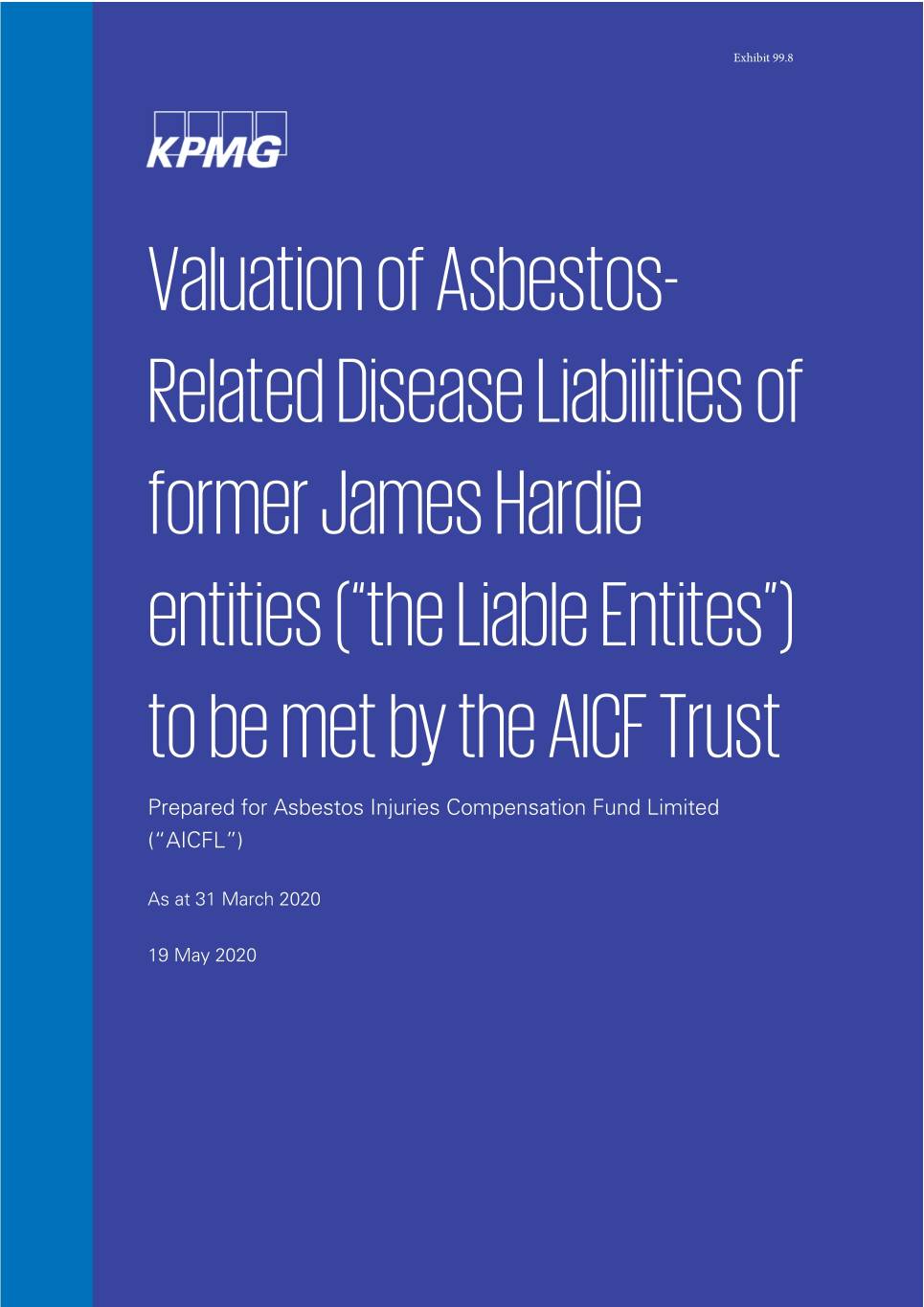
Exhibit 99.8 Valuation of Asbestos- Related Disease Liabilities of former James Hardie entities (“the Liable Entites”) to be met by the AICF Trust Prepared for Asbestos Injuries Compensation Fund Limited (“AICFL”) As at 31 March 2020 19 May 2020
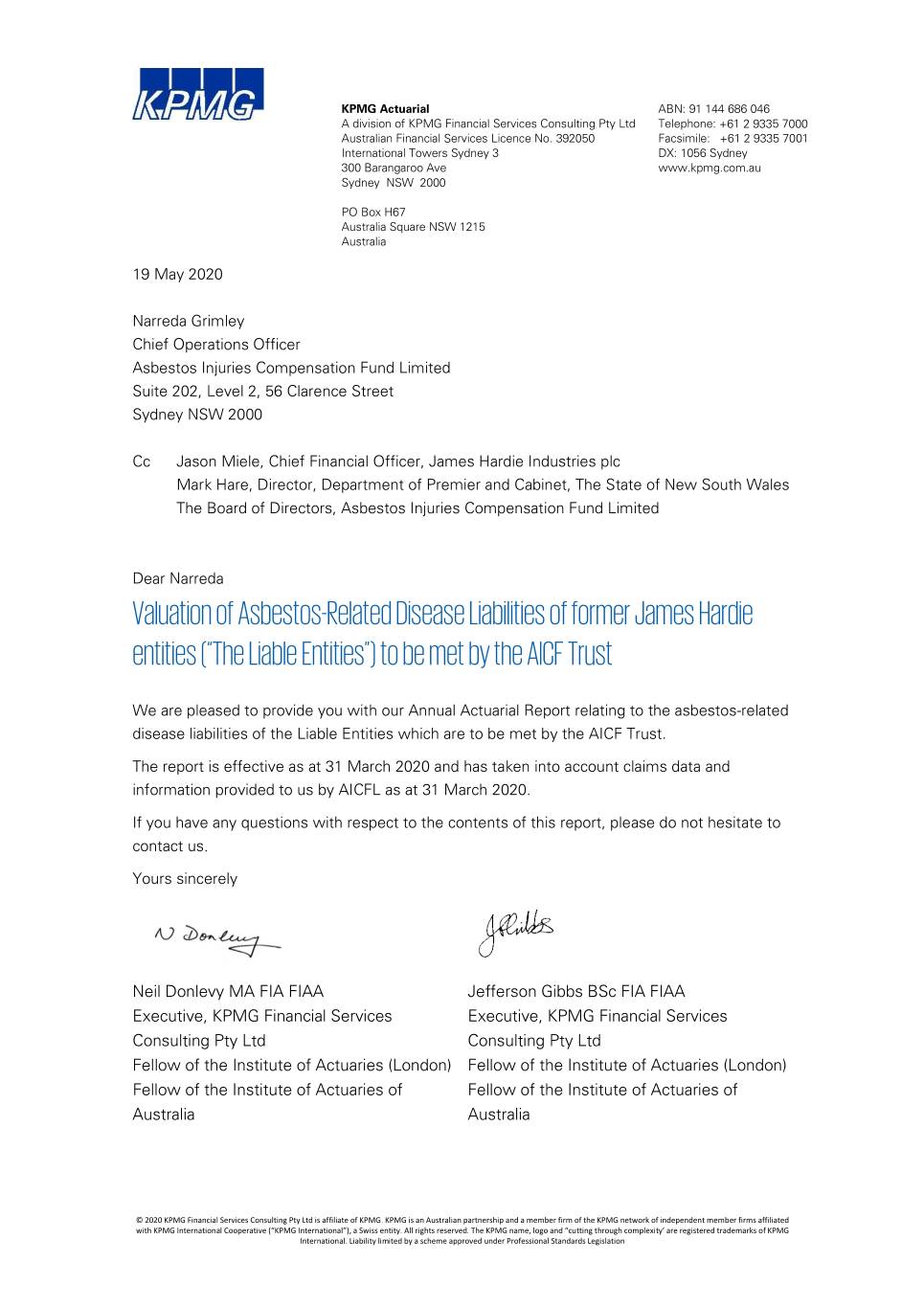
KPMG Actuarial ABN: 91 144 686 046 A division of KPMG Financial Services Consulting Pty Ltd Telephone: +61 2 9335 7000 Australian Financial Services Licence No. 392050 Facsimile: +61 2 9335 7001 International Towers Sydney 3 DX: 1056 Sydney 300 Barangaroo Ave www.kpmg.com.au Sydney NSW 2000 PO Box H67 Australia Square NSW 1215 Australia 19 May 2020 Narreda Grimley Chief Operations Officer Asbestos Injuries Compensation Fund Limited Suite 202, Level 2, 56 Clarence Street Sydney NSW 2000 Cc Jason Miele, Chief Financial Officer, James Hardie Industries plc Mark Hare, Director, Department of Premier and Cabinet, The State of New South Wales The Board of Directors, Asbestos Injuries Compensation Fund Limited Dear Narreda Valuation of Asbestos-Related Disease Liabilities of former James Hardie entities (“The Liable Entities”) to be met by the AICF Trust We are pleased to provide you with our Annual Actuarial Report relating to the asbestos-related disease liabilities of the Liable Entities which are to be met by the AICF Trust. The report is effective as at 31 March 2020 and has taken into account claims data and information provided to us by AICFL as at 31 March 2020. If you have any questions with respect to the contents of this report, please do not hesitate to contact us. Yours sincerely Neil Donlevy MA FIA FIAA Jefferson Gibbs BSc FIA FIAA Executive, KPMG Financial Services Executive, KPMG Financial Services Consulting Pty Ltd Consulting Pty Ltd Fellow of the Institute of Actuaries (London) Fellow of the Institute of Actuaries (London) Fellow of the Institute of Actuaries of Fellow of the Institute of Actuaries of Australia Australia © 2020 KPMG Financial Services Consulting Pty Ltd is affiliate of KPMG. KPMG is an Australian partnership and a member firm of the KPMG network of independent member firms affiliated with KPMG International Cooperative (“KPMG International”), a Swiss entity. All rights reserved. The KPMG name, logo and “cutting through complexity’ are registered trademarks of KPMG International. Liability limited by a scheme approved under Professional Standards Legislation
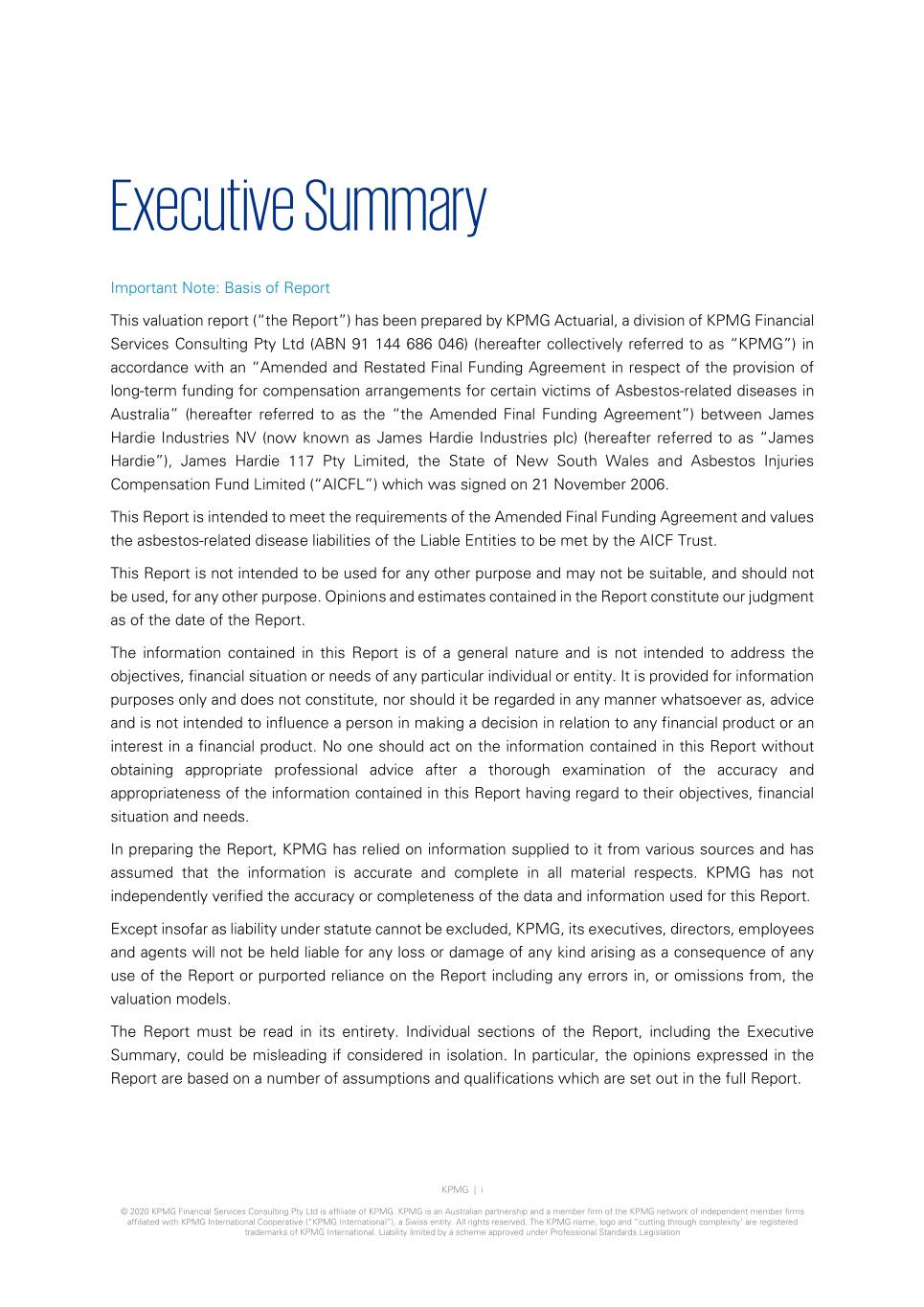
Executive Summary Important Note: Basis of Report This valuation report (“the Report”) has been prepared by KPMG Actuarial, a division of KPMG Financial Services Consulting Pty Ltd (ABN 91 144 686 046) (hereafter collectively referred to as “KPMG”) in accordance with an “Amended and Restated Final Funding Agreement in respect of the provision of long-term funding for compensation arrangements for certain victims of Asbestos-related diseases in Australia” (hereafter referred to as the “the Amended Final Funding Agreement”) between James Hardie Industries NV (now known as James Hardie Industries plc) (hereafter referred to as “James Hardie”), James Hardie 117 Pty Limited, the State of New South Wales and Asbestos Injuries Compensation Fund Limited (“AICFL”) which was signed on 21 November 2006. This Report is intended to meet the requirements of the Amended Final Funding Agreement and values the asbestos-related disease liabilities of the Liable Entities to be met by the AICF Trust. This Report is not intended to be used for any other purpose and may not be suitable, and should not be used, for any other purpose. Opinions and estimates contained in the Report constitute our judgment as of the date of the Report. The information contained in this Report is of a general nature and is not intended to address the objectives, financial situation or needs of any particular individual or entity. It is provided for information purposes only and does not constitute, nor should it be regarded in any manner whatsoever as, advice and is not intended to influence a person in making a decision in relation to any financial product or an interest in a financial product. No one should act on the information contained in this Report without obtaining appropriate professional advice after a thorough examination of the accuracy and appropriateness of the information contained in this Report having regard to their objectives, financial situation and needs. In preparing the Report, KPMG has relied on information supplied to it from various sources and has assumed that the information is accurate and complete in all material respects. KPMG has not independently verified the accuracy or completeness of the data and information used for this Report. Except insofar as liability under statute cannot be excluded, KPMG, its executives, directors, employees and agents will not be held liable for any loss or damage of any kind arising as a consequence of any use of the Report or purported reliance on the Report including any errors in, or omissions from, the valuation models. The Report must be read in its entirety. Individual sections of the Report, including the Executive Summary, could be misleading if considered in isolation. In particular, the opinions expressed in the Report are based on a number of assumptions and qualifications which are set out in the full Report. KPMG | i © 2020 KPMG Financial Services Consulting Pty Ltd is affiliate of KPMG. KPMG is an Australian partnership and a member firm of the KPMG network of independent member firms affiliated with KPMG International Cooperative (“KPMG International”), a Swiss entity. All rights reserved. The KPMG name, logo and “cutting through complexity’ are registered trademarks of KPMG International. Liability limited by a scheme approved under Professional Standards Legislation
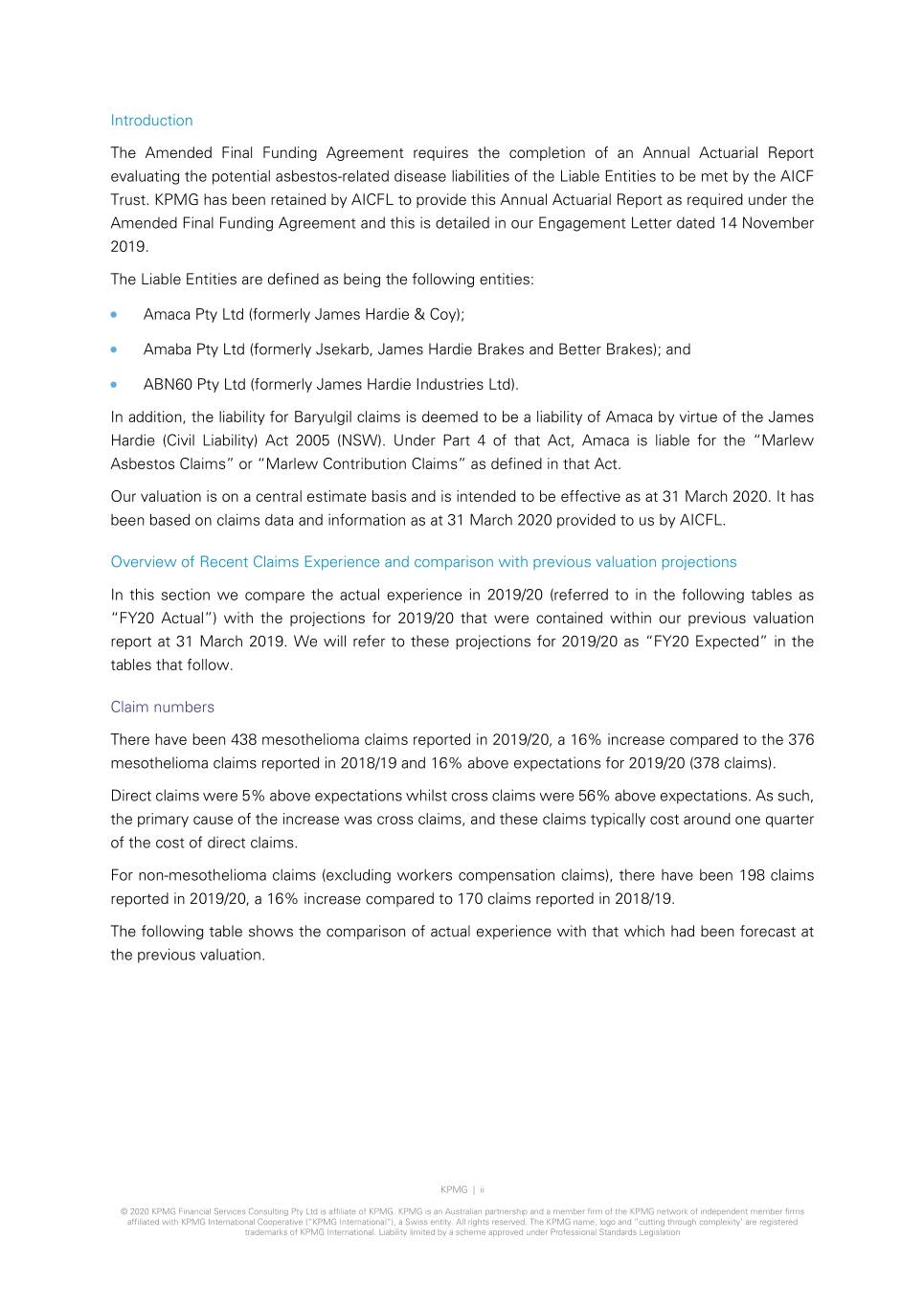
Introduction The Amended Final Funding Agreement requires the completion of an Annual Actuarial Report evaluating the potential asbestos-related disease liabilities of the Liable Entities to be met by the AICF Trust. KPMG has been retained by AICFL to provide this Annual Actuarial Report as required under the Amended Final Funding Agreement and this is detailed in our Engagement Letter dated 14 November 2019. The Liable Entities are defined as being the following entities: • Amaca Pty Ltd (formerly James Hardie & Coy); • Amaba Pty Ltd (formerly Jsekarb, James Hardie Brakes and Better Brakes); and • ABN60 Pty Ltd (formerly James Hardie Industries Ltd). In addition, the liability for Baryulgil claims is deemed to be a liability of Amaca by virtue of the James Hardie (Civil Liability) Act 2005 (NSW). Under Part 4 of that Act, Amaca is liable for the “Marlew Asbestos Claims” or “Marlew Contribution Claims” as defined in that Act. Our valuation is on a central estimate basis and is intended to be effective as at 31 March 2020. It has been based on claims data and information as at 31 March 2020 provided to us by AICFL. Overview of Recent Claims Experience and comparison with previous valuation projections In this section we compare the actual experience in 2019/20 (referred to in the following tables as “FY20 Actual”) with the projections for 2019/20 that were contained within our previous valuation report at 31 March 2019. We will refer to these projections for 2019/20 as “FY20 Expected” in the tables that follow. Claim numbers There have been 438 mesothelioma claims reported in 2019/20, a 16% increase compared to the 376 mesothelioma claims reported in 2018/19 and 16% above expectations for 2019/20 (378 claims). Direct claims were 5% above expectations whilst cross claims were 56% above expectations. As such, the primary cause of the increase was cross claims, and these claims typically cost around one quarter of the cost of direct claims. For non-mesothelioma claims (excluding workers compensation claims), there have been 198 claims reported in 2019/20, a 16% increase compared to 170 claims reported in 2018/19. The following table shows the comparison of actual experience with that which had been forecast at the previous valuation. KPMG | ii © 2020 KPMG Financial Services Consulting Pty Ltd is affiliate of KPMG. KPMG is an Australian partnership and a member firm of the KPMG network of independent member firms affiliated with KPMG International Cooperative (“KPMG International”), a Swiss entity. All rights reserved. The KPMG name, logo and “cutting through complexity’ are registered trademarks of KPMG International. Liability limited by a scheme approved under Professional Standards Legislation
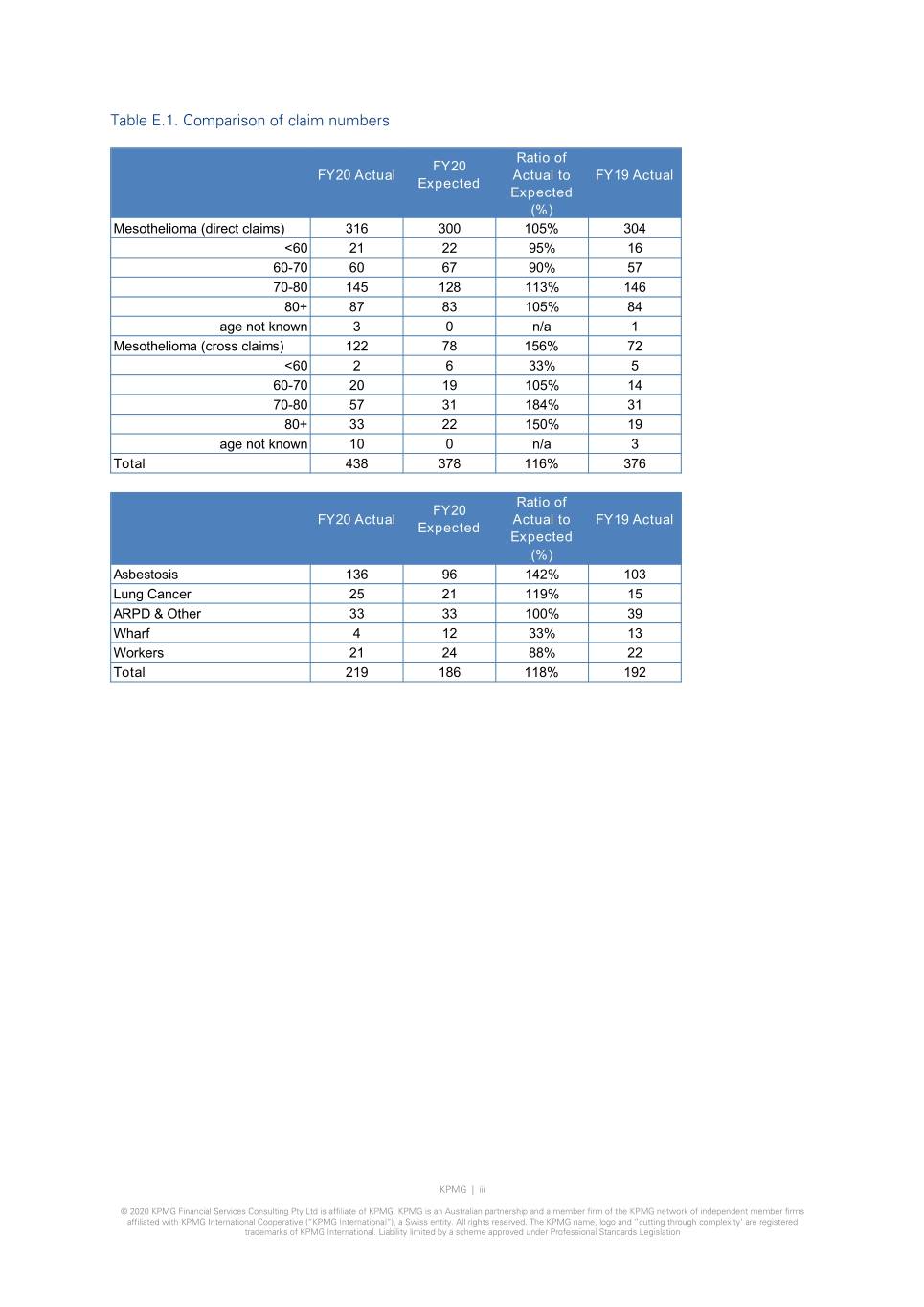
Table E.1. Comparison of claim numbers Ratio of FY20 FY20 Actual Actual to FY19 Actual Expected Expected (%) Mesothelioma (direct claims) 316 300 105% 304 <60 21 22 95% 16 60-70 60 67 90% 57 70-80 145 128 113% 146 80+ 87 83 105% 84 age not known 3 0 n/a 1 Mesothelioma (cross claims) 122 78 156% 72 <60 2 6 33% 5 60-70 20 19 105% 14 70-80 57 31 184% 31 80+ 33 22 150% 19 age not known 10 0 n/a 3 Total 438 378 116% 376 Ratio of FY20 FY20 Actual Actual to FY19 Actual Expected Expected (%) Asbestosis 136 96 142% 103 Lung Cancer 25 21 119% 15 ARPD & Other 33 33 100% 39 Wharf 4 12 33% 13 Workers 21 24 88% 22 Total 219 186 118% 192 KPMG | iii © 2020 KPMG Financial Services Consulting Pty Ltd is affiliate of KPMG. KPMG is an Australian partnership and a member firm of the KPMG network of independent member firms affiliated with KPMG International Cooperative (“KPMG International”), a Swiss entity. All rights reserved. The KPMG name, logo and “cutting through complexity’ are registered trademarks of KPMG International. Liability limited by a scheme approved under Professional Standards Legislation
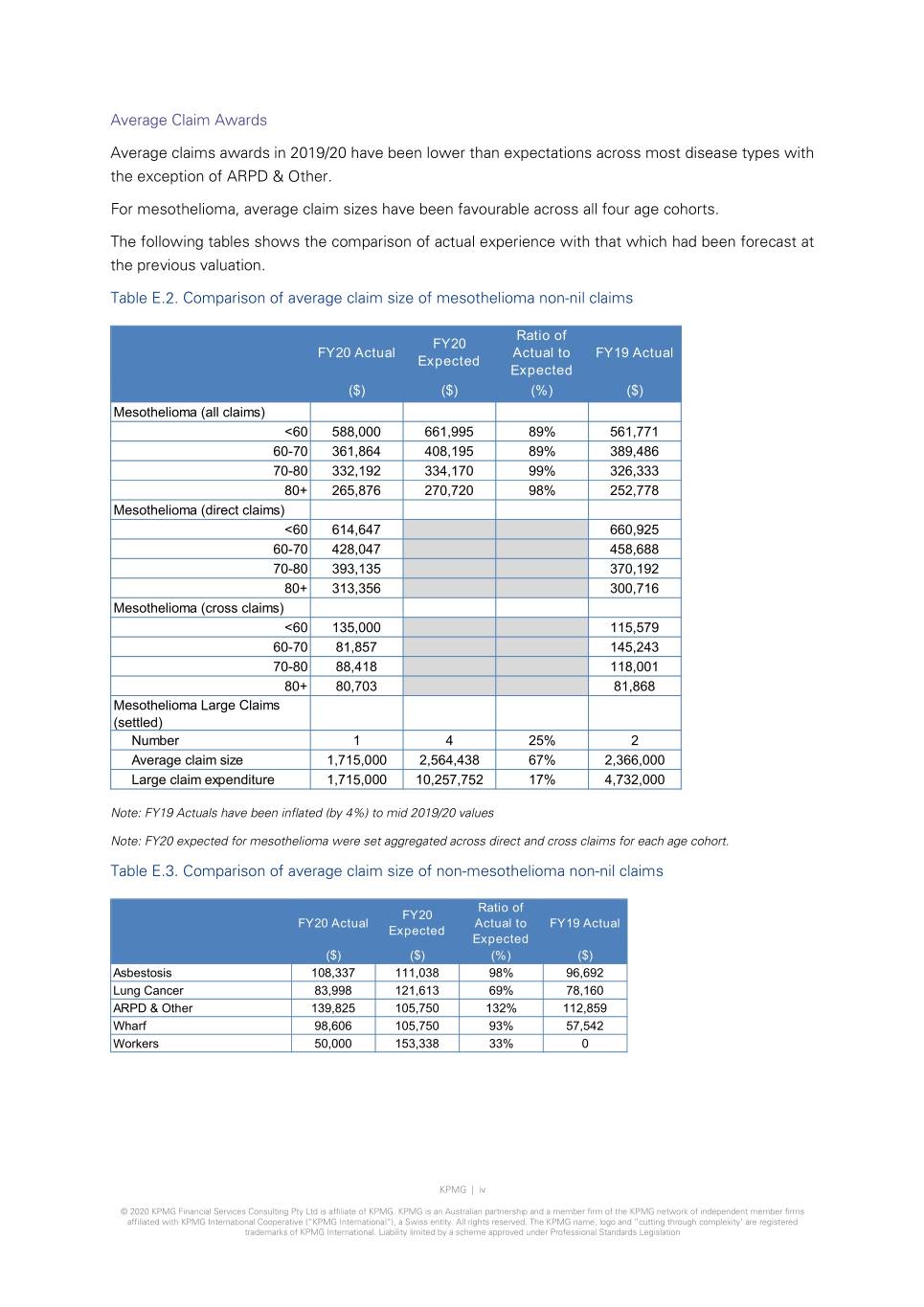
Average Claim Awards Average claims awards in 2019/20 have been lower than expectations across most disease types with the exception of ARPD & Other. For mesothelioma, average claim sizes have been favourable across all four age cohorts. The following tables shows the comparison of actual experience with that which had been forecast at the previous valuation. Table E.2. Comparison of average claim size of mesothelioma non-nil claims Ratio of FY20 FY20 Actual Actual to FY19 Actual Expected Expected ($) ($) (%) ($) Mesothelioma (all claims) <60 588,000 661,995 89% 561,771 60-70 361,864 408,195 89% 389,486 70-80 332,192 334,170 99% 326,333 80+ 265,876 270,720 98% 252,778 Mesothelioma (direct claims) <60 614,647 660,925 60-70 428,047 458,688 70-80 393,135 370,192 80+ 313,356 300,716 Mesothelioma (cross claims) <60 135,000 115,579 60-70 81,857 145,243 70-80 88,418 118,001 80+ 80,703 81,868 Mesothelioma Large Claims (settled) Number 1 4 25% 2 Average claim size 1,715,000 2,564,438 67% 2,366,000 Large claim expenditure 1,715,000 10,257,752 17% 4,732,000 Note: FY19 Actuals have been inflated (by 4%) to mid 2019/20 values Note: FY20 expected for mesothelioma were set aggregated across direct and cross claims for each age cohort. Table E.3. Comparison of average claim size of non-mesothelioma non-nil claims Ratio of FY20 FY20 Actual Actual to FY19 Actual Expected Expected ($) ($) (%) ($) Asbestosis 108,337 111,038 98% 96,692 Lung Cancer 83,998 121,613 69% 78,160 ARPD & Other 139,825 105,750 132% 112,859 Wharf 98,606 105,750 93% 57,542 Workers 50,000 153,338 33% 0 KPMG | iv © 2020 KPMG Financial Services Consulting Pty Ltd is affiliate of KPMG. KPMG is an Australian partnership and a member firm of the KPMG network of independent member firms affiliated with KPMG International Cooperative (“KPMG International”), a Swiss entity. All rights reserved. The KPMG name, logo and “cutting through complexity’ are registered trademarks of KPMG International. Liability limited by a scheme approved under Professional Standards Legislation

Cashflow expenditure: gross and net Gross cashflow expenditure, at $160.2m, was 1% above expectations. Net cashflow expenditure, at $142.4m, was lower than expectations by 5%. Table E.4. Comparison of cashflow Ratio of FY20 FY20 Actual Actual to FY19 Actual Expected Expected ($M) ($M) (%) ($M) Gross Cashflow 160.2 159.0 101% 154.4 Insurance and Other Recoveries (14.0) (9.5) 147% (11.6) Insurance recoveries from HIH (3.8) 0.0 n/a 0.0 and from commutations Net Cashflow 142.4 149.5 95% 142.8 Liability Assessment At 31 March 2020, our projected central estimate of the liabilities of the Liable Entities (the Discounted Central Estimate) to be met by the AICF Trust is $2,025.2m. We have not allowed for the future Operating Expenses of the AICF Trust or the Liable Entities in the liability assessment. Table E.5. Comparison of central estimate of liabilities 31 March 2020 31 March 2019 $m $m Gross of Net of Net of insurance Insurance insurance insurance recoveries recoveries recoveries recoveries Total uninflated and 1,521.2 68.8 1,452.4 1,399.8 undiscounted cash-flows Inflation allowance 784.1 21.3 762.8 818.7 Total inflated and 2,305.3 90.1 2,215.2 2,218.5 undiscounted cash-flows Discounting allowance (196.4) (6.4) (190.0) (350.1) Net present value liabilities 2,108.9 83.7 2,025.2 1,868.4 KPMG | v © 2020 KPMG Financial Services Consulting Pty Ltd is affiliate of KPMG. KPMG is an Australian partnership and a member firm of the KPMG network of independent member firms affiliated with KPMG International Cooperative (“KPMG International”), a Swiss entity. All rights reserved. The KPMG name, logo and “cutting through complexity’ are registered trademarks of KPMG International. Liability limited by a scheme approved under Professional Standards Legislation
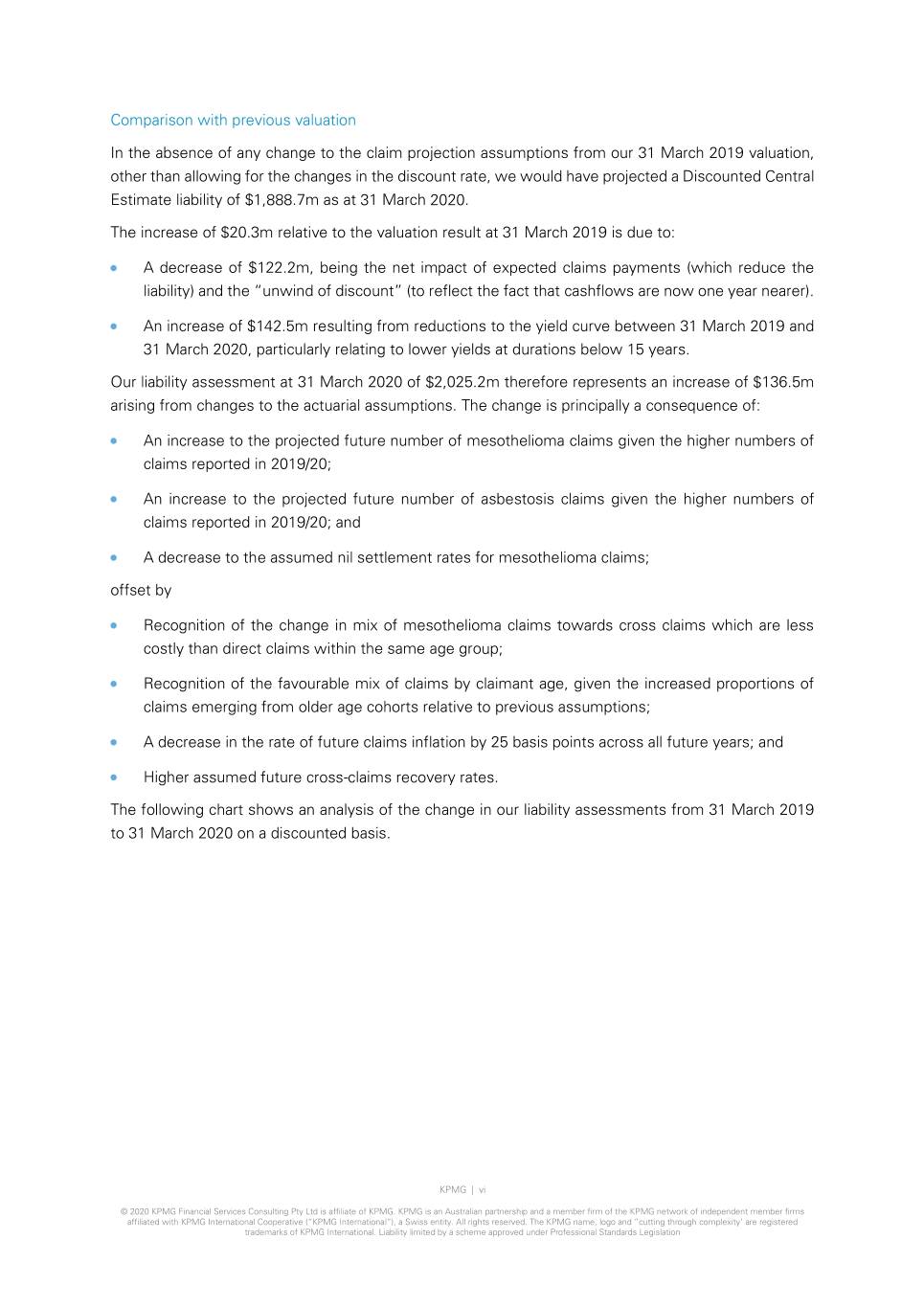
Comparison with previous valuation In the absence of any change to the claim projection assumptions from our 31 March 2019 valuation, other than allowing for the changes in the discount rate, we would have projected a Discounted Central Estimate liability of $1,888.7m as at 31 March 2020. The increase of $20.3m relative to the valuation result at 31 March 2019 is due to: • A decrease of $122.2m, being the net impact of expected claims payments (which reduce the liability) and the “unwind of discount” (to reflect the fact that cashflows are now one year nearer). • An increase of $142.5m resulting from reductions to the yield curve between 31 March 2019 and 31 March 2020, particularly relating to lower yields at durations below 15 years. Our liability assessment at 31 March 2020 of $2,025.2m therefore represents an increase of $136.5m arising from changes to the actuarial assumptions. The change is principally a consequence of: • An increase to the projected future number of mesothelioma claims given the higher numbers of claims reported in 2019/20; • An increase to the projected future number of asbestosis claims given the higher numbers of claims reported in 2019/20; and • A decrease to the assumed nil settlement rates for mesothelioma claims; offset by • Recognition of the change in mix of mesothelioma claims towards cross claims which are less costly than direct claims within the same age group; • Recognition of the favourable mix of claims by claimant age, given the increased proportions of claims emerging from older age cohorts relative to previous assumptions; • A decrease in the rate of future claims inflation by 25 basis points across all future years; and • Higher assumed future cross-claims recovery rates. The following chart shows an analysis of the change in our liability assessments from 31 March 2019 to 31 March 2020 on a discounted basis. KPMG | vi © 2020 KPMG Financial Services Consulting Pty Ltd is affiliate of KPMG. KPMG is an Australian partnership and a member firm of the KPMG network of independent member firms affiliated with KPMG International Cooperative (“KPMG International”), a Swiss entity. All rights reserved. The KPMG name, logo and “cutting through complexity’ are registered trademarks of KPMG International. Liability limited by a scheme approved under Professional Standards Legislation
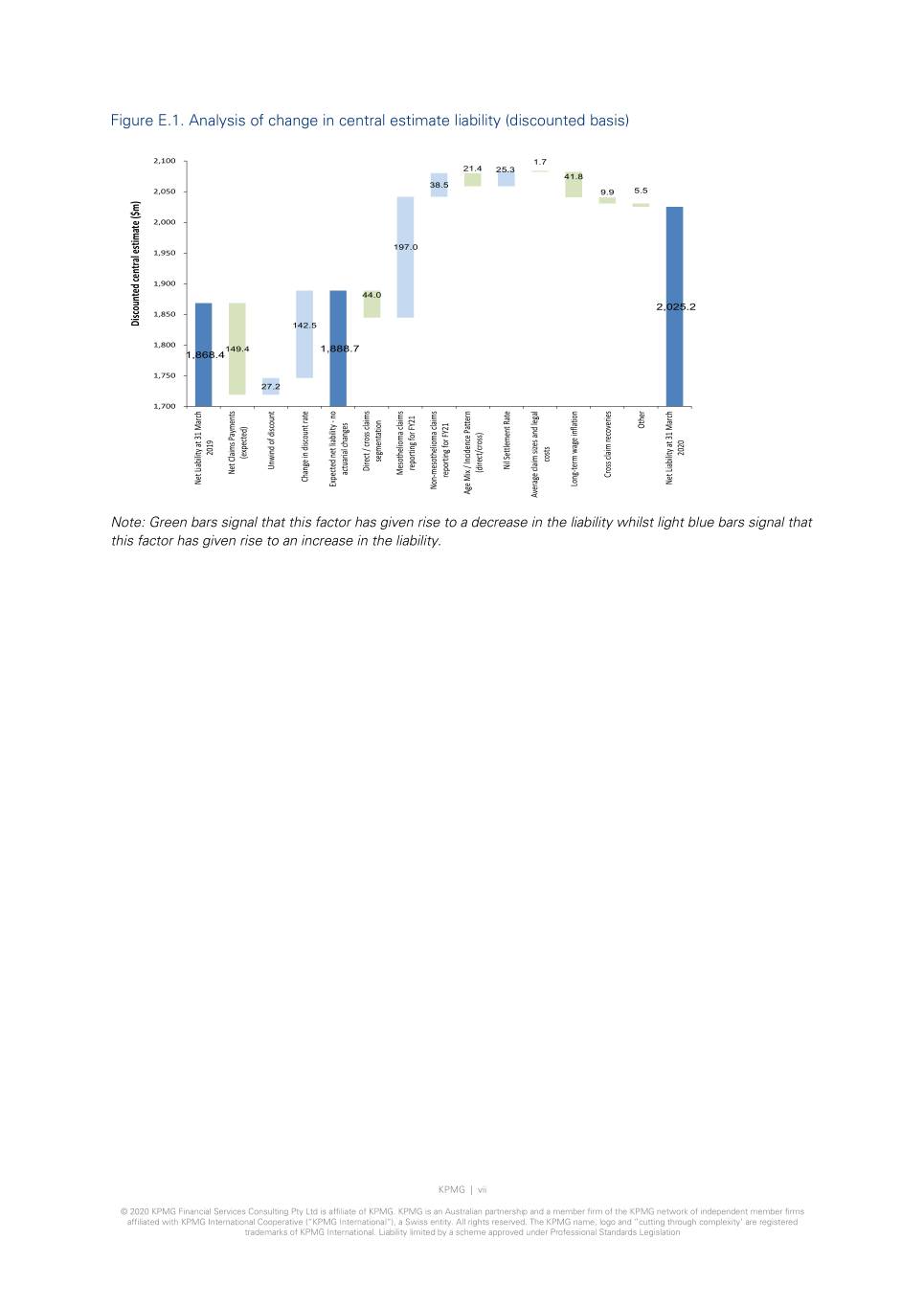
Figure E.1. Analysis of change in central estimate liability (discounted basis) 2,100 1.7 21.4 25.3 41.8 38.5 2,050 9.9 5.5 2,000 197.0 1,950 1,900 44.0 2,025.2 1,850 Discounted centralestimate ($m) 142.5 1,800 149.4 1,888.7 1,868.4 1,750 27.2 1,700 Other 2020 2019 (expected) segmentation costs Nil Settlement Rate Unwind of discount reporting for FY21 Direct / cross claims (direct/cross) Net Claims Payments Claims Net Mesothelioma claims Mesothelioma actuarial changes actuarial reporting for FY21 Cross claim recoveries Change in discount rate Net Liability at 31 March Net Liability at 31 March Long-term wage inflation Expected net liability - no Non-mesothelioma claims Non-mesothelioma Age Mix / Incidence Pattern Average claim sizes and legal Note: Green bars signal that this factor has given rise to a decrease in the liability whilst light blue bars signal that this factor has given rise to an increase in the liability. KPMG | vii © 2020 KPMG Financial Services Consulting Pty Ltd is affiliate of KPMG. KPMG is an Australian partnership and a member firm of the KPMG network of independent member firms affiliated with KPMG International Cooperative (“KPMG International”), a Swiss entity. All rights reserved. The KPMG name, logo and “cutting through complexity’ are registered trademarks of KPMG International. Liability limited by a scheme approved under Professional Standards Legislation

Amended Final Funding Agreement calculations The Amended Final Funding Agreement sets out the basis on which payments will be made to the AICF Trust. Additionally, there are a number of other figures specified within the Amended Final Funding Agreement that we are required to calculate. These are: • Discounted Central Estimate; • Term Central Estimate; and • Period Actuarial Estimate. Table E.6. Amended Final Funding Agreement calculations $m Discounted Central Estimate (net of cross-claim recoveries, 2,025.2 Insurance and Other Recoveries) Period Actuarial Estimate (net of cross-claim recoveries, gross 518.9 of Insurance and Other Recoveries) comprising: Discounted value of cashflow in 2020/21 166.0 Discounted value of cashflow in 2021/22 179.3 Discounted value of cashflow in 2022/23 173.6 Term Central Estimate (net of cross-claim recoveries, 1,996.7 Insurance and Other Recoveries) The actual funding amount due at a particular date will depend upon a number of factors, including: • the net asset position of the AICF Trust at that time; • the free cash flow amount of the James Hardie Group in the preceding financial year; and • the Period Actuarial Estimate in the latest Annual Actuarial Report. Potential impacts of COVID-19 At the time of preparing this report, COVID-19 continues within Australia and globally. We note the significant impact that the emergence of COVID-19 has had on the yield curve as at 31 March 2020. For the purpose of our report, we have made no explicit allowance or adjustment for the impact of COVID-19. We have concluded that the number of claims received in the year were not substantially affected by the restrictions in place in Australia. In relation to both the number of claims settled and the amounts of claims-related expenditure in the year to 31 March 2020, we have also concluded that neither of these were substantially affected by the restrictions in place in Australia. We have documented the deliberations that led to these conclusions in Section 1.5 of this Report. KPMG | viii © 2020 KPMG Financial Services Consulting Pty Ltd is affiliate of KPMG. KPMG is an Australian partnership and a member firm of the KPMG network of independent member firms affiliated with KPMG International Cooperative (“KPMG International”), a Swiss entity. All rights reserved. The KPMG name, logo and “cutting through complexity’ are registered trademarks of KPMG International. Liability limited by a scheme approved under Professional Standards Legislation
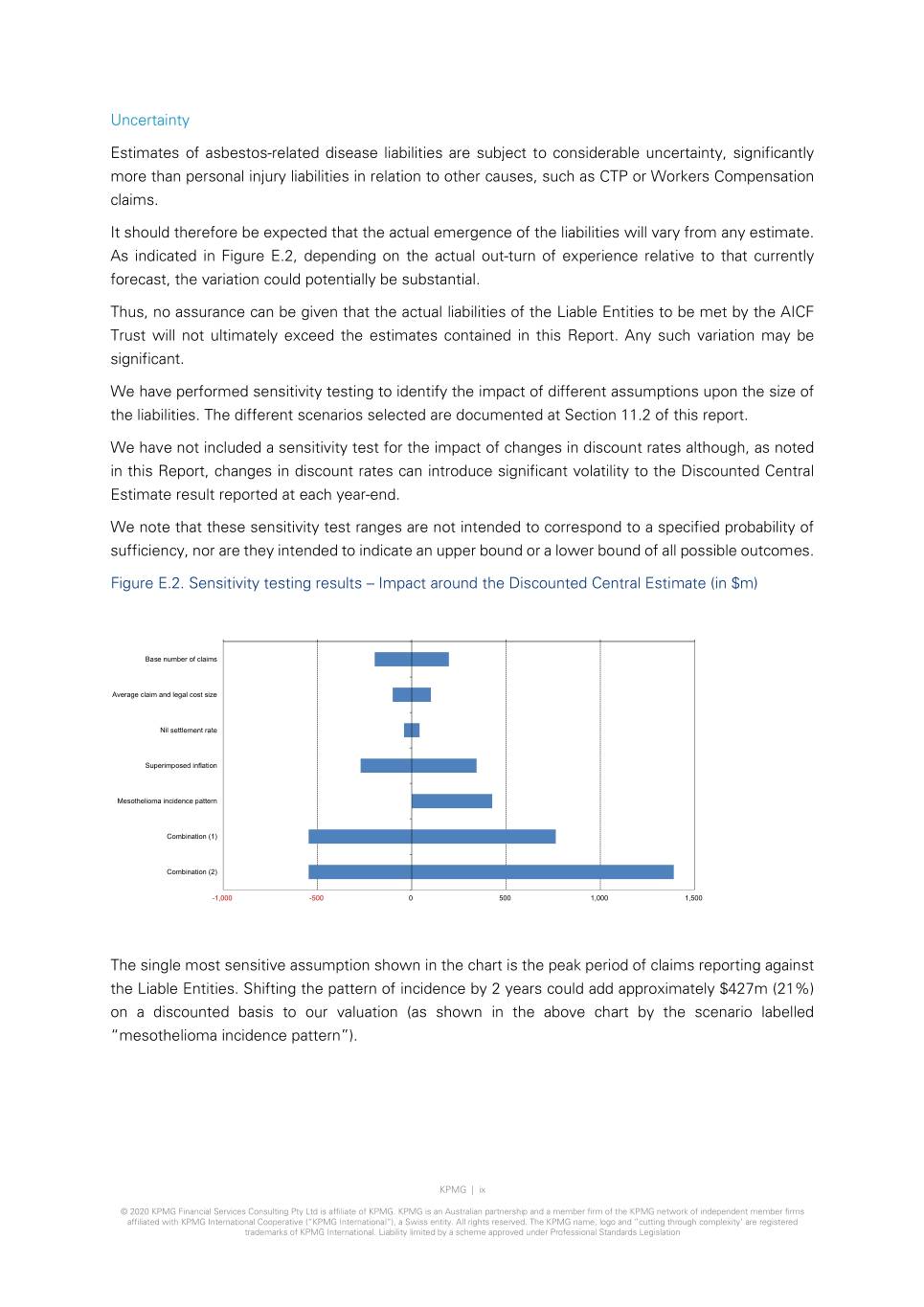
Uncertainty Estimates of asbestos-related disease liabilities are subject to considerable uncertainty, significantly more than personal injury liabilities in relation to other causes, such as CTP or Workers Compensation claims. It should therefore be expected that the actual emergence of the liabilities will vary from any estimate. As indicated in Figure E.2, depending on the actual out-turn of experience relative to that currently forecast, the variation could potentially be substantial. Thus, no assurance can be given that the actual liabilities of the Liable Entities to be met by the AICF Trust will not ultimately exceed the estimates contained in this Report. Any such variation may be significant. We have performed sensitivity testing to identify the impact of different assumptions upon the size of the liabilities. The different scenarios selected are documented at Section 11.2 of this report. We have not included a sensitivity test for the impact of changes in discount rates although, as noted in this Report, changes in discount rates can introduce significant volatility to the Discounted Central Estimate result reported at each year-end. We note that these sensitivity test ranges are not intended to correspond to a specified probability of sufficiency, nor are they intended to indicate an upper bound or a lower bound of all possible outcomes. Figure E.2. Sensitivity testing results – Impact around the Discounted Central Estimate (in $m) Base number of claims Average claim and legal cost size Nil settlement rate Superimposed inflation Mesothelioma incidence pattern Combination (1) Combination (2) -1,000 -500 0 500 1,000 1,500 The single most sensitive assumption shown in the chart is the peak period of claims reporting against the Liable Entities. Shifting the pattern of incidence by 2 years could add approximately $427m (21%) on a discounted basis to our valuation (as shown in the above chart by the scenario labelled “mesothelioma incidence pattern”). KPMG | ix © 2020 KPMG Financial Services Consulting Pty Ltd is affiliate of KPMG. KPMG is an Australian partnership and a member firm of the KPMG network of independent member firms affiliated with KPMG International Cooperative (“KPMG International”), a Swiss entity. All rights reserved. The KPMG name, logo and “cutting through complexity’ are registered trademarks of KPMG International. Liability limited by a scheme approved under Professional Standards Legislation
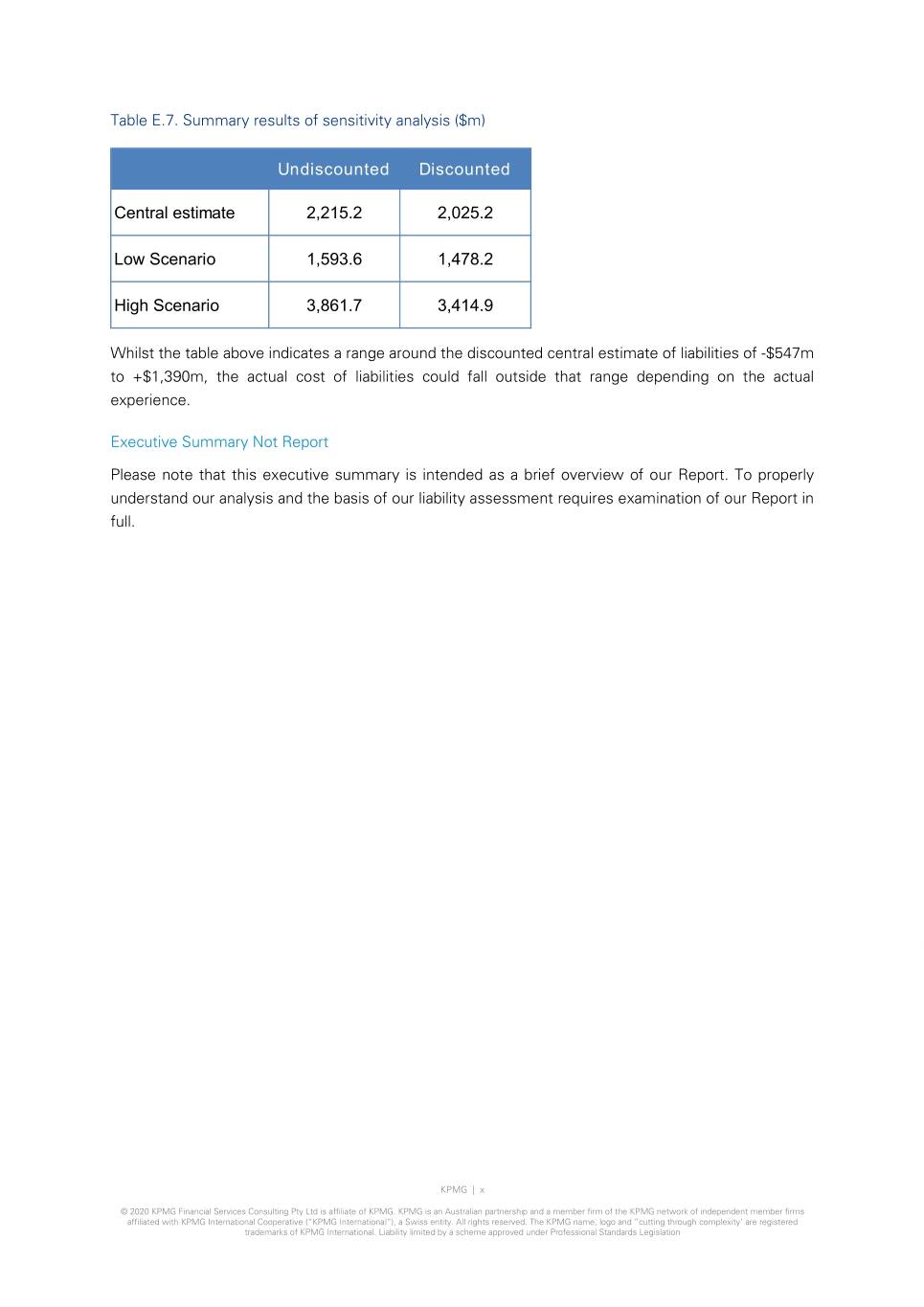
Table E.7. Summary results of sensitivity analysis ($m) Undiscounted Discounted Central estimate 2,215.2 2,025.2 Low Scenario 1,593.6 1,478.2 High Scenario 3,861.7 3,414.9 Whilst the table above indicates a range around the discounted central estimate of liabilities of -$547m to +$1,390m, the actual cost of liabilities could fall outside that range depending on the actual experience. Executive Summary Not Report Please note that this executive summary is intended as a brief overview of our Report. To properly understand our analysis and the basis of our liability assessment requires examination of our Report in full. KPMG | x © 2020 KPMG Financial Services Consulting Pty Ltd is affiliate of KPMG. KPMG is an Australian partnership and a member firm of the KPMG network of independent member firms affiliated with KPMG International Cooperative (“KPMG International”), a Swiss entity. All rights reserved. The KPMG name, logo and “cutting through complexity’ are registered trademarks of KPMG International. Liability limited by a scheme approved under Professional Standards Legislation
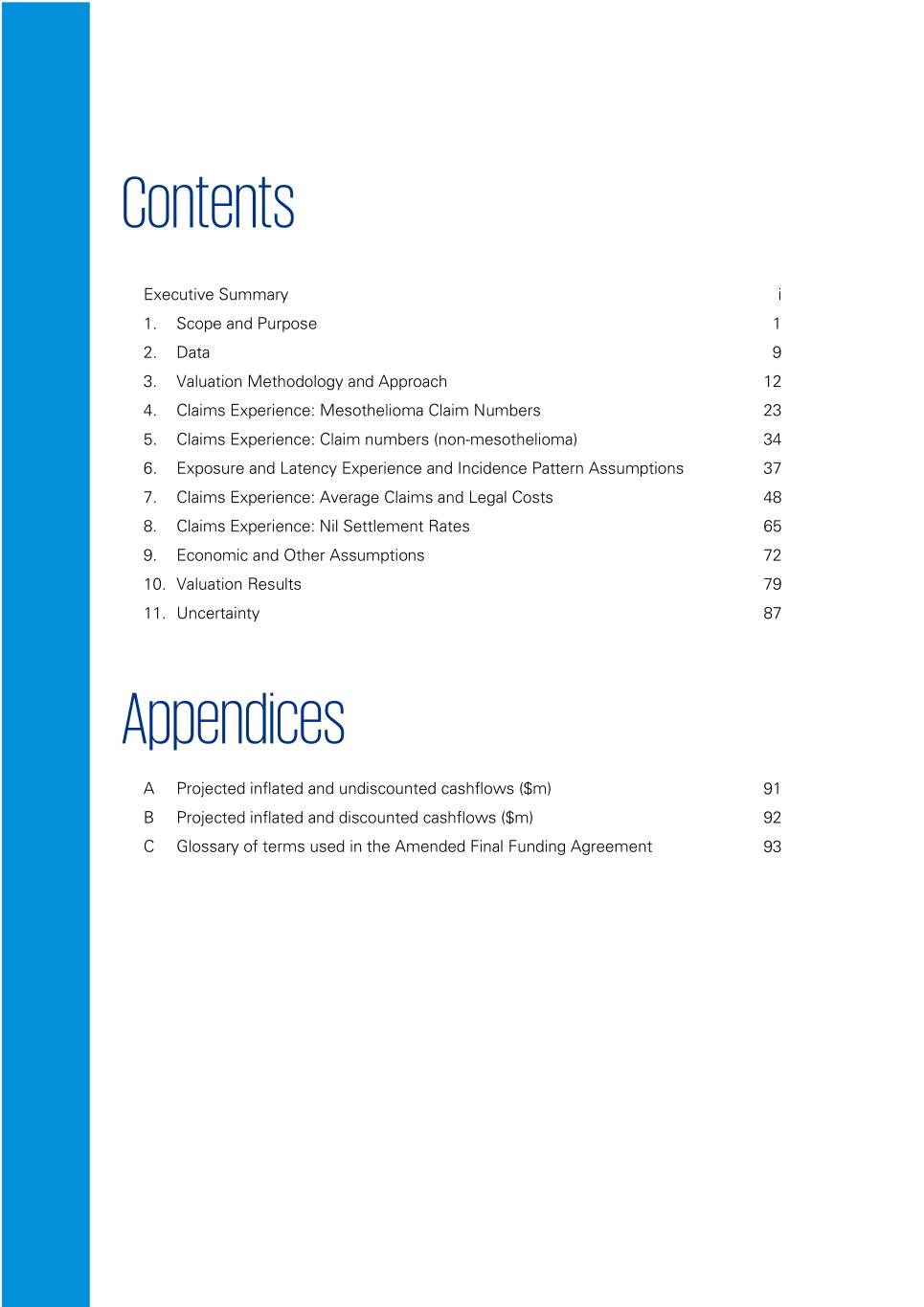
Contents Executive Summary i 1. Scope and Purpose 1 2. Data 9 3. Valuation Methodology and Approach 12 4. Claims Experience: Mesothelioma Claim Numbers 23 5. Claims Experience: Claim numbers (non-mesothelioma) 34 6. Exposure and Latency Experience and Incidence Pattern Assumptions 37 7. Claims Experience: Average Claims and Legal Costs 48 8. Claims Experience: Nil Settlement Rates 65 9. Economic and Other Assumptions 72 10. Valuation Results 79 11. Uncertainty 87 Appendices A Projected inflated and undiscounted cashflows ($m) 91 B Projected inflated and discounted cashflows ($m) 92 C Glossary of terms used in the Amended Final Funding Agreement 93
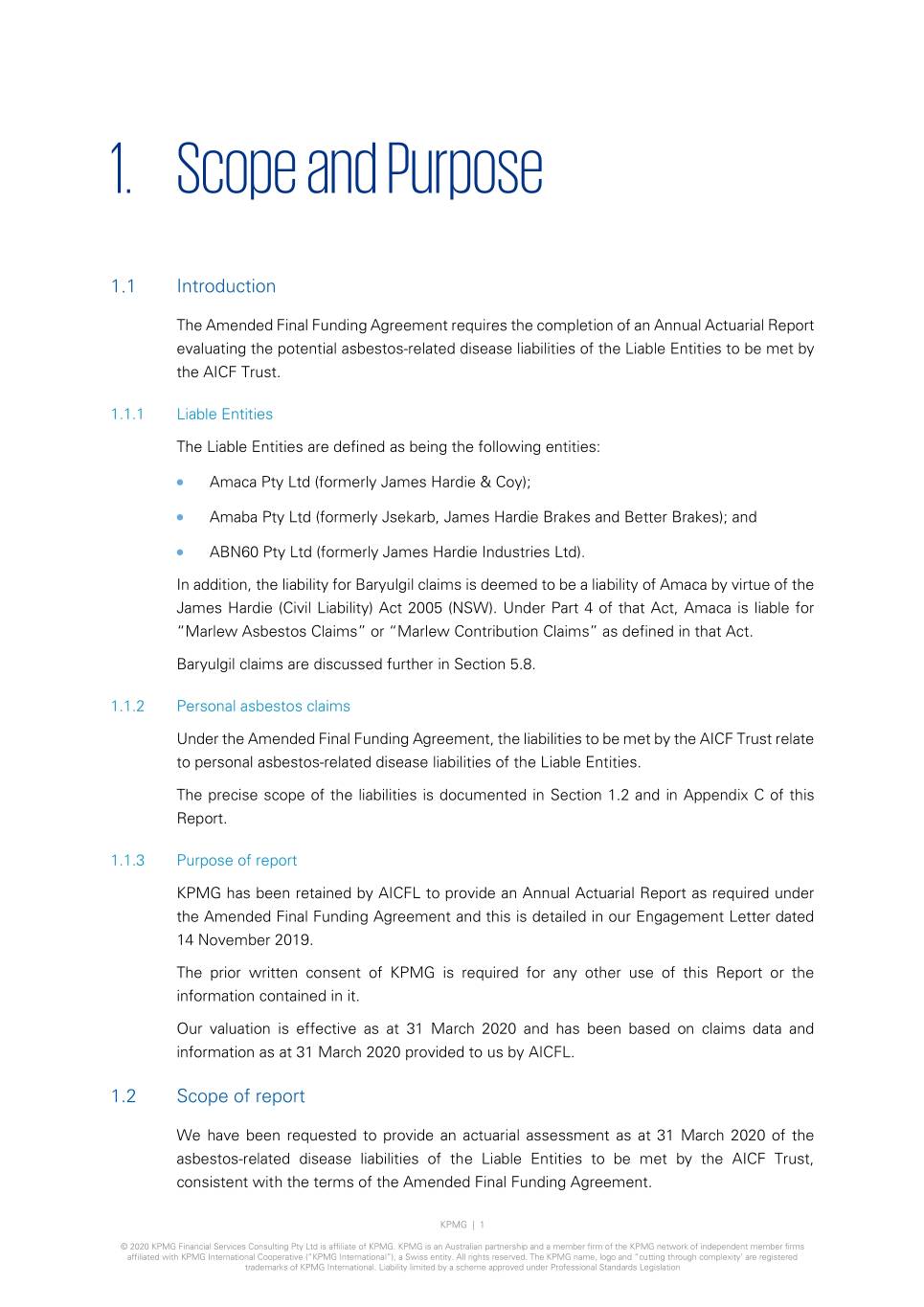
1. Scope and Purpose 1.1 Introduction The Amended Final Funding Agreement requires the completion of an Annual Actuarial Report evaluating the potential asbestos-related disease liabilities of the Liable Entities to be met by the AICF Trust. 1.1.1 Liable Entities The Liable Entities are defined as being the following entities: • Amaca Pty Ltd (formerly James Hardie & Coy); • Amaba Pty Ltd (formerly Jsekarb, James Hardie Brakes and Better Brakes); and • ABN60 Pty Ltd (formerly James Hardie Industries Ltd). In addition, the liability for Baryulgil claims is deemed to be a liability of Amaca by virtue of the James Hardie (Civil Liability) Act 2005 (NSW). Under Part 4 of that Act, Amaca is liable for “Marlew Asbestos Claims” or “Marlew Contribution Claims” as defined in that Act. Baryulgil claims are discussed further in Section 5.8. 1.1.2 Personal asbestos claims Under the Amended Final Funding Agreement, the liabilities to be met by the AICF Trust relate to personal asbestos-related disease liabilities of the Liable Entities. The precise scope of the liabilities is documented in Section 1.2 and in Appendix C of this Report. 1.1.3 Purpose of report KPMG has been retained by AICFL to provide an Annual Actuarial Report as required under the Amended Final Funding Agreement and this is detailed in our Engagement Letter dated 14 November 2019. The prior written consent of KPMG is required for any other use of this Report or the information contained in it. Our valuation is effective as at 31 March 2020 and has been based on claims data and information as at 31 March 2020 provided to us by AICFL. 1.2 Scope of report We have been requested to provide an actuarial assessment as at 31 March 2020 of the asbestos-related disease liabilities of the Liable Entities to be met by the AICF Trust, consistent with the terms of the Amended Final Funding Agreement. KPMG | 1 © 2020 KPMG Financial Services Consulting Pty Ltd is affiliate of KPMG. KPMG is an Australian partnership and a member firm of the KPMG network of independent member firms affiliated with KPMG International Cooperative (“KPMG International”), a Swiss entity. All rights reserved. The KPMG name, logo and “cutting through complexity’ are registered trademarks of KPMG International. Liability limited by a scheme approved under Professional Standards Legislation
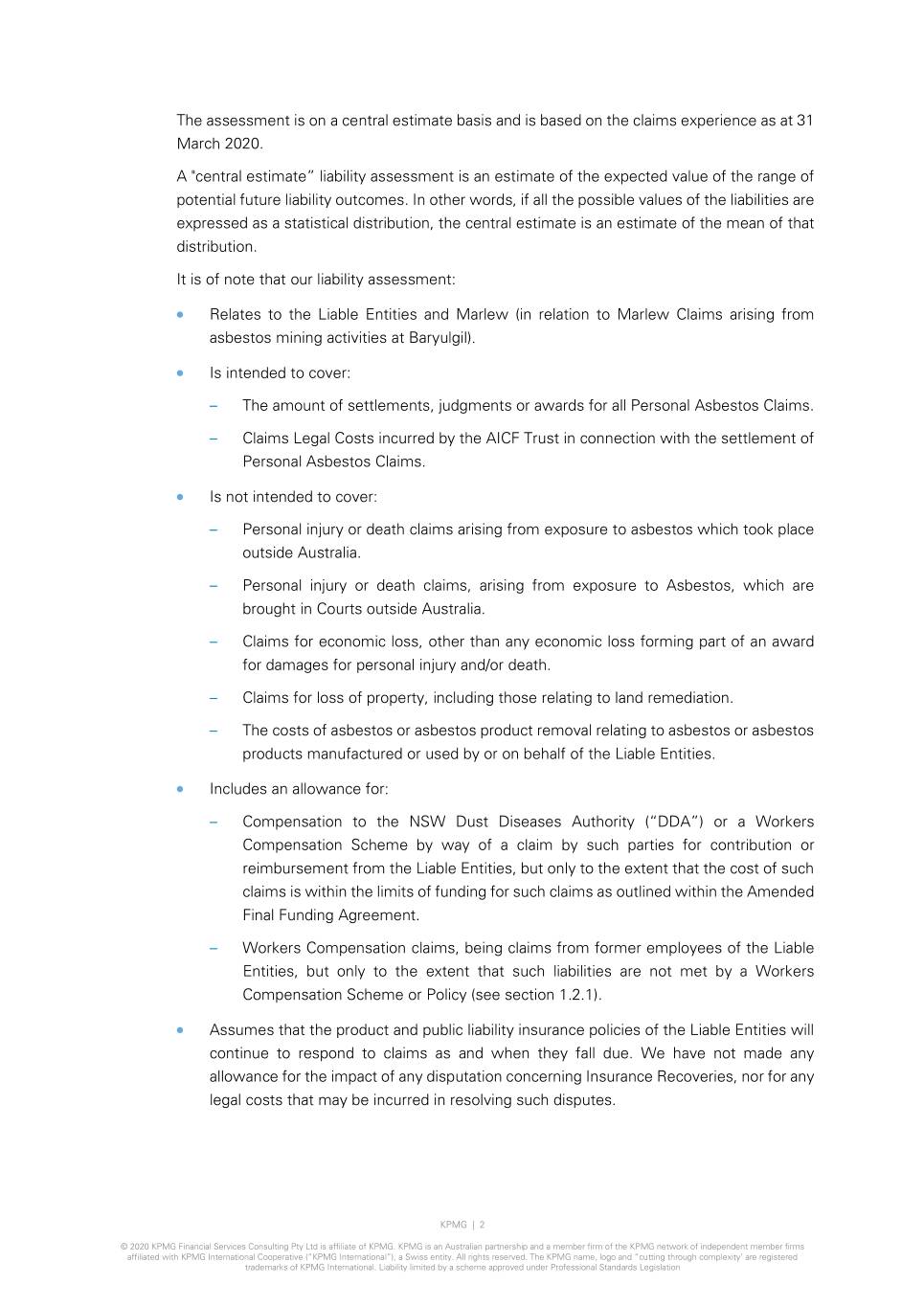
The assessment is on a central estimate basis and is based on the claims experience as at 31 March 2020. A "central estimate” liability assessment is an estimate of the expected value of the range of potential future liability outcomes. In other words, if all the possible values of the liabilities are expressed as a statistical distribution, the central estimate is an estimate of the mean of that distribution. It is of note that our liability assessment: • Relates to the Liable Entities and Marlew (in relation to Marlew Claims arising from asbestos mining activities at Baryulgil). • Is intended to cover: – The amount of settlements, judgments or awards for all Personal Asbestos Claims. – Claims Legal Costs incurred by the AICF Trust in connection with the settlement of Personal Asbestos Claims. • Is not intended to cover: – Personal injury or death claims arising from exposure to asbestos which took place outside Australia. – Personal injury or death claims, arising from exposure to Asbestos, which are brought in Courts outside Australia. – Claims for economic loss, other than any economic loss forming part of an award for damages for personal injury and/or death. – Claims for loss of property, including those relating to land remediation. – The costs of asbestos or asbestos product removal relating to asbestos or asbestos products manufactured or used by or on behalf of the Liable Entities. • Includes an allowance for: – Compensation to the NSW Dust Diseases Authority (“DDA”) or a Workers Compensation Scheme by way of a claim by such parties for contribution or reimbursement from the Liable Entities, but only to the extent that the cost of such claims is within the limits of funding for such claims as outlined within the Amended Final Funding Agreement. – Workers Compensation claims, being claims from former employees of the Liable Entities, but only to the extent that such liabilities are not met by a Workers Compensation Scheme or Policy (see section 1.2.1). • Assumes that the product and public liability insurance policies of the Liable Entities will continue to respond to claims as and when they fall due. We have not made any allowance for the impact of any disputation concerning Insurance Recoveries, nor for any legal costs that may be incurred in resolving such disputes. KPMG | 2 © 2020 KPMG Financial Services Consulting Pty Ltd is affiliate of KPMG. KPMG is an Australian partnership and a member firm of the KPMG network of independent member firms affiliated with KPMG International Cooperative (“KPMG International”), a Swiss entity. All rights reserved. The KPMG name, logo and “cutting through complexity’ are registered trademarks of KPMG International. Liability limited by a scheme approved under Professional Standards Legislation
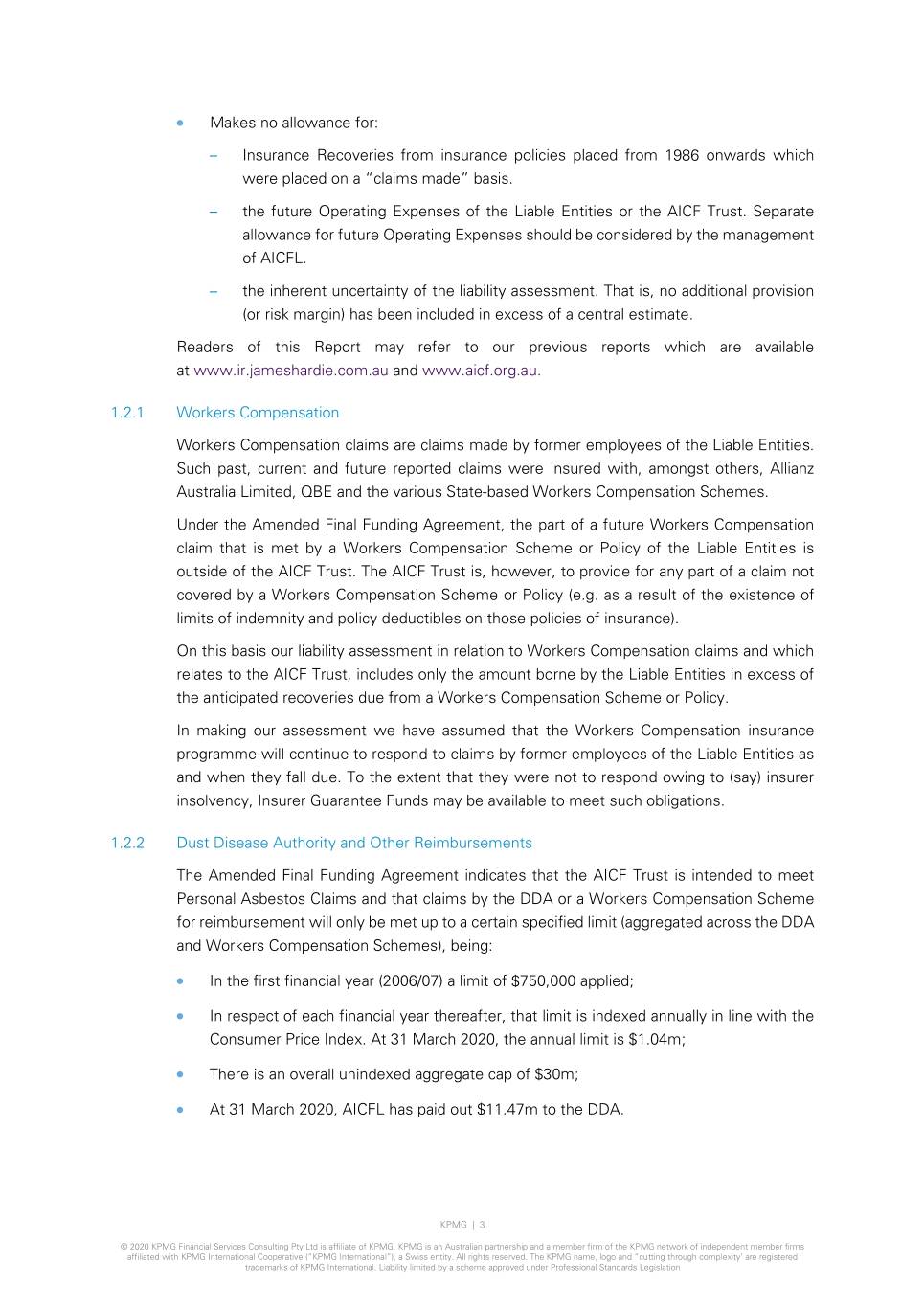
• Makes no allowance for: – Insurance Recoveries from insurance policies placed from 1986 onwards which were placed on a “claims made” basis. – the future Operating Expenses of the Liable Entities or the AICF Trust. Separate allowance for future Operating Expenses should be considered by the management of AICFL. – the inherent uncertainty of the liability assessment. That is, no additional provision (or risk margin) has been included in excess of a central estimate. Readers of this Report may refer to our previous reports which are available at www.ir.jameshardie.com.au and www.aicf.org.au. 1.2.1 Workers Compensation Workers Compensation claims are claims made by former employees of the Liable Entities. Such past, current and future reported claims were insured with, amongst others, Allianz Australia Limited, QBE and the various State-based Workers Compensation Schemes. Under the Amended Final Funding Agreement, the part of a future Workers Compensation claim that is met by a Workers Compensation Scheme or Policy of the Liable Entities is outside of the AICF Trust. The AICF Trust is, however, to provide for any part of a claim not covered by a Workers Compensation Scheme or Policy (e.g. as a result of the existence of limits of indemnity and policy deductibles on those policies of insurance). On this basis our liability assessment in relation to Workers Compensation claims and which relates to the AICF Trust, includes only the amount borne by the Liable Entities in excess of the anticipated recoveries due from a Workers Compensation Scheme or Policy. In making our assessment we have assumed that the Workers Compensation insurance programme will continue to respond to claims by former employees of the Liable Entities as and when they fall due. To the extent that they were not to respond owing to (say) insurer insolvency, Insurer Guarantee Funds may be available to meet such obligations. 1.2.2 Dust Disease Authority and Other Reimbursements The Amended Final Funding Agreement indicates that the AICF Trust is intended to meet Personal Asbestos Claims and that claims by the DDA or a Workers Compensation Scheme for reimbursement will only be met up to a certain specified limit (aggregated across the DDA and Workers Compensation Schemes), being: • In the first financial year (2006/07) a limit of $750,000 applied; • In respect of each financial year thereafter, that limit is indexed annually in line with the Consumer Price Index. At 31 March 2020, the annual limit is $1.04m; • There is an overall unindexed aggregate cap of $30m; • At 31 March 2020, AICFL has paid out $11.47m to the DDA. KPMG | 3 © 2020 KPMG Financial Services Consulting Pty Ltd is affiliate of KPMG. KPMG is an Australian partnership and a member firm of the KPMG network of independent member firms affiliated with KPMG International Cooperative (“KPMG International”), a Swiss entity. All rights reserved. The KPMG name, logo and “cutting through complexity’ are registered trademarks of KPMG International. Liability limited by a scheme approved under Professional Standards Legislation
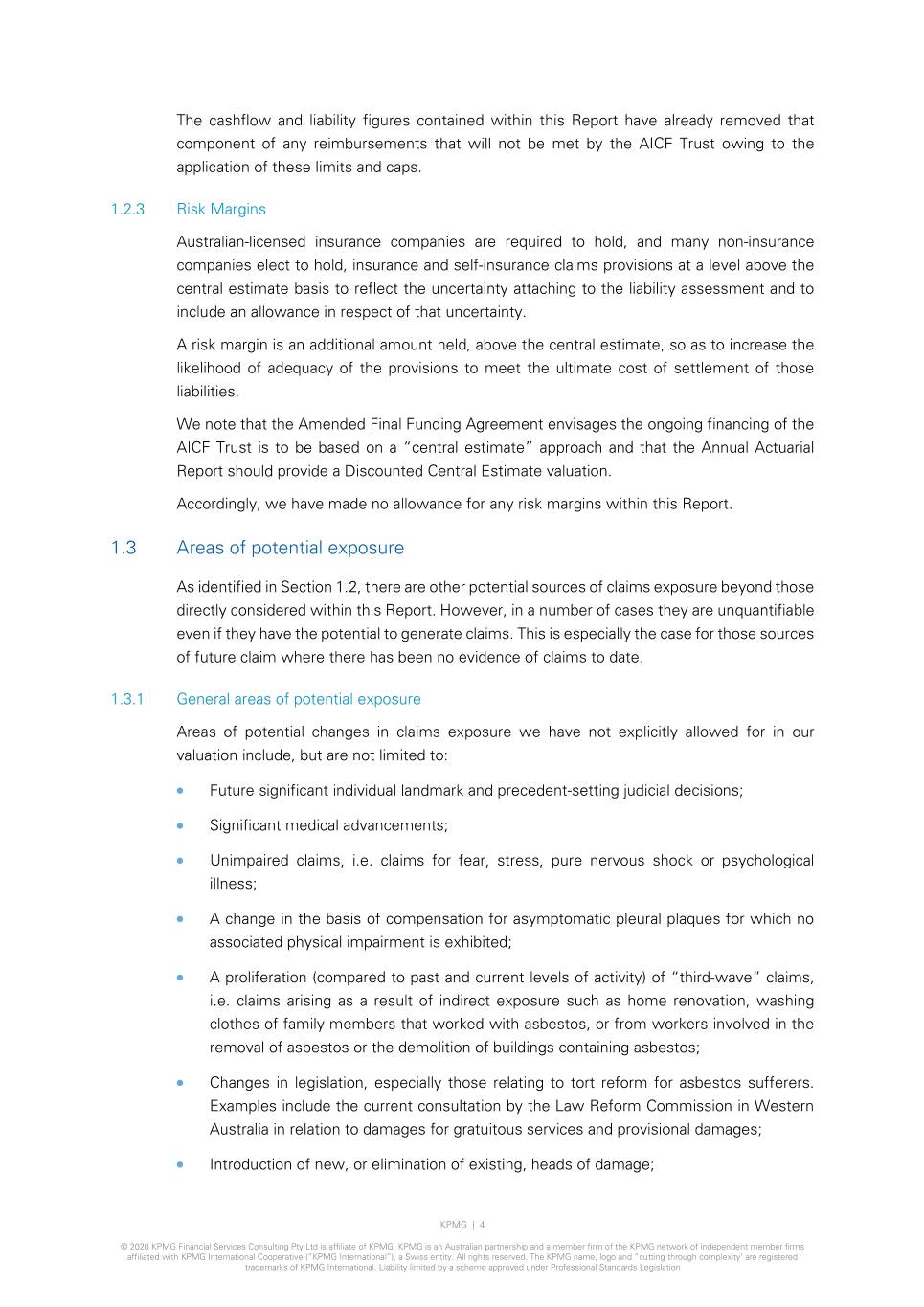
The cashflow and liability figures contained within this Report have already removed that component of any reimbursements that will not be met by the AICF Trust owing to the application of these limits and caps. 1.2.3 Risk Margins Australian-licensed insurance companies are required to hold, and many non-insurance companies elect to hold, insurance and self-insurance claims provisions at a level above the central estimate basis to reflect the uncertainty attaching to the liability assessment and to include an allowance in respect of that uncertainty. A risk margin is an additional amount held, above the central estimate, so as to increase the likelihood of adequacy of the provisions to meet the ultimate cost of settlement of those liabilities. We note that the Amended Final Funding Agreement envisages the ongoing financing of the AICF Trust is to be based on a “central estimate” approach and that the Annual Actuarial Report should provide a Discounted Central Estimate valuation. Accordingly, we have made no allowance for any risk margins within this Report. 1.3 Areas of potential exposure As identified in Section 1.2, there are other potential sources of claims exposure beyond those directly considered within this Report. However, in a number of cases they are unquantifiable even if they have the potential to generate claims. This is especially the case for those sources of future claim where there has been no evidence of claims to date. 1.3.1 General areas of potential exposure Areas of potential changes in claims exposure we have not explicitly allowed for in our valuation include, but are not limited to: • Future significant individual landmark and precedent-setting judicial decisions; • Significant medical advancements; • Unimpaired claims, i.e. claims for fear, stress, pure nervous shock or psychological illness; • A change in the basis of compensation for asymptomatic pleural plaques for which no associated physical impairment is exhibited; • A proliferation (compared to past and current levels of activity) of “third-wave” claims, i.e. claims arising as a result of indirect exposure such as home renovation, washing clothes of family members that worked with asbestos, or from workers involved in the removal of asbestos or the demolition of buildings containing asbestos; • Changes in legislation, especially those relating to tort reform for asbestos sufferers. Examples include the current consultation by the Law Reform Commission in Western Australia in relation to damages for gratuitous services and provisional damages; • Introduction of new, or elimination of existing, heads of damage; KPMG | 4 © 2020 KPMG Financial Services Consulting Pty Ltd is affiliate of KPMG. KPMG is an Australian partnership and a member firm of the KPMG network of independent member firms affiliated with KPMG International Cooperative (“KPMG International”), a Swiss entity. All rights reserved. The KPMG name, logo and “cutting through complexity’ are registered trademarks of KPMG International. Liability limited by a scheme approved under Professional Standards Legislation
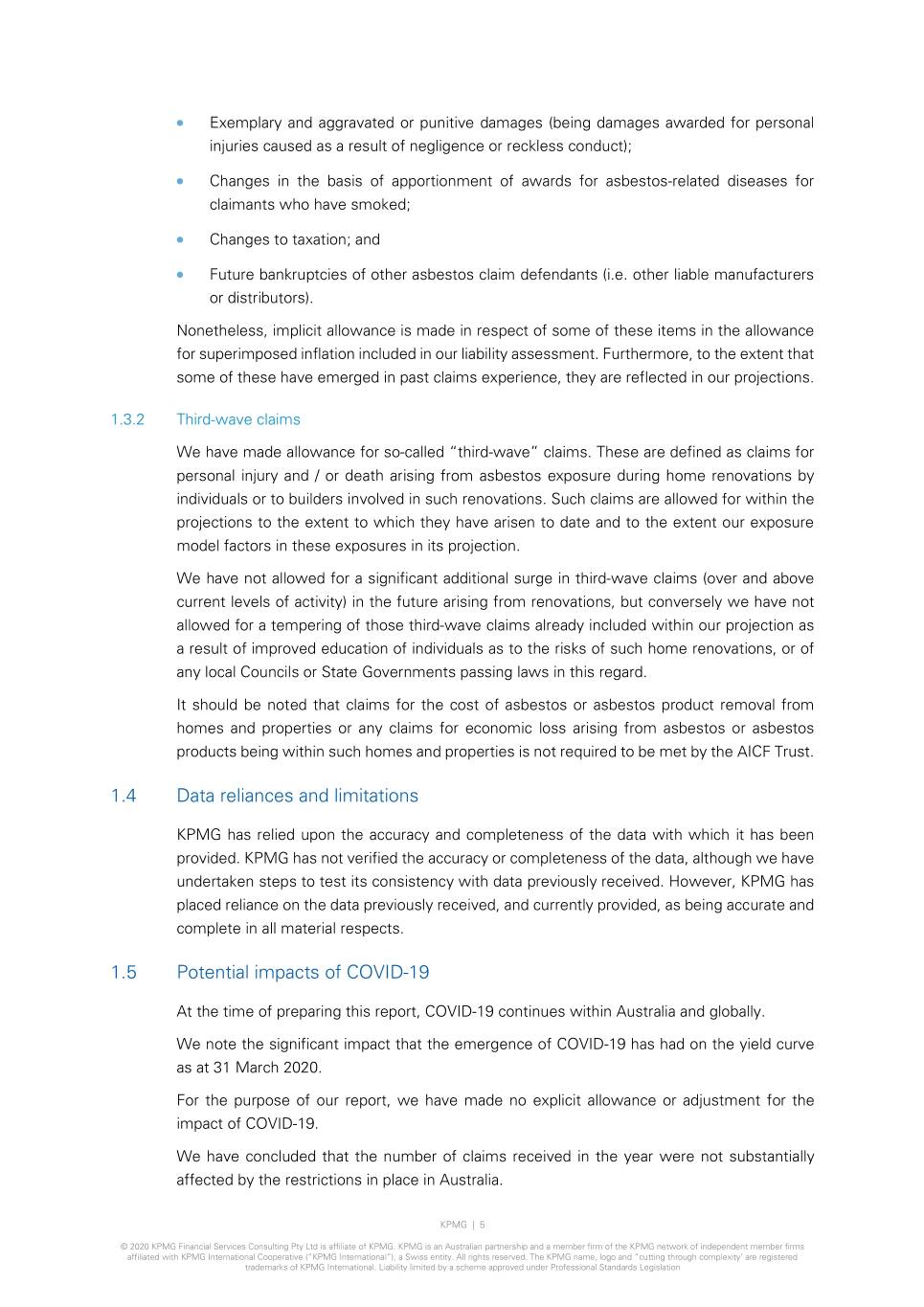
• Exemplary and aggravated or punitive damages (being damages awarded for personal injuries caused as a result of negligence or reckless conduct); • Changes in the basis of apportionment of awards for asbestos-related diseases for claimants who have smoked; • Changes to taxation; and • Future bankruptcies of other asbestos claim defendants (i.e. other liable manufacturers or distributors). Nonetheless, implicit allowance is made in respect of some of these items in the allowance for superimposed inflation included in our liability assessment. Furthermore, to the extent that some of these have emerged in past claims experience, they are reflected in our projections. 1.3.2 Third-wave claims We have made allowance for so-called “third-wave” claims. These are defined as claims for personal injury and / or death arising from asbestos exposure during home renovations by individuals or to builders involved in such renovations. Such claims are allowed for within the projections to the extent to which they have arisen to date and to the extent our exposure model factors in these exposures in its projection. We have not allowed for a significant additional surge in third-wave claims (over and above current levels of activity) in the future arising from renovations, but conversely we have not allowed for a tempering of those third-wave claims already included within our projection as a result of improved education of individuals as to the risks of such home renovations, or of any local Councils or State Governments passing laws in this regard. It should be noted that claims for the cost of asbestos or asbestos product removal from homes and properties or any claims for economic loss arising from asbestos or asbestos products being within such homes and properties is not required to be met by the AICF Trust. 1.4 Data reliances and limitations KPMG has relied upon the accuracy and completeness of the data with which it has been provided. KPMG has not verified the accuracy or completeness of the data, although we have undertaken steps to test its consistency with data previously received. However, KPMG has placed reliance on the data previously received, and currently provided, as being accurate and complete in all material respects. 1.5 Potential impacts of COVID-19 At the time of preparing this report, COVID-19 continues within Australia and globally. We note the significant impact that the emergence of COVID-19 has had on the yield curve as at 31 March 2020. For the purpose of our report, we have made no explicit allowance or adjustment for the impact of COVID-19. We have concluded that the number of claims received in the year were not substantially affected by the restrictions in place in Australia. KPMG | 5 © 2020 KPMG Financial Services Consulting Pty Ltd is affiliate of KPMG. KPMG is an Australian partnership and a member firm of the KPMG network of independent member firms affiliated with KPMG International Cooperative (“KPMG International”), a Swiss entity. All rights reserved. The KPMG name, logo and “cutting through complexity’ are registered trademarks of KPMG International. Liability limited by a scheme approved under Professional Standards Legislation
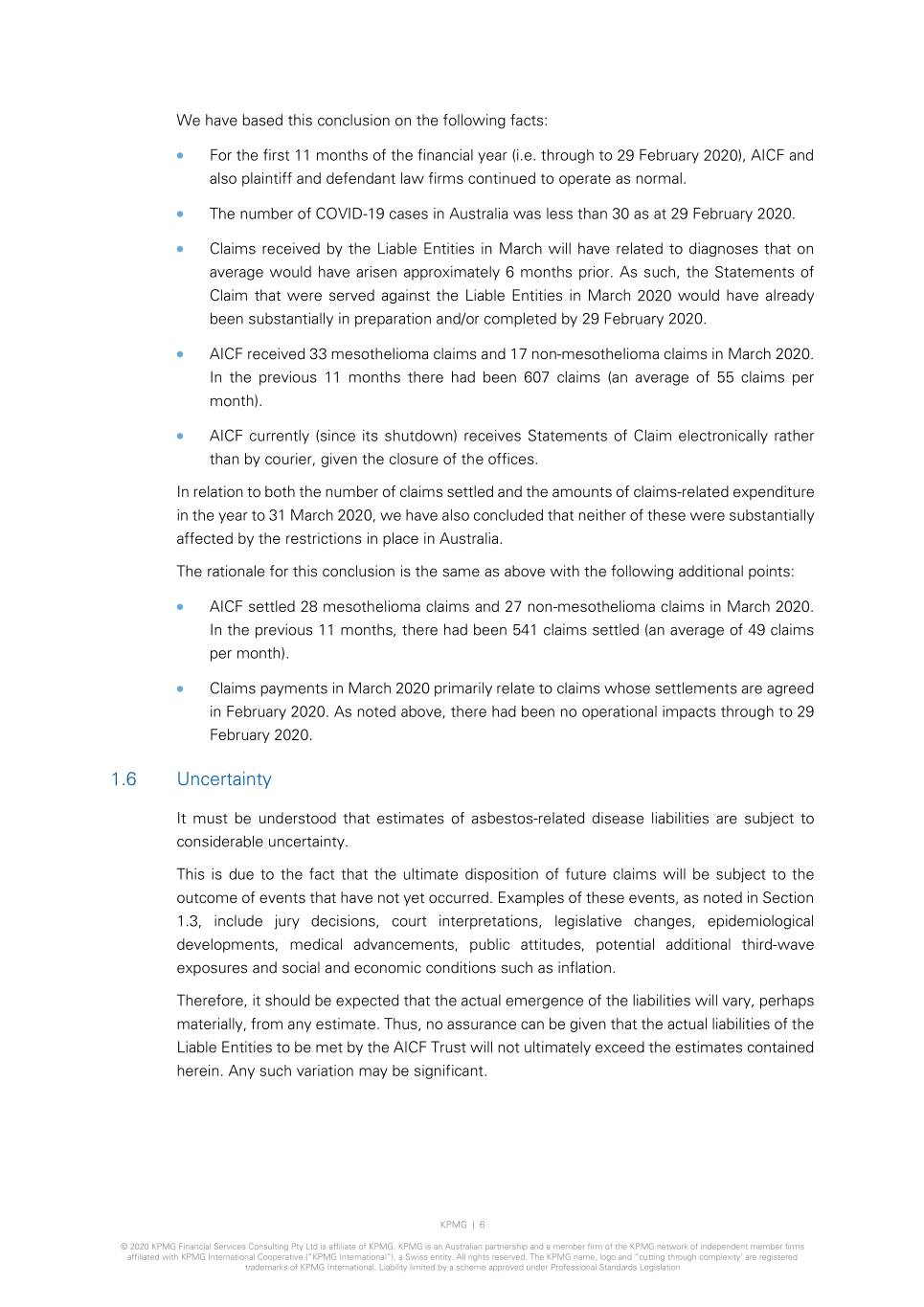
We have based this conclusion on the following facts: • For the first 11 months of the financial year (i.e. through to 29 February 2020), AICF and also plaintiff and defendant law firms continued to operate as normal. • The number of COVID-19 cases in Australia was less than 30 as at 29 February 2020. • Claims received by the Liable Entities in March will have related to diagnoses that on average would have arisen approximately 6 months prior. As such, the Statements of Claim that were served against the Liable Entities in March 2020 would have already been substantially in preparation and/or completed by 29 February 2020. • AICF received 33 mesothelioma claims and 17 non-mesothelioma claims in March 2020. In the previous 11 months there had been 607 claims (an average of 55 claims per month). • AICF currently (since its shutdown) receives Statements of Claim electronically rather than by courier, given the closure of the offices. In relation to both the number of claims settled and the amounts of claims-related expenditure in the year to 31 March 2020, we have also concluded that neither of these were substantially affected by the restrictions in place in Australia. The rationale for this conclusion is the same as above with the following additional points: • AICF settled 28 mesothelioma claims and 27 non-mesothelioma claims in March 2020. In the previous 11 months, there had been 541 claims settled (an average of 49 claims per month). • Claims payments in March 2020 primarily relate to claims whose settlements are agreed in February 2020. As noted above, there had been no operational impacts through to 29 February 2020. 1.6 Uncertainty It must be understood that estimates of asbestos-related disease liabilities are subject to considerable uncertainty. This is due to the fact that the ultimate disposition of future claims will be subject to the outcome of events that have not yet occurred. Examples of these events, as noted in Section 1.3, include jury decisions, court interpretations, legislative changes, epidemiological developments, medical advancements, public attitudes, potential additional third-wave exposures and social and economic conditions such as inflation. Therefore, it should be expected that the actual emergence of the liabilities will vary, perhaps materially, from any estimate. Thus, no assurance can be given that the actual liabilities of the Liable Entities to be met by the AICF Trust will not ultimately exceed the estimates contained herein. Any such variation may be significant. KPMG | 6 © 2020 KPMG Financial Services Consulting Pty Ltd is affiliate of KPMG. KPMG is an Australian partnership and a member firm of the KPMG network of independent member firms affiliated with KPMG International Cooperative (“KPMG International”), a Swiss entity. All rights reserved. The KPMG name, logo and “cutting through complexity’ are registered trademarks of KPMG International. Liability limited by a scheme approved under Professional Standards Legislation
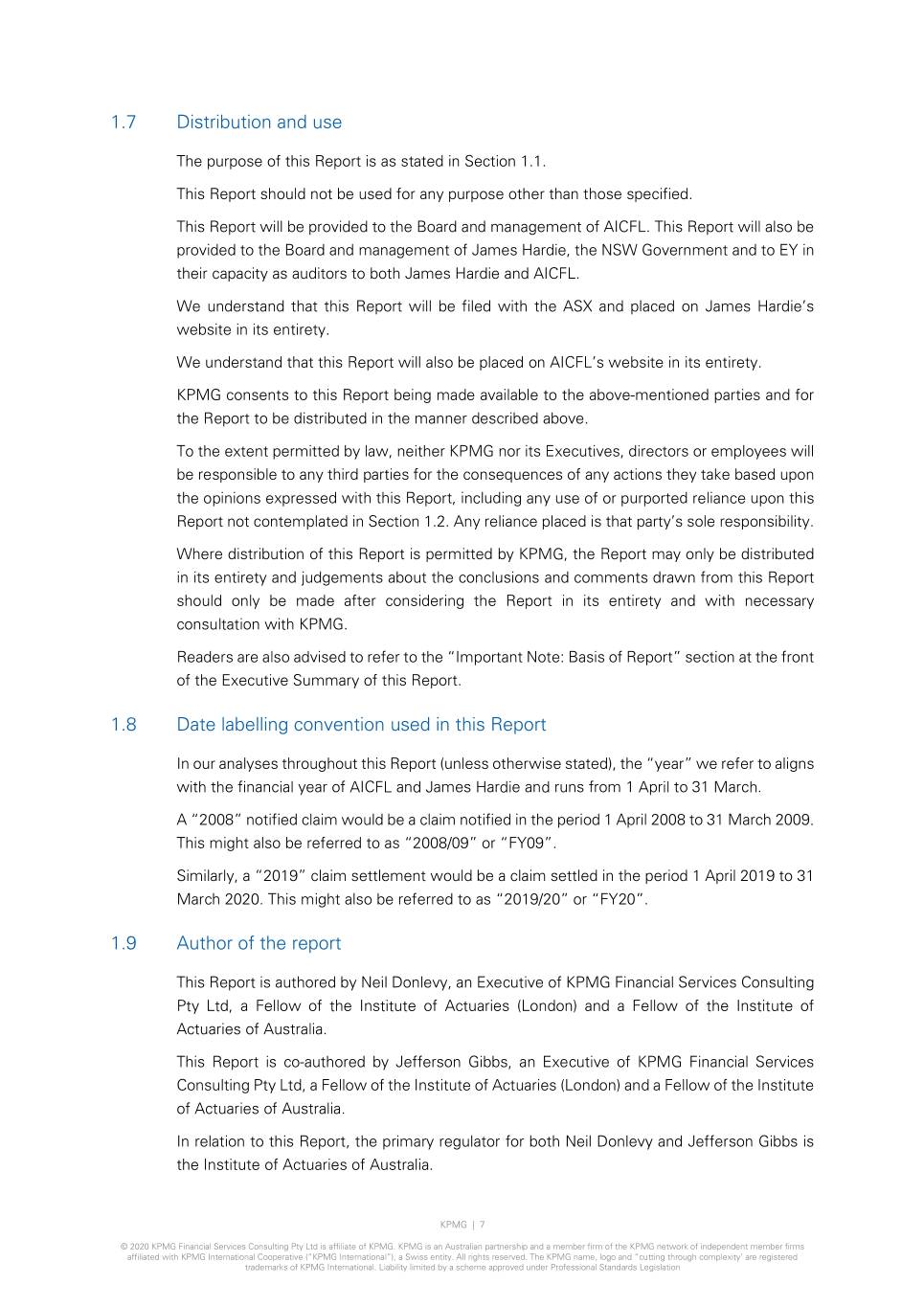
1.7 Distribution and use The purpose of this Report is as stated in Section 1.1. This Report should not be used for any purpose other than those specified. This Report will be provided to the Board and management of AICFL. This Report will also be provided to the Board and management of James Hardie, the NSW Government and to EY in their capacity as auditors to both James Hardie and AICFL. We understand that this Report will be filed with the ASX and placed on James Hardie’s website in its entirety. We understand that this Report will also be placed on AICFL’s website in its entirety. KPMG consents to this Report being made available to the above-mentioned parties and for the Report to be distributed in the manner described above. To the extent permitted by law, neither KPMG nor its Executives, directors or employees will be responsible to any third parties for the consequences of any actions they take based upon the opinions expressed with this Report, including any use of or purported reliance upon this Report not contemplated in Section 1.2. Any reliance placed is that party’s sole responsibility. Where distribution of this Report is permitted by KPMG, the Report may only be distributed in its entirety and judgements about the conclusions and comments drawn from this Report should only be made after considering the Report in its entirety and with necessary consultation with KPMG. Readers are also advised to refer to the “Important Note: Basis of Report” section at the front of the Executive Summary of this Report. 1.8 Date labelling convention used in this Report In our analyses throughout this Report (unless otherwise stated), the “year” we refer to aligns with the financial year of AICFL and James Hardie and runs from 1 April to 31 March. A “2008” notified claim would be a claim notified in the period 1 April 2008 to 31 March 2009. This might also be referred to as “2008/09” or “FY09”. Similarly, a “2019” claim settlement would be a claim settled in the period 1 April 2019 to 31 March 2020. This might also be referred to as “2019/20” or “FY20”. 1.9 Author of the report This Report is authored by Neil Donlevy, an Executive of KPMG Financial Services Consulting Pty Ltd, a Fellow of the Institute of Actuaries (London) and a Fellow of the Institute of Actuaries of Australia. This Report is co-authored by Jefferson Gibbs, an Executive of KPMG Financial Services Consulting Pty Ltd, a Fellow of the Institute of Actuaries (London) and a Fellow of the Institute of Actuaries of Australia. In relation to this Report, the primary regulator for both Neil Donlevy and Jefferson Gibbs is the Institute of Actuaries of Australia. KPMG | 7 © 2020 KPMG Financial Services Consulting Pty Ltd is affiliate of KPMG. KPMG is an Australian partnership and a member firm of the KPMG network of independent member firms affiliated with KPMG International Cooperative (“KPMG International”), a Swiss entity. All rights reserved. The KPMG name, logo and “cutting through complexity’ are registered trademarks of KPMG International. Liability limited by a scheme approved under Professional Standards Legislation

1.10 Professional standards and compliance This Report details a valuation of the outstanding claims liabilities of entities which hold liabilities with features similar to general insurance liabilities. In preparing this Report, we have complied with the Professional Standard 302 of the Institute of Actuaries of Australia (“PS302”), “Valuation of General Insurance Claims”. However, as we note in Section 1.2, this Report does not include an allowance for the future Operating Expenses of the AICF Trust (which are estimated by AICFL) and nor does it include any allowance for a risk margin to reflect the inherent uncertainty in the liability assessment. 1.11 Control processes and review This valuation report and the underlying analyses have been subject to technical review and internal peer review. The technical review focuses on ensuring that the valuation models and supporting claims experience analyses that are carried out are performed correctly and that the calculations are being correctly applied. The technical review also focuses on ensuring that the data that is being used has been reconciled insofar as possible. Internal peer review involves a review of the approach, the methods, the assumptions selected and the professional judgments applied. Both the technical review and internal peer review processes are applied to the Report as well as the valuation models. 1.12 Basis of preparation of Report We have been advised by the management of AICFL to prepare the Report on a “going concern” basis (i.e. we should assume that AICFL will be able to meet any shortfall in the cost of the liabilities of the Liable Entities as they fall due). The cashflow estimates contained in this Report assume that claims against the Liable Entities will continue to be paid in full as and when they fall due. KPMG | 8 © 2020 KPMG Financial Services Consulting Pty Ltd is affiliate of KPMG. KPMG is an Australian partnership and a member firm of the KPMG network of independent member firms affiliated with KPMG International Cooperative (“KPMG International”), a Swiss entity. All rights reserved. The KPMG name, logo and “cutting through complexity’ are registered trademarks of KPMG International. Liability limited by a scheme approved under Professional Standards Legislation
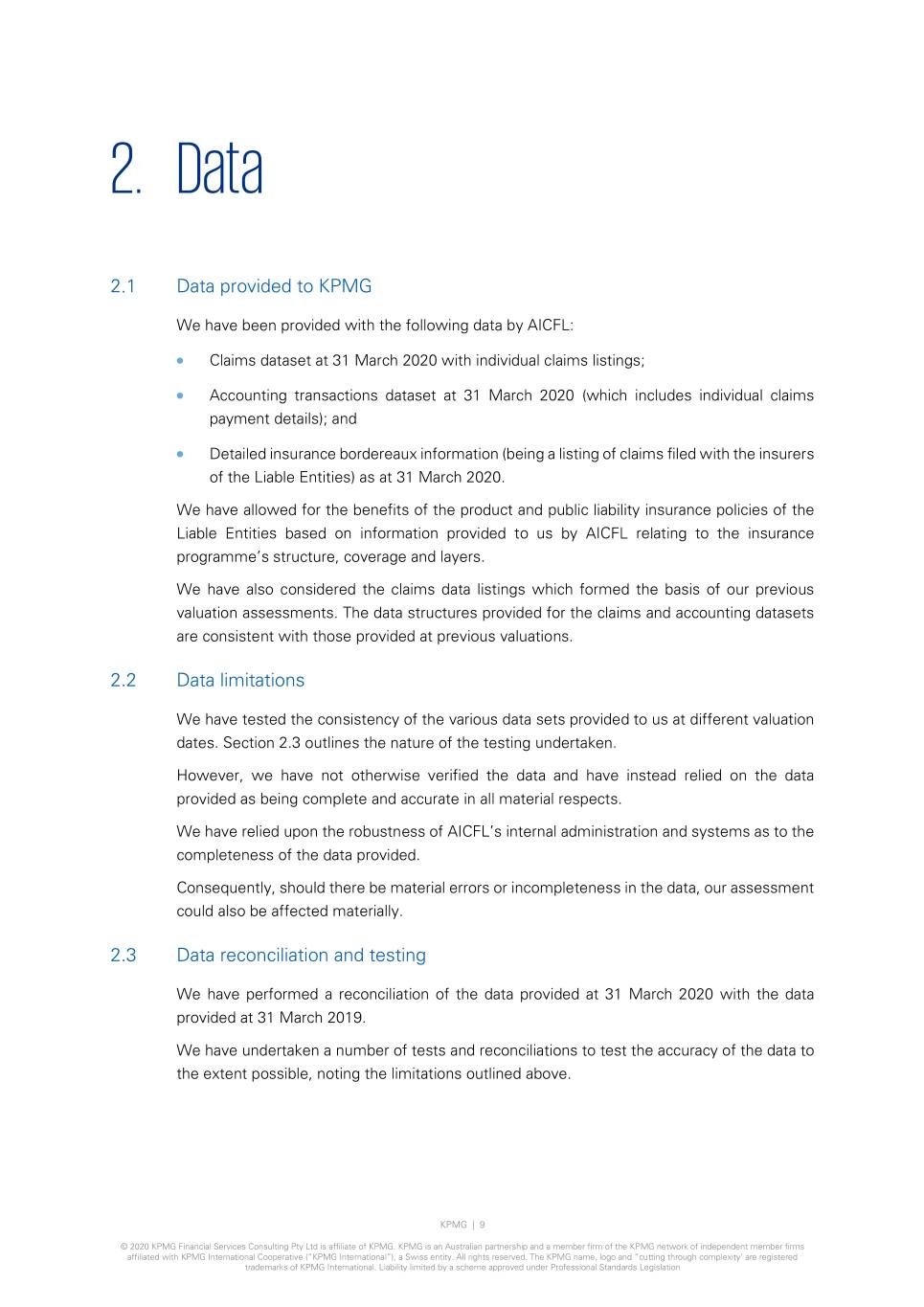
2. Data 2.1 Data provided to KPMG We have been provided with the following data by AICFL: • Claims dataset at 31 March 2020 with individual claims listings; • Accounting transactions dataset at 31 March 2020 (which includes individual claims payment details); and • Detailed insurance bordereaux information (being a listing of claims filed with the insurers of the Liable Entities) as at 31 March 2020. We have allowed for the benefits of the product and public liability insurance policies of the Liable Entities based on information provided to us by AICFL relating to the insurance programme’s structure, coverage and layers. We have also considered the claims data listings which formed the basis of our previous valuation assessments. The data structures provided for the claims and accounting datasets are consistent with those provided at previous valuations. 2.2 Data limitations We have tested the consistency of the various data sets provided to us at different valuation dates. Section 2.3 outlines the nature of the testing undertaken. However, we have not otherwise verified the data and have instead relied on the data provided as being complete and accurate in all material respects. We have relied upon the robustness of AICFL’s internal administration and systems as to the completeness of the data provided. Consequently, should there be material errors or incompleteness in the data, our assessment could also be affected materially. 2.3 Data reconciliation and testing We have performed a reconciliation of the data provided at 31 March 2020 with the data provided at 31 March 2019. We have undertaken a number of tests and reconciliations to test the accuracy of the data to the extent possible, noting the limitations outlined above. KPMG | 9 © 2020 KPMG Financial Services Consulting Pty Ltd is affiliate of KPMG. KPMG is an Australian partnership and a member firm of the KPMG network of independent member firms affiliated with KPMG International Cooperative (“KPMG International”), a Swiss entity. All rights reserved. The KPMG name, logo and “cutting through complexity’ are registered trademarks of KPMG International. Liability limited by a scheme approved under Professional Standards Legislation
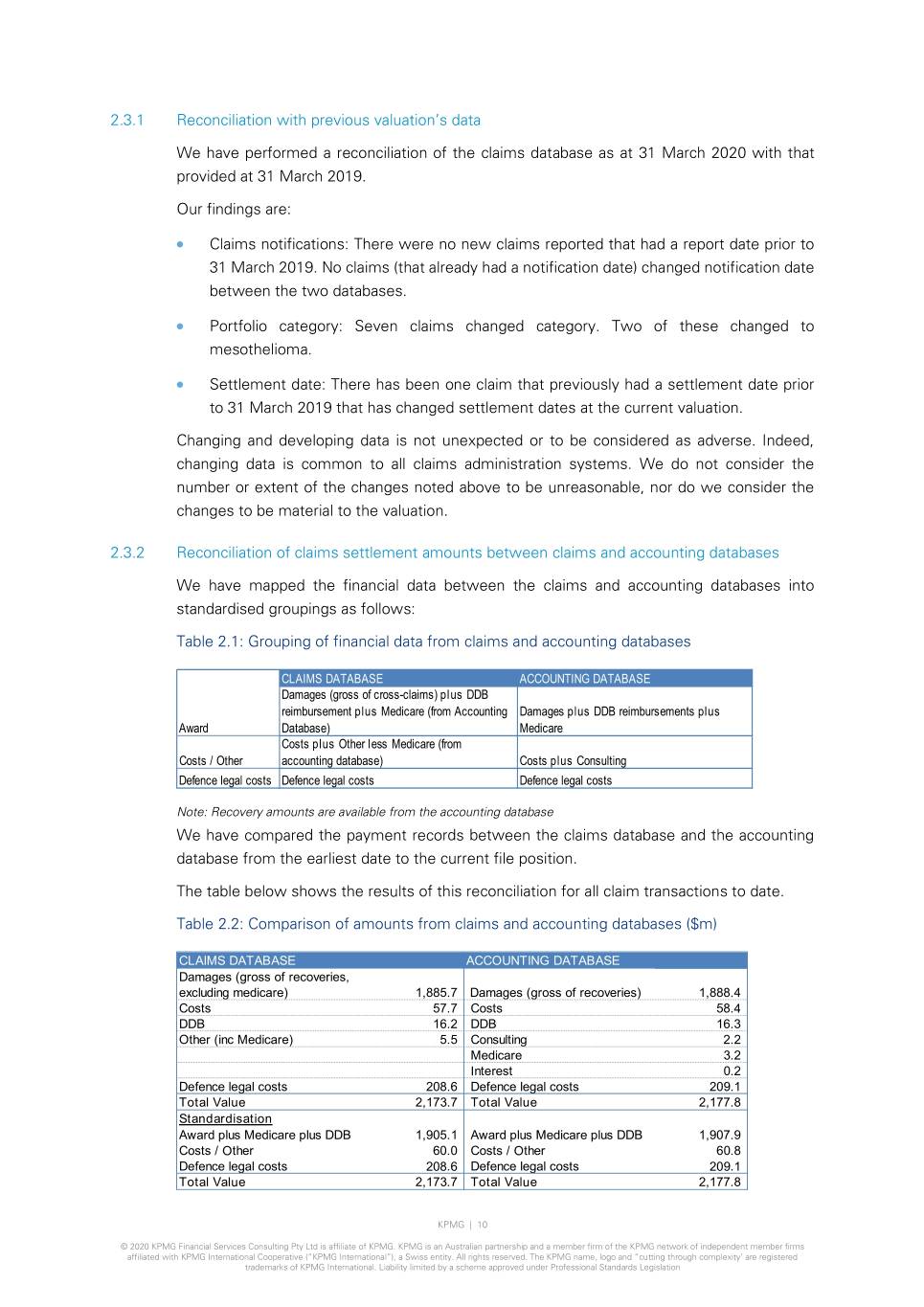
2.3.1 Reconciliation with previous valuation’s data We have performed a reconciliation of the claims database as at 31 March 2020 with that provided at 31 March 2019. Our findings are: • Claims notifications: There were no new claims reported that had a report date prior to 31 March 2019. No claims (that already had a notification date) changed notification date between the two databases. • Portfolio category: Seven claims changed category. Two of these changed to mesothelioma. • Settlement date: There has been one claim that previously had a settlement date prior to 31 March 2019 that has changed settlement dates at the current valuation. Changing and developing data is not unexpected or to be considered as adverse. Indeed, changing data is common to all claims administration systems. We do not consider the number or extent of the changes noted above to be unreasonable, nor do we consider the changes to be material to the valuation. 2.3.2 Reconciliation of claims settlement amounts between claims and accounting databases We have mapped the financial data between the claims and accounting databases into standardised groupings as follows: Table 2.1: Grouping of financial data from claims and accounting databases CLAIMS DATABASE ACCOUNTING DATABASE Damages (gross of cross-claims) plus DDB reimbursement plus Medicare (from Accounting Damages plus DDB reimbursements plus Award Database) Medicare Costs plus Other less Medicare (from Costs / Other accounting database) Costs plus Consulting Defence legal costs Defence legal costs Defence legal costs Note: Recovery amounts are available from the accounting database We have compared the payment records between the claims database and the accounting database from the earliest date to the current file position. The table below shows the results of this reconciliation for all claim transactions to date. Table 2.2: Comparison of amounts from claims and accounting databases ($m) CLAIMS DATABASE ACCOUNTING DATABASE Damages (gross of recoveries, excluding medicare) 1,885.7 Damages (gross of recoveries) 1,888.4 Costs 57.7 Costs 58.4 DDB 16.2 DDB 16.3 Other (inc Medicare) 5.5 Consulting 2.2 Medicare 3.2 Interest 0.2 Defence legal costs 208.6 Defence legal costs 209.1 Total Value 2,173.7 Total Value 2,177.8 Standardisation Award plus Medicare plus DDB 1,905.1 Award plus Medicare plus DDB 1,907.9 Costs / Other 60.0 Costs / Other 60.8 Defence legal costs 208.6 Defence legal costs 209.1 Total Value 2,173.7 Total Value 2,177.8 KPMG | 10 © 2020 KPMG Financial Services Consulting Pty Ltd is affiliate of KPMG. KPMG is an Australian partnership and a member firm of the KPMG network of independent member firms affiliated with KPMG International Cooperative (“KPMG International”), a Swiss entity. All rights reserved. The KPMG name, logo and “cutting through complexity’ are registered trademarks of KPMG International. Liability limited by a scheme approved under Professional Standards Legislation
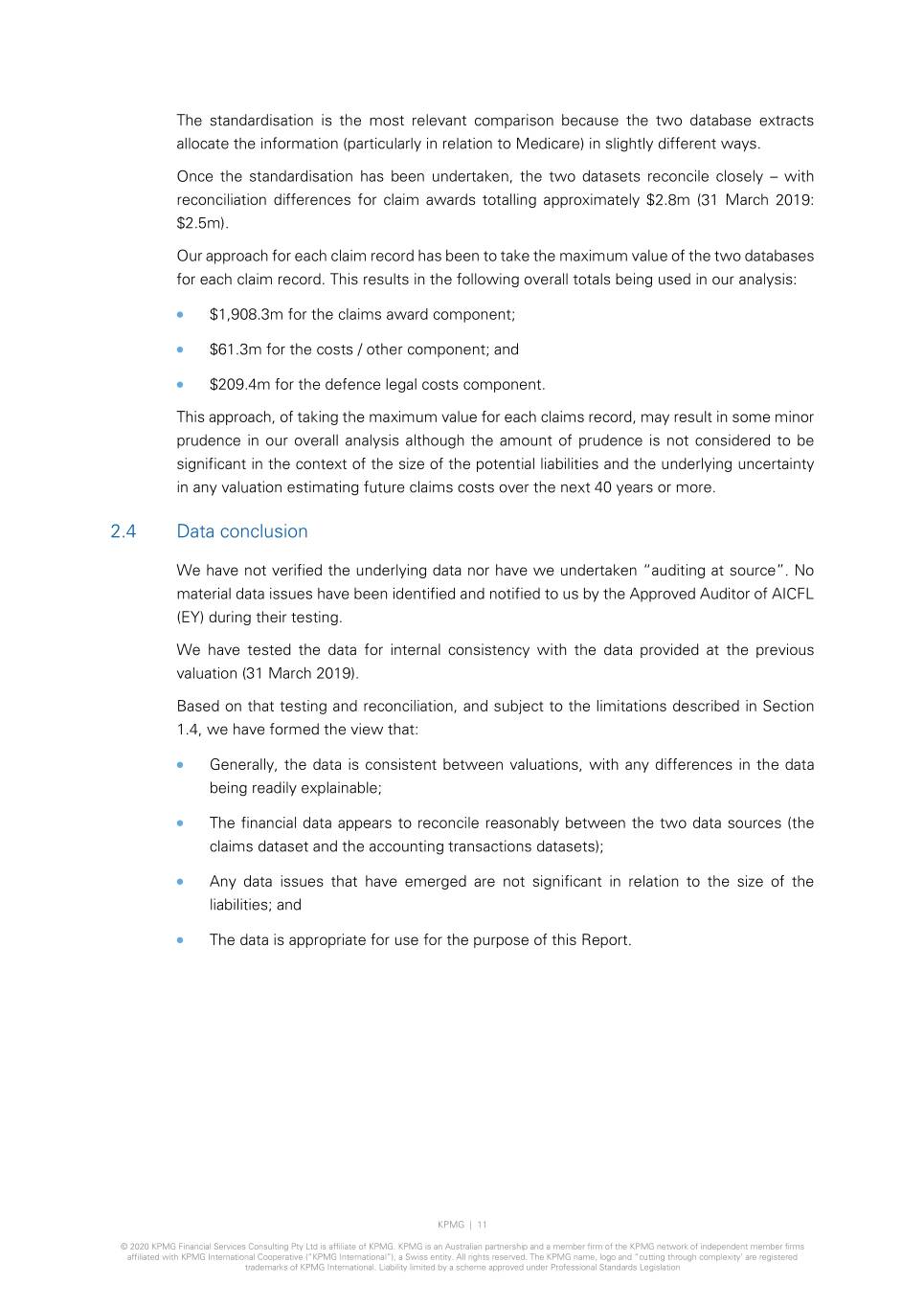
The standardisation is the most relevant comparison because the two database extracts allocate the information (particularly in relation to Medicare) in slightly different ways. Once the standardisation has been undertaken, the two datasets reconcile closely – with reconciliation differences for claim awards totalling approximately $2.8m (31 March 2019: $2.5m). Our approach for each claim record has been to take the maximum value of the two databases for each claim record. This results in the following overall totals being used in our analysis: • $1,908.3m for the claims award component; • $61.3m for the costs / other component; and • $209.4m for the defence legal costs component. This approach, of taking the maximum value for each claims record, may result in some minor prudence in our overall analysis although the amount of prudence is not considered to be significant in the context of the size of the potential liabilities and the underlying uncertainty in any valuation estimating future claims costs over the next 40 years or more. 2.4 Data conclusion We have not verified the underlying data nor have we undertaken “auditing at source”. No material data issues have been identified and notified to us by the Approved Auditor of AICFL (EY) during their testing. We have tested the data for internal consistency with the data provided at the previous valuation (31 March 2019). Based on that testing and reconciliation, and subject to the limitations described in Section 1.4, we have formed the view that: • Generally, the data is consistent between valuations, with any differences in the data being readily explainable; • The financial data appears to reconcile reasonably between the two data sources (the claims dataset and the accounting transactions datasets); • Any data issues that have emerged are not significant in relation to the size of the liabilities; and • The data is appropriate for use for the purpose of this Report. KPMG | 11 © 2020 KPMG Financial Services Consulting Pty Ltd is affiliate of KPMG. KPMG is an Australian partnership and a member firm of the KPMG network of independent member firms affiliated with KPMG International Cooperative (“KPMG International”), a Swiss entity. All rights reserved. The KPMG name, logo and “cutting through complexity’ are registered trademarks of KPMG International. Liability limited by a scheme approved under Professional Standards Legislation

3. Valuation Methodology and Approach 3.1 Valuation methodology changes We have, in broad terms, maintained the core valuation methodology adopted at our previous valuation. At this valuation, in light of the emerging experience in relation to mesothelioma claim numbers and the changes in mix of those claims, we have separately analysed (and set assumptions for) direct claims and cross claims. Readers of this report are reminded that for mesothelioma claims, we have four separate age cohorts for which we set assumptions, namely • <60 years of age; • 60-70 years of age; • 70-80 years of age; and • 80+ years of age. We have derived separate assumptions for direct claims and cross claims and for each of the four age cohorts for: • estimated future claim numbers (including latency assumptions); • average claim sizes; • average legal costs; and • nil settlement rates. 3.2 Overview of current methodology The methodology involves assessing the liabilities in two separate components, being: • Allowance for the cost of settling claims which have already been reported but have not yet been settled (“pending claims”); and • Allowance for the cost of settling claims which have not yet been reported (“Incurred But Not Reported” or “IBNR” claims). KPMG | 12 © 2020 KPMG Financial Services Consulting Pty Ltd is affiliate of KPMG. KPMG is an Australian partnership and a member firm of the KPMG network of independent member firms affiliated with KPMG International Cooperative (“KPMG International”), a Swiss entity. All rights reserved. The KPMG name, logo and “cutting through complexity’ are registered trademarks of KPMG International. Liability limited by a scheme approved under Professional Standards Legislation

For pending claims, we have used the case estimates (where available) with some adjustments to reflect the extent to which the case estimates (on average) tend to overstate the ultimate cost. For IBNR claims we have used an “average cost per claim method”. In brief, the overall methodology may be summarised as follows: • Project the future number of claims expected to be reported in each future year by disease type (for product and public liability) and for Workers Compensation and wharf claims taking into account the expected future incidence of mesothelioma and other diseases and also the past rate of co-joining of the Liable Entities; • Analyse past average attritional claim costs of non-nil claims in mid 2019/20 money terms. We have defined attritional claims to be claims which are less than $1m in 2006/07 money terms. We estimate a baseline attritional non-nil average claim cost in mid 2019/20 money terms. This represents the Liable Entities’ share of a claim rather than the total claim settlement; • Analyse past historical average plaintiff/other and defendant legal costs for non-nil claim settlements; • Analyse past historical average defendant legal costs for nil claim settlements; • Estimate a “large claims loading” for mesothelioma claims by estimating the frequency, or incidence rate, and average claim size and legal cost sizes of such claims (being claims which are in excess of $1m in 2006/07 money terms); • Project the pattern and incidence of future claims settlements from the claims reporting profile projected. This is done by using a settlement pattern derived from consideration of past experience of the pattern of delay between claim reporting and claim settlement for each disease type; • Estimate the proportion of claims which will be settled with no liability against the Liable Entities by reference to past proportions of claims settled for nil claim cost (we refer to this as the “nil settlement rate”); • Inflate average claim, plaintiff/other and defence legal costs and large claim costs to the date of settlement of claims allowing for base inflation and (where applicable) superimposed inflation; • Multiply the claims numbers which are expected to be settled for non-nil amounts in a period by the inflated average non-nil claim costs (including the “large claims loading”) and plaintiff/other and defence legal costs for that period; • Make allowance in defence legal costs for that proportion of settled claims which are expected to be settled for no liability but for which defence costs will be incurred; • Inflate average defence legal costs of nil claims to the date of settlement of claims allowing for base inflation; • Multiply the claims numbers which are expected to be settled for nil amounts in a period by the inflated average defence legal costs for nil claims for that period; KPMG | 13 © 2020 KPMG Financial Services Consulting Pty Ltd is affiliate of KPMG. KPMG is an Australian partnership and a member firm of the KPMG network of independent member firms affiliated with KPMG International Cooperative (“KPMG International”), a Swiss entity. All rights reserved. The KPMG name, logo and “cutting through complexity’ are registered trademarks of KPMG International. Liability limited by a scheme approved under Professional Standards Legislation
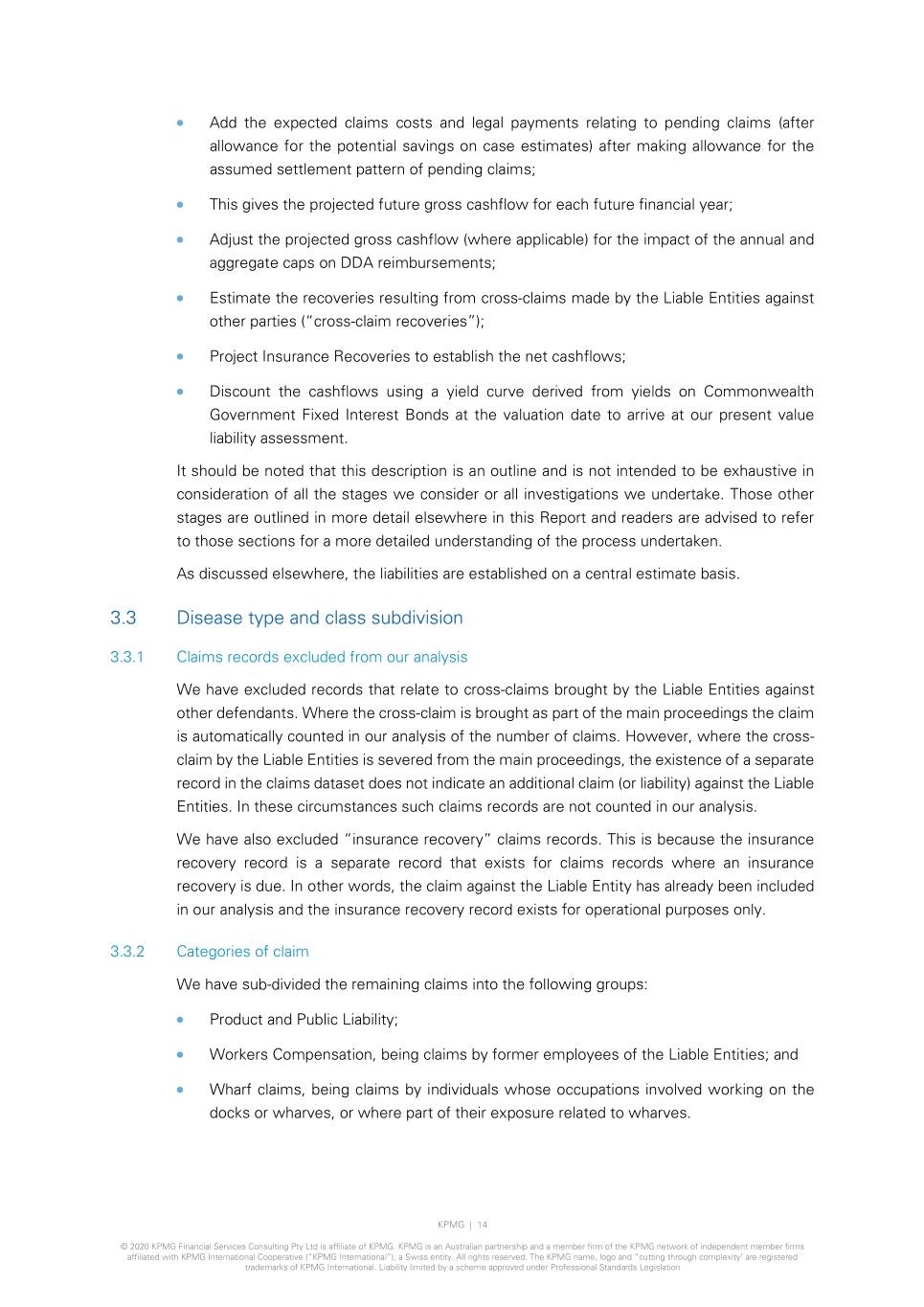
• Add the expected claims costs and legal payments relating to pending claims (after allowance for the potential savings on case estimates) after making allowance for the assumed settlement pattern of pending claims; • This gives the projected future gross cashflow for each future financial year; • Adjust the projected gross cashflow (where applicable) for the impact of the annual and aggregate caps on DDA reimbursements; • Estimate the recoveries resulting from cross-claims made by the Liable Entities against other parties (“cross-claim recoveries”); • Project Insurance Recoveries to establish the net cashflows; • Discount the cashflows using a yield curve derived from yields on Commonwealth Government Fixed Interest Bonds at the valuation date to arrive at our present value liability assessment. It should be noted that this description is an outline and is not intended to be exhaustive in consideration of all the stages we consider or all investigations we undertake. Those other stages are outlined in more detail elsewhere in this Report and readers are advised to refer to those sections for a more detailed understanding of the process undertaken. As discussed elsewhere, the liabilities are established on a central estimate basis. 3.3 Disease type and class subdivision 3.3.1 Claims records excluded from our analysis We have excluded records that relate to cross-claims brought by the Liable Entities against other defendants. Where the cross-claim is brought as part of the main proceedings the claim is automatically counted in our analysis of the number of claims. However, where the cross- claim by the Liable Entities is severed from the main proceedings, the existence of a separate record in the claims dataset does not indicate an additional claim (or liability) against the Liable Entities. In these circumstances such claims records are not counted in our analysis. We have also excluded “insurance recovery” claims records. This is because the insurance recovery record is a separate record that exists for claims records where an insurance recovery is due. In other words, the claim against the Liable Entity has already been included in our analysis and the insurance recovery record exists for operational purposes only. 3.3.2 Categories of claim We have sub-divided the remaining claims into the following groups: • Product and Public Liability; • Workers Compensation, being claims by former employees of the Liable Entities; and • Wharf claims, being claims by individuals whose occupations involved working on the docks or wharves, or where part of their exposure related to wharves. KPMG | 14 © 2020 KPMG Financial Services Consulting Pty Ltd is affiliate of KPMG. KPMG is an Australian partnership and a member firm of the KPMG network of independent member firms affiliated with KPMG International Cooperative (“KPMG International”), a Swiss entity. All rights reserved. The KPMG name, logo and “cutting through complexity’ are registered trademarks of KPMG International. Liability limited by a scheme approved under Professional Standards Legislation
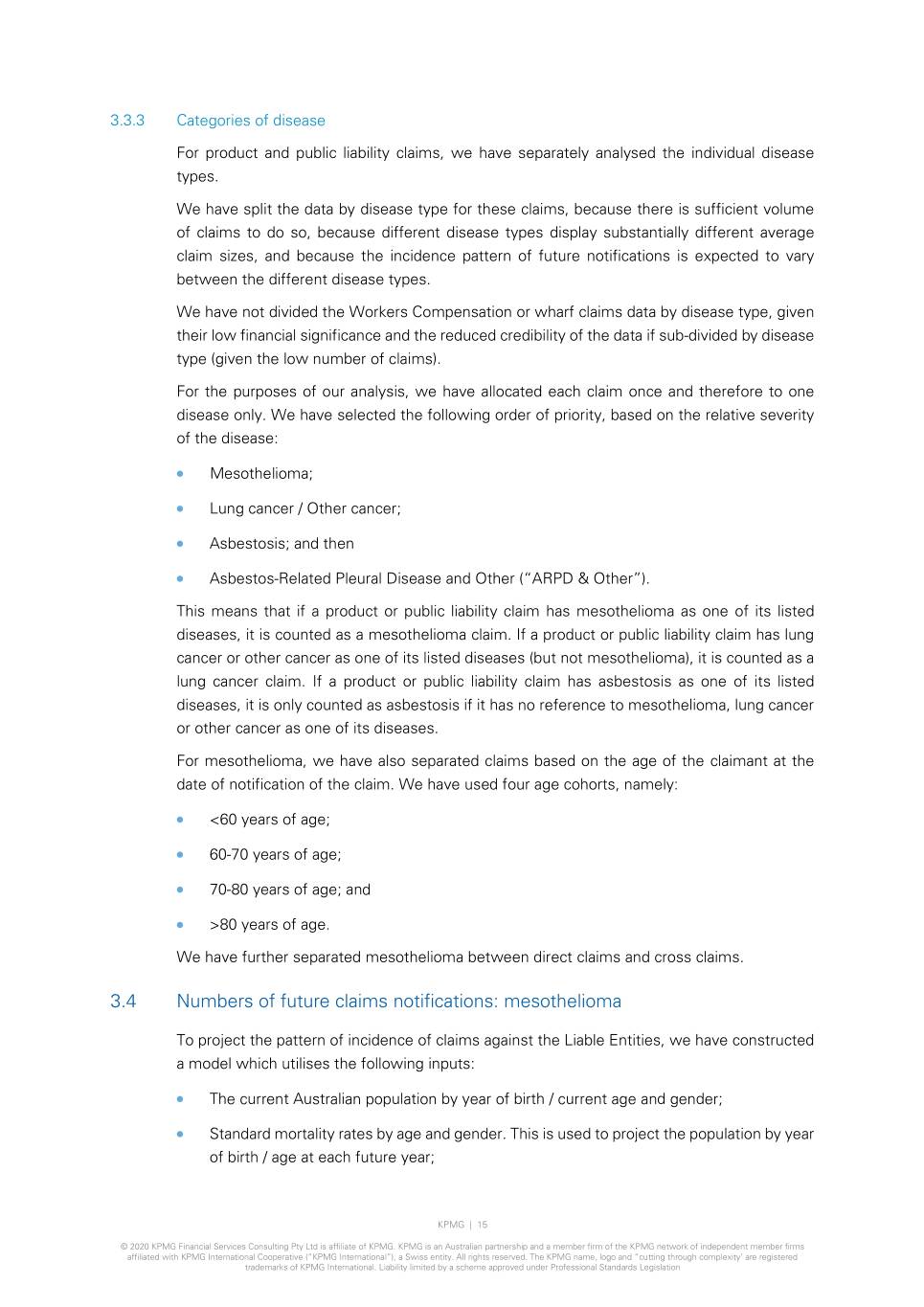
3.3.3 Categories of disease For product and public liability claims, we have separately analysed the individual disease types. We have split the data by disease type for these claims, because there is sufficient volume of claims to do so, because different disease types display substantially different average claim sizes, and because the incidence pattern of future notifications is expected to vary between the different disease types. We have not divided the Workers Compensation or wharf claims data by disease type, given their low financial significance and the reduced credibility of the data if sub-divided by disease type (given the low number of claims). For the purposes of our analysis, we have allocated each claim once and therefore to one disease only. We have selected the following order of priority, based on the relative severity of the disease: • Mesothelioma; • Lung cancer / Other cancer; • Asbestosis; and then • Asbestos-Related Pleural Disease and Other (“ARPD & Other”). This means that if a product or public liability claim has mesothelioma as one of its listed diseases, it is counted as a mesothelioma claim. If a product or public liability claim has lung cancer or other cancer as one of its listed diseases (but not mesothelioma), it is counted as a lung cancer claim. If a product or public liability claim has asbestosis as one of its listed diseases, it is only counted as asbestosis if it has no reference to mesothelioma, lung cancer or other cancer as one of its diseases. For mesothelioma, we have also separated claims based on the age of the claimant at the date of notification of the claim. We have used four age cohorts, namely: • <60 years of age; • 60-70 years of age; • 70-80 years of age; and • >80 years of age. We have further separated mesothelioma between direct claims and cross claims. 3.4 Numbers of future claims notifications: mesothelioma To project the pattern of incidence of claims against the Liable Entities, we have constructed a model which utilises the following inputs: • The current Australian population by year of birth / current age and gender; • Standard mortality rates by age and gender. This is used to project the population by year of birth / age at each future year; KPMG | 15 © 2020 KPMG Financial Services Consulting Pty Ltd is affiliate of KPMG. KPMG is an Australian partnership and a member firm of the KPMG network of independent member firms affiliated with KPMG International Cooperative (“KPMG International”), a Swiss entity. All rights reserved. The KPMG name, logo and “cutting through complexity’ are registered trademarks of KPMG International. Liability limited by a scheme approved under Professional Standards Legislation
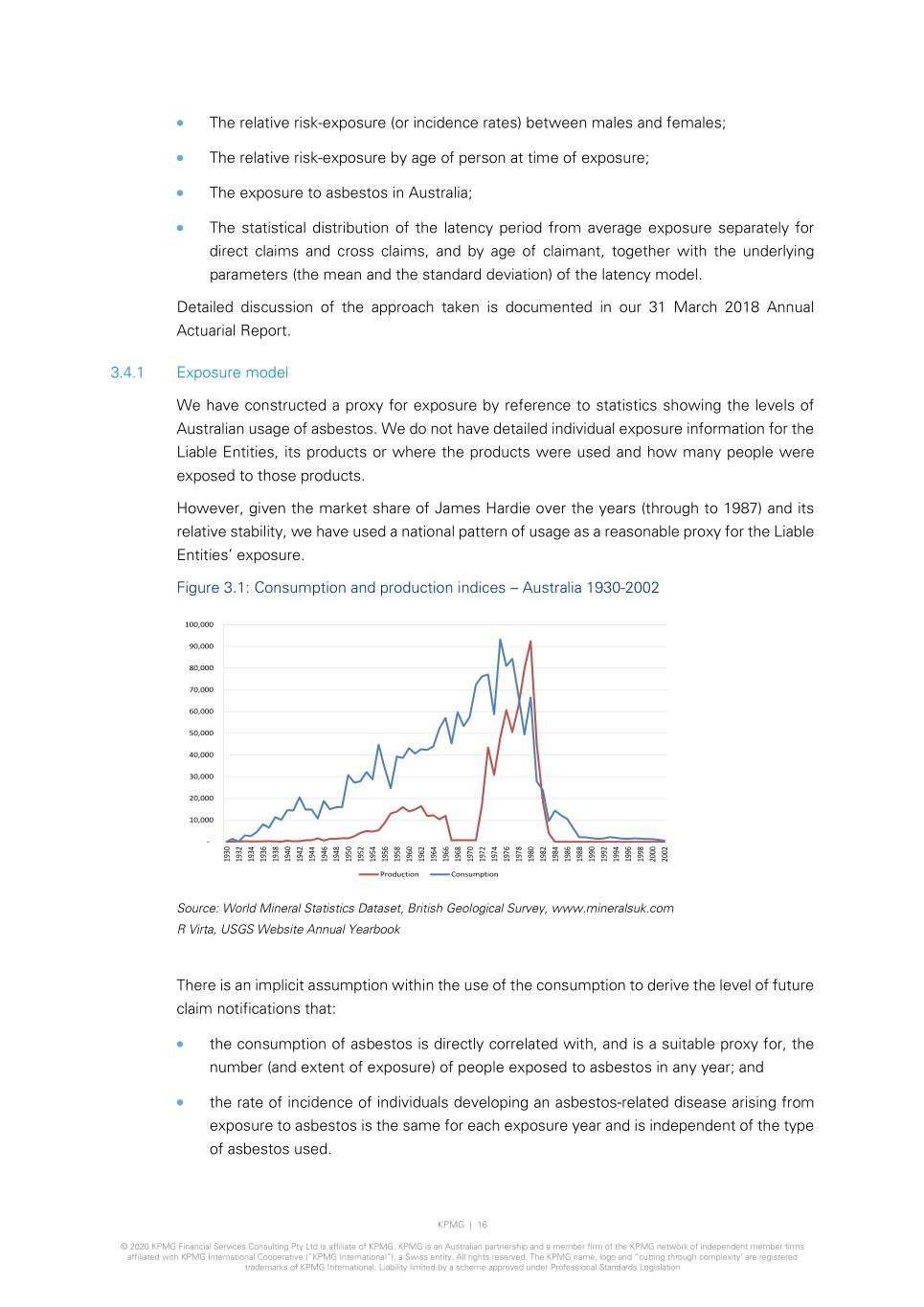
• The relative risk-exposure (or incidence rates) between males and females; • The relative risk-exposure by age of person at time of exposure; • The exposure to asbestos in Australia; • The statistical distribution of the latency period from average exposure separately for direct claims and cross claims, and by age of claimant, together with the underlying parameters (the mean and the standard deviation) of the latency model. Detailed discussion of the approach taken is documented in our 31 March 2018 Annual Actuarial Report. 3.4.1 Exposure model We have constructed a proxy for exposure by reference to statistics showing the levels of Australian usage of asbestos. We do not have detailed individual exposure information for the Liable Entities, its products or where the products were used and how many people were exposed to those products. However, given the market share of James Hardie over the years (through to 1987) and its relative stability, we have used a national pattern of usage as a reasonable proxy for the Liable Entities’ exposure. Figure 3.1: Consumption and production indices – Australia 1930-2002 100,000 90,000 80,000 70,000 60,000 50,000 40,000 30,000 20,000 10,000 - 1930 1932 1934 1936 1938 1940 1942 1944 1946 1948 1950 1952 1954 1956 1958 1960 1962 1964 1966 1968 1970 1972 1974 1976 1978 1980 1982 1984 1986 1988 1990 1992 1994 1996 1998 2000 2002 Production Consumption Source: World Mineral Statistics Dataset, British Geological Survey, www.mineralsuk.com R Virta, USGS Website Annual Yearbook There is an implicit assumption within the use of the consumption to derive the level of future claim notifications that: • the consumption of asbestos is directly correlated with, and is a suitable proxy for, the number (and extent of exposure) of people exposed to asbestos in any year; and • the rate of incidence of individuals developing an asbestos-related disease arising from exposure to asbestos is the same for each exposure year and is independent of the type of asbestos used. KPMG | 16 © 2020 KPMG Financial Services Consulting Pty Ltd is affiliate of KPMG. KPMG is an Australian partnership and a member firm of the KPMG network of independent member firms affiliated with KPMG International Cooperative (“KPMG International”), a Swiss entity. All rights reserved. The KPMG name, logo and “cutting through complexity’ are registered trademarks of KPMG International. Liability limited by a scheme approved under Professional Standards Legislation
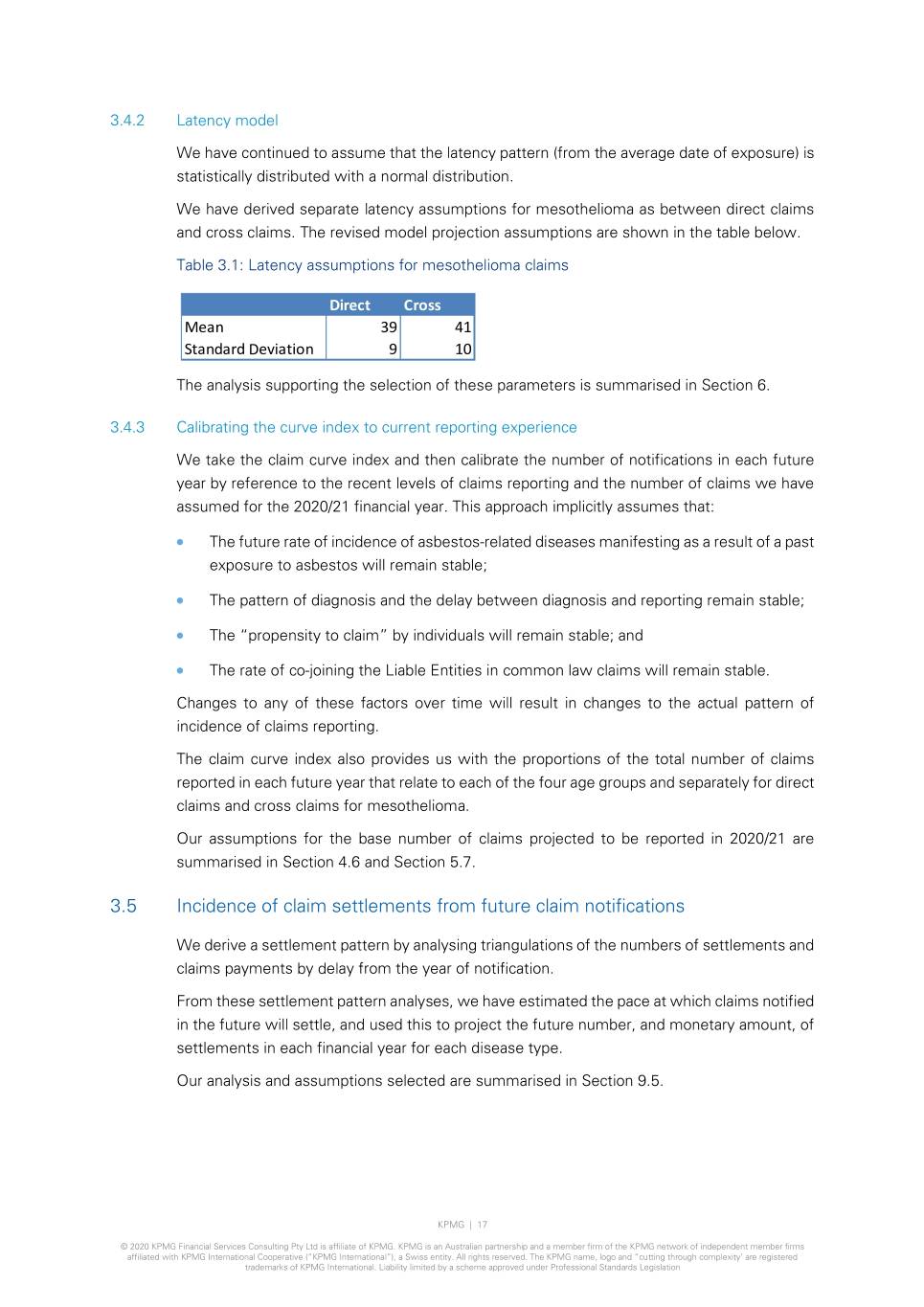
3.4.2 Latency model We have continued to assume that the latency pattern (from the average date of exposure) is statistically distributed with a normal distribution. We have derived separate latency assumptions for mesothelioma as between direct claims and cross claims. The revised model projection assumptions are shown in the table below. Table 3.1: Latency assumptions for mesothelioma claims Direct Cross Mean 39 41 Standard Deviation 9 10 The analysis supporting the selection of these parameters is summarised in Section 6. 3.4.3 Calibrating the curve index to current reporting experience We take the claim curve index and then calibrate the number of notifications in each future year by reference to the recent levels of claims reporting and the number of claims we have assumed for the 2020/21 financial year. This approach implicitly assumes that: • The future rate of incidence of asbestos-related diseases manifesting as a result of a past exposure to asbestos will remain stable; • The pattern of diagnosis and the delay between diagnosis and reporting remain stable; • The “propensity to claim” by individuals will remain stable; and • The rate of co-joining the Liable Entities in common law claims will remain stable. Changes to any of these factors over time will result in changes to the actual pattern of incidence of claims reporting. The claim curve index also provides us with the proportions of the total number of claims reported in each future year that relate to each of the four age groups and separately for direct claims and cross claims for mesothelioma. Our assumptions for the base number of claims projected to be reported in 2020/21 are summarised in Section 4.6 and Section 5.7. 3.5 Incidence of claim settlements from future claim notifications We derive a settlement pattern by analysing triangulations of the numbers of settlements and claims payments by delay from the year of notification. From these settlement pattern analyses, we have estimated the pace at which claims notified in the future will settle, and used this to project the future number, and monetary amount, of settlements in each financial year for each disease type. Our analysis and assumptions selected are summarised in Section 9.5. KPMG | 17 © 2020 KPMG Financial Services Consulting Pty Ltd is affiliate of KPMG. KPMG is an Australian partnership and a member firm of the KPMG network of independent member firms affiliated with KPMG International Cooperative (“KPMG International”), a Swiss entity. All rights reserved. The KPMG name, logo and “cutting through complexity’ are registered trademarks of KPMG International. Liability limited by a scheme approved under Professional Standards Legislation
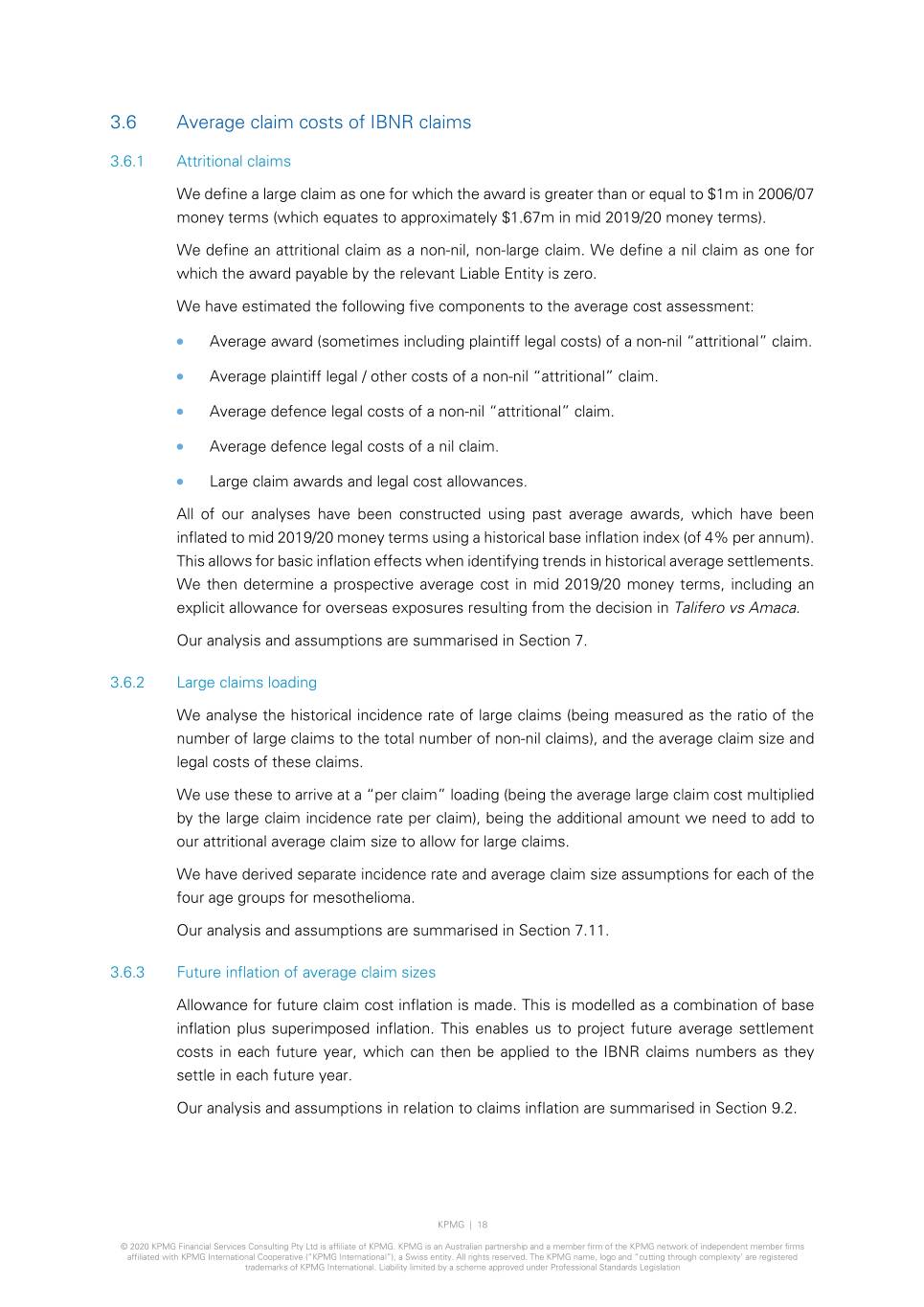
3.6 Average claim costs of IBNR claims 3.6.1 Attritional claims We define a large claim as one for which the award is greater than or equal to $1m in 2006/07 money terms (which equates to approximately $1.67m in mid 2019/20 money terms). We define an attritional claim as a non-nil, non-large claim. We define a nil claim as one for which the award payable by the relevant Liable Entity is zero. We have estimated the following five components to the average cost assessment: • Average award (sometimes including plaintiff legal costs) of a non-nil “attritional” claim. • Average plaintiff legal / other costs of a non-nil “attritional” claim. • Average defence legal costs of a non-nil “attritional” claim. • Average defence legal costs of a nil claim. • Large claim awards and legal cost allowances. All of our analyses have been constructed using past average awards, which have been inflated to mid 2019/20 money terms using a historical base inflation index (of 4% per annum). This allows for basic inflation effects when identifying trends in historical average settlements. We then determine a prospective average cost in mid 2019/20 money terms, including an explicit allowance for overseas exposures resulting from the decision in Talifero vs Amaca. Our analysis and assumptions are summarised in Section 7. 3.6.2 Large claims loading We analyse the historical incidence rate of large claims (being measured as the ratio of the number of large claims to the total number of non-nil claims), and the average claim size and legal costs of these claims. We use these to arrive at a “per claim” loading (being the average large claim cost multiplied by the large claim incidence rate per claim), being the additional amount we need to add to our attritional average claim size to allow for large claims. We have derived separate incidence rate and average claim size assumptions for each of the four age groups for mesothelioma. Our analysis and assumptions are summarised in Section 7.11. 3.6.3 Future inflation of average claim sizes Allowance for future claim cost inflation is made. This is modelled as a combination of base inflation plus superimposed inflation. This enables us to project future average settlement costs in each future year, which can then be applied to the IBNR claims numbers as they settle in each future year. Our analysis and assumptions in relation to claims inflation are summarised in Section 9.2. KPMG | 18 © 2020 KPMG Financial Services Consulting Pty Ltd is affiliate of KPMG. KPMG is an Australian partnership and a member firm of the KPMG network of independent member firms affiliated with KPMG International Cooperative (“KPMG International”), a Swiss entity. All rights reserved. The KPMG name, logo and “cutting through complexity’ are registered trademarks of KPMG International. Liability limited by a scheme approved under Professional Standards Legislation
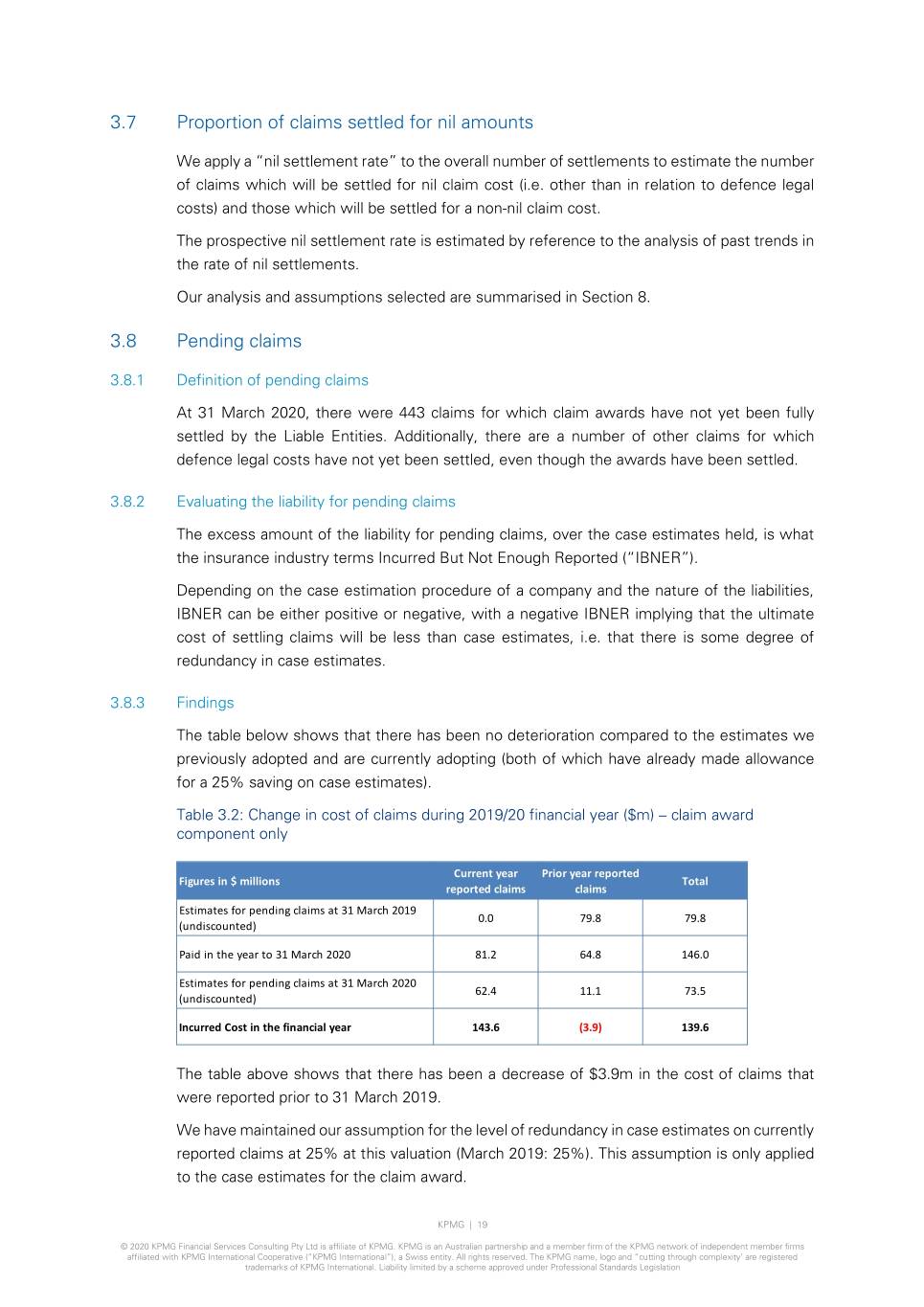
3.7 Proportion of claims settled for nil amounts We apply a “nil settlement rate” to the overall number of settlements to estimate the number of claims which will be settled for nil claim cost (i.e. other than in relation to defence legal costs) and those which will be settled for a non-nil claim cost. The prospective nil settlement rate is estimated by reference to the analysis of past trends in the rate of nil settlements. Our analysis and assumptions selected are summarised in Section 8. 3.8 Pending claims 3.8.1 Definition of pending claims At 31 March 2020, there were 443 claims for which claim awards have not yet been fully settled by the Liable Entities. Additionally, there are a number of other claims for which defence legal costs have not yet been settled, even though the awards have been settled. 3.8.2 Evaluating the liability for pending claims The excess amount of the liability for pending claims, over the case estimates held, is what the insurance industry terms Incurred But Not Enough Reported (“IBNER”). Depending on the case estimation procedure of a company and the nature of the liabilities, IBNER can be either positive or negative, with a negative IBNER implying that the ultimate cost of settling claims will be less than case estimates, i.e. that there is some degree of redundancy in case estimates. 3.8.3 Findings The table below shows that there has been no deterioration compared to the estimates we previously adopted and are currently adopting (both of which have already made allowance for a 25% saving on case estimates). Table 3.2: Change in cost of claims during 2019/20 financial year ($m) – claim award component only Current year Prior year reported Figures in $ millions Total reported claims claims Estimates for pending claims at 31 March 2019 0.0 79.8 79.8 (undiscounted) Paid in the year to 31 March 2020 81.2 64.8 146.0 Estimates for pending claims at 31 March 2020 62.4 11.1 73.5 (undiscounted) Incurred Cost in the financial year 143.6 (3.9) 139.6 The table above shows that there has been a decrease of $3.9m in the cost of claims that were reported prior to 31 March 2019. We have maintained our assumption for the level of redundancy in case estimates on currently reported claims at 25% at this valuation (March 2019: 25%). This assumption is only applied to the case estimates for the claim award. KPMG | 19 © 2020 KPMG Financial Services Consulting Pty Ltd is affiliate of KPMG. KPMG is an Australian partnership and a member firm of the KPMG network of independent member firms affiliated with KPMG International Cooperative (“KPMG International”), a Swiss entity. All rights reserved. The KPMG name, logo and “cutting through complexity’ are registered trademarks of KPMG International. Liability limited by a scheme approved under Professional Standards Legislation
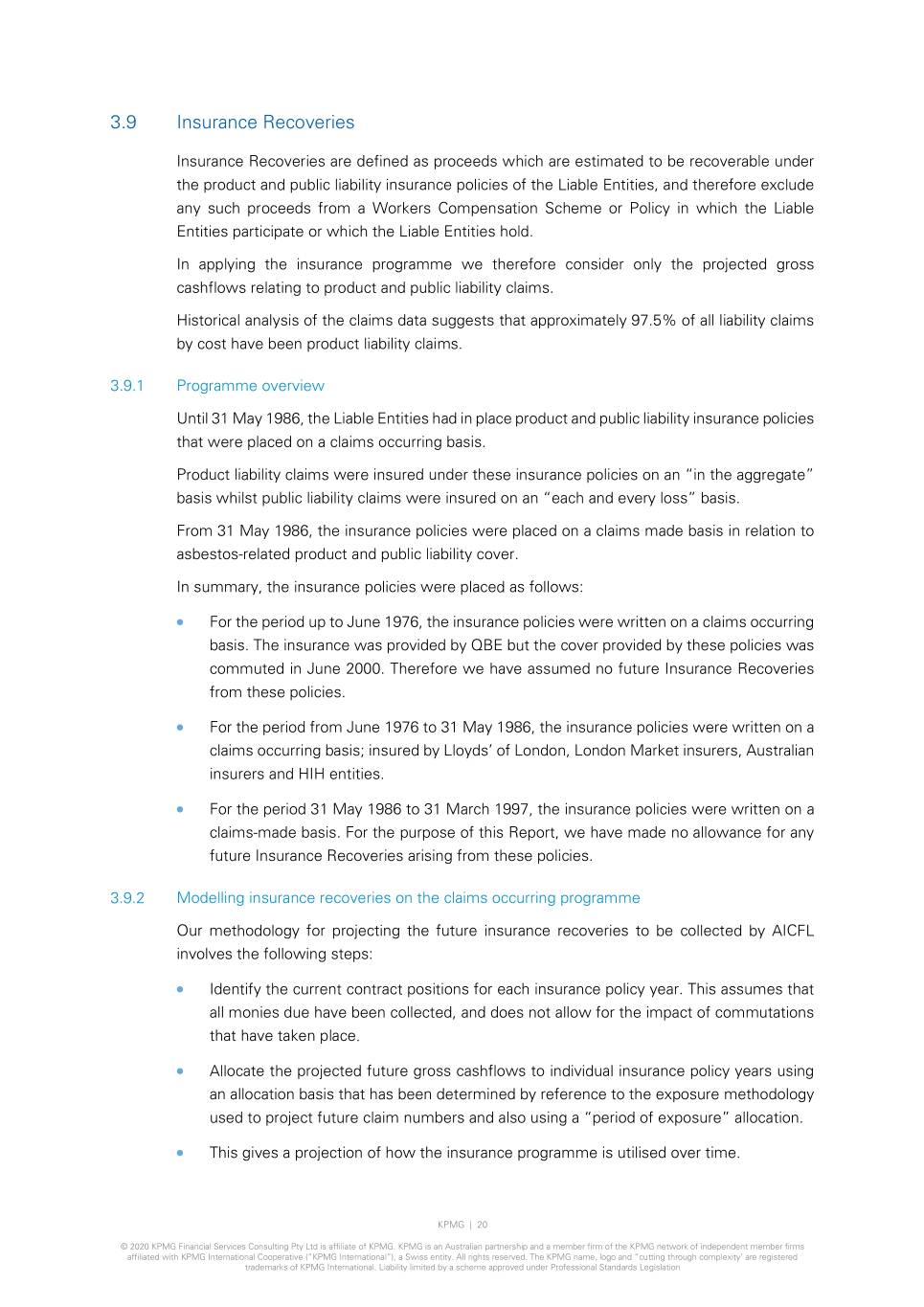
3.9 Insurance Recoveries Insurance Recoveries are defined as proceeds which are estimated to be recoverable under the product and public liability insurance policies of the Liable Entities, and therefore exclude any such proceeds from a Workers Compensation Scheme or Policy in which the Liable Entities participate or which the Liable Entities hold. In applying the insurance programme we therefore consider only the projected gross cashflows relating to product and public liability claims. Historical analysis of the claims data suggests that approximately 97.5% of all liability claims by cost have been product liability claims. 3.9.1 Programme overview Until 31 May 1986, the Liable Entities had in place product and public liability insurance policies that were placed on a claims occurring basis. Product liability claims were insured under these insurance policies on an “in the aggregate” basis whilst public liability claims were insured on an “each and every loss” basis. From 31 May 1986, the insurance policies were placed on a claims made basis in relation to asbestos-related product and public liability cover. In summary, the insurance policies were placed as follows: • For the period up to June 1976, the insurance policies were written on a claims occurring basis. The insurance was provided by QBE but the cover provided by these policies was commuted in June 2000. Therefore we have assumed no future Insurance Recoveries from these policies. • For the period from June 1976 to 31 May 1986, the insurance policies were written on a claims occurring basis; insured by Lloyds’ of London, London Market insurers, Australian insurers and HIH entities. • For the period 31 May 1986 to 31 March 1997, the insurance policies were written on a claims-made basis. For the purpose of this Report, we have made no allowance for any future Insurance Recoveries arising from these policies. 3.9.2 Modelling insurance recoveries on the claims occurring programme Our methodology for projecting the future insurance recoveries to be collected by AICFL involves the following steps: • Identify the current contract positions for each insurance policy year. This assumes that all monies due have been collected, and does not allow for the impact of commutations that have taken place. • Allocate the projected future gross cashflows to individual insurance policy years using an allocation basis that has been determined by reference to the exposure methodology used to project future claim numbers and also using a “period of exposure” allocation. • This gives a projection of how the insurance programme is utilised over time. KPMG | 20 © 2020 KPMG Financial Services Consulting Pty Ltd is affiliate of KPMG. KPMG is an Australian partnership and a member firm of the KPMG network of independent member firms affiliated with KPMG International Cooperative (“KPMG International”), a Swiss entity. All rights reserved. The KPMG name, logo and “cutting through complexity’ are registered trademarks of KPMG International. Liability limited by a scheme approved under Professional Standards Legislation
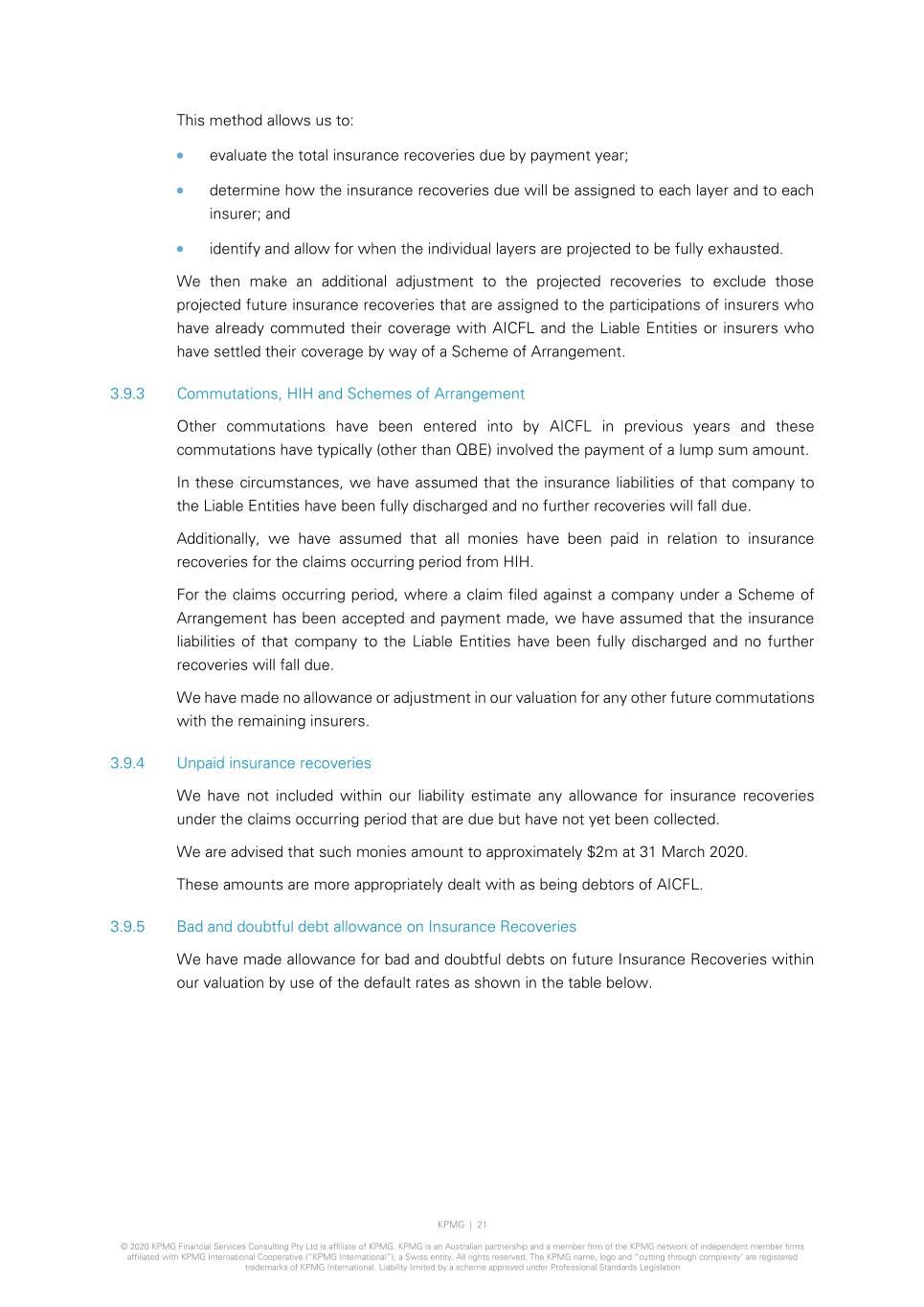
This method allows us to: • evaluate the total insurance recoveries due by payment year; • determine how the insurance recoveries due will be assigned to each layer and to each insurer; and • identify and allow for when the individual layers are projected to be fully exhausted. We then make an additional adjustment to the projected recoveries to exclude those projected future insurance recoveries that are assigned to the participations of insurers who have already commuted their coverage with AICFL and the Liable Entities or insurers who have settled their coverage by way of a Scheme of Arrangement. 3.9.3 Commutations, HIH and Schemes of Arrangement Other commutations have been entered into by AICFL in previous years and these commutations have typically (other than QBE) involved the payment of a lump sum amount. In these circumstances, we have assumed that the insurance liabilities of that company to the Liable Entities have been fully discharged and no further recoveries will fall due. Additionally, we have assumed that all monies have been paid in relation to insurance recoveries for the claims occurring period from HIH. For the claims occurring period, where a claim filed against a company under a Scheme of Arrangement has been accepted and payment made, we have assumed that the insurance liabilities of that company to the Liable Entities have been fully discharged and no further recoveries will fall due. We have made no allowance or adjustment in our valuation for any other future commutations with the remaining insurers. 3.9.4 Unpaid insurance recoveries We have not included within our liability estimate any allowance for insurance recoveries under the claims occurring period that are due but have not yet been collected. We are advised that such monies amount to approximately $2m at 31 March 2020. These amounts are more appropriately dealt with as being debtors of AICFL. 3.9.5 Bad and doubtful debt allowance on Insurance Recoveries We have made allowance for bad and doubtful debts on future Insurance Recoveries within our valuation by use of the default rates as shown in the table below. KPMG | 21 © 2020 KPMG Financial Services Consulting Pty Ltd is affiliate of KPMG. KPMG is an Australian partnership and a member firm of the KPMG network of independent member firms affiliated with KPMG International Cooperative (“KPMG International”), a Swiss entity. All rights reserved. The KPMG name, logo and “cutting through complexity’ are registered trademarks of KPMG International. Liability limited by a scheme approved under Professional Standards Legislation
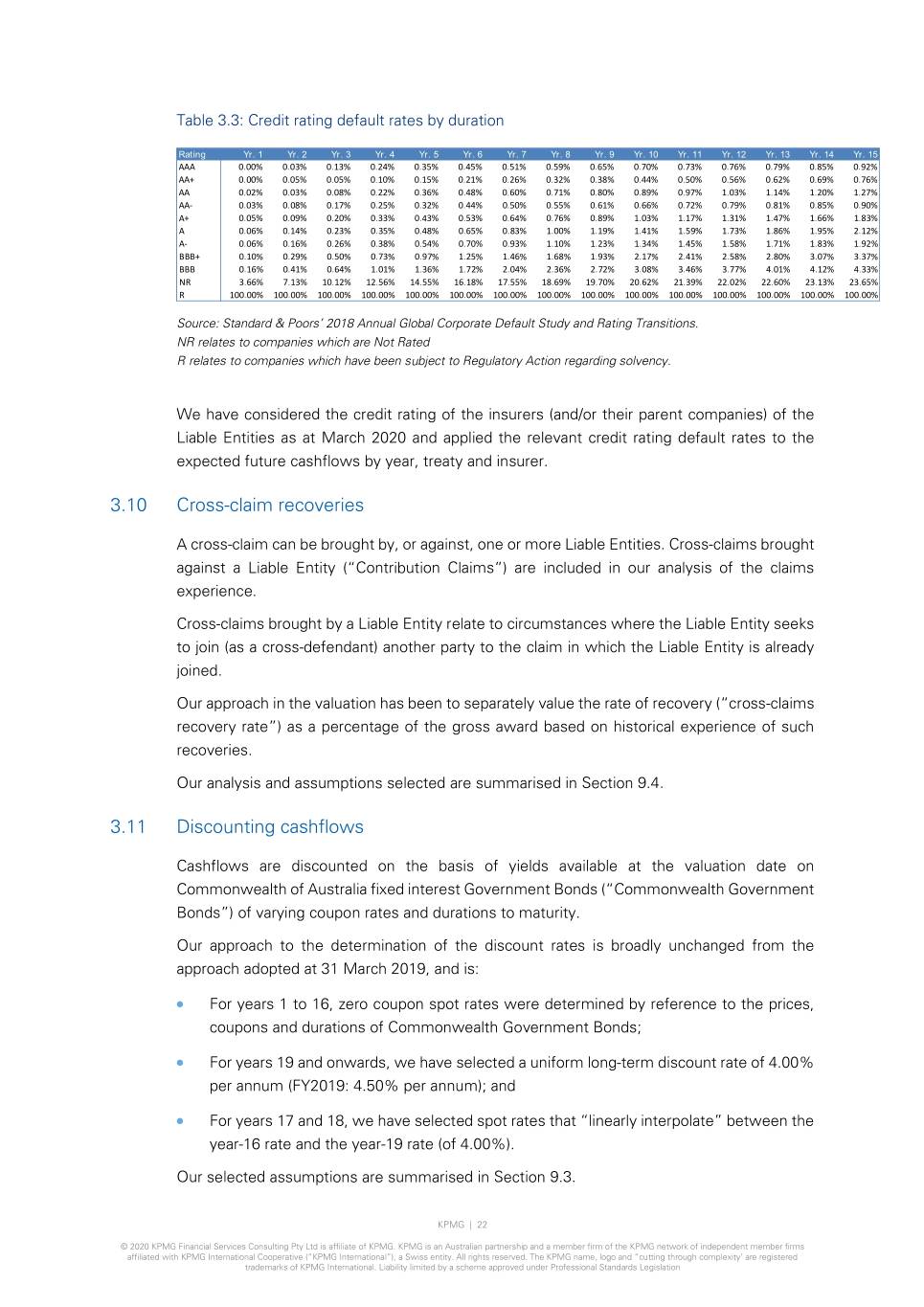
Table 3.3: Credit rating default rates by duration Rating Yr. 1 Yr. 2 Yr. 3 Yr. 4 Yr. 5 Yr. 6 Yr. 7 Yr. 8 Yr. 9 Yr. 10 Yr. 11 Yr. 12 Yr. 13 Yr. 14 Yr. 15 AAA 0.00% 0.03% 0.13% 0.24% 0.35% 0.45% 0.51% 0.59% 0.65% 0.70% 0.73% 0.76% 0.79% 0.85% 0.92% AA+ 0.00% 0.05% 0.05% 0.10% 0.15% 0.21% 0.26% 0.32% 0.38% 0.44% 0.50% 0.56% 0.62% 0.69% 0.76% AA 0.02% 0.03% 0.08% 0.22% 0.36% 0.48% 0.60% 0.71% 0.80% 0.89% 0.97% 1.03% 1.14% 1.20% 1.27% AA- 0.03% 0.08% 0.17% 0.25% 0.32% 0.44% 0.50% 0.55% 0.61% 0.66% 0.72% 0.79% 0.81% 0.85% 0.90% A+ 0.05% 0.09% 0.20% 0.33% 0.43% 0.53% 0.64% 0.76% 0.89% 1.03% 1.17% 1.31% 1.47% 1.66% 1.83% A 0.06% 0.14% 0.23% 0.35% 0.48% 0.65% 0.83% 1.00% 1.19% 1.41% 1.59% 1.73% 1.86% 1.95% 2.12% A- 0.06% 0.16% 0.26% 0.38% 0.54% 0.70% 0.93% 1.10% 1.23% 1.34% 1.45% 1.58% 1.71% 1.83% 1.92% BBB+ 0.10% 0.29% 0.50% 0.73% 0.97% 1.25% 1.46% 1.68% 1.93% 2.17% 2.41% 2.58% 2.80% 3.07% 3.37% BBB 0.16% 0.41% 0.64% 1.01% 1.36% 1.72% 2.04% 2.36% 2.72% 3.08% 3.46% 3.77% 4.01% 4.12% 4.33% NR 3.66% 7.13% 10.12% 12.56% 14.55% 16.18% 17.55% 18.69% 19.70% 20.62% 21.39% 22.02% 22.60% 23.13% 23.65% R 100.00% 100.00% 100.00% 100.00% 100.00% 100.00% 100.00% 100.00% 100.00% 100.00% 100.00% 100.00% 100.00% 100.00% 100.00% Source: Standard & Poors’ 2018 Annual Global Corporate Default Study and Rating Transitions. NR relates to companies which are Not Rated R relates to companies which have been subject to Regulatory Action regarding solvency. We have considered the credit rating of the insurers (and/or their parent companies) of the Liable Entities as at March 2020 and applied the relevant credit rating default rates to the expected future cashflows by year, treaty and insurer. 3.10 Cross-claim recoveries A cross-claim can be brought by, or against, one or more Liable Entities. Cross-claims brought against a Liable Entity (“Contribution Claims”) are included in our analysis of the claims experience. Cross-claims brought by a Liable Entity relate to circumstances where the Liable Entity seeks to join (as a cross-defendant) another party to the claim in which the Liable Entity is already joined. Our approach in the valuation has been to separately value the rate of recovery (“cross-claims recovery rate”) as a percentage of the gross award based on historical experience of such recoveries. Our analysis and assumptions selected are summarised in Section 9.4. 3.11 Discounting cashflows Cashflows are discounted on the basis of yields available at the valuation date on Commonwealth of Australia fixed interest Government Bonds (“Commonwealth Government Bonds”) of varying coupon rates and durations to maturity. Our approach to the determination of the discount rates is broadly unchanged from the approach adopted at 31 March 2019, and is: • For years 1 to 16, zero coupon spot rates were determined by reference to the prices, coupons and durations of Commonwealth Government Bonds; • For years 19 and onwards, we have selected a uniform long-term discount rate of 4.00% per annum (FY2019: 4.50% per annum); and • For years 17 and 18, we have selected spot rates that “linearly interpolate” between the year-16 rate and the year-19 rate (of 4.00%). Our selected assumptions are summarised in Section 9.3. KPMG | 22 © 2020 KPMG Financial Services Consulting Pty Ltd is affiliate of KPMG. KPMG is an Australian partnership and a member firm of the KPMG network of independent member firms affiliated with KPMG International Cooperative (“KPMG International”), a Swiss entity. All rights reserved. The KPMG name, logo and “cutting through complexity’ are registered trademarks of KPMG International. Liability limited by a scheme approved under Professional Standards Legislation
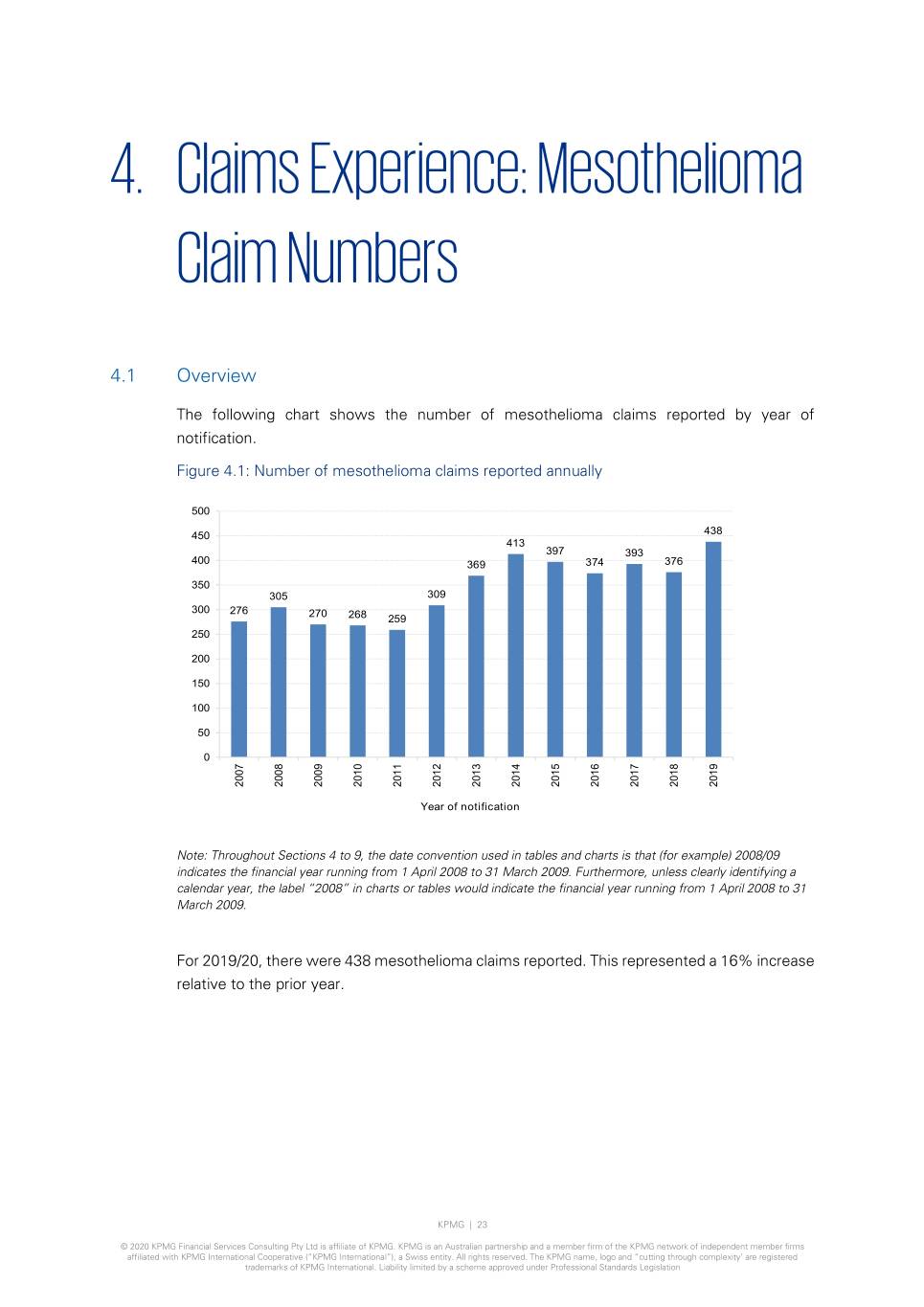
4. Claims Experience: Mesothelioma Claim Numbers 4.1 Overview The following chart shows the number of mesothelioma claims reported by year of notification. Figure 4.1: Number of mesothelioma claims reported annually 500 450 438 413 397 393 400 369 374 376 350 305 309 300 276 270 268 259 250 200 150 100 50 0 2007 2008 2009 2010 2011 2012 2013 2014 2015 2016 2017 2018 2019 Year of notification Note: Throughout Sections 4 to 9, the date convention used in tables and charts is that (for example) 2008/09 indicates the financial year running from 1 April 2008 to 31 March 2009. Furthermore, unless clearly identifying a calendar year, the label “2008” in charts or tables would indicate the financial year running from 1 April 2008 to 31 March 2009. For 2019/20, there were 438 mesothelioma claims reported. This represented a 16% increase relative to the prior year. KPMG | 23 © 2020 KPMG Financial Services Consulting Pty Ltd is affiliate of KPMG. KPMG is an Australian partnership and a member firm of the KPMG network of independent member firms affiliated with KPMG International Cooperative (“KPMG International”), a Swiss entity. All rights reserved. The KPMG name, logo and “cutting through complexity’ are registered trademarks of KPMG International. Liability limited by a scheme approved under Professional Standards Legislation
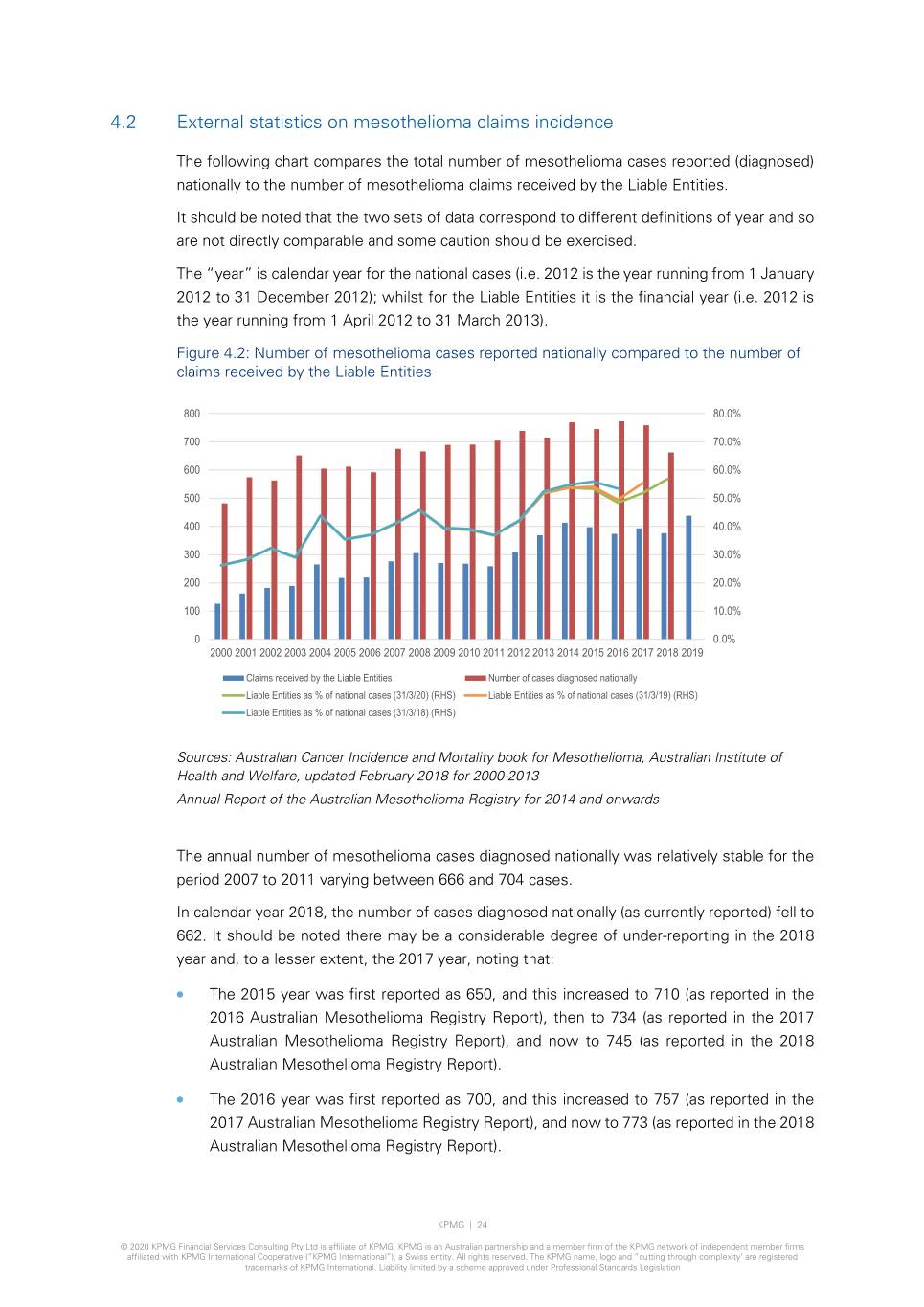
4.2 External statistics on mesothelioma claims incidence The following chart compares the total number of mesothelioma cases reported (diagnosed) nationally to the number of mesothelioma claims received by the Liable Entities. It should be noted that the two sets of data correspond to different definitions of year and so are not directly comparable and some caution should be exercised. The “year” is calendar year for the national cases (i.e. 2012 is the year running from 1 January 2012 to 31 December 2012); whilst for the Liable Entities it is the financial year (i.e. 2012 is the year running from 1 April 2012 to 31 March 2013). Figure 4.2: Number of mesothelioma cases reported nationally compared to the number of claims received by the Liable Entities 800 80.0% 700 70.0% 600 60.0% 500 50.0% 400 40.0% 300 30.0% 200 20.0% 100 10.0% 0 0.0% 2000 2001 2002 2003 2004 2005 2006 2007 2008 2009 2010 2011 2012 2013 2014 2015 2016 2017 2018 2019 Claims received by the Liable Entities Number of cases diagnosed nationally Liable Entities as % of national cases (31/3/20) (RHS) Liable Entities as % of national cases (31/3/19) (RHS) Liable Entities as % of national cases (31/3/18) (RHS) Sources: Australian Cancer Incidence and Mortality book for Mesothelioma, Australian Institute of Health and Welfare, updated February 2018 for 2000-2013 Annual Report of the Australian Mesothelioma Registry for 2014 and onwards The annual number of mesothelioma cases diagnosed nationally was relatively stable for the period 2007 to 2011 varying between 666 and 704 cases. In calendar year 2018, the number of cases diagnosed nationally (as currently reported) fell to 662. It should be noted there may be a considerable degree of under-reporting in the 2018 year and, to a lesser extent, the 2017 year, noting that: • The 2015 year was first reported as 650, and this increased to 710 (as reported in the 2016 Australian Mesothelioma Registry Report), then to 734 (as reported in the 2017 Australian Mesothelioma Registry Report), and now to 745 (as reported in the 2018 Australian Mesothelioma Registry Report). • The 2016 year was first reported as 700, and this increased to 757 (as reported in the 2017 Australian Mesothelioma Registry Report), and now to 773 (as reported in the 2018 Australian Mesothelioma Registry Report). KPMG | 24 © 2020 KPMG Financial Services Consulting Pty Ltd is affiliate of KPMG. KPMG is an Australian partnership and a member firm of the KPMG network of independent member firms affiliated with KPMG International Cooperative (“KPMG International”), a Swiss entity. All rights reserved. The KPMG name, logo and “cutting through complexity’ are registered trademarks of KPMG International. Liability limited by a scheme approved under Professional Standards Legislation
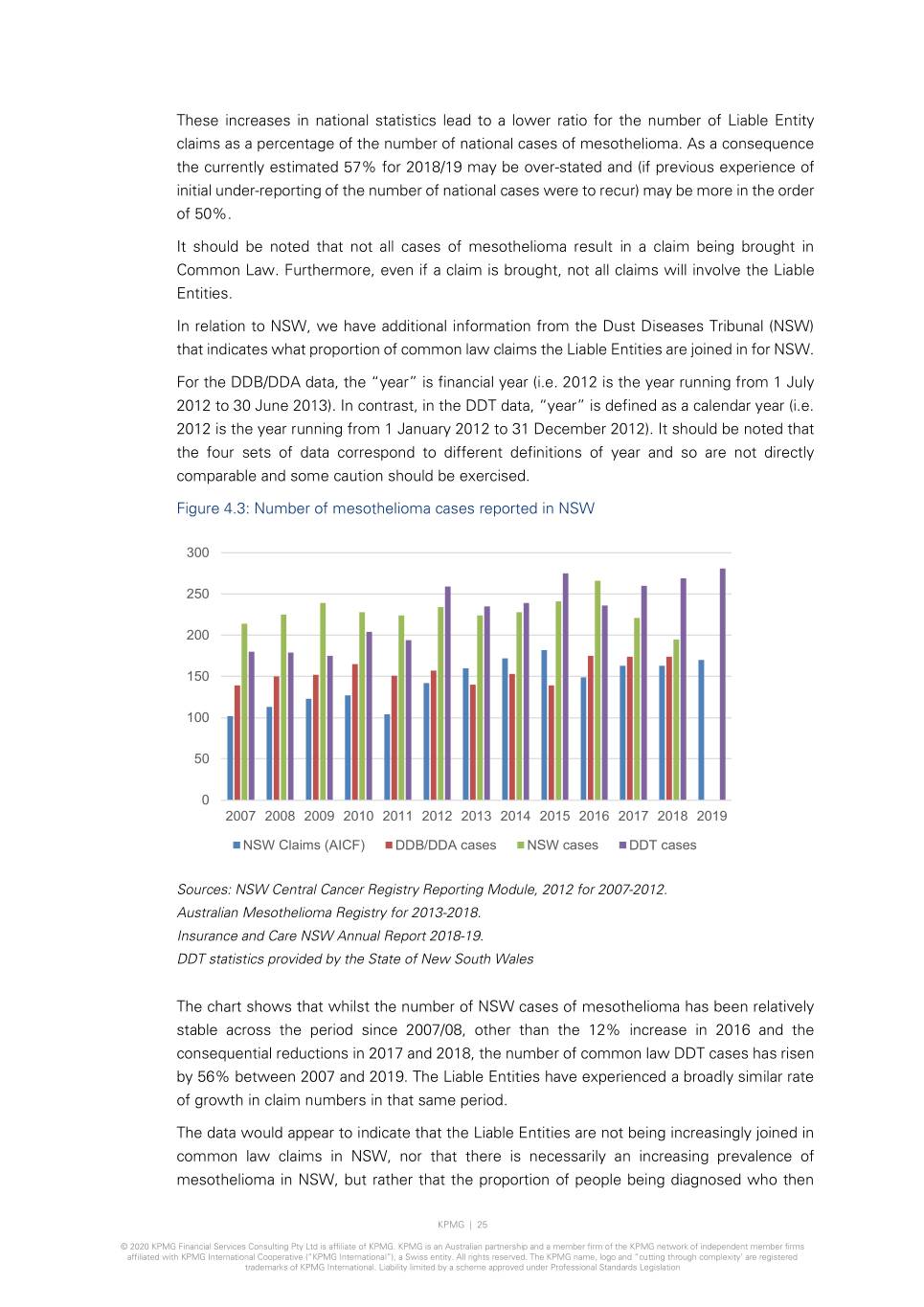
These increases in national statistics lead to a lower ratio for the number of Liable Entity claims as a percentage of the number of national cases of mesothelioma. As a consequence the currently estimated 57% for 2018/19 may be over-stated and (if previous experience of initial under-reporting of the number of national cases were to recur) may be more in the order of 50%. It should be noted that not all cases of mesothelioma result in a claim being brought in Common Law. Furthermore, even if a claim is brought, not all claims will involve the Liable Entities. In relation to NSW, we have additional information from the Dust Diseases Tribunal (NSW) that indicates what proportion of common law claims the Liable Entities are joined in for NSW. For the DDB/DDA data, the “year” is financial year (i.e. 2012 is the year running from 1 July 2012 to 30 June 2013). In contrast, in the DDT data, “year” is defined as a calendar year (i.e. 2012 is the year running from 1 January 2012 to 31 December 2012). It should be noted that the four sets of data correspond to different definitions of year and so are not directly comparable and some caution should be exercised. Figure 4.3: Number of mesothelioma cases reported in NSW 300 250 200 150 100 50 0 2007 2008 2009 2010 2011 2012 2013 2014 2015 2016 2017 2018 2019 NSW Claims (AICF) DDB/DDA cases NSW cases DDT cases Sources: NSW Central Cancer Registry Reporting Module, 2012 for 2007-2012. Australian Mesothelioma Registry for 2013-2018. Insurance and Care NSW Annual Report 2018-19. DDT statistics provided by the State of New South Wales The chart shows that whilst the number of NSW cases of mesothelioma has been relatively stable across the period since 2007/08, other than the 12% increase in 2016 and the consequential reductions in 2017 and 2018, the number of common law DDT cases has risen by 56% between 2007 and 2019. The Liable Entities have experienced a broadly similar rate of growth in claim numbers in that same period. The data would appear to indicate that the Liable Entities are not being increasingly joined in common law claims in NSW, nor that there is necessarily an increasing prevalence of mesothelioma in NSW, but rather that the proportion of people being diagnosed who then KPMG | 25 © 2020 KPMG Financial Services Consulting Pty Ltd is affiliate of KPMG. KPMG is an Australian partnership and a member firm of the KPMG network of independent member firms affiliated with KPMG International Cooperative (“KPMG International”), a Swiss entity. All rights reserved. The KPMG name, logo and “cutting through complexity’ are registered trademarks of KPMG International. Liability limited by a scheme approved under Professional Standards Legislation
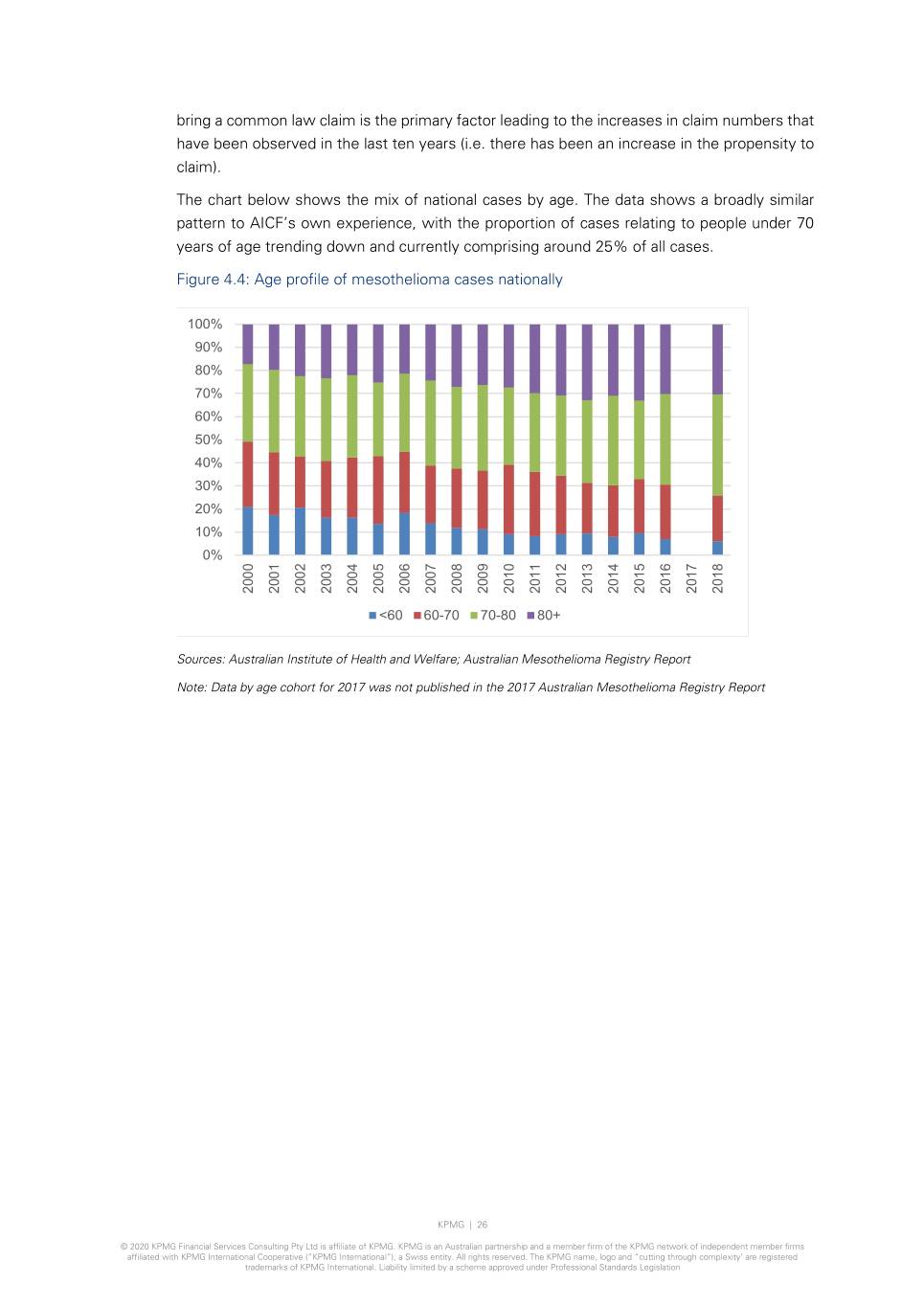
bring a common law claim is the primary factor leading to the increases in claim numbers that have been observed in the last ten years (i.e. there has been an increase in the propensity to claim). The chart below shows the mix of national cases by age. The data shows a broadly similar pattern to AICF’s own experience, with the proportion of cases relating to people under 70 years of age trending down and currently comprising around 25% of all cases. Figure 4.4: Age profile of mesothelioma cases nationally 100% 90% 80% 70% 60% 50% 40% 30% 20% 10% 0% 2000 2001 2002 2003 2004 2005 2006 2007 2008 2009 2010 2011 2012 2013 2014 2015 2016 2017 2018 <60 60-70 70-80 80+ Sources: Australian Institute of Health and Welfare; Australian Mesothelioma Registry Report Note: Data by age cohort for 2017 was not published in the 2017 Australian Mesothelioma Registry Report KPMG | 26 © 2020 KPMG Financial Services Consulting Pty Ltd is affiliate of KPMG. KPMG is an Australian partnership and a member firm of the KPMG network of independent member firms affiliated with KPMG International Cooperative (“KPMG International”), a Swiss entity. All rights reserved. The KPMG name, logo and “cutting through complexity’ are registered trademarks of KPMG International. Liability limited by a scheme approved under Professional Standards Legislation
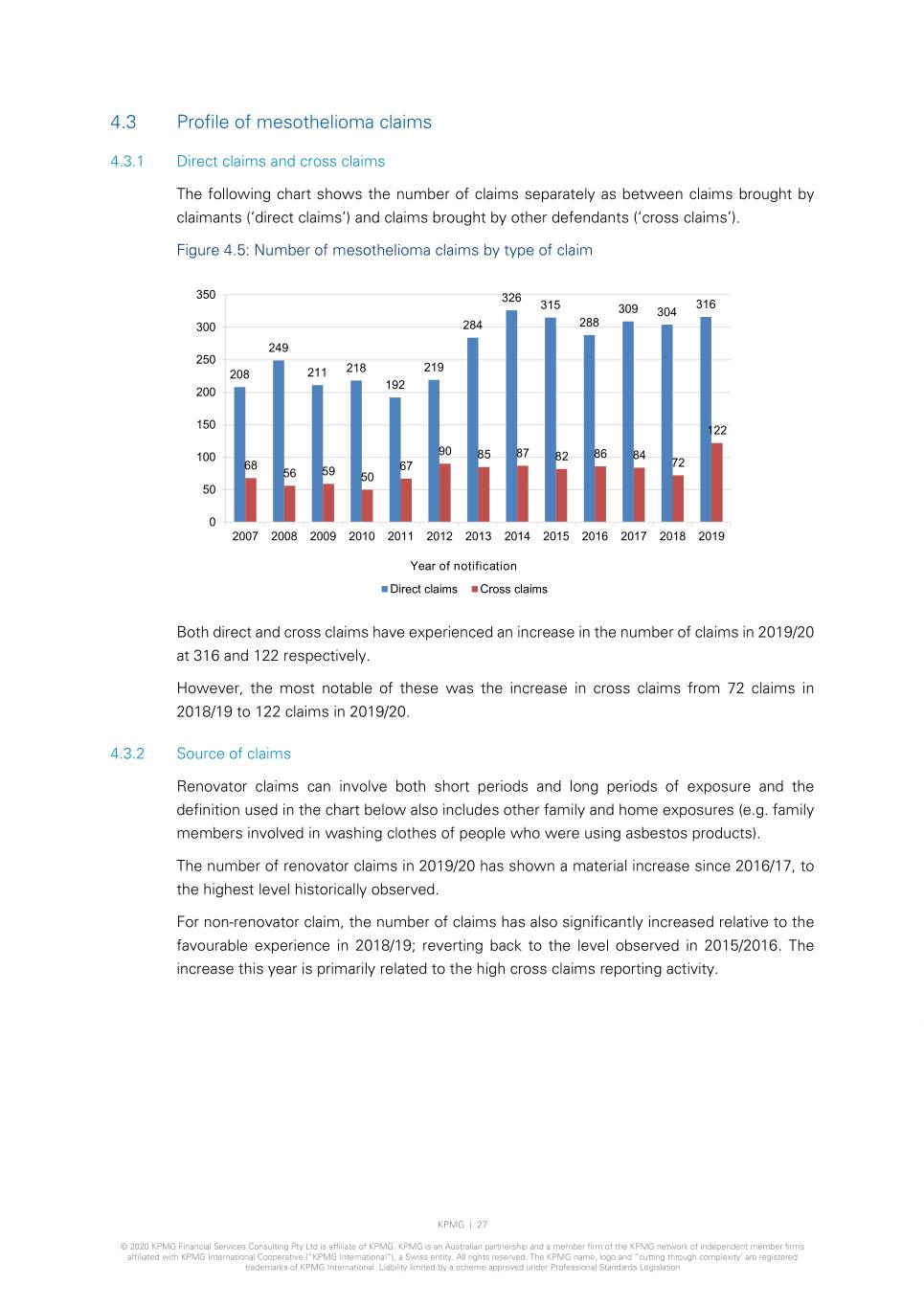
4.3 Profile of mesothelioma claims 4.3.1 Direct claims and cross claims The following chart shows the number of claims separately as between claims brought by claimants (‘direct claims’) and claims brought by other defendants (‘cross claims’). Figure 4.5: Number of mesothelioma claims by type of claim 350 326 315 316 309 304 300 284 288 249 250 218 219 208 211 192 200 150 122 100 90 85 87 82 86 84 68 67 72 56 59 50 50 0 2007 2008 2009 2010 2011 2012 2013 2014 2015 2016 2017 2018 2019 Year of notification Direct claims Cross claims Both direct and cross claims have experienced an increase in the number of claims in 2019/20 at 316 and 122 respectively. However, the most notable of these was the increase in cross claims from 72 claims in 2018/19 to 122 claims in 2019/20. 4.3.2 Source of claims Renovator claims can involve both short periods and long periods of exposure and the definition used in the chart below also includes other family and home exposures (e.g. family members involved in washing clothes of people who were using asbestos products). The number of renovator claims in 2019/20 has shown a material increase since 2016/17, to the highest level historically observed. For non-renovator claim, the number of claims has also significantly increased relative to the favourable experience in 2018/19; reverting back to the level observed in 2015/2016. The increase this year is primarily related to the high cross claims reporting activity. KPMG | 27 © 2020 KPMG Financial Services Consulting Pty Ltd is affiliate of KPMG. KPMG is an Australian partnership and a member firm of the KPMG network of independent member firms affiliated with KPMG International Cooperative (“KPMG International”), a Swiss entity. All rights reserved. The KPMG name, logo and “cutting through complexity’ are registered trademarks of KPMG International. Liability limited by a scheme approved under Professional Standards Legislation
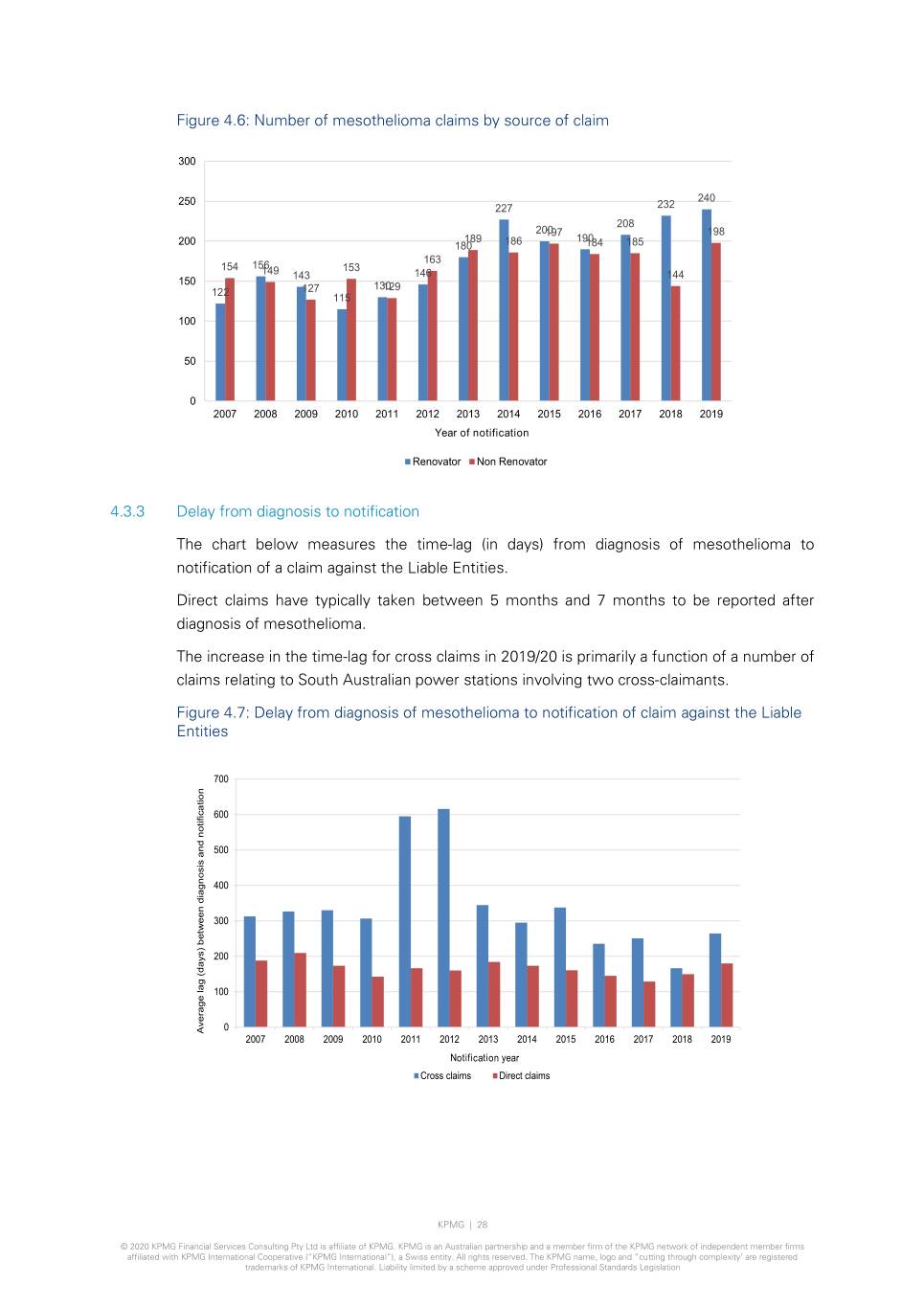
Figure 4.6: Number of mesothelioma claims by source of claim 300 250 240 227 232 208 200197 198 189 190 200 180 186 184 185 163 154 156 153 149 143 146 144 150 130129 122 127 115 100 50 0 2007 2008 2009 2010 2011 2012 2013 2014 2015 2016 2017 2018 2019 Year of notification Renovator Non Renovator 4.3.3 Delay from diagnosis to notification The chart below measures the time-lag (in days) from diagnosis of mesothelioma to notification of a claim against the Liable Entities. Direct claims have typically taken between 5 months and 7 months to be reported after diagnosis of mesothelioma. The increase in the time-lag for cross claims in 2019/20 is primarily a function of a number of claims relating to South Australian power stations involving two cross-claimants. Figure 4.7: Delay from diagnosis of mesothelioma to notification of claim against the Liable Entities 700 600 500 400 300 200 100 Average lag (days) between diagnosis and notification and notification diagnosis between lag (days) Average 0 2007 2008 2009 2010 2011 2012 2013 2014 2015 2016 2017 2018 2019 Notification year Cross claims Direct claims KPMG | 28 © 2020 KPMG Financial Services Consulting Pty Ltd is affiliate of KPMG. KPMG is an Australian partnership and a member firm of the KPMG network of independent member firms affiliated with KPMG International Cooperative (“KPMG International”), a Swiss entity. All rights reserved. The KPMG name, logo and “cutting through complexity’ are registered trademarks of KPMG International. Liability limited by a scheme approved under Professional Standards Legislation
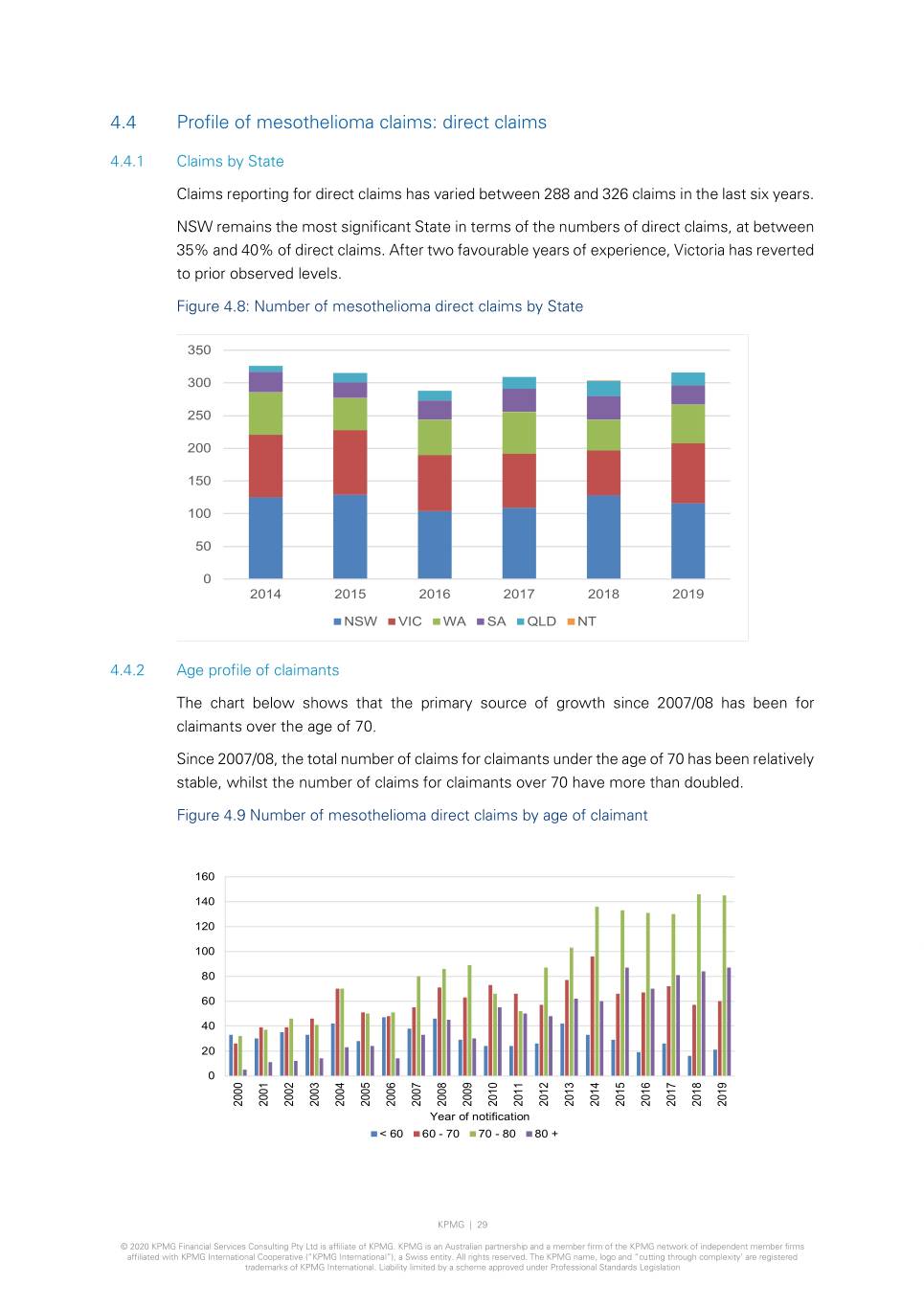
4.4 Profile of mesothelioma claims: direct claims 4.4.1 Claims by State Claims reporting for direct claims has varied between 288 and 326 claims in the last six years. NSW remains the most significant State in terms of the numbers of direct claims, at between 35% and 40% of direct claims. After two favourable years of experience, Victoria has reverted to prior observed levels. Figure 4.8: Number of mesothelioma direct claims by State 350 300 250 200 150 100 50 0 2014 2015 2016 2017 2018 2019 NSW VIC WA SA QLD NT 4.4.2 Age profile of claimants The chart below shows that the primary source of growth since 2007/08 has been for claimants over the age of 70. Since 2007/08, the total number of claims for claimants under the age of 70 has been relatively stable, whilst the number of claims for claimants over 70 have more than doubled. Figure 4.9 Number of mesothelioma direct claims by age of claimant 160 140 120 100 80 60 40 20 0 2000 2001 2002 2003 2004 2005 2006 2007 2008 2009 2010 2011 2012 2013 2014 2015 2016 2017 2018 2019 Year of notification < 60 60 - 70 70 - 80 80 + KPMG | 29 © 2020 KPMG Financial Services Consulting Pty Ltd is affiliate of KPMG. KPMG is an Australian partnership and a member firm of the KPMG network of independent member firms affiliated with KPMG International Cooperative (“KPMG International”), a Swiss entity. All rights reserved. The KPMG name, logo and “cutting through complexity’ are registered trademarks of KPMG International. Liability limited by a scheme approved under Professional Standards Legislation

4.5 Profile of mesothelioma claims: cross claims 4.5.1 Claims by State We have analysed the number of mesothelioma claim notifications by the State in which the cross claim is filed. Figure 4.10: Number of mesothelioma cross claims by State 140 120 100 80 60 40 20 0 2014 2015 2016 2017 2018 2019 NSW VIC WA SA QLD NT In 2019/20, NSW recorded its joint-highest level of claims reporting for cross claims (at the same level as 2017/18). Victoria also recorded its highest level of claims reporting for cross- claims. Notwithstanding these two features, the most material increase in cross claims reporting emerged from South Australia and most notably a significant number of claims relating to power station exposures. There were 14 claimants where “duplicate claims” arose (i.e. 2 cross claims were lodged for each claimant). We understand that a number of these claims related to claims that were brought against the other entities up to 7 years ago and the lodgement of these cross claims against the Liable Entities was pending resolution of a legal matter that did not involve the Liable Entities. It is also expected that some of these claims may give rise to either a sharing of the potential liability or the recovery of monies by Amaca (by way of separate cross-claim action) given the claims relate to the Hardie-BI joint venture. KPMG | 30 © 2020 KPMG Financial Services Consulting Pty Ltd is affiliate of KPMG. KPMG is an Australian partnership and a member firm of the KPMG network of independent member firms affiliated with KPMG International Cooperative (“KPMG International”), a Swiss entity. All rights reserved. The KPMG name, logo and “cutting through complexity’ are registered trademarks of KPMG International. Liability limited by a scheme approved under Professional Standards Legislation
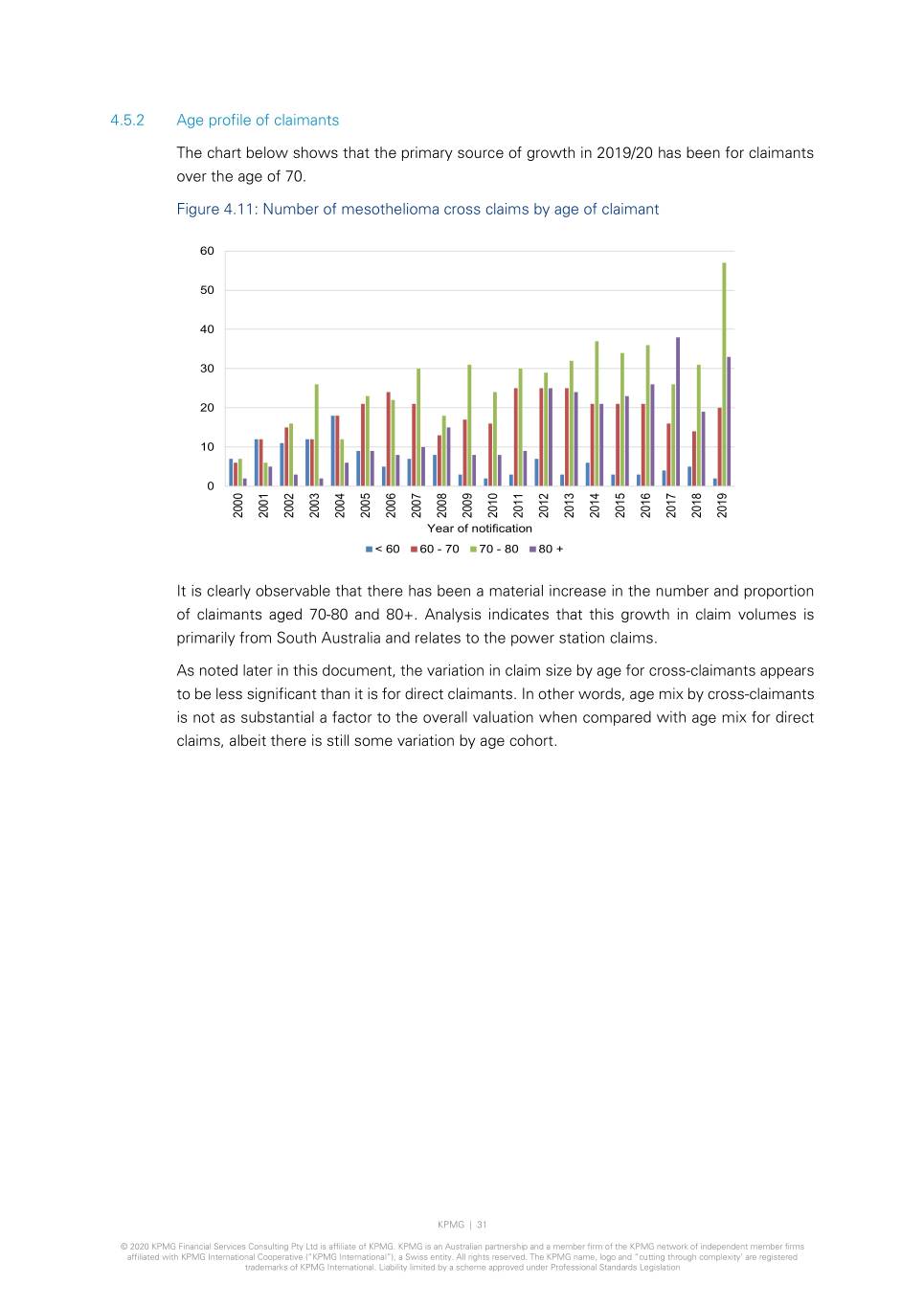
4.5.2 Age profile of claimants The chart below shows that the primary source of growth in 2019/20 has been for claimants over the age of 70. Figure 4.11: Number of mesothelioma cross claims by age of claimant 60 50 40 30 20 10 0 2000 2001 2002 2003 2004 2005 2006 2007 2008 2009 2010 2011 2012 2013 2014 2015 2016 2017 2018 2019 Year of notification < 60 60 - 70 70 - 80 80 + It is clearly observable that there has been a material increase in the number and proportion of claimants aged 70-80 and 80+. Analysis indicates that this growth in claim volumes is primarily from South Australia and relates to the power station claims. As noted later in this document, the variation in claim size by age for cross-claimants appears to be less significant than it is for direct claimants. In other words, age mix by cross-claimants is not as substantial a factor to the overall valuation when compared with age mix for direct claims, albeit there is still some variation by age cohort. KPMG | 31 © 2020 KPMG Financial Services Consulting Pty Ltd is affiliate of KPMG. KPMG is an Australian partnership and a member firm of the KPMG network of independent member firms affiliated with KPMG International Cooperative (“KPMG International”), a Swiss entity. All rights reserved. The KPMG name, logo and “cutting through complexity’ are registered trademarks of KPMG International. Liability limited by a scheme approved under Professional Standards Legislation

4.6 Base valuation assumption for number of mesothelioma claims The actual claims reporting experience in 2019/20 has been 16% higher than expectations for 2019/20 in relation to overall mesothelioma claim numbers. At the 31 March 2020 valuation, we have considered it appropriate to set assumptions separately for direct and cross claims and for each of the four age cohorts. The number of direct claims (at 316 claims) has been approximately 5% higher than expectations and 4% higher than the previous year. Additionally, the experience across the last six years has varied between 288 and 326 claims. We have set our assumption for direct claims for 2020/21 at 312 claims, being broadly equal to the average of the last three years of claims reporting activity. The number of cross claims (at 122 claims) was far beyond levels previously experienced. It is not clear if this level of claims reporting was a one-off or will continue in future years. Additionally, we have also observed that of the 33 cross claims from South Australia, there are 14 claimants with “duplicate claims” (i.e. where there are 2 claim records for each claimant). In this context, and noting this is also the first year of this heightened level of cross claims reporting, we have selected an assumption of 108 cross claims for 2020/21. In total, we are therefore projecting 420 mesothelioma claims to be reported in 2020/21. The table below summarises the overall assumptions and the mix assumptions by age cohort for 2020/21, as well as providing a comparison of the previous two years’ actual experience. Table 4.1: Assumed mix of claims by age cohort and type of claim for 2020/21 FY21 FY21 FY20 Actual FY20 Actual FY19 Actual FY19 Actual Assumption Assumption Numbers % Numbers % Numbers % Mesothelioma (direct claims) 312 316 304 <60 21 6.7% 21 6.6% 16 5.3% 60-70 63 20.2% 60 19.0% 57 18.8% 70-80 144 46.2% 145 45.9% 146 48.0% 80+ 84 26.9% 87 27.5% 84 27.6% age not known 0 0.0% 3 0.9% 1 0.3% Mesothelioma (cross claims) 108 122 72 <60 3 2.8% 2 1.6% 5 6.9% 60-70 21 19.4% 20 16.4% 14 19.4% 70-80 51 47.2% 57 46.7% 31 43.1% 80+ 33 30.6% 33 27.0% 19 26.4% age not known 0 0.0% 10 8.2% 3 4.2% KPMG | 32 © 2020 KPMG Financial Services Consulting Pty Ltd is affiliate of KPMG. KPMG is an Australian partnership and a member firm of the KPMG network of independent member firms affiliated with KPMG International Cooperative (“KPMG International”), a Swiss entity. All rights reserved. The KPMG name, logo and “cutting through complexity’ are registered trademarks of KPMG International. Liability limited by a scheme approved under Professional Standards Legislation
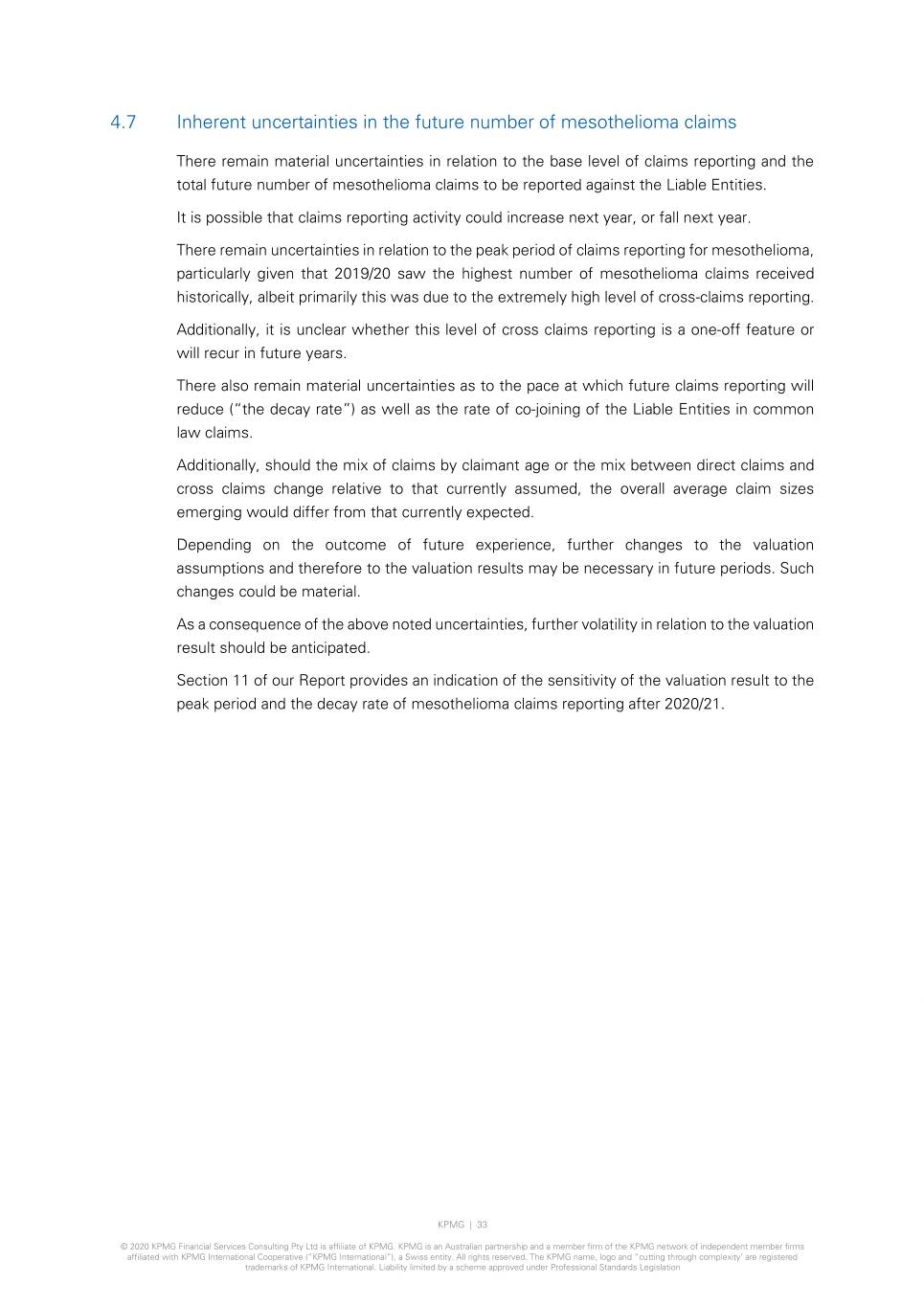
4.7 Inherent uncertainties in the future number of mesothelioma claims There remain material uncertainties in relation to the base level of claims reporting and the total future number of mesothelioma claims to be reported against the Liable Entities. It is possible that claims reporting activity could increase next year, or fall next year. There remain uncertainties in relation to the peak period of claims reporting for mesothelioma, particularly given that 2019/20 saw the highest number of mesothelioma claims received historically, albeit primarily this was due to the extremely high level of cross-claims reporting. Additionally, it is unclear whether this level of cross claims reporting is a one-off feature or will recur in future years. There also remain material uncertainties as to the pace at which future claims reporting will reduce (“the decay rate”) as well as the rate of co-joining of the Liable Entities in common law claims. Additionally, should the mix of claims by claimant age or the mix between direct claims and cross claims change relative to that currently assumed, the overall average claim sizes emerging would differ from that currently expected. Depending on the outcome of future experience, further changes to the valuation assumptions and therefore to the valuation results may be necessary in future periods. Such changes could be material. As a consequence of the above noted uncertainties, further volatility in relation to the valuation result should be anticipated. Section 11 of our Report provides an indication of the sensitivity of the valuation result to the peak period and the decay rate of mesothelioma claims reporting after 2020/21. KPMG | 33 © 2020 KPMG Financial Services Consulting Pty Ltd is affiliate of KPMG. KPMG is an Australian partnership and a member firm of the KPMG network of independent member firms affiliated with KPMG International Cooperative (“KPMG International”), a Swiss entity. All rights reserved. The KPMG name, logo and “cutting through complexity’ are registered trademarks of KPMG International. Liability limited by a scheme approved under Professional Standards Legislation
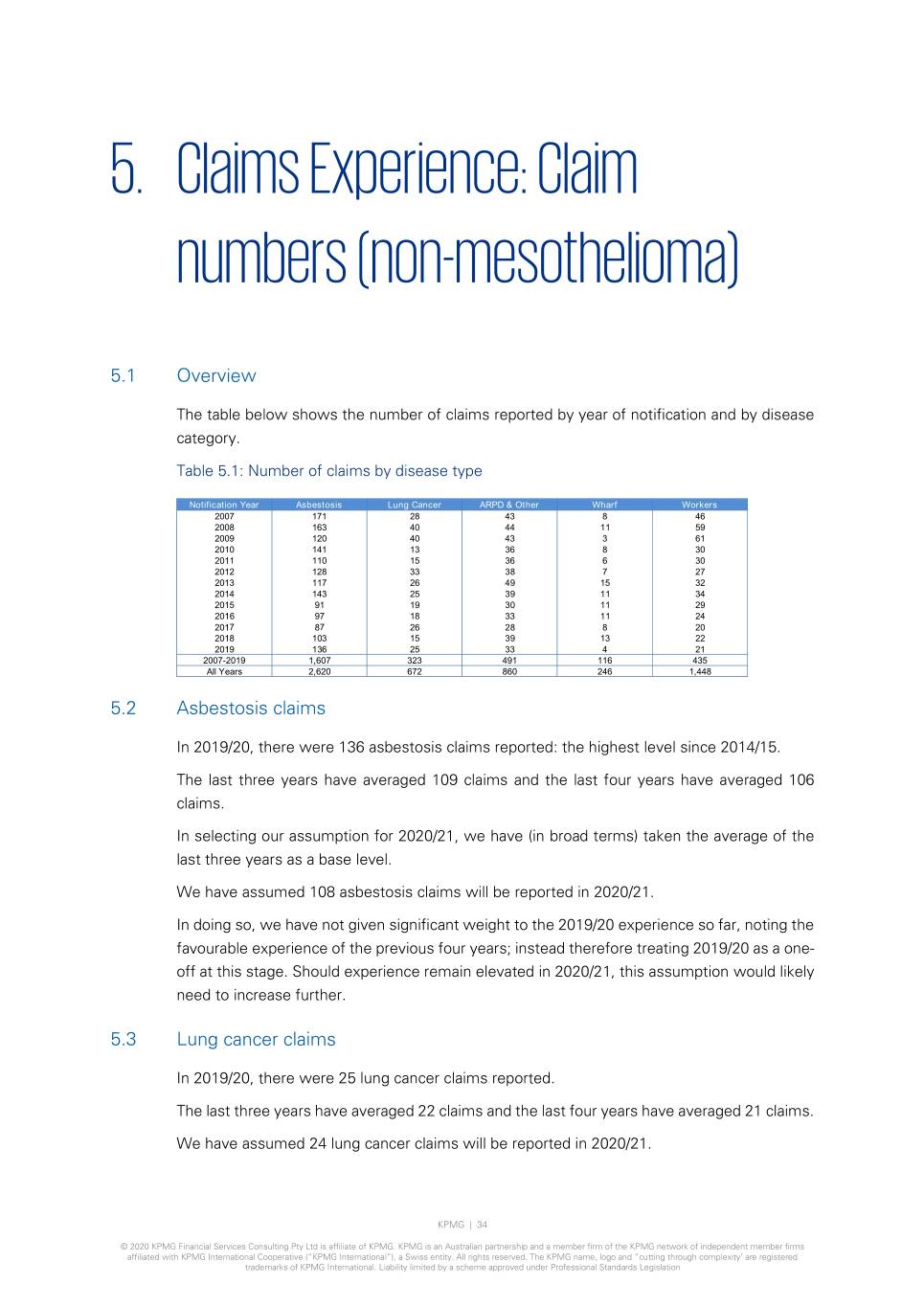
5. Claims Experience: Claim numbers (non-mesothelioma) 5.1 Overview The table below shows the number of claims reported by year of notification and by disease category. Table 5.1: Number of claims by disease type Notification Year Asbestosis Lung Cancer ARPD & Other Wharf Workers 2007 171 28 43 8 46 2008 163 40 44 11 59 2009 120 40 43 3 61 2010 141 13 36 8 30 2011 110 15 36 6 30 2012 128 33 38 7 27 2013 117 26 49 15 32 2014 143 25 39 11 34 2015 91 19 30 11 29 2016 97 18 33 11 24 2017 87 26 28 8 20 2018 103 15 39 13 22 2019 136 25 33 4 21 2007-2019 1,607 323 491 116 435 All Years 2,620 672 860 246 1,448 5.2 Asbestosis claims In 2019/20, there were 136 asbestosis claims reported: the highest level since 2014/15. The last three years have averaged 109 claims and the last four years have averaged 106 claims. In selecting our assumption for 2020/21, we have (in broad terms) taken the average of the last three years as a base level. We have assumed 108 asbestosis claims will be reported in 2020/21. In doing so, we have not given significant weight to the 2019/20 experience so far, noting the favourable experience of the previous four years; instead therefore treating 2019/20 as a one- off at this stage. Should experience remain elevated in 2020/21, this assumption would likely need to increase further. 5.3 Lung cancer claims In 2019/20, there were 25 lung cancer claims reported. The last three years have averaged 22 claims and the last four years have averaged 21 claims. We have assumed 24 lung cancer claims will be reported in 2020/21. KPMG | 34 © 2020 KPMG Financial Services Consulting Pty Ltd is affiliate of KPMG. KPMG is an Australian partnership and a member firm of the KPMG network of independent member firms affiliated with KPMG International Cooperative (“KPMG International”), a Swiss entity. All rights reserved. The KPMG name, logo and “cutting through complexity’ are registered trademarks of KPMG International. Liability limited by a scheme approved under Professional Standards Legislation
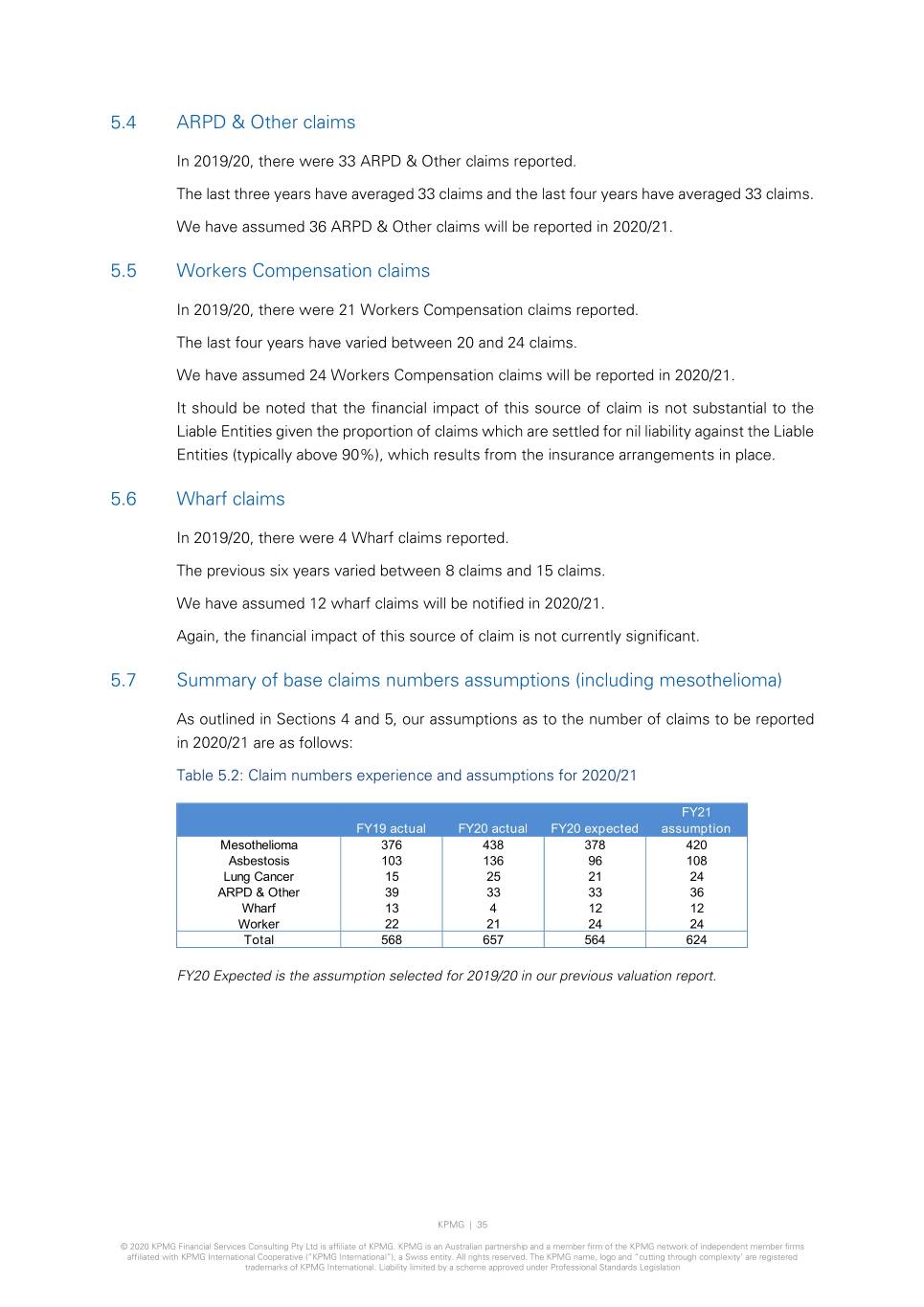
5.4 ARPD & Other claims In 2019/20, there were 33 ARPD & Other claims reported. The last three years have averaged 33 claims and the last four years have averaged 33 claims. We have assumed 36 ARPD & Other claims will be reported in 2020/21. 5.5 Workers Compensation claims In 2019/20, there were 21 Workers Compensation claims reported. The last four years have varied between 20 and 24 claims. We have assumed 24 Workers Compensation claims will be reported in 2020/21. It should be noted that the financial impact of this source of claim is not substantial to the Liable Entities given the proportion of claims which are settled for nil liability against the Liable Entities (typically above 90%), which results from the insurance arrangements in place. 5.6 Wharf claims In 2019/20, there were 4 Wharf claims reported. The previous six years varied between 8 claims and 15 claims. We have assumed 12 wharf claims will be notified in 2020/21. Again, the financial impact of this source of claim is not currently significant. 5.7 Summary of base claims numbers assumptions (including mesothelioma) As outlined in Sections 4 and 5, our assumptions as to the number of claims to be reported in 2020/21 are as follows: Table 5.2: Claim numbers experience and assumptions for 2020/21 FY21 FY19 actual FY20 actual FY20 expected assumption Mesothelioma 376 438 378 420 Asbestosis 103 136 96 108 Lung Cancer 15 25 21 24 ARPD & Other 39 33 33 36 Wharf 13 4 12 12 Worker 22 21 24 24 Total 568 657 564 624 FY20 Expected is the assumption selected for 2019/20 in our previous valuation report. KPMG | 35 © 2020 KPMG Financial Services Consulting Pty Ltd is affiliate of KPMG. KPMG is an Australian partnership and a member firm of the KPMG network of independent member firms affiliated with KPMG International Cooperative (“KPMG International”), a Swiss entity. All rights reserved. The KPMG name, logo and “cutting through complexity’ are registered trademarks of KPMG International. Liability limited by a scheme approved under Professional Standards Legislation
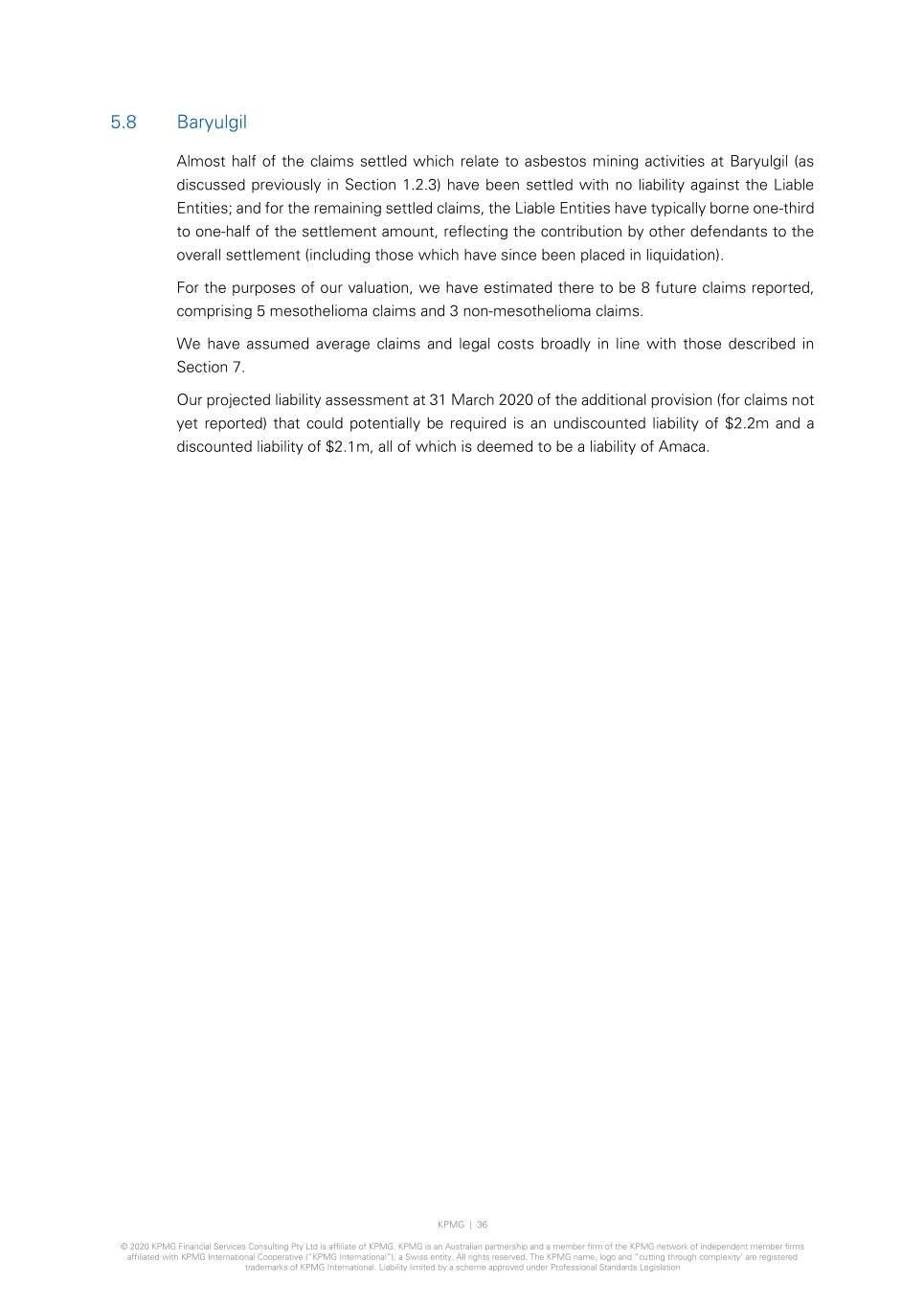
5.8 Baryulgil Almost half of the claims settled which relate to asbestos mining activities at Baryulgil (as discussed previously in Section 1.2.3) have been settled with no liability against the Liable Entities; and for the remaining settled claims, the Liable Entities have typically borne one-third to one-half of the settlement amount, reflecting the contribution by other defendants to the overall settlement (including those which have since been placed in liquidation). For the purposes of our valuation, we have estimated there to be 8 future claims reported, comprising 5 mesothelioma claims and 3 non-mesothelioma claims. We have assumed average claims and legal costs broadly in line with those described in Section 7. Our projected liability assessment at 31 March 2020 of the additional provision (for claims not yet reported) that could potentially be required is an undiscounted liability of $2.2m and a discounted liability of $2.1m, all of which is deemed to be a liability of Amaca. KPMG | 36 © 2020 KPMG Financial Services Consulting Pty Ltd is affiliate of KPMG. KPMG is an Australian partnership and a member firm of the KPMG network of independent member firms affiliated with KPMG International Cooperative (“KPMG International”), a Swiss entity. All rights reserved. The KPMG name, logo and “cutting through complexity’ are registered trademarks of KPMG International. Liability limited by a scheme approved under Professional Standards Legislation
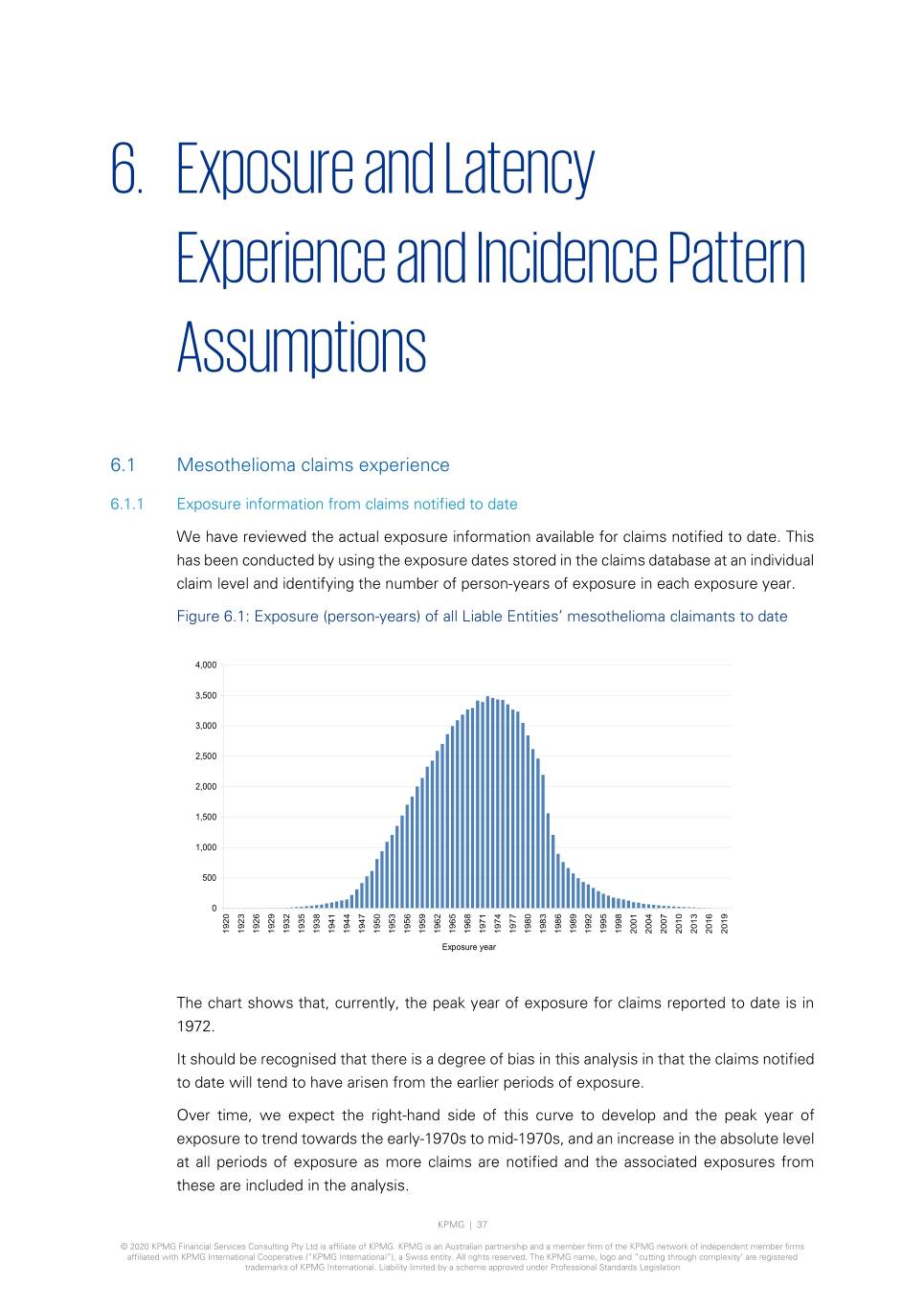
6. Exposure and Latency Experience and Incidence Pattern Assumptions 6.1 Mesothelioma claims experience 6.1.1 Exposure information from claims notified to date We have reviewed the actual exposure information available for claims notified to date. This has been conducted by using the exposure dates stored in the claims database at an individual claim level and identifying the number of person-years of exposure in each exposure year. Figure 6.1: Exposure (person-years) of all Liable Entities’ mesothelioma claimants to date 4,000 3,500 3,000 2,500 2,000 1,500 1,000 500 0 1920 1923 1926 1929 1932 1935 1938 1941 1944 1947 1950 1953 1956 1959 1962 1965 1968 1971 1974 1977 1980 1983 1986 1989 1992 1995 1998 2001 2004 2007 2010 2013 2016 2019 Exposure year The chart shows that, currently, the peak year of exposure for claims reported to date is in 1972. It should be recognised that there is a degree of bias in this analysis in that the claims notified to date will tend to have arisen from the earlier periods of exposure. Over time, we expect the right-hand side of this curve to develop and the peak year of exposure to trend towards the early-1970s to mid-1970s, and an increase in the absolute level at all periods of exposure as more claims are notified and the associated exposures from these are included in the analysis. KPMG | 37 © 2020 KPMG Financial Services Consulting Pty Ltd is affiliate of KPMG. KPMG is an Australian partnership and a member firm of the KPMG network of independent member firms affiliated with KPMG International Cooperative (“KPMG International”), a Swiss entity. All rights reserved. The KPMG name, logo and “cutting through complexity’ are registered trademarks of KPMG International. Liability limited by a scheme approved under Professional Standards Legislation
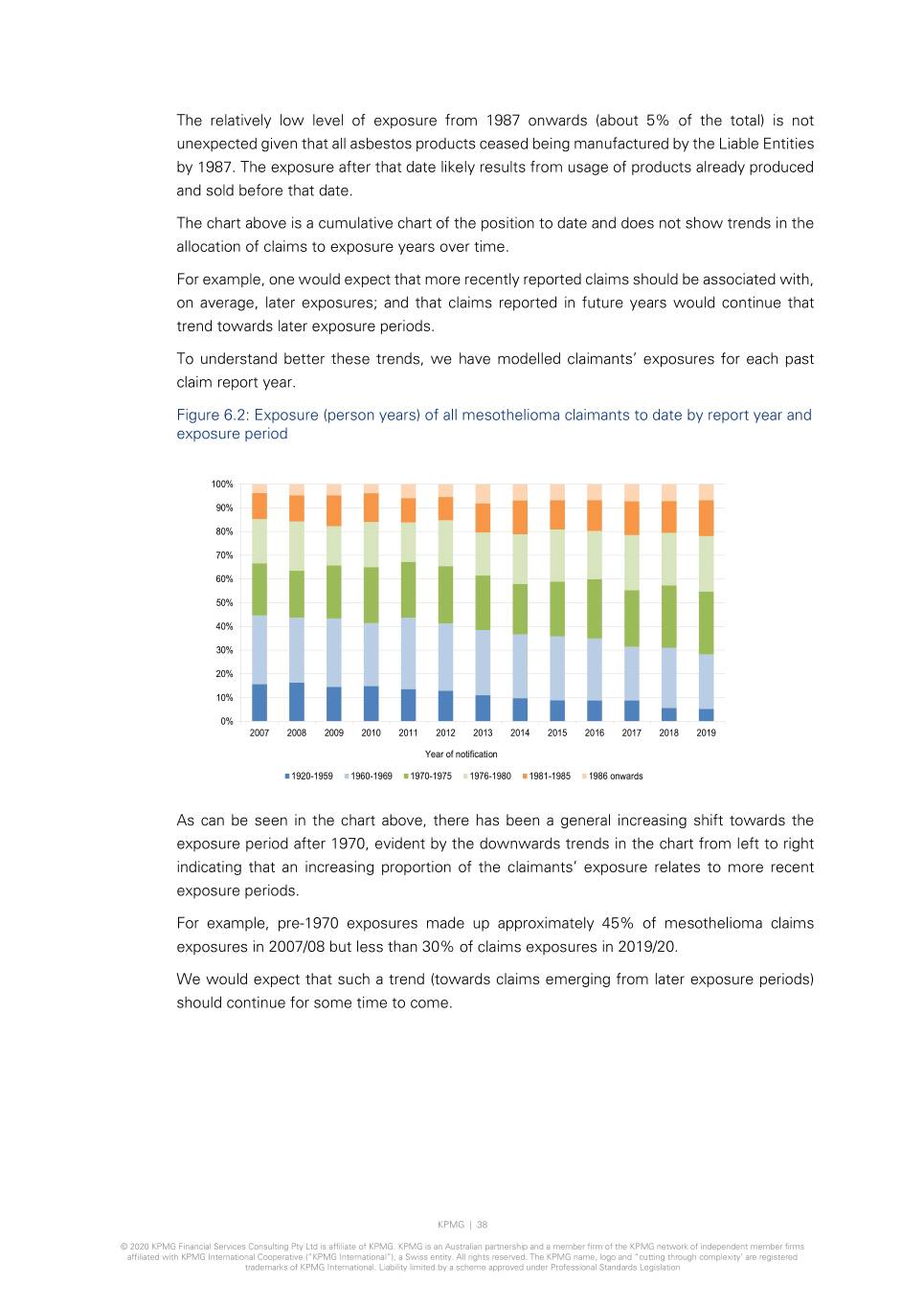
The relatively low level of exposure from 1987 onwards (about 5% of the total) is not unexpected given that all asbestos products ceased being manufactured by the Liable Entities by 1987. The exposure after that date likely results from usage of products already produced and sold before that date. The chart above is a cumulative chart of the position to date and does not show trends in the allocation of claims to exposure years over time. For example, one would expect that more recently reported claims should be associated with, on average, later exposures; and that claims reported in future years would continue that trend towards later exposure periods. To understand better these trends, we have modelled claimants’ exposures for each past claim report year. Figure 6.2: Exposure (person years) of all mesothelioma claimants to date by report year and exposure period 100% 90% 80% 70% 60% 50% 40% 30% 20% 10% 0% 2007 2008 2009 2010 2011 2012 2013 2014 2015 2016 2017 2018 2019 Year of notification 1920-1959 1960-1969 1970-1975 1976-1980 1981-1985 1986 onwards As can be seen in the chart above, there has been a general increasing shift towards the exposure period after 1970, evident by the downwards trends in the chart from left to right indicating that an increasing proportion of the claimants’ exposure relates to more recent exposure periods. For example, pre-1970 exposures made up approximately 45% of mesothelioma claims exposures in 2007/08 but less than 30% of claims exposures in 2019/20. We would expect that such a trend (towards claims emerging from later exposure periods) should continue for some time to come. KPMG | 38 © 2020 KPMG Financial Services Consulting Pty Ltd is affiliate of KPMG. KPMG is an Australian partnership and a member firm of the KPMG network of independent member firms affiliated with KPMG International Cooperative (“KPMG International”), a Swiss entity. All rights reserved. The KPMG name, logo and “cutting through complexity’ are registered trademarks of KPMG International. Liability limited by a scheme approved under Professional Standards Legislation
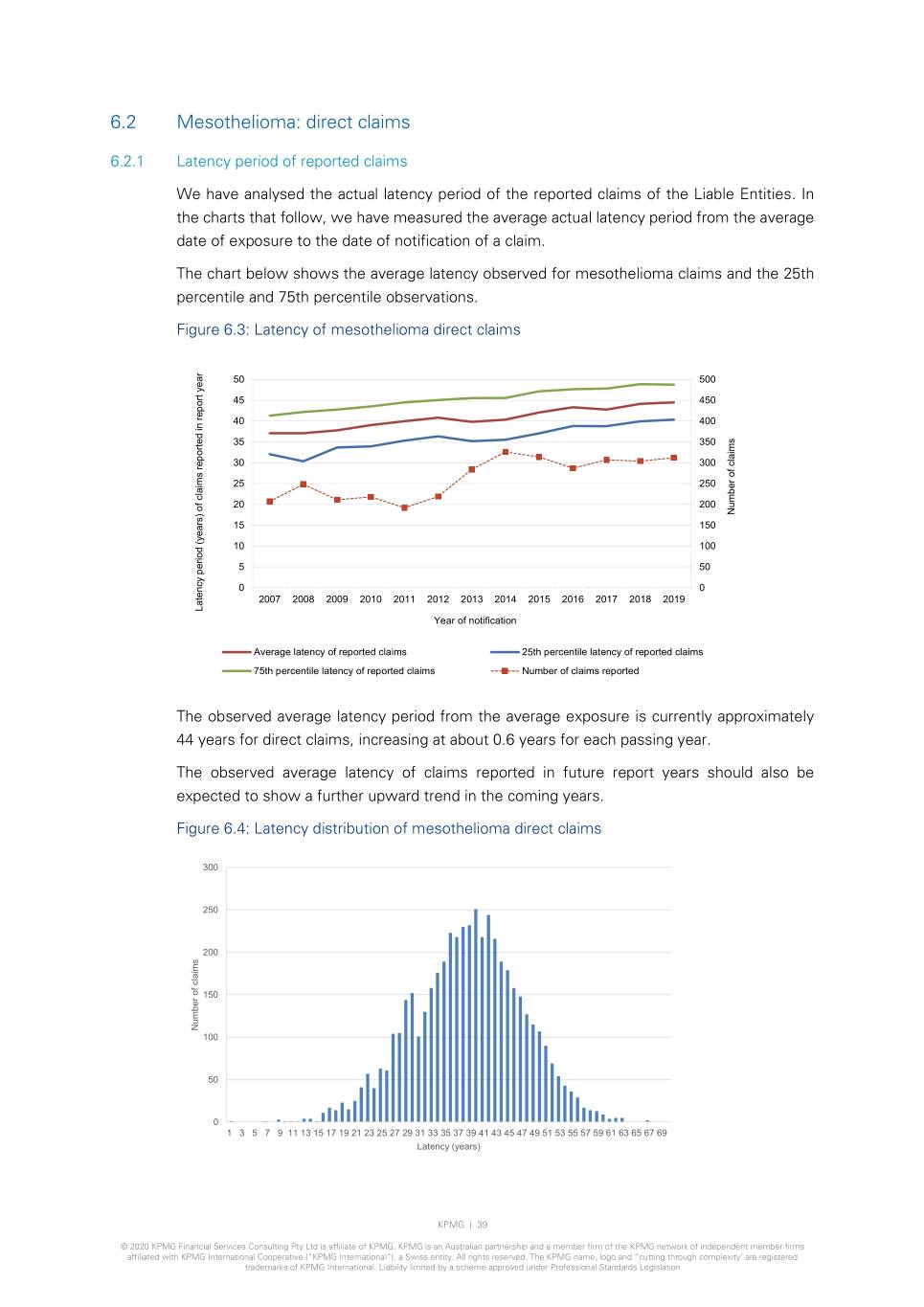
6.2 Mesothelioma: direct claims 6.2.1 Latency period of reported claims We have analysed the actual latency period of the reported claims of the Liable Entities. In the charts that follow, we have measured the average actual latency period from the average date of exposure to the date of notification of a claim. The chart below shows the average latency observed for mesothelioma claims and the 25th percentile and 75th percentile observations. Figure 6.3: Latency of mesothelioma direct claims 50 500 45 450 40 400 35 350 30 300 25 250 20 200 Number of claims of Number 15 150 10 100 5 50 0 0 2007 2008 2009 2010 2011 2012 2013 2014 2015 2016 2017 2018 2019 Latency period (years) of claims reported in report year in report reported claims of (years) period Latency Year of notification Average latency of reported claims 25th percentile latency of reported claims 75th percentile latency of reported claims Number of claims reported The observed average latency period from the average exposure is currently approximately 44 years for direct claims, increasing at about 0.6 years for each passing year. The observed average latency of claims reported in future report years should also be expected to show a further upward trend in the coming years. Figure 6.4: Latency distribution of mesothelioma direct claims 300 250 200 150 Number of claims of Number 100 50 0 1 3 5 7 9 11 13 15 17 19 21 23 25 27 29 31 33 35 37 39 41 43 45 47 49 51 53 55 57 59 61 63 65 67 69 Latency (years) KPMG | 39 © 2020 KPMG Financial Services Consulting Pty Ltd is affiliate of KPMG. KPMG is an Australian partnership and a member firm of the KPMG network of independent member firms affiliated with KPMG International Cooperative (“KPMG International”), a Swiss entity. All rights reserved. The KPMG name, logo and “cutting through complexity’ are registered trademarks of KPMG International. Liability limited by a scheme approved under Professional Standards Legislation
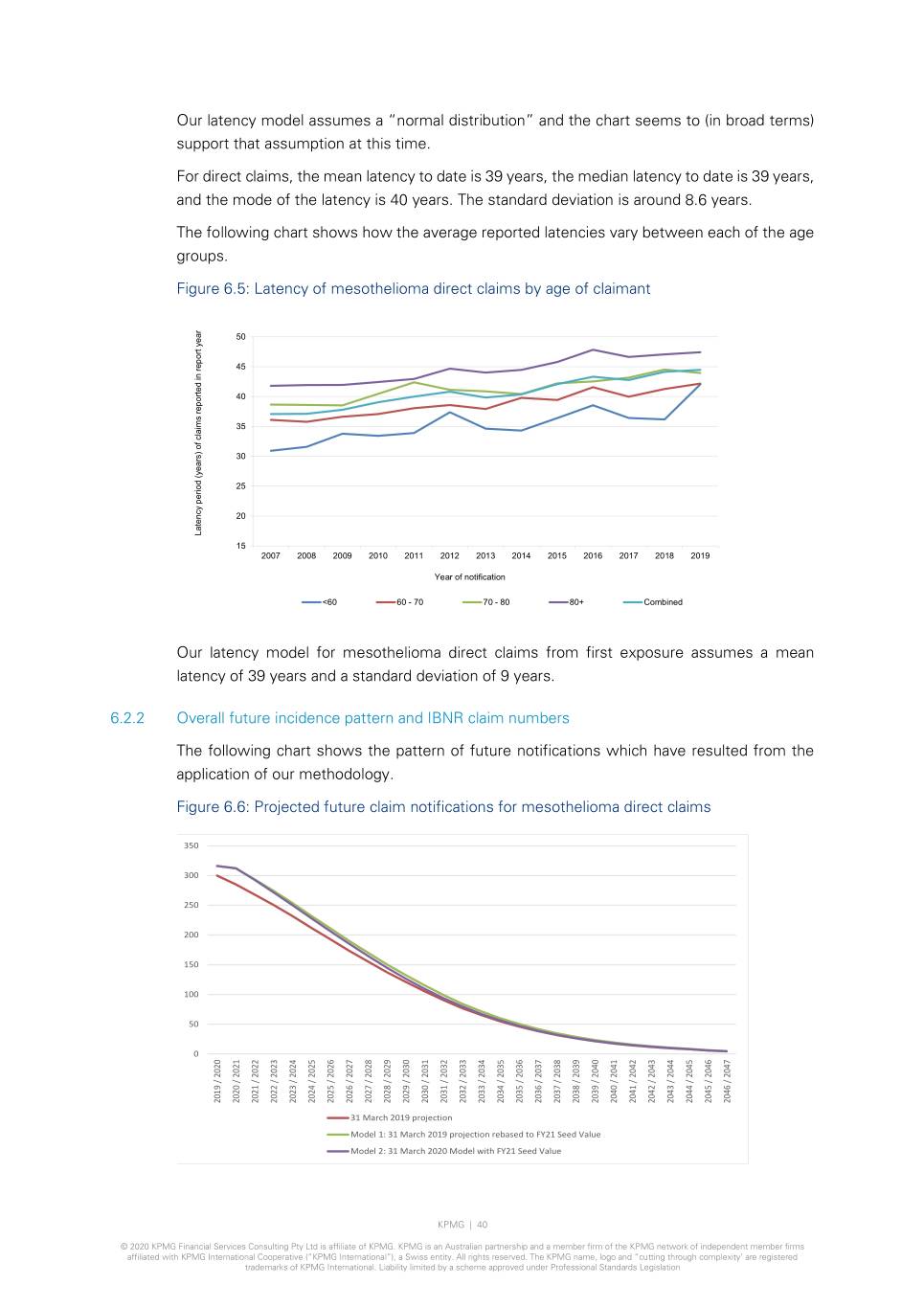
Our latency model assumes a “normal distribution” and the chart seems to (in broad terms) support that assumption at this time. For direct claims, the mean latency to date is 39 years, the median latency to date is 39 years, and the mode of the latency is 40 years. The standard deviation is around 8.6 years. The following chart shows how the average reported latencies vary between each of the age groups. Figure 6.5: Latency of mesothelioma direct claims by age of claimant 50 45 40 35 30 25 20 Latency period (years) of claims reported in report year in report reported claims of (years) period Latency 15 2007 2008 2009 2010 2011 2012 2013 2014 2015 2016 2017 2018 2019 Year of notification <60 60 - 70 70 - 80 80+ Combined Our latency model for mesothelioma direct claims from first exposure assumes a mean latency of 39 years and a standard deviation of 9 years. 6.2.2 Overall future incidence pattern and IBNR claim numbers The following chart shows the pattern of future notifications which have resulted from the application of our methodology. Figure 6.6: Projected future claim notifications for mesothelioma direct claims 350 300 250 200 150 100 50 0 2019 / 2020 2020 / 2021 2021 / 2022 2022 / 2023 2023 / 2024 2024 / 2025 2025 / 2026 2026 / 2027 2027 / 2028 2028 / 2029 2029 / 2030 2030 / 2031 2031 / 2032 2032 / 2033 2033 / 2034 2034 / 2035 2035 / 2036 2036 / 2037 2037 / 2038 2038 / 2039 2039 / 2040 2040 / 2041 2041 / 2042 2042 / 2043 2043 / 2044 2044 / 2045 2045 / 2046 2046 / 2047 31 March 2019 projection Model 1: 31 March 2019 projection rebased to FY21 Seed Value Model 2: 31 March 2020 Model with FY21 Seed Value KPMG | 40 © 2020 KPMG Financial Services Consulting Pty Ltd is affiliate of KPMG. KPMG is an Australian partnership and a member firm of the KPMG network of independent member firms affiliated with KPMG International Cooperative (“KPMG International”), a Swiss entity. All rights reserved. The KPMG name, logo and “cutting through complexity’ are registered trademarks of KPMG International. Liability limited by a scheme approved under Professional Standards Legislation
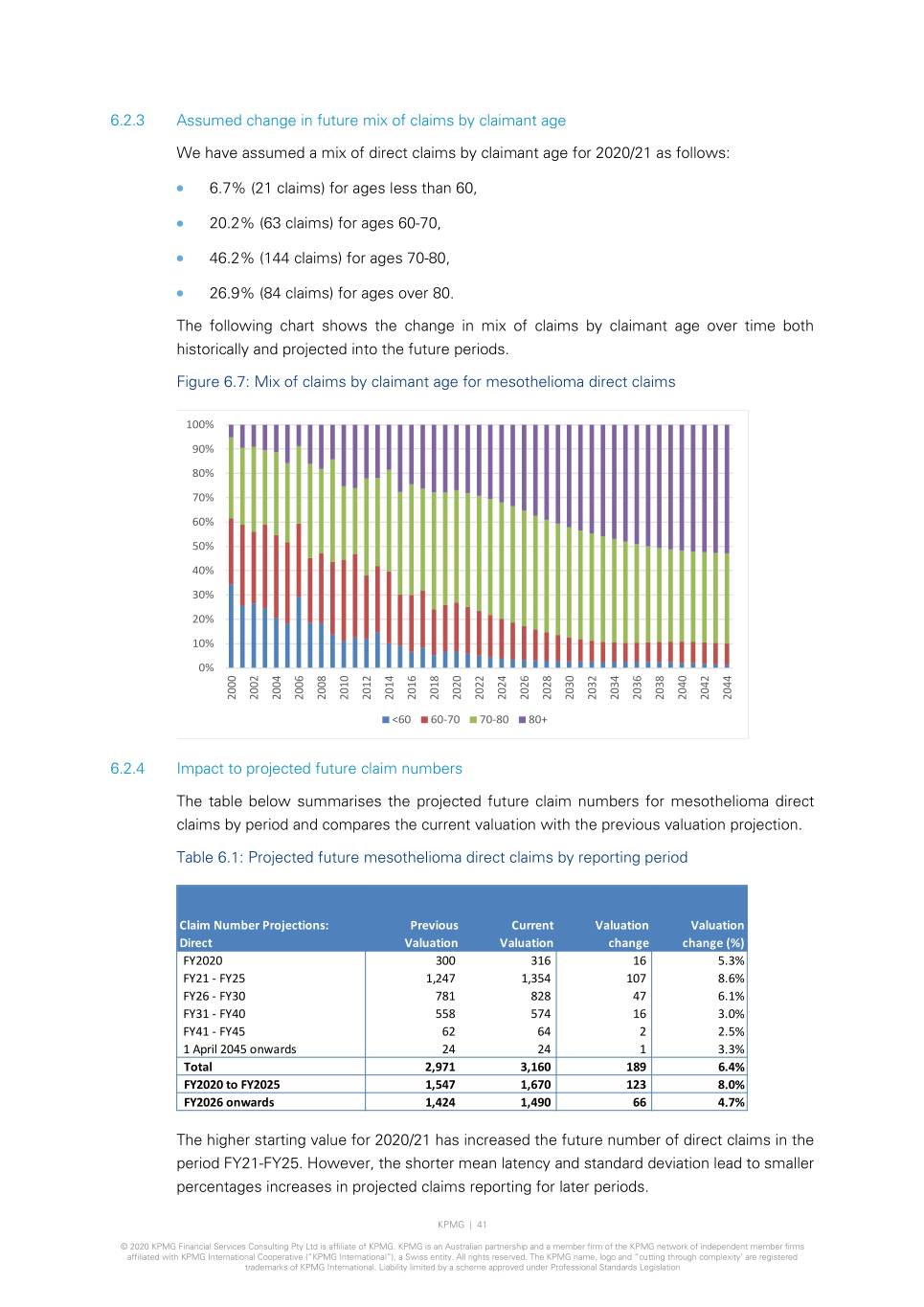
6.2.3 Assumed change in future mix of claims by claimant age We have assumed a mix of direct claims by claimant age for 2020/21 as follows: • 6.7% (21 claims) for ages less than 60, • 20.2% (63 claims) for ages 60-70, • 46.2% (144 claims) for ages 70-80, • 26.9% (84 claims) for ages over 80. The following chart shows the change in mix of claims by claimant age over time both historically and projected into the future periods. Figure 6.7: Mix of claims by claimant age for mesothelioma direct claims 100% 90% 80% 70% 60% 50% 40% 30% 20% 10% 0% 2000 2002 2004 2006 2008 2010 2012 2014 2016 2018 2020 2022 2024 2026 2028 2030 2032 2034 2036 2038 2040 2042 2044 <60 60-70 70-80 80+ 6.2.4 Impact to projected future claim numbers The table below summarises the projected future claim numbers for mesothelioma direct claims by period and compares the current valuation with the previous valuation projection. Table 6.1: Projected future mesothelioma direct claims by reporting period Claim Number Projections: Previous Current Valuation Valuation Direct Valuation Valuation change change (%) FY2020 300 316 16 5.3% FY21 - FY25 1,247 1,354 107 8.6% FY26 - FY30 781 828 47 6.1% FY31 - FY40 558 574 16 3.0% FY41 - FY45 62 64 2 2.5% 1 April 2045 onwards 24 24 1 3.3% Total 2,971 3,160 189 6.4% FY2020 to FY2025 1,547 1,670 123 8.0% FY2026 onwards 1,424 1,490 66 4.7% The higher starting value for 2020/21 has increased the future number of direct claims in the period FY21-FY25. However, the shorter mean latency and standard deviation lead to smaller percentages increases in projected claims reporting for later periods. KPMG | 41 © 2020 KPMG Financial Services Consulting Pty Ltd is affiliate of KPMG. KPMG is an Australian partnership and a member firm of the KPMG network of independent member firms affiliated with KPMG International Cooperative (“KPMG International”), a Swiss entity. All rights reserved. The KPMG name, logo and “cutting through complexity’ are registered trademarks of KPMG International. Liability limited by a scheme approved under Professional Standards Legislation
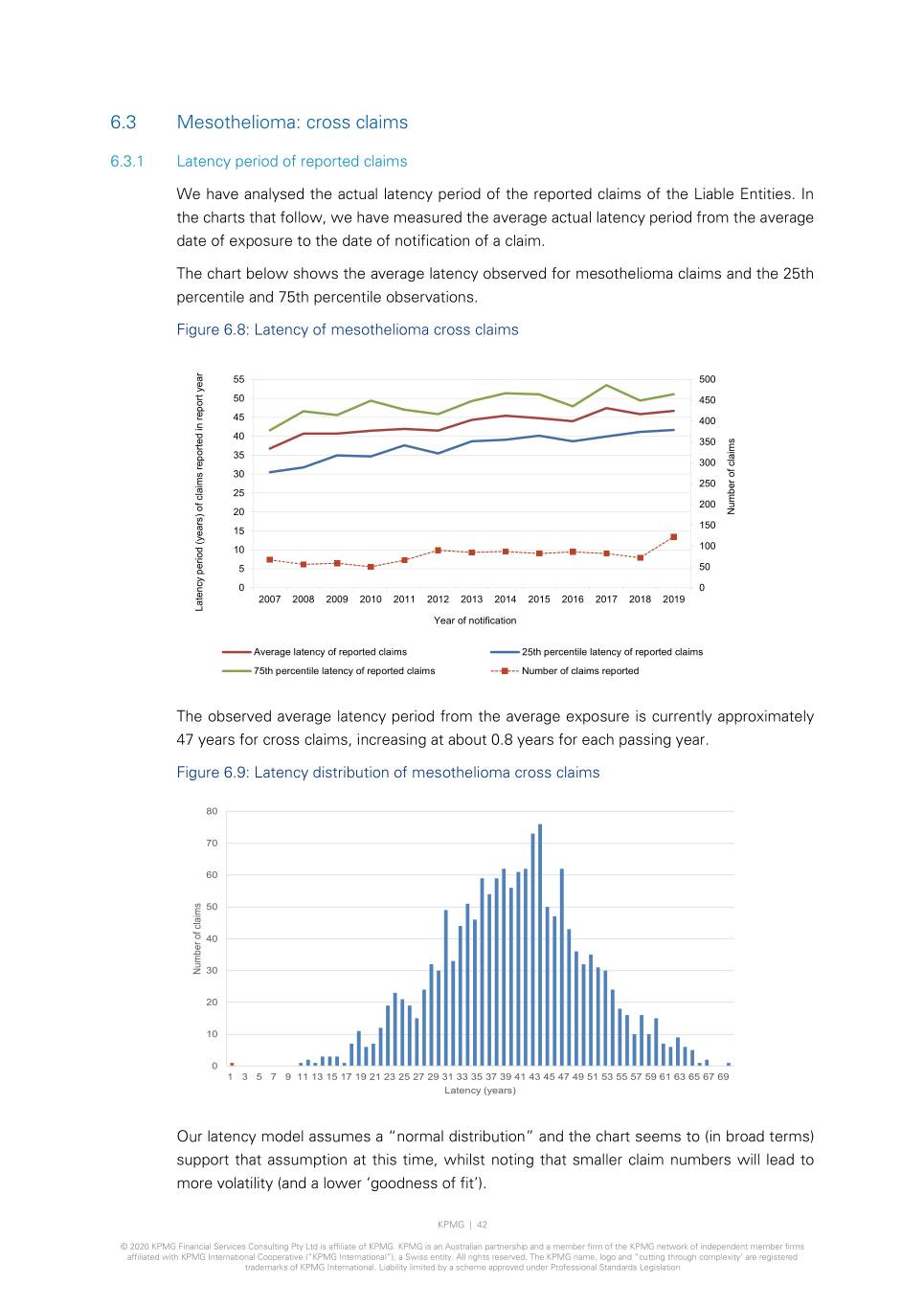
6.3 Mesothelioma: cross claims 6.3.1 Latency period of reported claims We have analysed the actual latency period of the reported claims of the Liable Entities. In the charts that follow, we have measured the average actual latency period from the average date of exposure to the date of notification of a claim. The chart below shows the average latency observed for mesothelioma claims and the 25th percentile and 75th percentile observations. Figure 6.8: Latency of mesothelioma cross claims 55 500 50 450 45 400 40 350 35 300 30 250 25 200 20 claims of Number 150 15 10 100 5 50 0 0 2007 2008 2009 2010 2011 2012 2013 2014 2015 2016 2017 2018 2019 Latency period (years) of claims reported in report year in report reported claims of (years) period Latency Year of notification Average latency of reported claims 25th percentile latency of reported claims 75th percentile latency of reported claims Number of claims reported The observed average latency period from the average exposure is currently approximately 47 years for cross claims, increasing at about 0.8 years for each passing year. Figure 6.9: Latency distribution of mesothelioma cross claims 80 70 60 50 40 Number of claims of Number 30 20 10 0 1 3 5 7 9 11 13 15 17 19 21 23 25 27 29 31 33 35 37 39 41 43 45 47 49 51 53 55 57 59 61 63 65 67 69 Latency (years) Our latency model assumes a “normal distribution” and the chart seems to (in broad terms) support that assumption at this time, whilst noting that smaller claim numbers will lead to more volatility (and a lower ‘goodness of fit’). KPMG | 42 © 2020 KPMG Financial Services Consulting Pty Ltd is affiliate of KPMG. KPMG is an Australian partnership and a member firm of the KPMG network of independent member firms affiliated with KPMG International Cooperative (“KPMG International”), a Swiss entity. All rights reserved. The KPMG name, logo and “cutting through complexity’ are registered trademarks of KPMG International. Liability limited by a scheme approved under Professional Standards Legislation
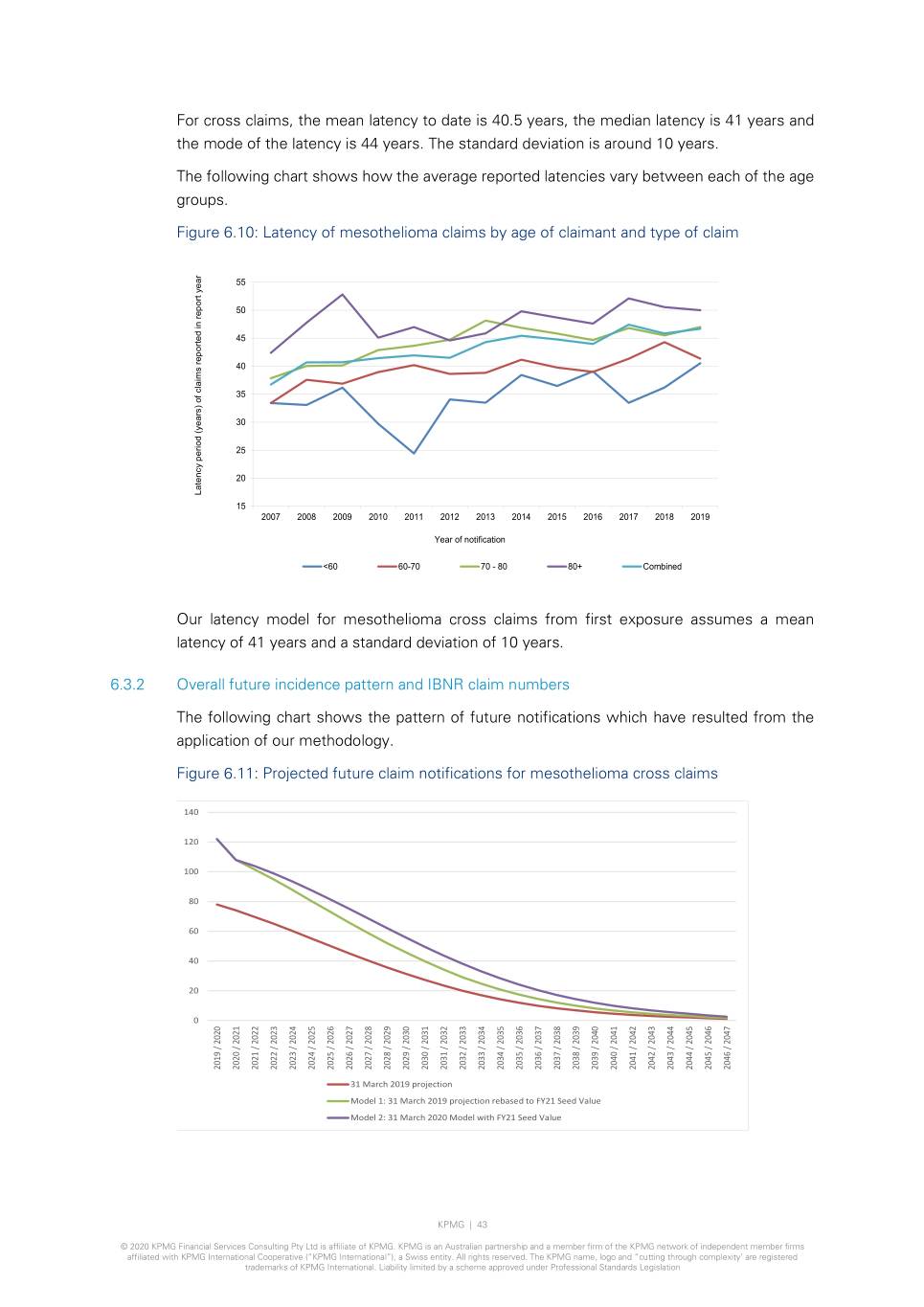
For cross claims, the mean latency to date is 40.5 years, the median latency is 41 years and the mode of the latency is 44 years. The standard deviation is around 10 years. The following chart shows how the average reported latencies vary between each of the age groups. Figure 6.10: Latency of mesothelioma claims by age of claimant and type of claim 55 50 45 40 35 30 25 20 Latency period (years) of claims reported in report year in report reported claims of (years) period Latency 15 2007 2008 2009 2010 2011 2012 2013 2014 2015 2016 2017 2018 2019 Year of notification <60 60-70 70 - 80 80+ Combined Our latency model for mesothelioma cross claims from first exposure assumes a mean latency of 41 years and a standard deviation of 10 years. 6.3.2 Overall future incidence pattern and IBNR claim numbers The following chart shows the pattern of future notifications which have resulted from the application of our methodology. Figure 6.11: Projected future claim notifications for mesothelioma cross claims 140 120 100 80 60 40 20 0 2019 / 2020 2020 / 2021 2021 / 2022 2022 / 2023 2023 / 2024 2024 / 2025 2025 / 2026 2026 / 2027 2027 / 2028 2028 / 2029 2029 / 2030 2030 / 2031 2031 / 2032 2032 / 2033 2033 / 2034 2034 / 2035 2035 / 2036 2036 / 2037 2037 / 2038 2038 / 2039 2039 / 2040 2040 / 2041 2041 / 2042 2042 / 2043 2043 / 2044 2044 / 2045 2045 / 2046 2046 / 2047 31 March 2019 projection Model 1: 31 March 2019 projection rebased to FY21 Seed Value Model 2: 31 March 2020 Model with FY21 Seed Value KPMG | 43 © 2020 KPMG Financial Services Consulting Pty Ltd is affiliate of KPMG. KPMG is an Australian partnership and a member firm of the KPMG network of independent member firms affiliated with KPMG International Cooperative (“KPMG International”), a Swiss entity. All rights reserved. The KPMG name, logo and “cutting through complexity’ are registered trademarks of KPMG International. Liability limited by a scheme approved under Professional Standards Legislation
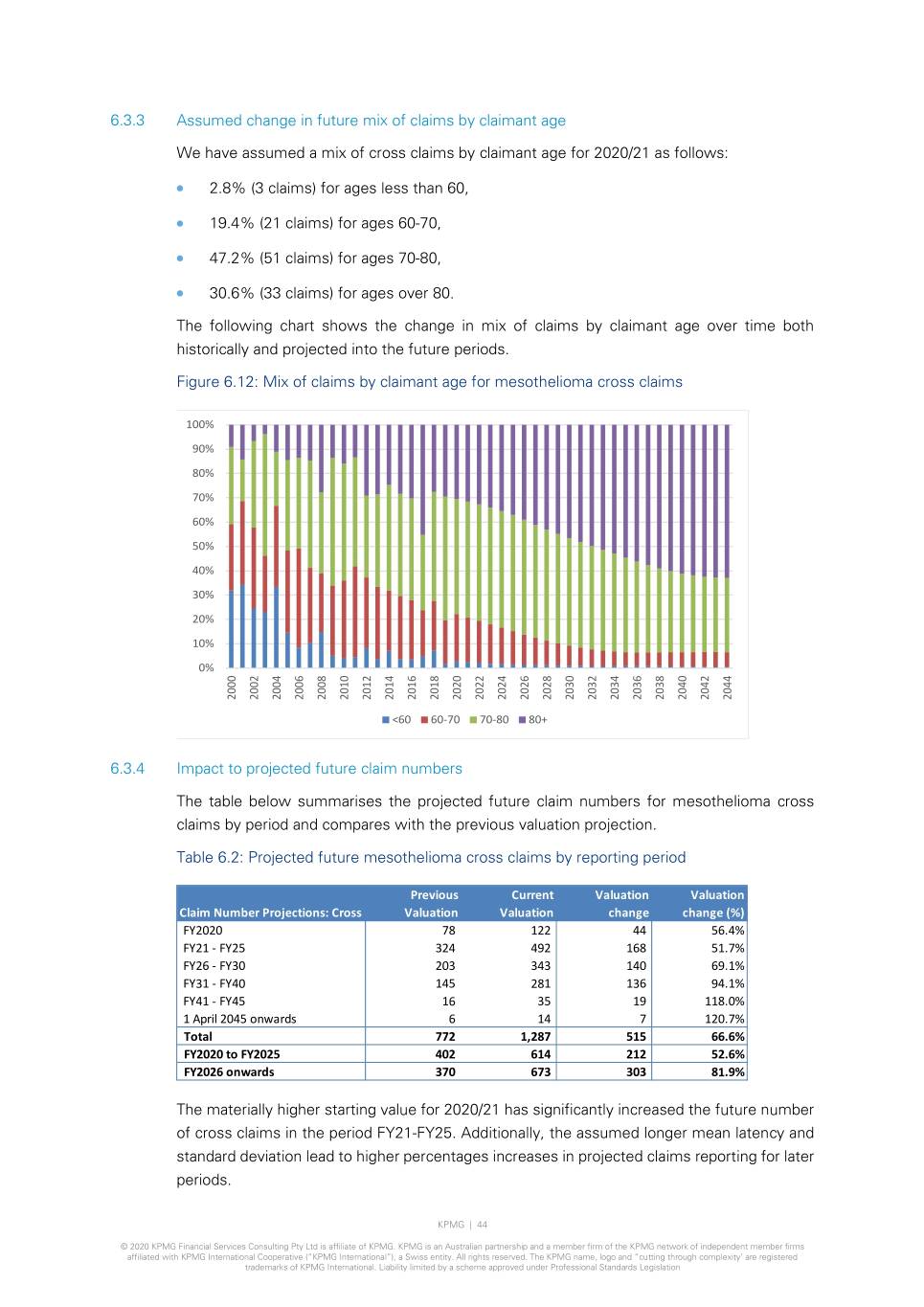
6.3.3 Assumed change in future mix of claims by claimant age We have assumed a mix of cross claims by claimant age for 2020/21 as follows: • 2.8% (3 claims) for ages less than 60, • 19.4% (21 claims) for ages 60-70, • 47.2% (51 claims) for ages 70-80, • 30.6% (33 claims) for ages over 80. The following chart shows the change in mix of claims by claimant age over time both historically and projected into the future periods. Figure 6.12: Mix of claims by claimant age for mesothelioma cross claims 100% 90% 80% 70% 60% 50% 40% 30% 20% 10% 0% 2000 2002 2004 2006 2008 2010 2012 2014 2016 2018 2020 2022 2024 2026 2028 2030 2032 2034 2036 2038 2040 2042 2044 <60 60-70 70-80 80+ 6.3.4 Impact to projected future claim numbers The table below summarises the projected future claim numbers for mesothelioma cross claims by period and compares with the previous valuation projection. Table 6.2: Projected future mesothelioma cross claims by reporting period Previous Current Valuation Valuation Claim Number Projections: Cross Valuation Valuation change change (%) FY2020 78 122 44 56.4% FY21 - FY25 324 492 168 51.7% FY26 - FY30 203 343 140 69.1% FY31 - FY40 145 281 136 94.1% FY41 - FY45 16 35 19 118.0% 1 April 2045 onwards 6 14 7 120.7% Total 772 1,287 515 66.6% FY2020 to FY2025 402 614 212 52.6% FY2026 onwards 370 673 303 81.9% The materially higher starting value for 2020/21 has significantly increased the future number of cross claims in the period FY21-FY25. Additionally, the assumed longer mean latency and standard deviation lead to higher percentages increases in projected claims reporting for later periods. KPMG | 44 © 2020 KPMG Financial Services Consulting Pty Ltd is affiliate of KPMG. KPMG is an Australian partnership and a member firm of the KPMG network of independent member firms affiliated with KPMG International Cooperative (“KPMG International”), a Swiss entity. All rights reserved. The KPMG name, logo and “cutting through complexity’ are registered trademarks of KPMG International. Liability limited by a scheme approved under Professional Standards Legislation
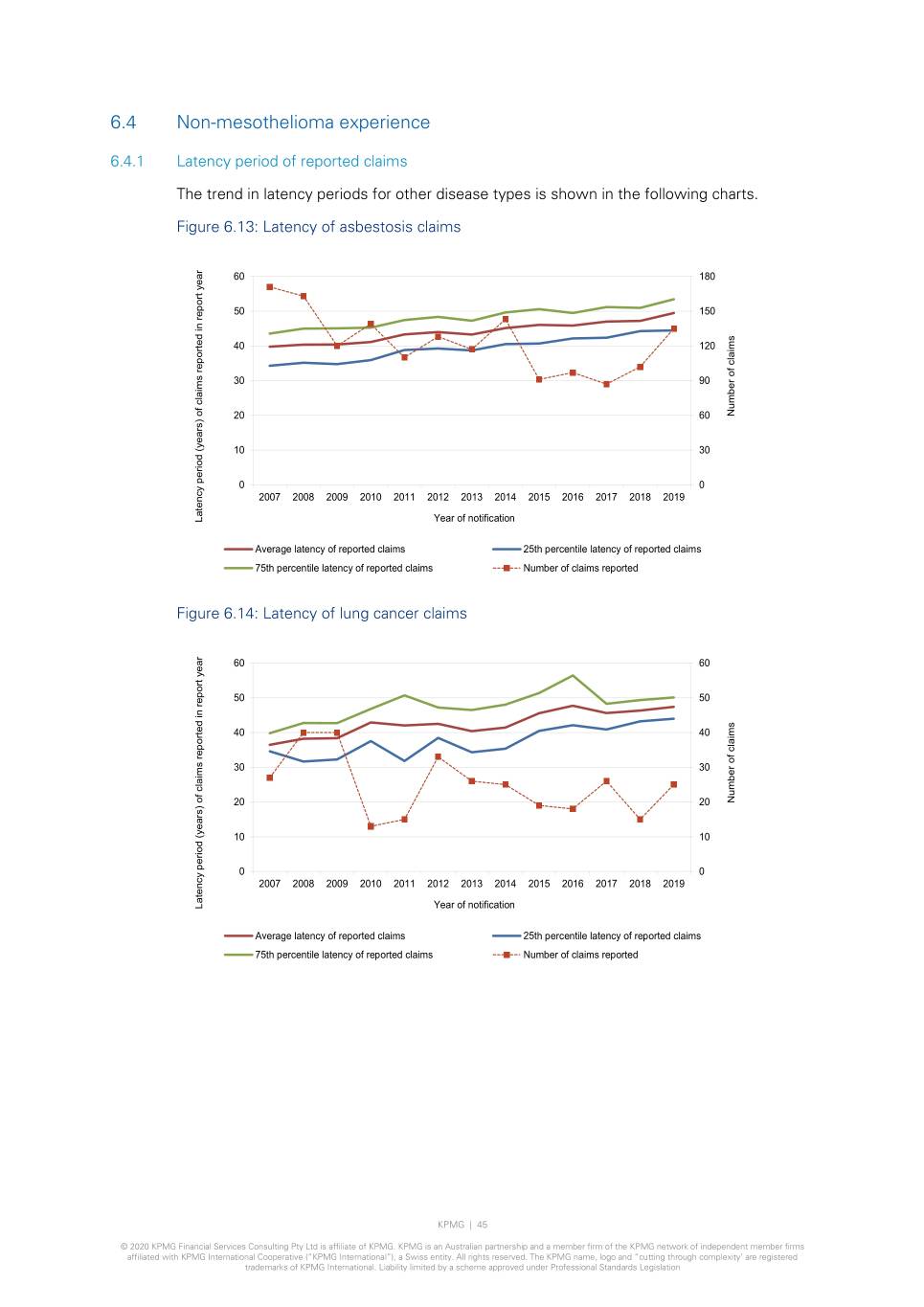
6.4 Non-mesothelioma experience 6.4.1 Latency period of reported claims The trend in latency periods for other disease types is shown in the following charts. Figure 6.13: Latency of asbestosis claims 60 180 50 150 40 120 30 90 20 60 claims of Number 10 30 0 0 2007 2008 2009 2010 2011 2012 2013 2014 2015 2016 2017 2018 2019 Latency period (years) of claims reported in report year in report reported claims of (years) period Latency Year of notification Average latency of reported claims 25th percentile latency of reported claims 75th percentile latency of reported claims Number of claims reported Figure 6.14: Latency of lung cancer claims 60 60 50 50 40 40 30 30 20 20 claims of Number 10 10 0 0 2007 2008 2009 2010 2011 2012 2013 2014 2015 2016 2017 2018 2019 Latency period (years) of claims reported in report year in report reported claims of (years) period Latency Year of notification Average latency of reported claims 25th percentile latency of reported claims 75th percentile latency of reported claims Number of claims reported KPMG | 45 © 2020 KPMG Financial Services Consulting Pty Ltd is affiliate of KPMG. KPMG is an Australian partnership and a member firm of the KPMG network of independent member firms affiliated with KPMG International Cooperative (“KPMG International”), a Swiss entity. All rights reserved. The KPMG name, logo and “cutting through complexity’ are registered trademarks of KPMG International. Liability limited by a scheme approved under Professional Standards Legislation
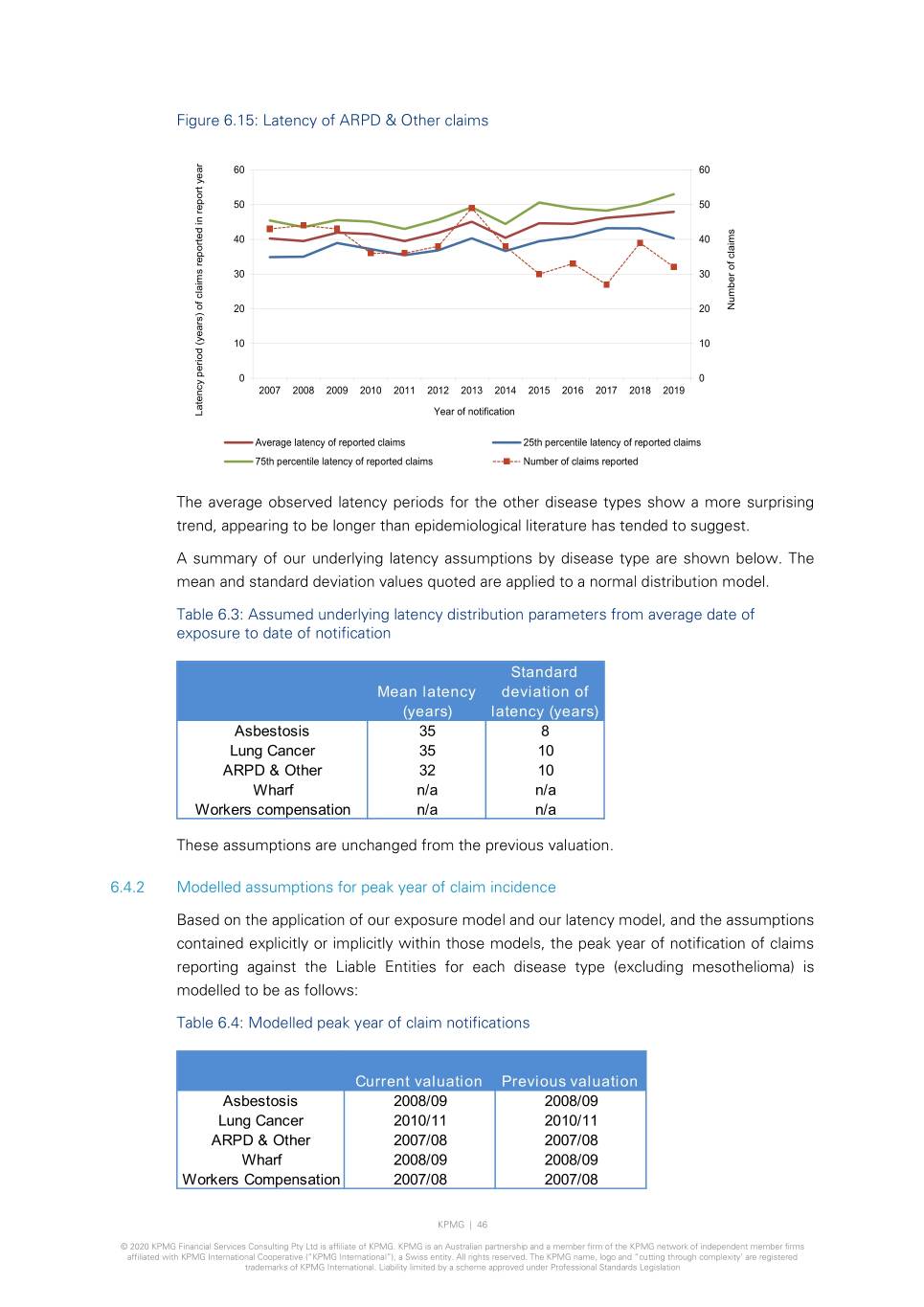
Figure 6.15: Latency of ARPD & Other claims 60 60 50 50 40 40 30 30 20 20 claims of Number 10 10 0 0 2007 2008 2009 2010 2011 2012 2013 2014 2015 2016 2017 2018 2019 Latency period (years) of claims reported in report year in report reported claims of (years) period Latency Year of notification Average latency of reported claims 25th percentile latency of reported claims 75th percentile latency of reported claims Number of claims reported The average observed latency periods for the other disease types show a more surprising trend, appearing to be longer than epidemiological literature has tended to suggest. A summary of our underlying latency assumptions by disease type are shown below. The mean and standard deviation values quoted are applied to a normal distribution model. Table 6.3: Assumed underlying latency distribution parameters from average date of exposure to date of notification Standard Mean latency deviation of (years) latency (years) Asbestosis 35 8 Lung Cancer 35 10 ARPD & Other 32 10 Wharf n/a n/a Workers compensation n/a n/a These assumptions are unchanged from the previous valuation. 6.4.2 Modelled assumptions for peak year of claim incidence Based on the application of our exposure model and our latency model, and the assumptions contained explicitly or implicitly within those models, the peak year of notification of claims reporting against the Liable Entities for each disease type (excluding mesothelioma) is modelled to be as follows: Table 6.4: Modelled peak year of claim notifications Current valuation Previous valuation Asbestosis 2008/09 2008/09 Lung Cancer 2010/11 2010/11 ARPD & Other 2007/08 2007/08 Wharf 2008/09 2008/09 Workers Compensation 2007/08 2007/08 KPMG | 46 © 2020 KPMG Financial Services Consulting Pty Ltd is affiliate of KPMG. KPMG is an Australian partnership and a member firm of the KPMG network of independent member firms affiliated with KPMG International Cooperative (“KPMG International”), a Swiss entity. All rights reserved. The KPMG name, logo and “cutting through complexity’ are registered trademarks of KPMG International. Liability limited by a scheme approved under Professional Standards Legislation
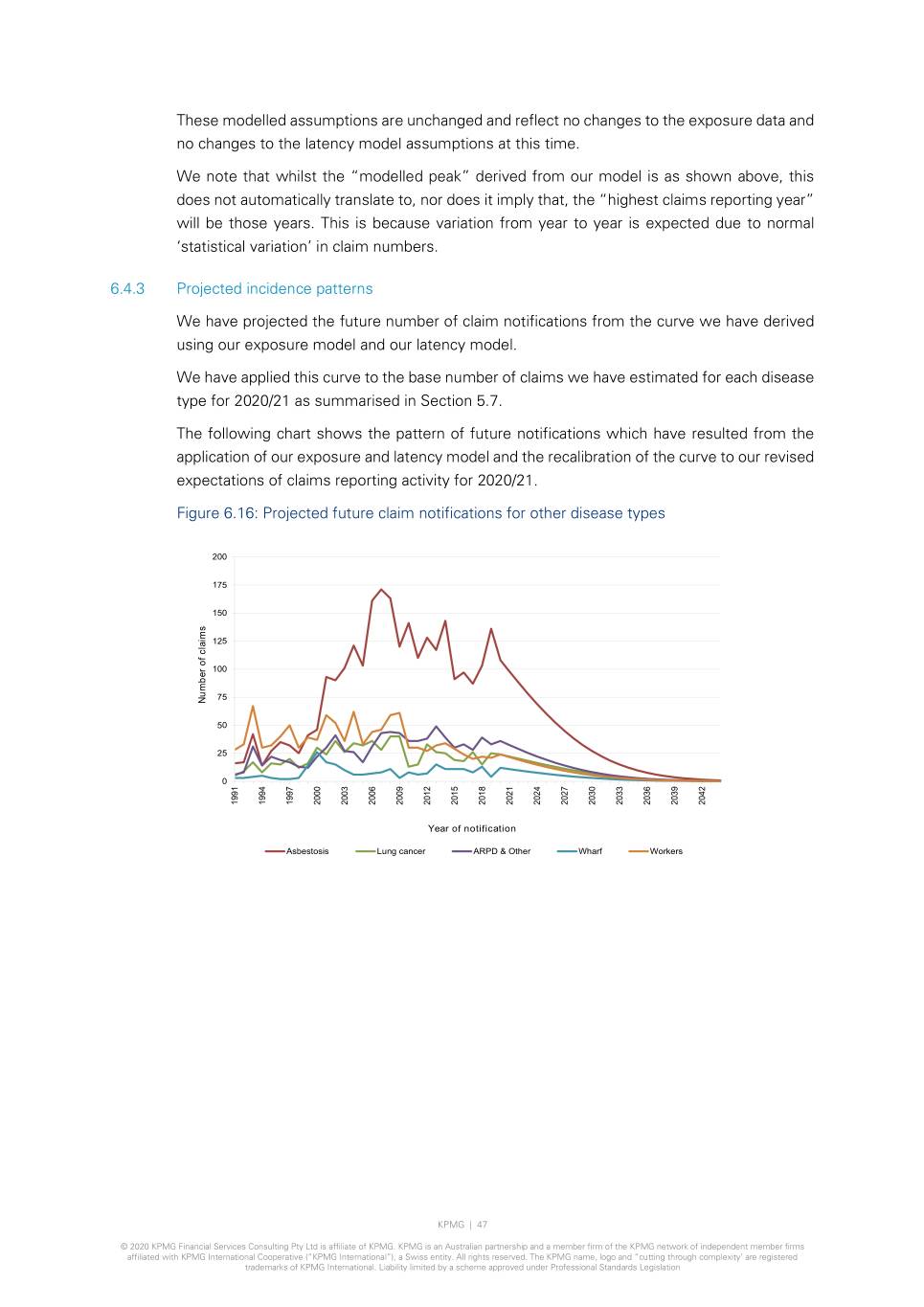
These modelled assumptions are unchanged and reflect no changes to the exposure data and no changes to the latency model assumptions at this time. We note that whilst the “modelled peak” derived from our model is as shown above, this does not automatically translate to, nor does it imply that, the “highest claims reporting year” will be those years. This is because variation from year to year is expected due to normal ‘statistical variation’ in claim numbers. 6.4.3 Projected incidence patterns We have projected the future number of claim notifications from the curve we have derived using our exposure model and our latency model. We have applied this curve to the base number of claims we have estimated for each disease type for 2020/21 as summarised in Section 5.7. The following chart shows the pattern of future notifications which have resulted from the application of our exposure and latency model and the recalibration of the curve to our revised expectations of claims reporting activity for 2020/21. Figure 6.16: Projected future claim notifications for other disease types 200 175 150 125 100 75 Number claims of Number 50 25 0 1991 1994 1997 2000 2003 2006 2009 2012 2015 2018 2021 2024 2027 2030 2033 2036 2039 2042 Year of notification Asbestosis Lung cancer ARPD & Other Wharf Workers KPMG | 47 © 2020 KPMG Financial Services Consulting Pty Ltd is affiliate of KPMG. KPMG is an Australian partnership and a member firm of the KPMG network of independent member firms affiliated with KPMG International Cooperative (“KPMG International”), a Swiss entity. All rights reserved. The KPMG name, logo and “cutting through complexity’ are registered trademarks of KPMG International. Liability limited by a scheme approved under Professional Standards Legislation
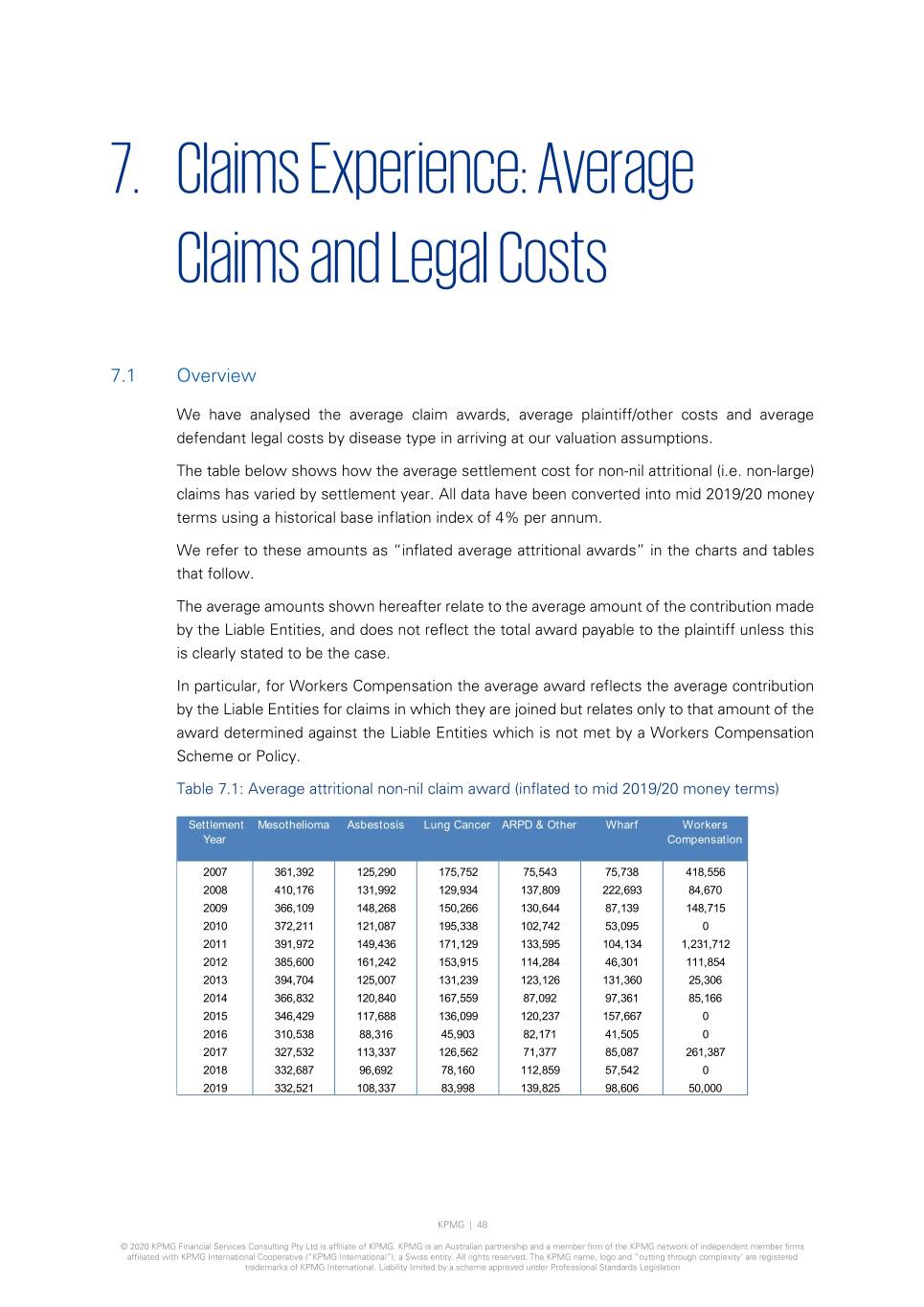
7. Claims Experience: Average Claims and Legal Costs 7.1 Overview We have analysed the average claim awards, average plaintiff/other costs and average defendant legal costs by disease type in arriving at our valuation assumptions. The table below shows how the average settlement cost for non-nil attritional (i.e. non-large) claims has varied by settlement year. All data have been converted into mid 2019/20 money terms using a historical base inflation index of 4% per annum. We refer to these amounts as “inflated average attritional awards” in the charts and tables that follow. The average amounts shown hereafter relate to the average amount of the contribution made by the Liable Entities, and does not reflect the total award payable to the plaintiff unless this is clearly stated to be the case. In particular, for Workers Compensation the average award reflects the average contribution by the Liable Entities for claims in which they are joined but relates only to that amount of the award determined against the Liable Entities which is not met by a Workers Compensation Scheme or Policy. Table 7.1: Average attritional non-nil claim award (inflated to mid 2019/20 money terms) Settlement Mesothelioma Asbestosis Lung Cancer ARPD & Other Wharf Workers Year Compensation 2007 361,392 125,290 175,752 75,543 75,738 418,556 2008 410,176 131,992 129,934 137,809 222,693 84,670 2009 366,109 148,268 150,266 130,644 87,139 148,715 2010 372,211 121,087 195,338 102,742 53,095 0 2011 391,972 149,436 171,129 133,595 104,134 1,231,712 2012 385,600 161,242 153,915 114,284 46,301 111,854 2013 394,704 125,007 131,239 123,126 131,360 25,306 2014 366,832 120,840 167,559 87,092 97,361 85,166 2015 346,429 117,688 136,099 120,237 157,667 0 2016 310,538 88,316 45,903 82,171 41,505 0 2017 327,532 113,337 126,562 71,377 85,087 261,387 2018 332,687 96,692 78,160 112,859 57,542 0 2019 332,521 108,337 83,998 139,825 98,606 50,000 KPMG | 48 © 2020 KPMG Financial Services Consulting Pty Ltd is affiliate of KPMG. KPMG is an Australian partnership and a member firm of the KPMG network of independent member firms affiliated with KPMG International Cooperative (“KPMG International”), a Swiss entity. All rights reserved. The KPMG name, logo and “cutting through complexity’ are registered trademarks of KPMG International. Liability limited by a scheme approved under Professional Standards Legislation
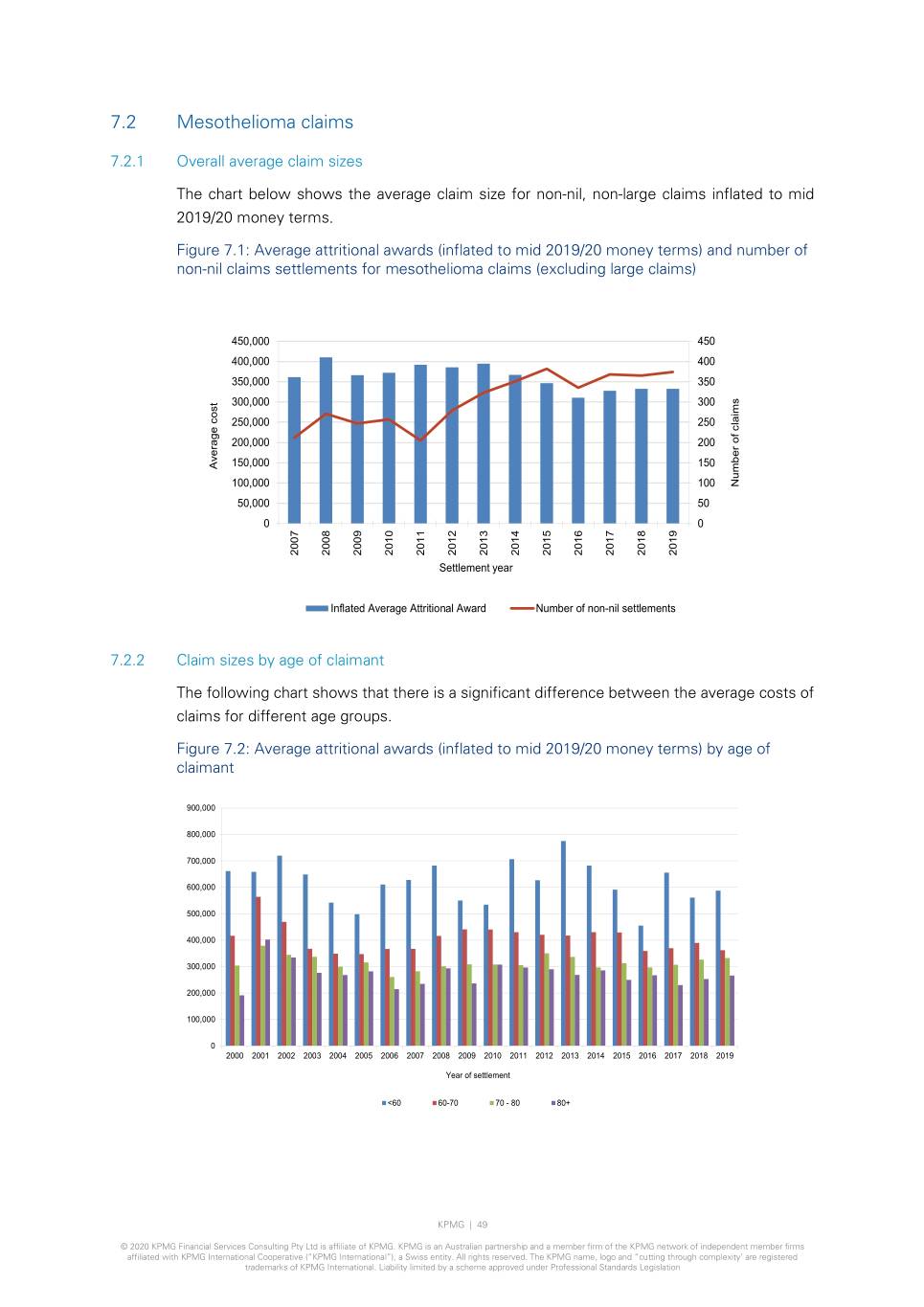
7.2 Mesothelioma claims 7.2.1 Overall average claim sizes The chart below shows the average claim size for non-nil, non-large claims inflated to mid 2019/20 money terms. Figure 7.1: Average attritional awards (inflated to mid 2019/20 money terms) and number of non-nil claims settlements for mesothelioma claims (excluding large claims) 450,000 450 400,000 400 350,000 350 300,000 300 250,000 250 200,000 200 Average cost Average 150,000 150 100,000 100 claims of Number 50,000 50 0 0 2007 2008 2009 2010 2011 2012 2013 2014 2015 2016 2017 2018 2019 Settlement year Inflated Average Attritional Award Number of non-nil settlements 7.2.2 Claim sizes by age of claimant The following chart shows that there is a significant difference between the average costs of claims for different age groups. Figure 7.2: Average attritional awards (inflated to mid 2019/20 money terms) by age of claimant 900,000 800,000 700,000 600,000 500,000 400,000 300,000 200,000 100,000 0 2000 2001 2002 2003 2004 2005 2006 2007 2008 2009 2010 2011 2012 2013 2014 2015 2016 2017 2018 2019 Year of settlement <60 60-70 70 - 80 80+ KPMG | 49 © 2020 KPMG Financial Services Consulting Pty Ltd is affiliate of KPMG. KPMG is an Australian partnership and a member firm of the KPMG network of independent member firms affiliated with KPMG International Cooperative (“KPMG International”), a Swiss entity. All rights reserved. The KPMG name, logo and “cutting through complexity’ are registered trademarks of KPMG International. Liability limited by a scheme approved under Professional Standards Legislation
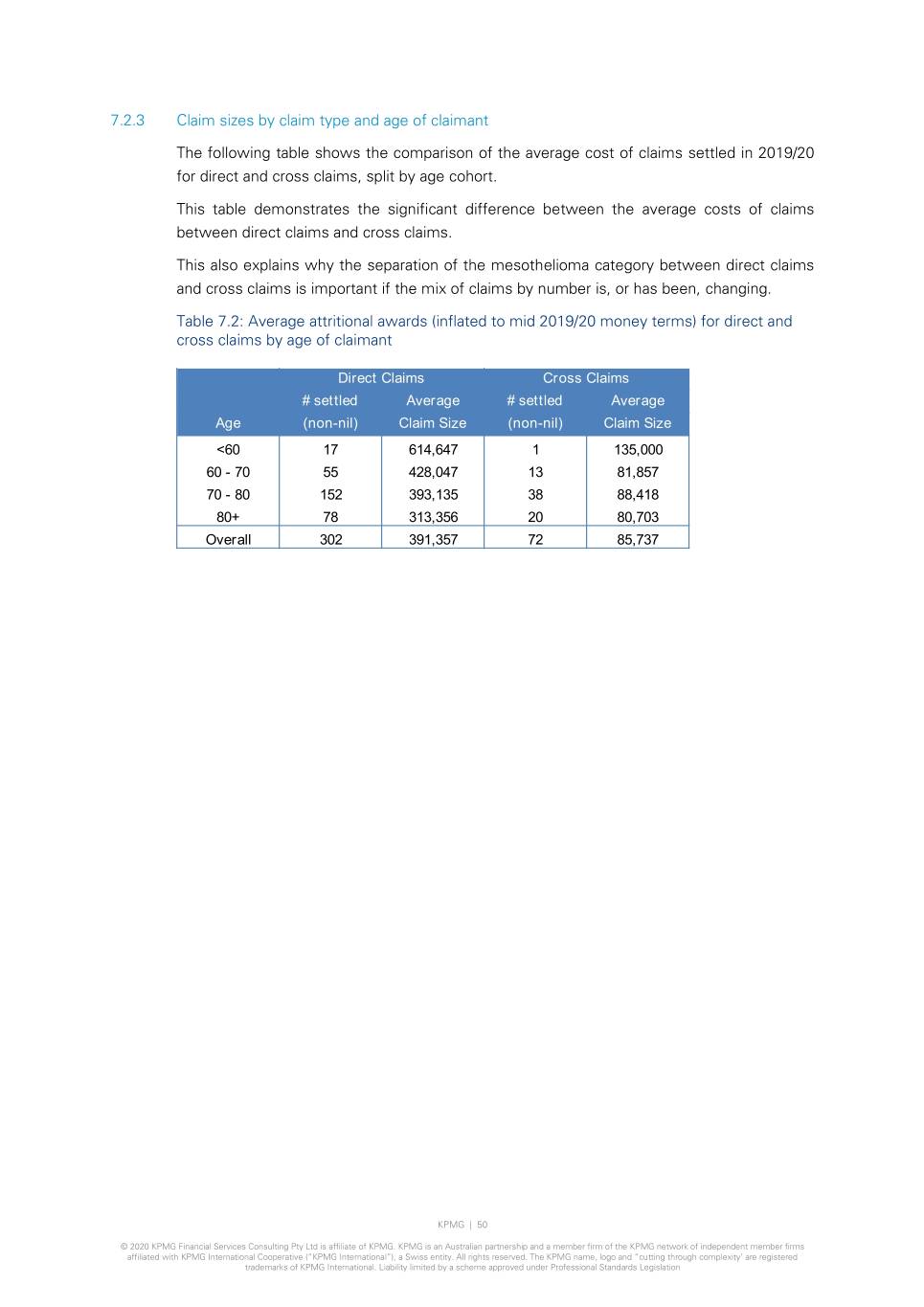
7.2.3 Claim sizes by claim type and age of claimant The following table shows the comparison of the average cost of claims settled in 2019/20 for direct and cross claims, split by age cohort. This table demonstrates the significant difference between the average costs of claims between direct claims and cross claims. This also explains why the separation of the mesothelioma category between direct claims and cross claims is important if the mix of claims by number is, or has been, changing. Table 7.2: Average attritional awards (inflated to mid 2019/20 money terms) for direct and cross claims by age of claimant Direct Claims Cross Claims # settled Average # settled Average Age (non-nil) Claim Size (non-nil) Claim Size <60 17 614,647 1 135,000 60 - 70 55 428,047 13 81,857 70 - 80 152 393,135 38 88,418 80+ 78 313,356 20 80,703 Overall 302 391,357 72 85,737 KPMG | 50 © 2020 KPMG Financial Services Consulting Pty Ltd is affiliate of KPMG. KPMG is an Australian partnership and a member firm of the KPMG network of independent member firms affiliated with KPMG International Cooperative (“KPMG International”), a Swiss entity. All rights reserved. The KPMG name, logo and “cutting through complexity’ are registered trademarks of KPMG International. Liability limited by a scheme approved under Professional Standards Legislation
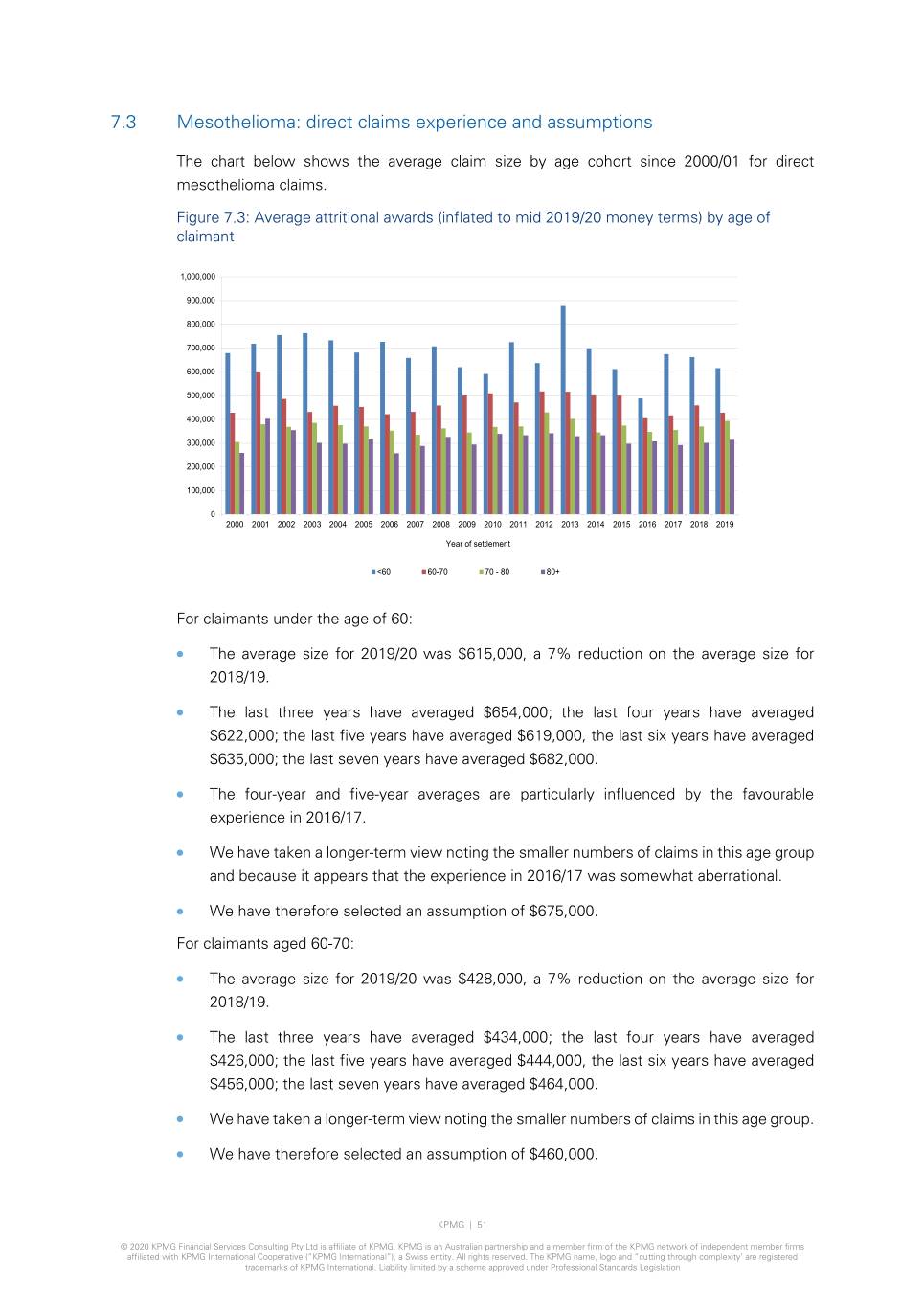
7.3 Mesothelioma: direct claims experience and assumptions The chart below shows the average claim size by age cohort since 2000/01 for direct mesothelioma claims. Figure 7.3: Average attritional awards (inflated to mid 2019/20 money terms) by age of claimant 1,000,000 900,000 800,000 700,000 600,000 500,000 400,000 300,000 200,000 100,000 0 2000 2001 2002 2003 2004 2005 2006 2007 2008 2009 2010 2011 2012 2013 2014 2015 2016 2017 2018 2019 Year of settlement <60 60-70 70 - 80 80+ For claimants under the age of 60: • The average size for 2019/20 was $615,000, a 7% reduction on the average size for 2018/19. • The last three years have averaged $654,000; the last four years have averaged $622,000; the last five years have averaged $619,000, the last six years have averaged $635,000; the last seven years have averaged $682,000. • The four-year and five-year averages are particularly influenced by the favourable experience in 2016/17. • We have taken a longer-term view noting the smaller numbers of claims in this age group and because it appears that the experience in 2016/17 was somewhat aberrational. • We have therefore selected an assumption of $675,000. For claimants aged 60-70: • The average size for 2019/20 was $428,000, a 7% reduction on the average size for 2018/19. • The last three years have averaged $434,000; the last four years have averaged $426,000; the last five years have averaged $444,000, the last six years have averaged $456,000; the last seven years have averaged $464,000. • We have taken a longer-term view noting the smaller numbers of claims in this age group. • We have therefore selected an assumption of $460,000. KPMG | 51 © 2020 KPMG Financial Services Consulting Pty Ltd is affiliate of KPMG. KPMG is an Australian partnership and a member firm of the KPMG network of independent member firms affiliated with KPMG International Cooperative (“KPMG International”), a Swiss entity. All rights reserved. The KPMG name, logo and “cutting through complexity’ are registered trademarks of KPMG International. Liability limited by a scheme approved under Professional Standards Legislation

For claimants aged 70-80: • The average size for 2019/20 was $393,000, a 6% increase on the average size for 2018/19. • The last three years have averaged $374,000; the last four years have averaged $367,000; the last five years have averaged $369,000, the last six years have averaged $365,000; the last seven years have averaged $369,000. • This segment is the largest segment by both number of claims and total expenditure. • We have therefore selected an assumption of $375,000. • We observe that five out of the last six years have seen an average size of $375,000 or less. The experience for the 2019/20 year was particularly influenced by a higher number of claims in excess of $700,000. For claimants aged 80+: • The average size for 2019/20 was $313,000, a 4% increase on the average size for 2018/19. • The last three years have averaged $302,000; the last four years have averaged $303,000; the last five years have averaged $302,000, the last six years have averaged $305,000; the last seven years have averaged $308,000. • We have therefore selected an assumption of $310,000. KPMG | 52 © 2020 KPMG Financial Services Consulting Pty Ltd is affiliate of KPMG. KPMG is an Australian partnership and a member firm of the KPMG network of independent member firms affiliated with KPMG International Cooperative (“KPMG International”), a Swiss entity. All rights reserved. The KPMG name, logo and “cutting through complexity’ are registered trademarks of KPMG International. Liability limited by a scheme approved under Professional Standards Legislation
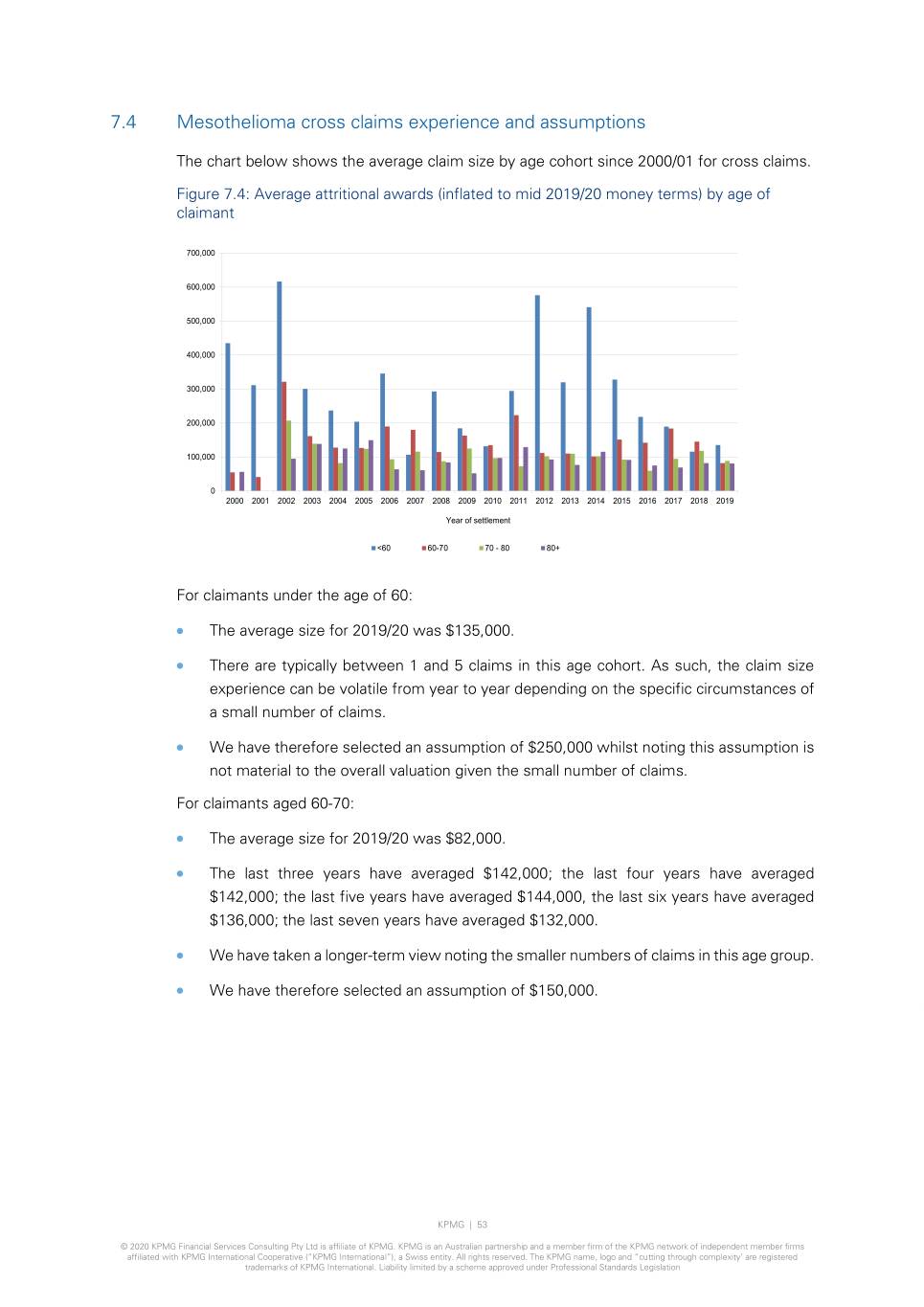
7.4 Mesothelioma cross claims experience and assumptions The chart below shows the average claim size by age cohort since 2000/01 for cross claims. Figure 7.4: Average attritional awards (inflated to mid 2019/20 money terms) by age of claimant 700,000 600,000 500,000 400,000 300,000 200,000 100,000 0 2000 2001 2002 2003 2004 2005 2006 2007 2008 2009 2010 2011 2012 2013 2014 2015 2016 2017 2018 2019 Year of settlement <60 60-70 70 - 80 80+ For claimants under the age of 60: • The average size for 2019/20 was $135,000. • There are typically between 1 and 5 claims in this age cohort. As such, the claim size experience can be volatile from year to year depending on the specific circumstances of a small number of claims. • We have therefore selected an assumption of $250,000 whilst noting this assumption is not material to the overall valuation given the small number of claims. For claimants aged 60-70: • The average size for 2019/20 was $82,000. • The last three years have averaged $142,000; the last four years have averaged $142,000; the last five years have averaged $144,000, the last six years have averaged $136,000; the last seven years have averaged $132,000. • We have taken a longer-term view noting the smaller numbers of claims in this age group. • We have therefore selected an assumption of $150,000. KPMG | 53 © 2020 KPMG Financial Services Consulting Pty Ltd is affiliate of KPMG. KPMG is an Australian partnership and a member firm of the KPMG network of independent member firms affiliated with KPMG International Cooperative (“KPMG International”), a Swiss entity. All rights reserved. The KPMG name, logo and “cutting through complexity’ are registered trademarks of KPMG International. Liability limited by a scheme approved under Professional Standards Legislation
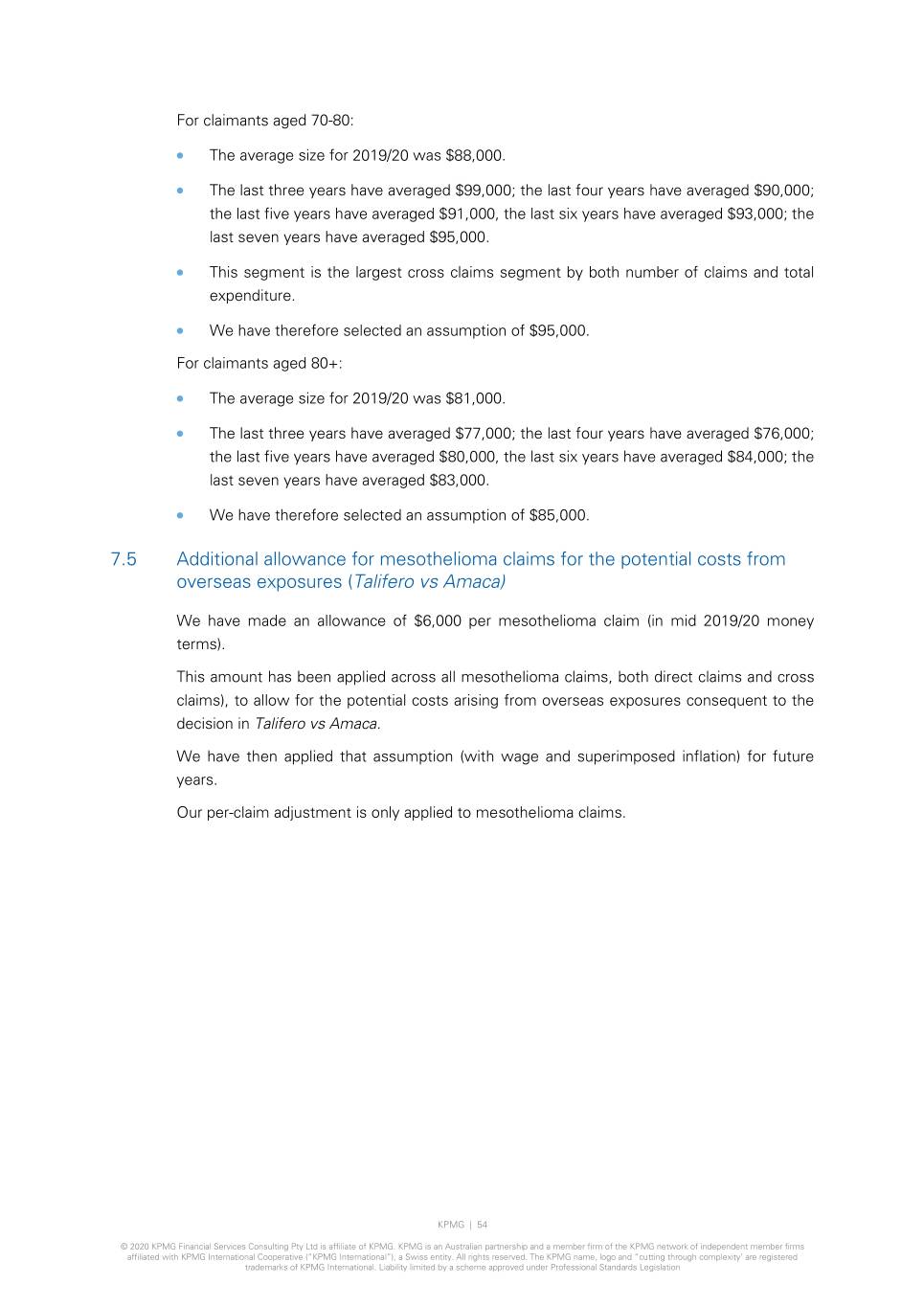
For claimants aged 70-80: • The average size for 2019/20 was $88,000. • The last three years have averaged $99,000; the last four years have averaged $90,000; the last five years have averaged $91,000, the last six years have averaged $93,000; the last seven years have averaged $95,000. • This segment is the largest cross claims segment by both number of claims and total expenditure. • We have therefore selected an assumption of $95,000. For claimants aged 80+: • The average size for 2019/20 was $81,000. • The last three years have averaged $77,000; the last four years have averaged $76,000; the last five years have averaged $80,000, the last six years have averaged $84,000; the last seven years have averaged $83,000. • We have therefore selected an assumption of $85,000. 7.5 Additional allowance for mesothelioma claims for the potential costs from overseas exposures (Talifero vs Amaca) We have made an allowance of $6,000 per mesothelioma claim (in mid 2019/20 money terms). This amount has been applied across all mesothelioma claims, both direct claims and cross claims), to allow for the potential costs arising from overseas exposures consequent to the decision in Talifero vs Amaca. We have then applied that assumption (with wage and superimposed inflation) for future years. Our per-claim adjustment is only applied to mesothelioma claims. KPMG | 54 © 2020 KPMG Financial Services Consulting Pty Ltd is affiliate of KPMG. KPMG is an Australian partnership and a member firm of the KPMG network of independent member firms affiliated with KPMG International Cooperative (“KPMG International”), a Swiss entity. All rights reserved. The KPMG name, logo and “cutting through complexity’ are registered trademarks of KPMG International. Liability limited by a scheme approved under Professional Standards Legislation
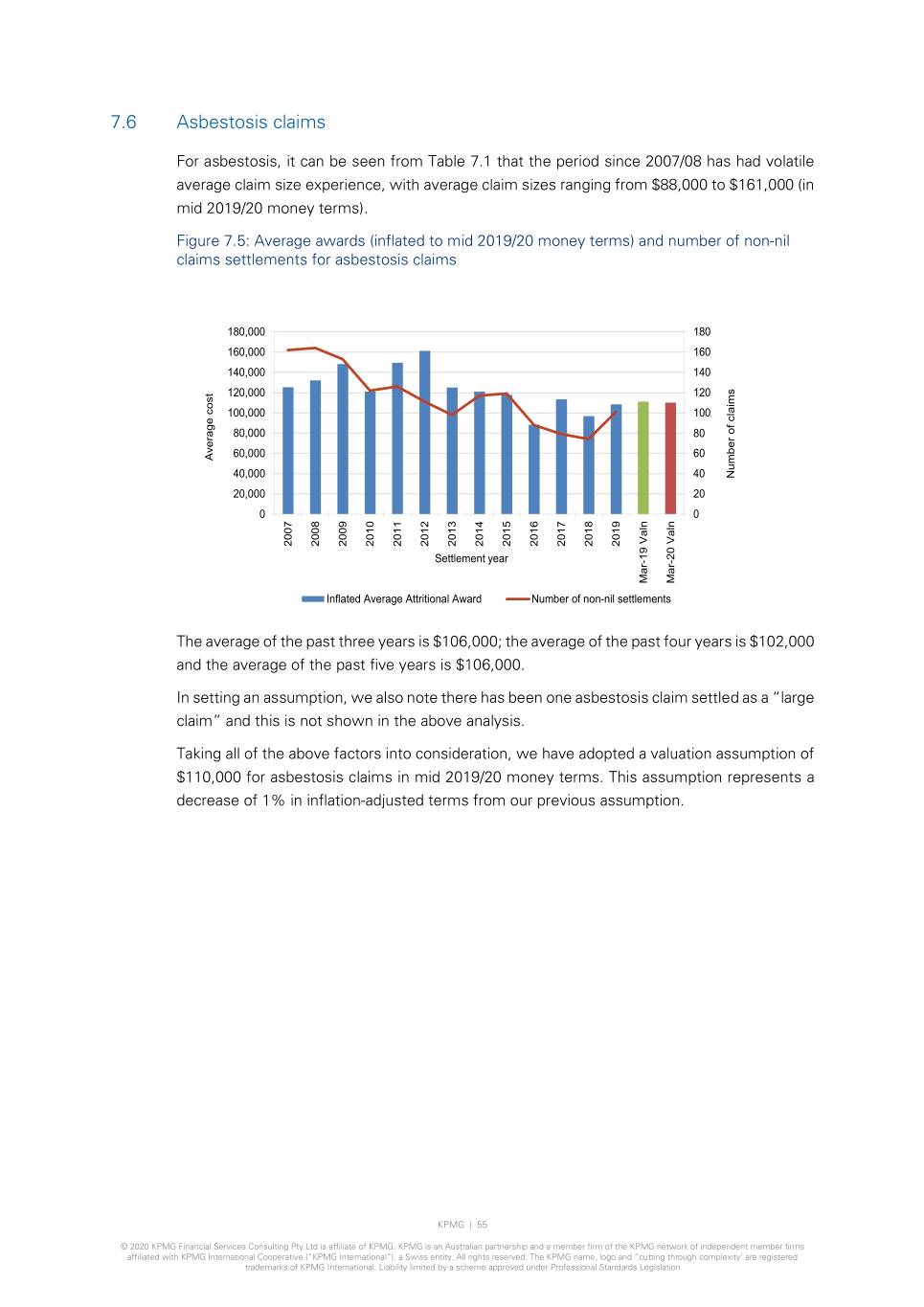
7.6 Asbestosis claims For asbestosis, it can be seen from Table 7.1 that the period since 2007/08 has had volatile average claim size experience, with average claim sizes ranging from $88,000 to $161,000 (in mid 2019/20 money terms). Figure 7.5: Average awards (inflated to mid 2019/20 money terms) and number of non-nil claims settlements for asbestosis claims 180,000 180 160,000 160 140,000 140 120,000 120 100,000 100 80,000 80 Average cost Average 60,000 60 40,000 40 claims of Number 20,000 20 0 0 2007 2008 2009 2010 2011 2012 2013 2014 2015 2016 2017 2018 2019 Settlement year Mar-19 Valn Mar-19 Valn Mar-20 Inflated Average Attritional Award Number of non-nil settlements The average of the past three years is $106,000; the average of the past four years is $102,000 and the average of the past five years is $106,000. In setting an assumption, we also note there has been one asbestosis claim settled as a “large claim” and this is not shown in the above analysis. Taking all of the above factors into consideration, we have adopted a valuation assumption of $110,000 for asbestosis claims in mid 2019/20 money terms. This assumption represents a decrease of 1% in inflation-adjusted terms from our previous assumption. KPMG | 55 © 2020 KPMG Financial Services Consulting Pty Ltd is affiliate of KPMG. KPMG is an Australian partnership and a member firm of the KPMG network of independent member firms affiliated with KPMG International Cooperative (“KPMG International”), a Swiss entity. All rights reserved. The KPMG name, logo and “cutting through complexity’ are registered trademarks of KPMG International. Liability limited by a scheme approved under Professional Standards Legislation

7.7 Lung cancer claims The average award for lung cancer claims has exhibited some volatility in the past five years, although this is not unexpected given the small volume of claim settlements (approximately 10 to 30 claims per annum). Figure 7.6: Average awards (inflated to mid 2019/20 money terms) and number of non-nil claims settlements for lung cancer claims 240,000 40 200,000 32 160,000 24 120,000 16 80,000 Average cost Average 8 claims of Number 40,000 0 0 2007 2008 2009 2010 2011 2012 2013 2014 2015 2016 2017 2018 2019 Settlement year Mar-19 Valn Mar-19 Valn Mar-20 Inflated Average Attritional Award Number of non-nil settlements The average of the past three years is $87,000; the average of the past four years is $80,000 and the average of the past five years is $92,000. Taking all of the above factors into consideration, and noting the volatility arising from the small number of non-nil claims, we have adopted a valuation assumption of $110,000. This assumption represents a decrease of 10% in inflation-adjusted terms from our previous assumption. KPMG | 56 © 2020 KPMG Financial Services Consulting Pty Ltd is affiliate of KPMG. KPMG is an Australian partnership and a member firm of the KPMG network of independent member firms affiliated with KPMG International Cooperative (“KPMG International”), a Swiss entity. All rights reserved. The KPMG name, logo and “cutting through complexity’ are registered trademarks of KPMG International. Liability limited by a scheme approved under Professional Standards Legislation
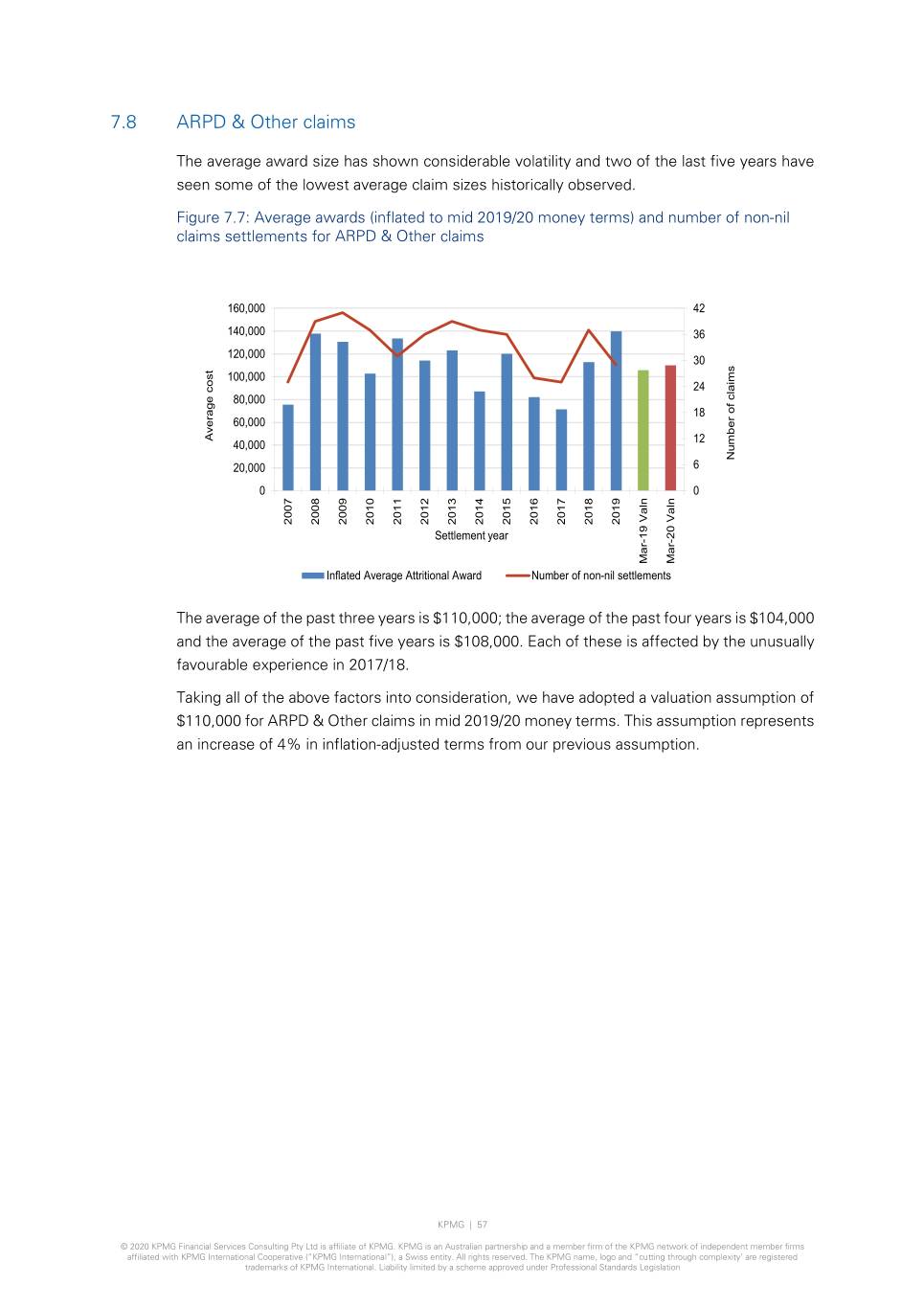
7.8 ARPD & Other claims The average award size has shown considerable volatility and two of the last five years have seen some of the lowest average claim sizes historically observed. Figure 7.7: Average awards (inflated to mid 2019/20 money terms) and number of non-nil claims settlements for ARPD & Other claims 160,000 42 140,000 36 120,000 30 100,000 24 80,000 18 60,000 Average cost Average 12 40,000 Number of claims of Number 20,000 6 0 0 2007 2008 2009 2010 2011 2012 2013 2014 2015 2016 2017 2018 2019 Settlement year Mar-19 Valn Mar-19 Valn Mar-20 Inflated Average Attritional Award Number of non-nil settlements The average of the past three years is $110,000; the average of the past four years is $104,000 and the average of the past five years is $108,000. Each of these is affected by the unusually favourable experience in 2017/18. Taking all of the above factors into consideration, we have adopted a valuation assumption of $110,000 for ARPD & Other claims in mid 2019/20 money terms. This assumption represents an increase of 4% in inflation-adjusted terms from our previous assumption. KPMG | 57 © 2020 KPMG Financial Services Consulting Pty Ltd is affiliate of KPMG. KPMG is an Australian partnership and a member firm of the KPMG network of independent member firms affiliated with KPMG International Cooperative (“KPMG International”), a Swiss entity. All rights reserved. The KPMG name, logo and “cutting through complexity’ are registered trademarks of KPMG International. Liability limited by a scheme approved under Professional Standards Legislation

7.9 Workers Compensation claims The average award for non-nil Workers Compensation claims has shown a large degree of volatility, reflecting the small number of non-nil claims. Figure 7.8: Average awards (inflated to mid 2019/20 money terms) and number of non-nil claims settlements for Workers Compensation claims 400,000 8 350,000 7 300,000 6 250,000 5 200,000 4 150,000 3 Average cost Average 100,000 2 Number of claims of Number 50,000 1 0 0 2007 2008 2009 2010 2011 2012 2013 2014 2015 2016 2017 2018 2019 Settlement year Mar-19 Valn Mar-19 Valn Mar-20 Inflated Average Attritional Award Number of non-nil settlements It should be noted that the high average claim size in 2011/12 is due to one claim of $900,000 (in 2011/12 values). Furthermore, we understand that this claim payment was recovered from the workers compensation insurer at a later date. Taking all of the above factors into consideration, we have adopted a valuation assumption of $150,000. This assumption represents a decrease of 2% in inflation-adjusted terms from our previous assumption. This assumption is not material to the overall liability given the high proportion of claims (in excess of 90%) which are settled with no retained liability against the Liable Entities. KPMG | 58 © 2020 KPMG Financial Services Consulting Pty Ltd is affiliate of KPMG. KPMG is an Australian partnership and a member firm of the KPMG network of independent member firms affiliated with KPMG International Cooperative (“KPMG International”), a Swiss entity. All rights reserved. The KPMG name, logo and “cutting through complexity’ are registered trademarks of KPMG International. Liability limited by a scheme approved under Professional Standards Legislation
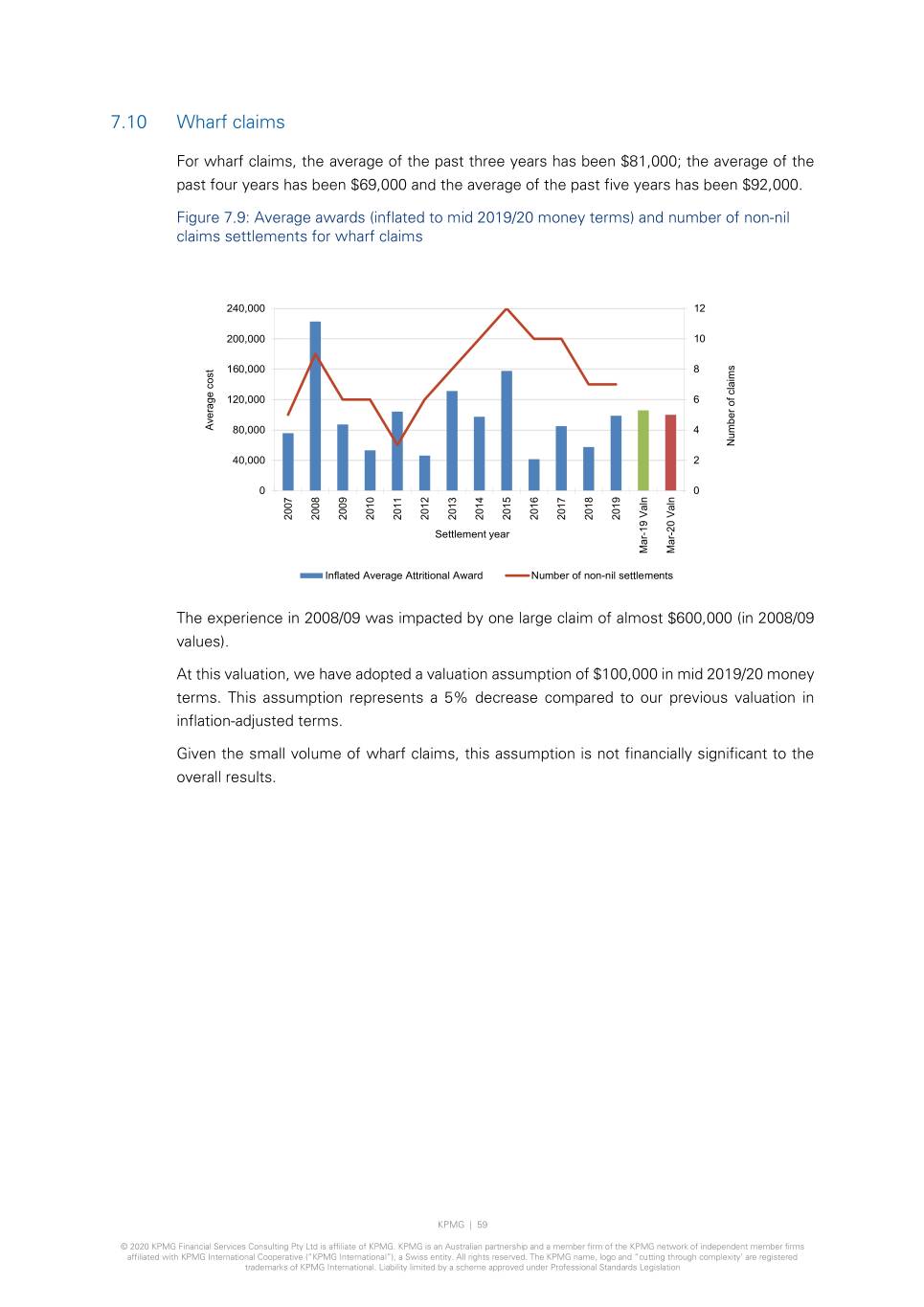
7.10 Wharf claims For wharf claims, the average of the past three years has been $81,000; the average of the past four years has been $69,000 and the average of the past five years has been $92,000. Figure 7.9: Average awards (inflated to mid 2019/20 money terms) and number of non-nil claims settlements for wharf claims 240,000 12 200,000 10 160,000 8 120,000 6 Average cost Average 80,000 4 Number of claims of Number 40,000 2 0 0 2007 2008 2009 2010 2011 2012 2013 2014 2015 2016 2017 2018 2019 Settlement year Mar-19 Valn Mar-19 Valn Mar-20 Inflated Average Attritional Award Number of non-nil settlements The experience in 2008/09 was impacted by one large claim of almost $600,000 (in 2008/09 values). At this valuation, we have adopted a valuation assumption of $100,000 in mid 2019/20 money terms. This assumption represents a 5% decrease compared to our previous valuation in inflation-adjusted terms. Given the small volume of wharf claims, this assumption is not financially significant to the overall results. KPMG | 59 © 2020 KPMG Financial Services Consulting Pty Ltd is affiliate of KPMG. KPMG is an Australian partnership and a member firm of the KPMG network of independent member firms affiliated with KPMG International Cooperative (“KPMG International”), a Swiss entity. All rights reserved. The KPMG name, logo and “cutting through complexity’ are registered trademarks of KPMG International. Liability limited by a scheme approved under Professional Standards Legislation
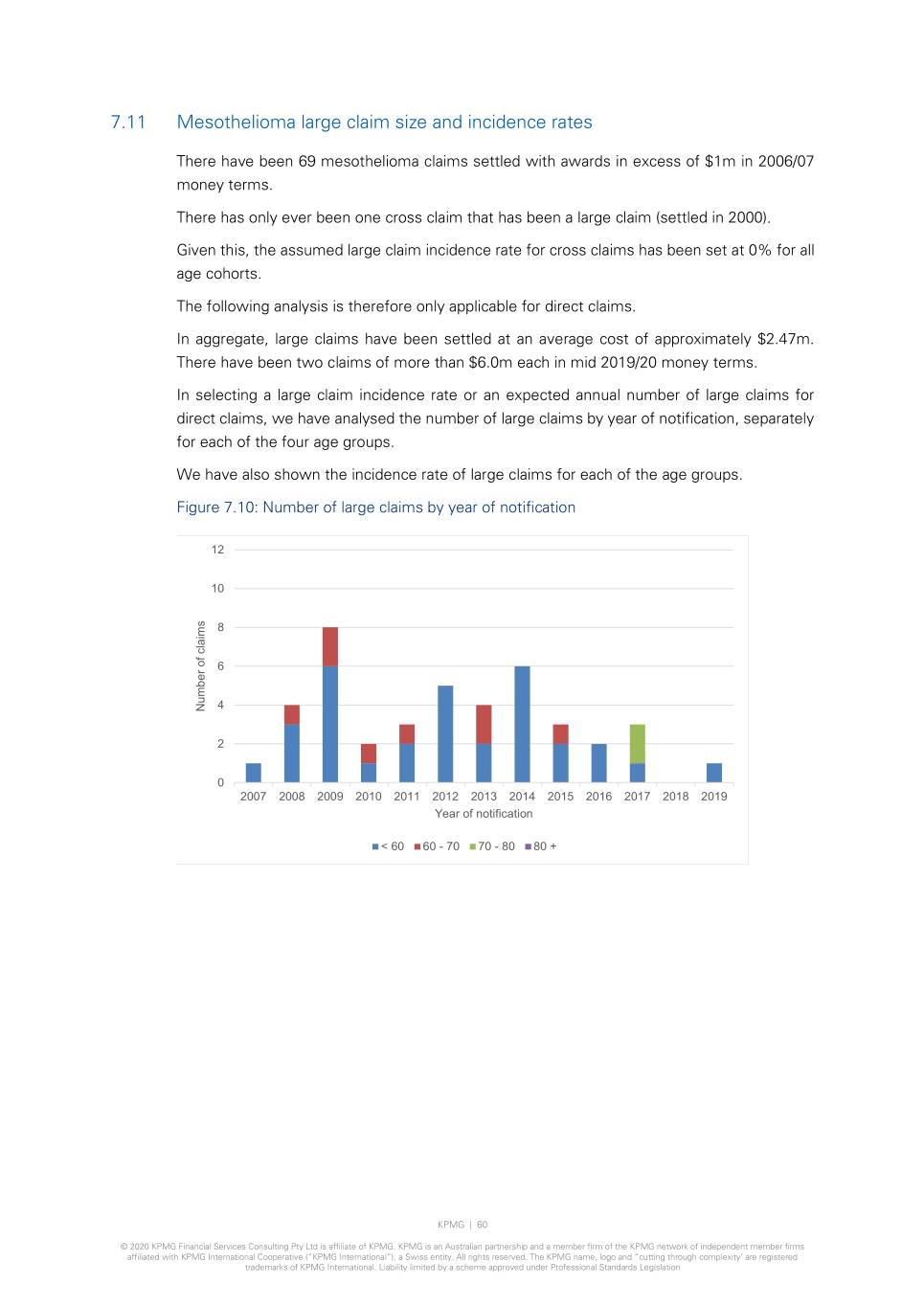
7.11 Mesothelioma large claim size and incidence rates There have been 69 mesothelioma claims settled with awards in excess of $1m in 2006/07 money terms. There has only ever been one cross claim that has been a large claim (settled in 2000). Given this, the assumed large claim incidence rate for cross claims has been set at 0% for all age cohorts. The following analysis is therefore only applicable for direct claims. In aggregate, large claims have been settled at an average cost of approximately $2.47m. There have been two claims of more than $6.0m each in mid 2019/20 money terms. In selecting a large claim incidence rate or an expected annual number of large claims for direct claims, we have analysed the number of large claims by year of notification, separately for each of the four age groups. We have also shown the incidence rate of large claims for each of the age groups. Figure 7.10: Number of large claims by year of notification 12 10 8 6 Number of claims of Number 4 2 0 2007 2008 2009 2010 2011 2012 2013 2014 2015 2016 2017 2018 2019 Year of notification < 60 60 - 70 70 - 80 80 + KPMG | 60 © 2020 KPMG Financial Services Consulting Pty Ltd is affiliate of KPMG. KPMG is an Australian partnership and a member firm of the KPMG network of independent member firms affiliated with KPMG International Cooperative (“KPMG International”), a Swiss entity. All rights reserved. The KPMG name, logo and “cutting through complexity’ are registered trademarks of KPMG International. Liability limited by a scheme approved under Professional Standards Legislation

Figure 7.11: Large claims incidence rate by age of claimant 25.0% 20.0% 15.0% 10.0% Incidence Rate 5.0% 0.0% 2007 2008 2009 2010 2011 2012 2013 2014 2015 2016 2017 2018 2019 2007-2019 < 60 60 - 70 70 - 80 There have been no large claims for claimants over the age of 80. We have assumed a future large claim incidence rate of 10.00% for claimants under 60 years of age, 1.00% for claimants between 60 and 70 years of age, and 0.10% for claimants between 70 and 80 years of age. For the average large claim size, we have adopted a valuation assumption of $2.45m in mid 2019/20 money terms and we have adopted the same average claim size for all age groups. This is based on analysis that shows minimal variation in average claim size for large claims between claimants in each of the age cohorts We have made an additional allowance for plaintiff legal costs to allow for those instances where such costs are made additional to, rather than included with, the claims award and also for defence costs. The actual incidence of, and settlement of, large claims is not readily predictable and therefore deviations will occur from year to year due to random fluctuations because of the small numbers of large claims (between 1 and 8 large claims per annum). KPMG | 61 © 2020 KPMG Financial Services Consulting Pty Ltd is affiliate of KPMG. KPMG is an Australian partnership and a member firm of the KPMG network of independent member firms affiliated with KPMG International Cooperative (“KPMG International”), a Swiss entity. All rights reserved. The KPMG name, logo and “cutting through complexity’ are registered trademarks of KPMG International. Liability limited by a scheme approved under Professional Standards Legislation
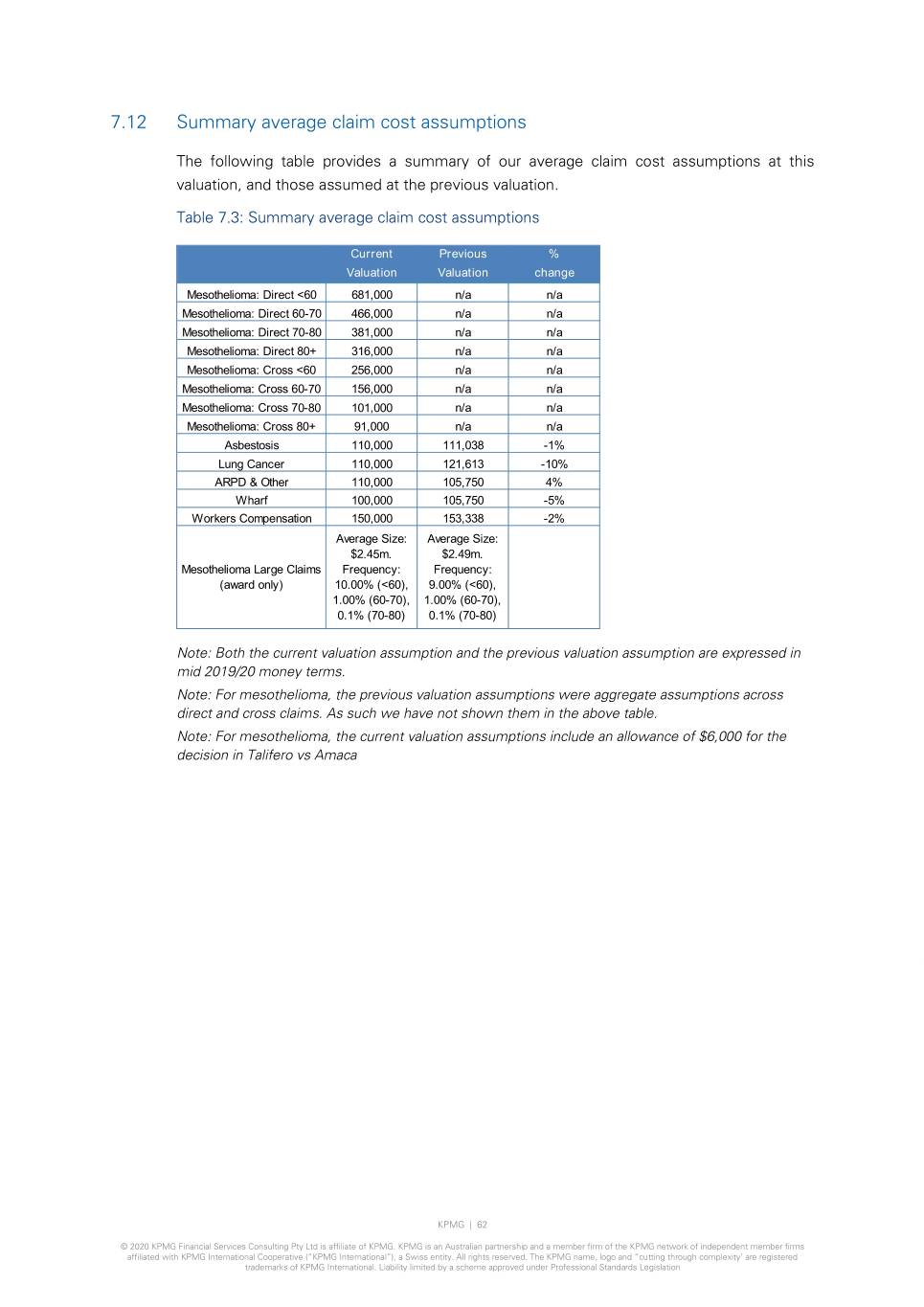
7.12 Summary average claim cost assumptions The following table provides a summary of our average claim cost assumptions at this valuation, and those assumed at the previous valuation. Table 7.3: Summary average claim cost assumptions Current Previous % Valuation Valuation change Mesothelioma: Direct <60 681,000 n/a n/a Mesothelioma: Direct 60-70 466,000 n/a n/a Mesothelioma: Direct 70-80 381,000 n/a n/a Mesothelioma: Direct 80+ 316,000 n/a n/a Mesothelioma: Cross <60 256,000 n/a n/a Mesothelioma: Cross 60-70 156,000 n/a n/a Mesothelioma: Cross 70-80 101,000 n/a n/a Mesothelioma: Cross 80+ 91,000 n/a n/a Asbestosis 110,000 111,038 -1% Lung Cancer 110,000 121,613 -10% ARPD & Other 110,000 105,750 4% Wharf 100,000 105,750 -5% Workers Compensation 150,000 153,338 -2% Average Size: Average Size: $2.45m. $2.49m. Mesothelioma Large Claims Frequency: Frequency: (award only) 10.00% (<60), 9.00% (<60), 1.00% (60-70), 1.00% (60-70), 0.1% (70-80) 0.1% (70-80) Note: Both the current valuation assumption and the previous valuation assumption are expressed in mid 2019/20 money terms. Note: For mesothelioma, the previous valuation assumptions were aggregate assumptions across direct and cross claims. As such we have not shown them in the above table. Note: For mesothelioma, the current valuation assumptions include an allowance of $6,000 for the decision in Talifero vs Amaca KPMG | 62 © 2020 KPMG Financial Services Consulting Pty Ltd is affiliate of KPMG. KPMG is an Australian partnership and a member firm of the KPMG network of independent member firms affiliated with KPMG International Cooperative (“KPMG International”), a Swiss entity. All rights reserved. The KPMG name, logo and “cutting through complexity’ are registered trademarks of KPMG International. Liability limited by a scheme approved under Professional Standards Legislation
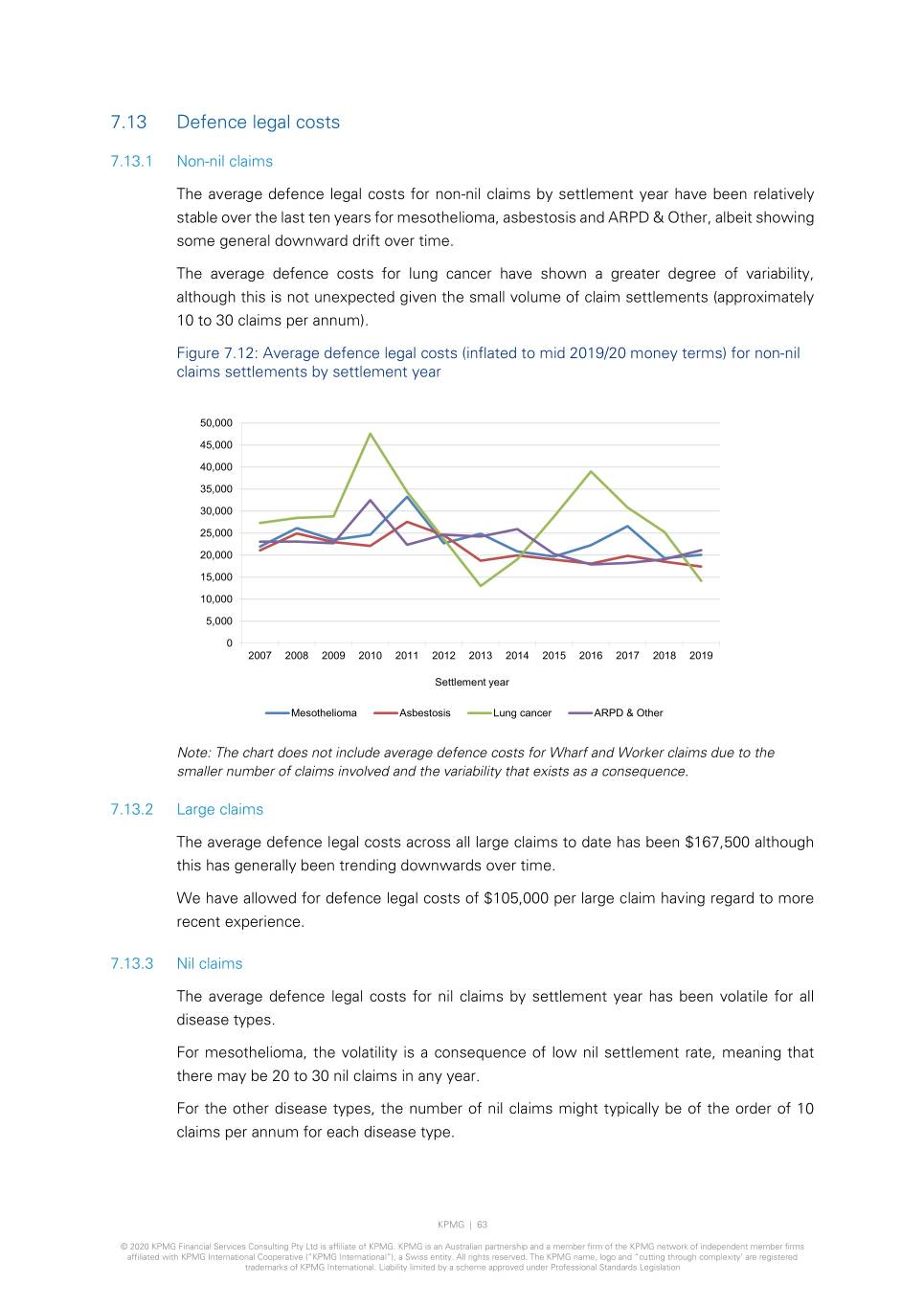
7.13 Defence legal costs 7.13.1 Non-nil claims The average defence legal costs for non-nil claims by settlement year have been relatively stable over the last ten years for mesothelioma, asbestosis and ARPD & Other, albeit showing some general downward drift over time. The average defence costs for lung cancer have shown a greater degree of variability, although this is not unexpected given the small volume of claim settlements (approximately 10 to 30 claims per annum). Figure 7.12: Average defence legal costs (inflated to mid 2019/20 money terms) for non-nil claims settlements by settlement year 50,000 45,000 40,000 35,000 30,000 25,000 20,000 15,000 10,000 5,000 0 2007 2008 2009 2010 2011 2012 2013 2014 2015 2016 2017 2018 2019 Settlement year Mesothelioma Asbestosis Lung cancer ARPD & Other Note: The chart does not include average defence costs for Wharf and Worker claims due to the smaller number of claims involved and the variability that exists as a consequence. 7.13.2 Large claims The average defence legal costs across all large claims to date has been $167,500 although this has generally been trending downwards over time. We have allowed for defence legal costs of $105,000 per large claim having regard to more recent experience. 7.13.3 Nil claims The average defence legal costs for nil claims by settlement year has been volatile for all disease types. For mesothelioma, the volatility is a consequence of low nil settlement rate, meaning that there may be 20 to 30 nil claims in any year. For the other disease types, the number of nil claims might typically be of the order of 10 claims per annum for each disease type. KPMG | 63 © 2020 KPMG Financial Services Consulting Pty Ltd is affiliate of KPMG. KPMG is an Australian partnership and a member firm of the KPMG network of independent member firms affiliated with KPMG International Cooperative (“KPMG International”), a Swiss entity. All rights reserved. The KPMG name, logo and “cutting through complexity’ are registered trademarks of KPMG International. Liability limited by a scheme approved under Professional Standards Legislation
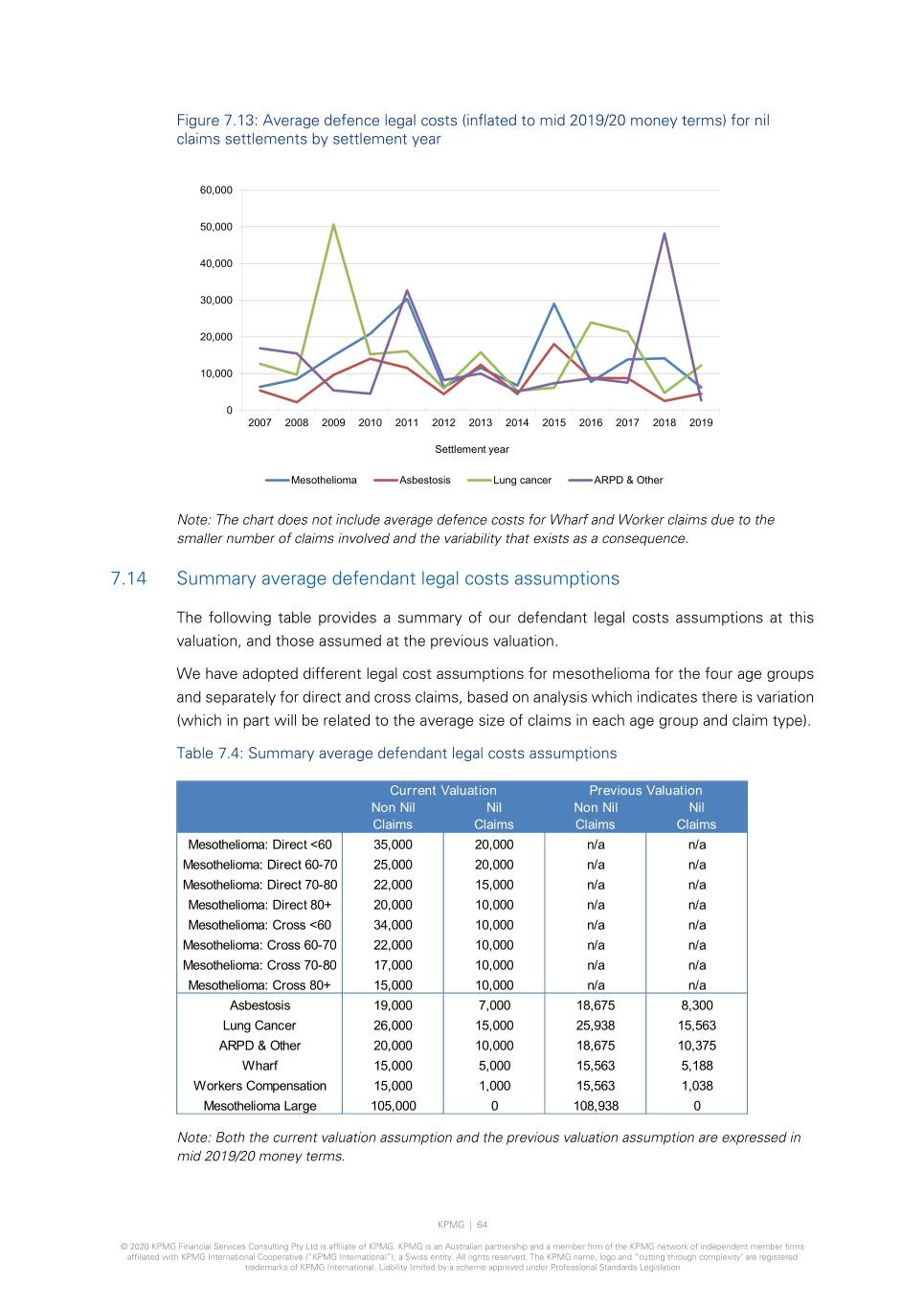
Figure 7.13: Average defence legal costs (inflated to mid 2019/20 money terms) for nil claims settlements by settlement year 60,000 50,000 40,000 30,000 20,000 10,000 0 2007 2008 2009 2010 2011 2012 2013 2014 2015 2016 2017 2018 2019 Settlement year Mesothelioma Asbestosis Lung cancer ARPD & Other Note: The chart does not include average defence costs for Wharf and Worker claims due to the smaller number of claims involved and the variability that exists as a consequence. 7.14 Summary average defendant legal costs assumptions The following table provides a summary of our defendant legal costs assumptions at this valuation, and those assumed at the previous valuation. We have adopted different legal cost assumptions for mesothelioma for the four age groups and separately for direct and cross claims, based on analysis which indicates there is variation (which in part will be related to the average size of claims in each age group and claim type). Table 7.4: Summary average defendant legal costs assumptions Current Valuation Previous Valuation Non Nil Nil Non Nil Nil Claims Claims Claims Claims Mesothelioma: Direct <60 35,000 20,000 n/a n/a Mesothelioma: Direct 60-70 25,000 20,000 n/a n/a Mesothelioma: Direct 70-80 22,000 15,000 n/a n/a Mesothelioma: Direct 80+ 20,000 10,000 n/a n/a Mesothelioma: Cross <60 34,000 10,000 n/a n/a Mesothelioma: Cross 60-70 22,000 10,000 n/a n/a Mesothelioma: Cross 70-80 17,000 10,000 n/a n/a Mesothelioma: Cross 80+ 15,000 10,000 n/a n/a Asbestosis 19,000 7,000 18,675 8,300 Lung Cancer 26,000 15,000 25,938 15,563 ARPD & Other 20,000 10,000 18,675 10,375 Wharf 15,000 5,000 15,563 5,188 Workers Compensation 15,000 1,000 15,563 1,038 Mesothelioma Large 105,000 0 108,938 0 Note: Both the current valuation assumption and the previous valuation assumption are expressed in mid 2019/20 money terms. KPMG | 64 © 2020 KPMG Financial Services Consulting Pty Ltd is affiliate of KPMG. KPMG is an Australian partnership and a member firm of the KPMG network of independent member firms affiliated with KPMG International Cooperative (“KPMG International”), a Swiss entity. All rights reserved. The KPMG name, logo and “cutting through complexity’ are registered trademarks of KPMG International. Liability limited by a scheme approved under Professional Standards Legislation
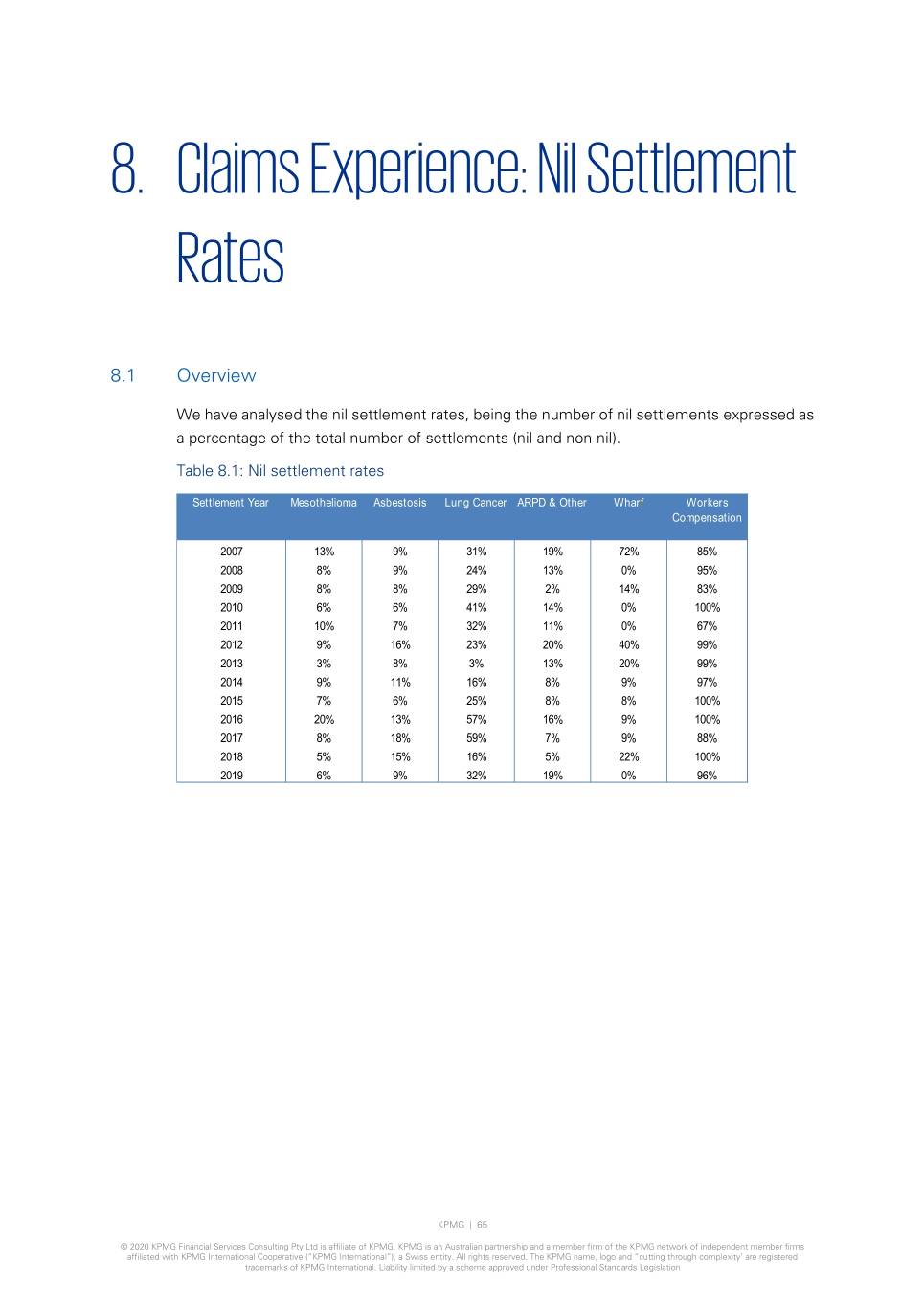
8. Claims Experience: Nil Settlement Rates 8.1 Overview We have analysed the nil settlement rates, being the number of nil settlements expressed as a percentage of the total number of settlements (nil and non-nil). Table 8.1: Nil settlement rates Settlement Year Mesothelioma Asbestosis Lung Cancer ARPD & Other Wharf Workers Compensation 2007 13% 9% 31% 19% 72% 85% 2008 8% 9% 24% 13% 0% 95% 2009 8% 8% 29% 2% 14% 83% 2010 6% 6% 41% 14% 0% 100% 2011 10% 7% 32% 11% 0% 67% 2012 9% 16% 23% 20% 40% 99% 2013 3% 8% 3% 13% 20% 99% 2014 9% 11% 16% 8% 9% 97% 2015 7% 6% 25% 8% 8% 100% 2016 20% 13% 57% 16% 9% 100% 2017 8% 18% 59% 7% 9% 88% 2018 5% 15% 16% 5% 22% 100% 2019 6% 9% 32% 19% 0% 96% KPMG | 65 © 2020 KPMG Financial Services Consulting Pty Ltd is affiliate of KPMG. KPMG is an Australian partnership and a member firm of the KPMG network of independent member firms affiliated with KPMG International Cooperative (“KPMG International”), a Swiss entity. All rights reserved. The KPMG name, logo and “cutting through complexity’ are registered trademarks of KPMG International. Liability limited by a scheme approved under Professional Standards Legislation
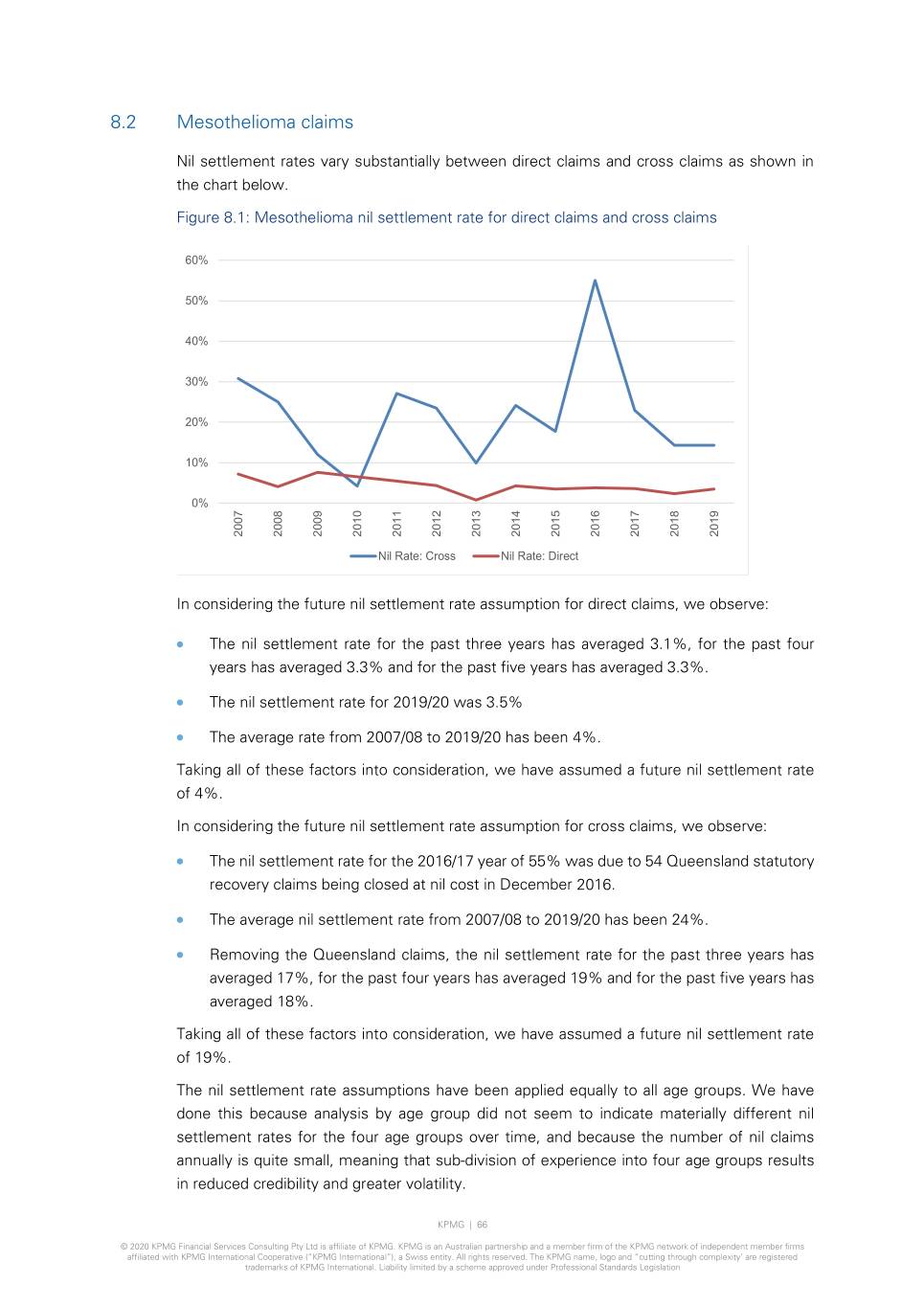
8.2 Mesothelioma claims Nil settlement rates vary substantially between direct claims and cross claims as shown in the chart below. Figure 8.1: Mesothelioma nil settlement rate for direct claims and cross claims 60% 50% 40% 30% 20% 10% 0% 2007 2008 2009 2010 2011 2012 2013 2014 2015 2016 2017 2018 2019 Nil Rate: Cross Nil Rate: Direct In considering the future nil settlement rate assumption for direct claims, we observe: • The nil settlement rate for the past three years has averaged 3.1%, for the past four years has averaged 3.3% and for the past five years has averaged 3.3%. • The nil settlement rate for 2019/20 was 3.5% • The average rate from 2007/08 to 2019/20 has been 4%. Taking all of these factors into consideration, we have assumed a future nil settlement rate of 4%. In considering the future nil settlement rate assumption for cross claims, we observe: • The nil settlement rate for the 2016/17 year of 55% was due to 54 Queensland statutory recovery claims being closed at nil cost in December 2016. • The average nil settlement rate from 2007/08 to 2019/20 has been 24%. • Removing the Queensland claims, the nil settlement rate for the past three years has averaged 17%, for the past four years has averaged 19% and for the past five years has averaged 18%. Taking all of these factors into consideration, we have assumed a future nil settlement rate of 19%. The nil settlement rate assumptions have been applied equally to all age groups. We have done this because analysis by age group did not seem to indicate materially different nil settlement rates for the four age groups over time, and because the number of nil claims annually is quite small, meaning that sub-division of experience into four age groups results in reduced credibility and greater volatility. KPMG | 66 © 2020 KPMG Financial Services Consulting Pty Ltd is affiliate of KPMG. KPMG is an Australian partnership and a member firm of the KPMG network of independent member firms affiliated with KPMG International Cooperative (“KPMG International”), a Swiss entity. All rights reserved. The KPMG name, logo and “cutting through complexity’ are registered trademarks of KPMG International. Liability limited by a scheme approved under Professional Standards Legislation
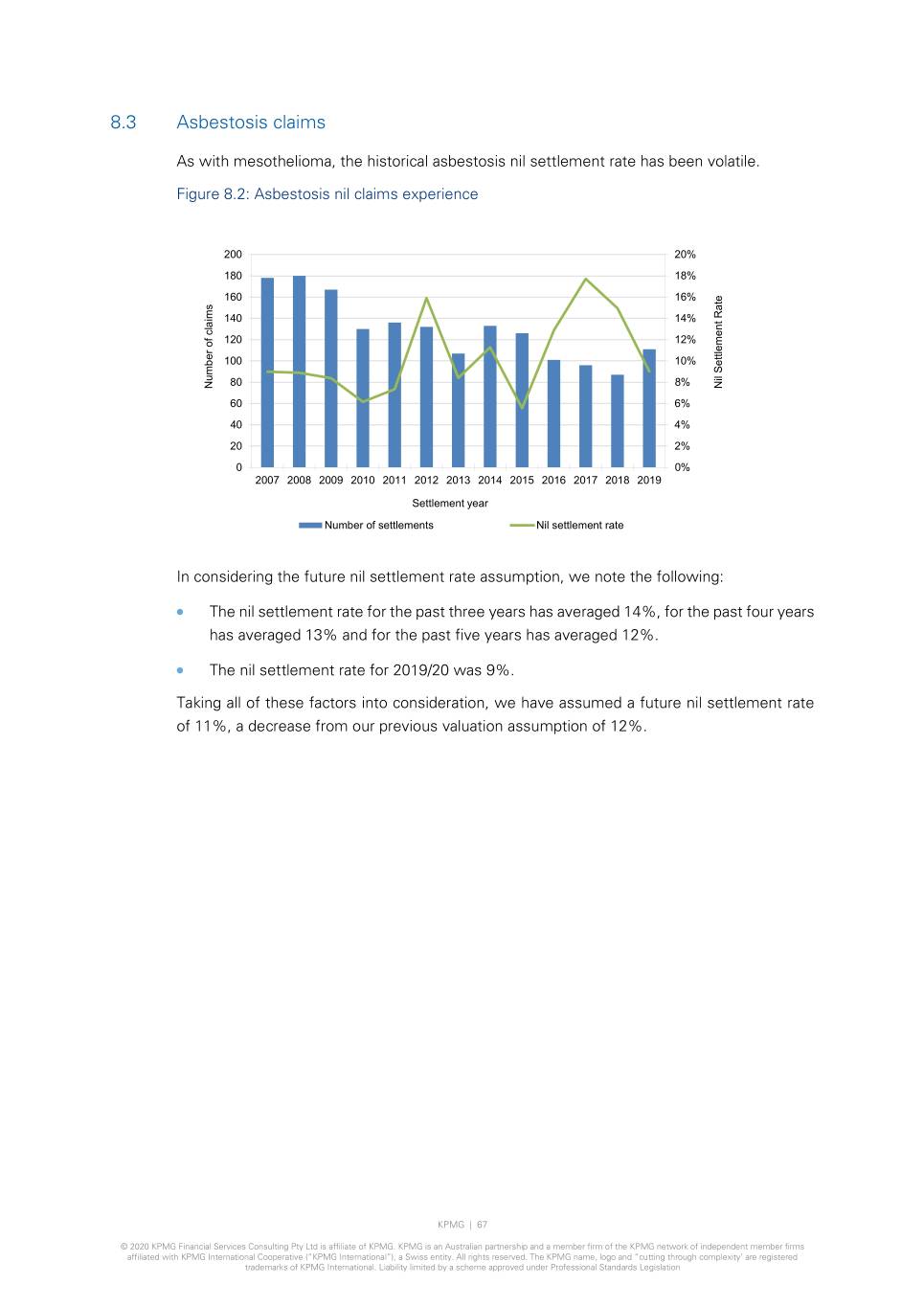
8.3 Asbestosis claims As with mesothelioma, the historical asbestosis nil settlement rate has been volatile. Figure 8.2: Asbestosis nil claims experience 200 20% 180 18% 160 16% 140 14% 120 12% 100 10% Nil Nil Rate Settlement Number of claims of Number 80 8% 60 6% 40 4% 20 2% 0 0% 2007 2008 2009 2010 2011 2012 2013 2014 2015 2016 2017 2018 2019 Settlement year Number of settlements Nil settlement rate In considering the future nil settlement rate assumption, we note the following: • The nil settlement rate for the past three years has averaged 14%, for the past four years has averaged 13% and for the past five years has averaged 12%. • The nil settlement rate for 2019/20 was 9%. Taking all of these factors into consideration, we have assumed a future nil settlement rate of 11%, a decrease from our previous valuation assumption of 12%. KPMG | 67 © 2020 KPMG Financial Services Consulting Pty Ltd is affiliate of KPMG. KPMG is an Australian partnership and a member firm of the KPMG network of independent member firms affiliated with KPMG International Cooperative (“KPMG International”), a Swiss entity. All rights reserved. The KPMG name, logo and “cutting through complexity’ are registered trademarks of KPMG International. Liability limited by a scheme approved under Professional Standards Legislation
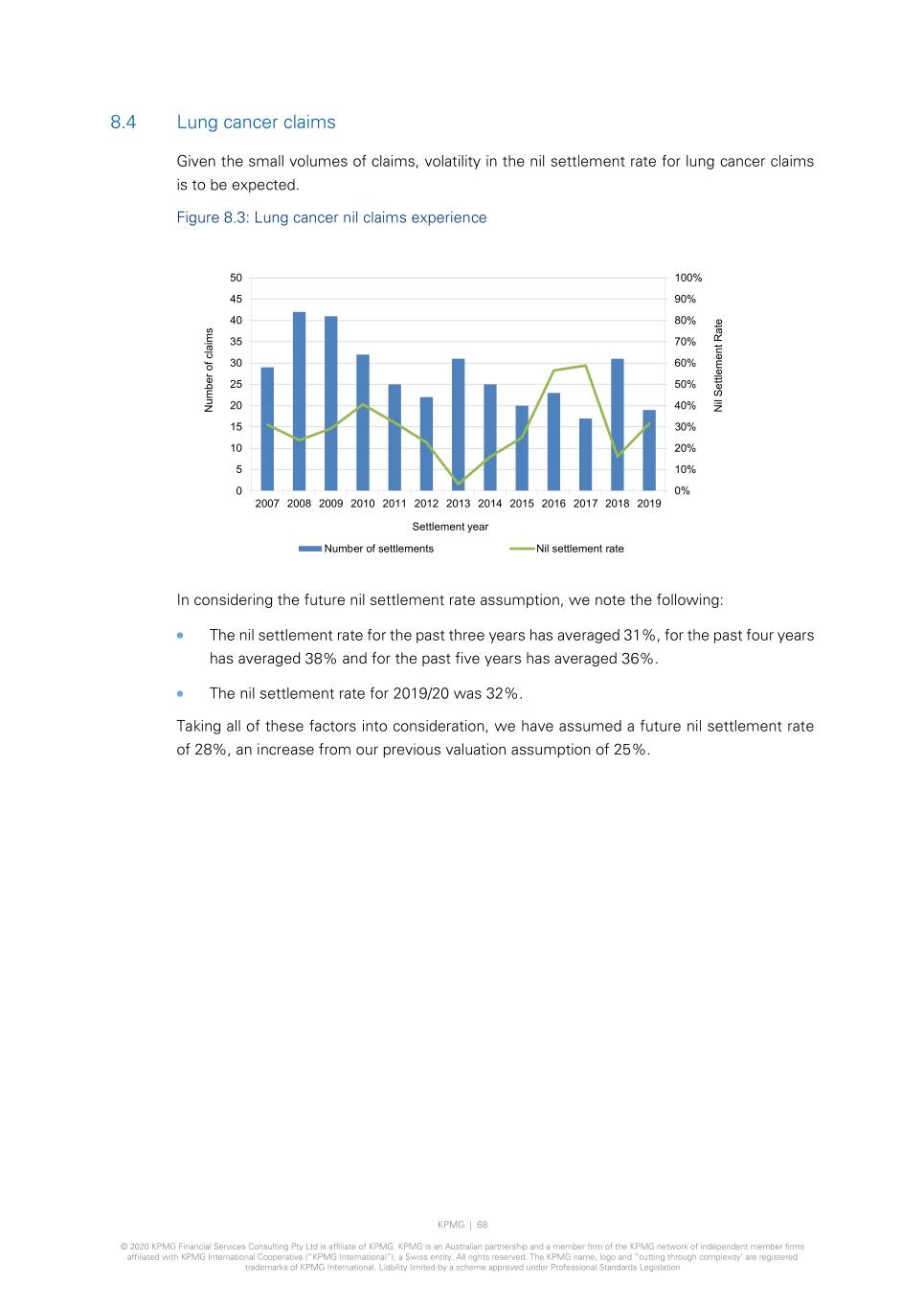
8.4 Lung cancer claims Given the small volumes of claims, volatility in the nil settlement rate for lung cancer claims is to be expected. Figure 8.3: Lung cancer nil claims experience 50 100% 45 90% 40 80% 35 70% 30 60% 25 50% Nil Nil Rate Settlement Number of claims of Number 20 40% 15 30% 10 20% 5 10% 0 0% 2007 2008 2009 2010 2011 2012 2013 2014 2015 2016 2017 2018 2019 Settlement year Number of settlements Nil settlement rate In considering the future nil settlement rate assumption, we note the following: • The nil settlement rate for the past three years has averaged 31%, for the past four years has averaged 38% and for the past five years has averaged 36%. • The nil settlement rate for 2019/20 was 32%. Taking all of these factors into consideration, we have assumed a future nil settlement rate of 28%, an increase from our previous valuation assumption of 25%. KPMG | 68 © 2020 KPMG Financial Services Consulting Pty Ltd is affiliate of KPMG. KPMG is an Australian partnership and a member firm of the KPMG network of independent member firms affiliated with KPMG International Cooperative (“KPMG International”), a Swiss entity. All rights reserved. The KPMG name, logo and “cutting through complexity’ are registered trademarks of KPMG International. Liability limited by a scheme approved under Professional Standards Legislation
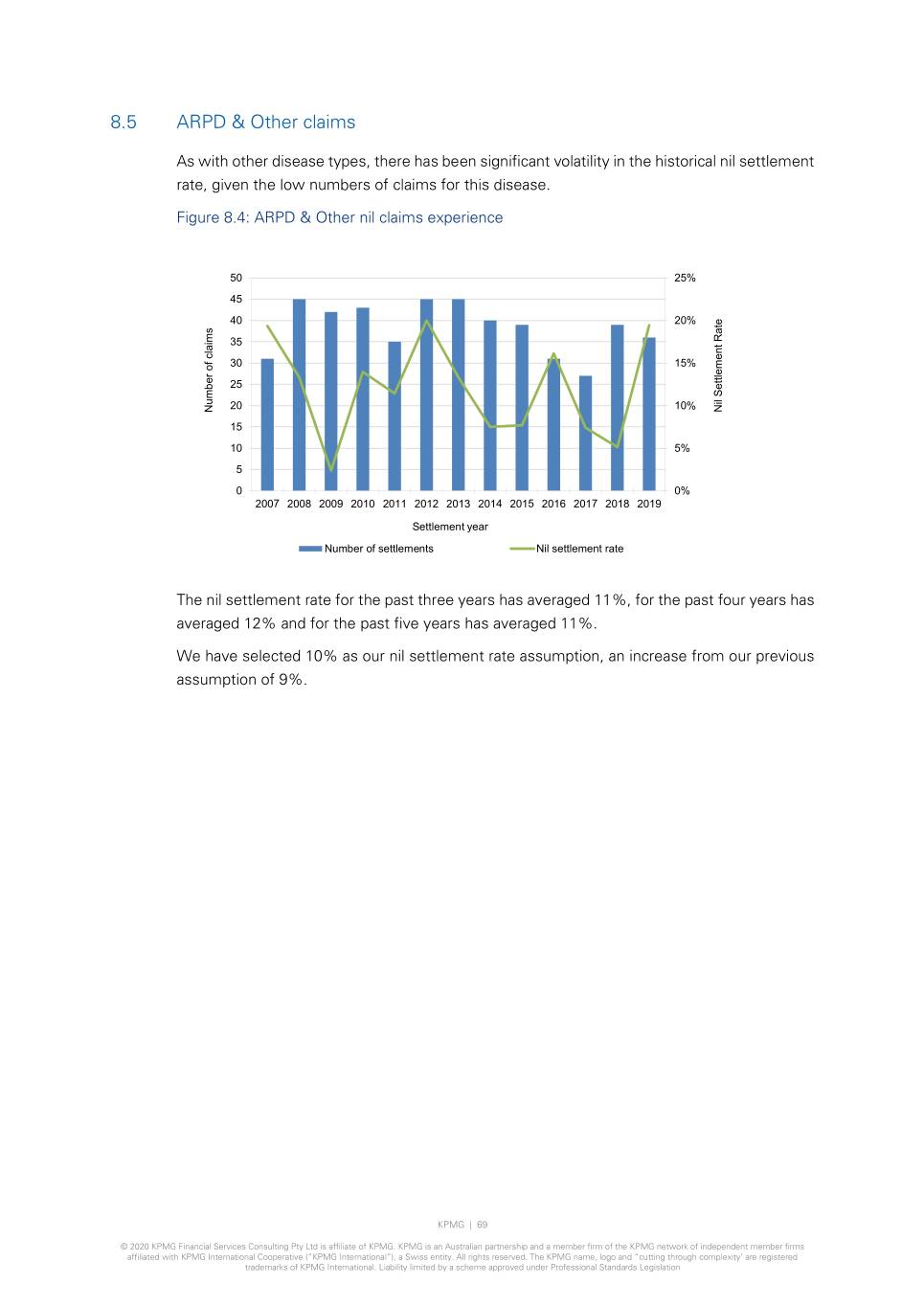
8.5 ARPD & Other claims As with other disease types, there has been significant volatility in the historical nil settlement rate, given the low numbers of claims for this disease. Figure 8.4: ARPD & Other nil claims experience 50 25% 45 40 20% 35 30 15% 25 Nil Nil Rate Settlement Number of claims of Number 20 10% 15 10 5% 5 0 0% 2007 2008 2009 2010 2011 2012 2013 2014 2015 2016 2017 2018 2019 Settlement year Number of settlements Nil settlement rate The nil settlement rate for the past three years has averaged 11%, for the past four years has averaged 12% and for the past five years has averaged 11%. We have selected 10% as our nil settlement rate assumption, an increase from our previous assumption of 9%. KPMG | 69 © 2020 KPMG Financial Services Consulting Pty Ltd is affiliate of KPMG. KPMG is an Australian partnership and a member firm of the KPMG network of independent member firms affiliated with KPMG International Cooperative (“KPMG International”), a Swiss entity. All rights reserved. The KPMG name, logo and “cutting through complexity’ are registered trademarks of KPMG International. Liability limited by a scheme approved under Professional Standards Legislation
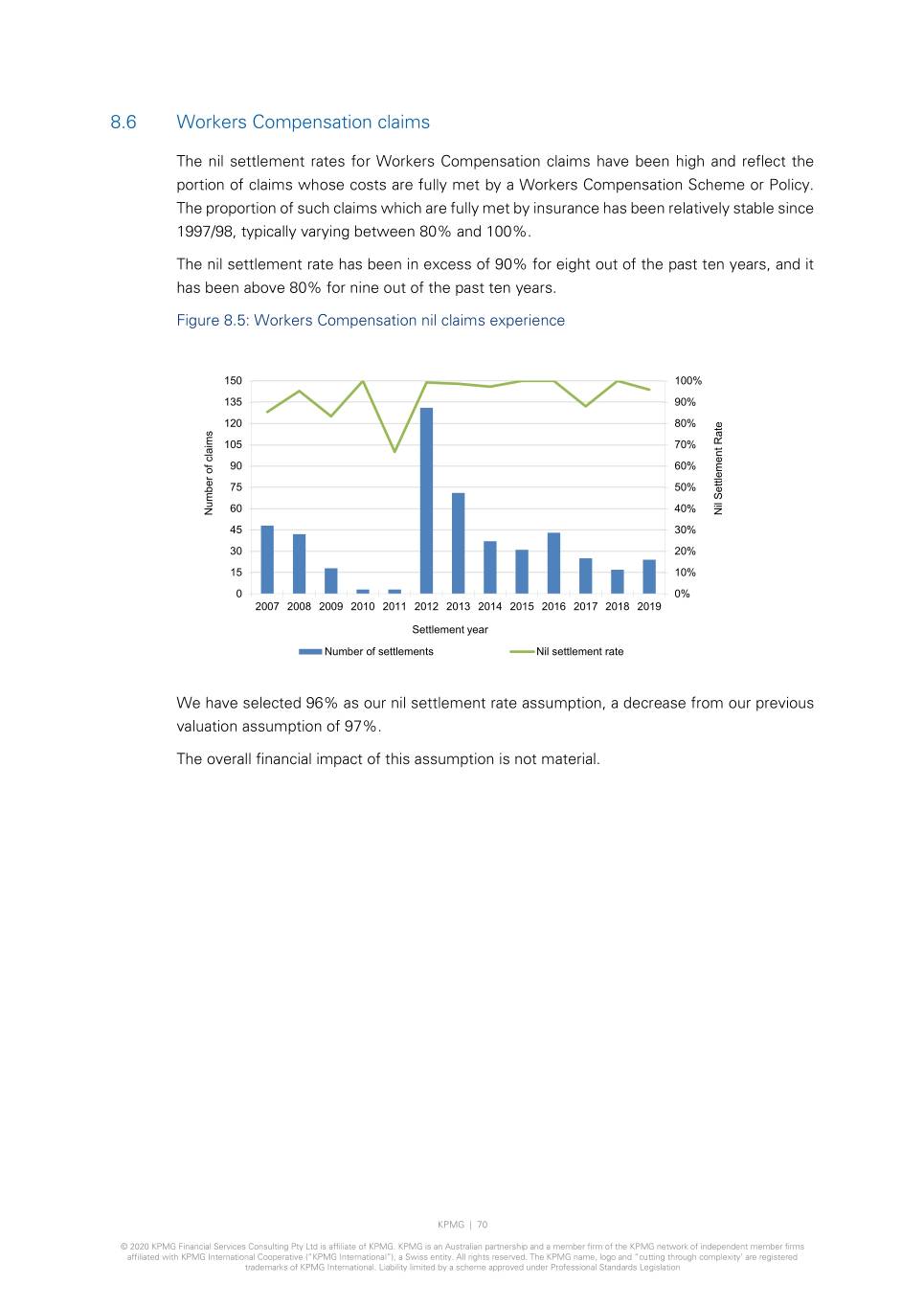
8.6 Workers Compensation claims The nil settlement rates for Workers Compensation claims have been high and reflect the portion of claims whose costs are fully met by a Workers Compensation Scheme or Policy. The proportion of such claims which are fully met by insurance has been relatively stable since 1997/98, typically varying between 80% and 100%. The nil settlement rate has been in excess of 90% for eight out of the past ten years, and it has been above 80% for nine out of the past ten years. Figure 8.5: Workers Compensation nil claims experience 150 100% 135 90% 120 80% 105 70% 90 60% 75 50% Nil Nil Rate Settlement Number of claims of Number 60 40% 45 30% 30 20% 15 10% 0 0% 2007 2008 2009 2010 2011 2012 2013 2014 2015 2016 2017 2018 2019 Settlement year Number of settlements Nil settlement rate We have selected 96% as our nil settlement rate assumption, a decrease from our previous valuation assumption of 97%. The overall financial impact of this assumption is not material. KPMG | 70 © 2020 KPMG Financial Services Consulting Pty Ltd is affiliate of KPMG. KPMG is an Australian partnership and a member firm of the KPMG network of independent member firms affiliated with KPMG International Cooperative (“KPMG International”), a Swiss entity. All rights reserved. The KPMG name, logo and “cutting through complexity’ are registered trademarks of KPMG International. Liability limited by a scheme approved under Professional Standards Legislation
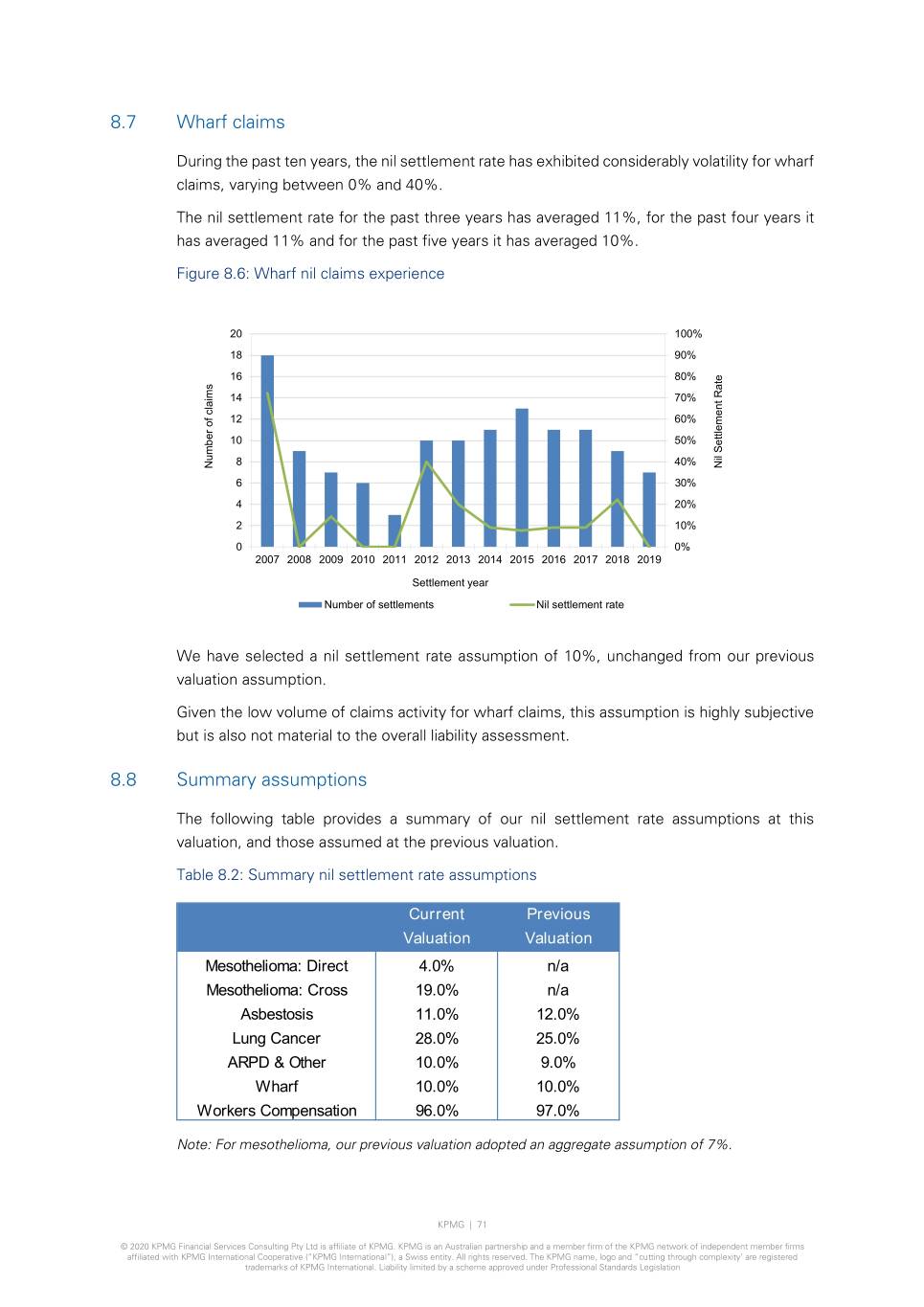
8.7 Wharf claims During the past ten years, the nil settlement rate has exhibited considerably volatility for wharf claims, varying between 0% and 40%. The nil settlement rate for the past three years has averaged 11%, for the past four years it has averaged 11% and for the past five years it has averaged 10%. Figure 8.6: Wharf nil claims experience 20 100% 18 90% 16 80% 14 70% 12 60% 10 50% Nil Nil Rate Settlement Number of claims of Number 8 40% 6 30% 4 20% 2 10% 0 0% 2007 2008 2009 2010 2011 2012 2013 2014 2015 2016 2017 2018 2019 Settlement year Number of settlements Nil settlement rate We have selected a nil settlement rate assumption of 10%, unchanged from our previous valuation assumption. Given the low volume of claims activity for wharf claims, this assumption is highly subjective but is also not material to the overall liability assessment. 8.8 Summary assumptions The following table provides a summary of our nil settlement rate assumptions at this valuation, and those assumed at the previous valuation. Table 8.2: Summary nil settlement rate assumptions Current Previous Valuation Valuation Mesothelioma: Direct 4.0% n/a Mesothelioma: Cross 19.0% n/a Asbestosis 11.0% 12.0% Lung Cancer 28.0% 25.0% ARPD & Other 10.0% 9.0% Wharf 10.0% 10.0% Workers Compensation 96.0% 97.0% Note: For mesothelioma, our previous valuation adopted an aggregate assumption of 7%. KPMG | 71 © 2020 KPMG Financial Services Consulting Pty Ltd is affiliate of KPMG. KPMG is an Australian partnership and a member firm of the KPMG network of independent member firms affiliated with KPMG International Cooperative (“KPMG International”), a Swiss entity. All rights reserved. The KPMG name, logo and “cutting through complexity’ are registered trademarks of KPMG International. Liability limited by a scheme approved under Professional Standards Legislation
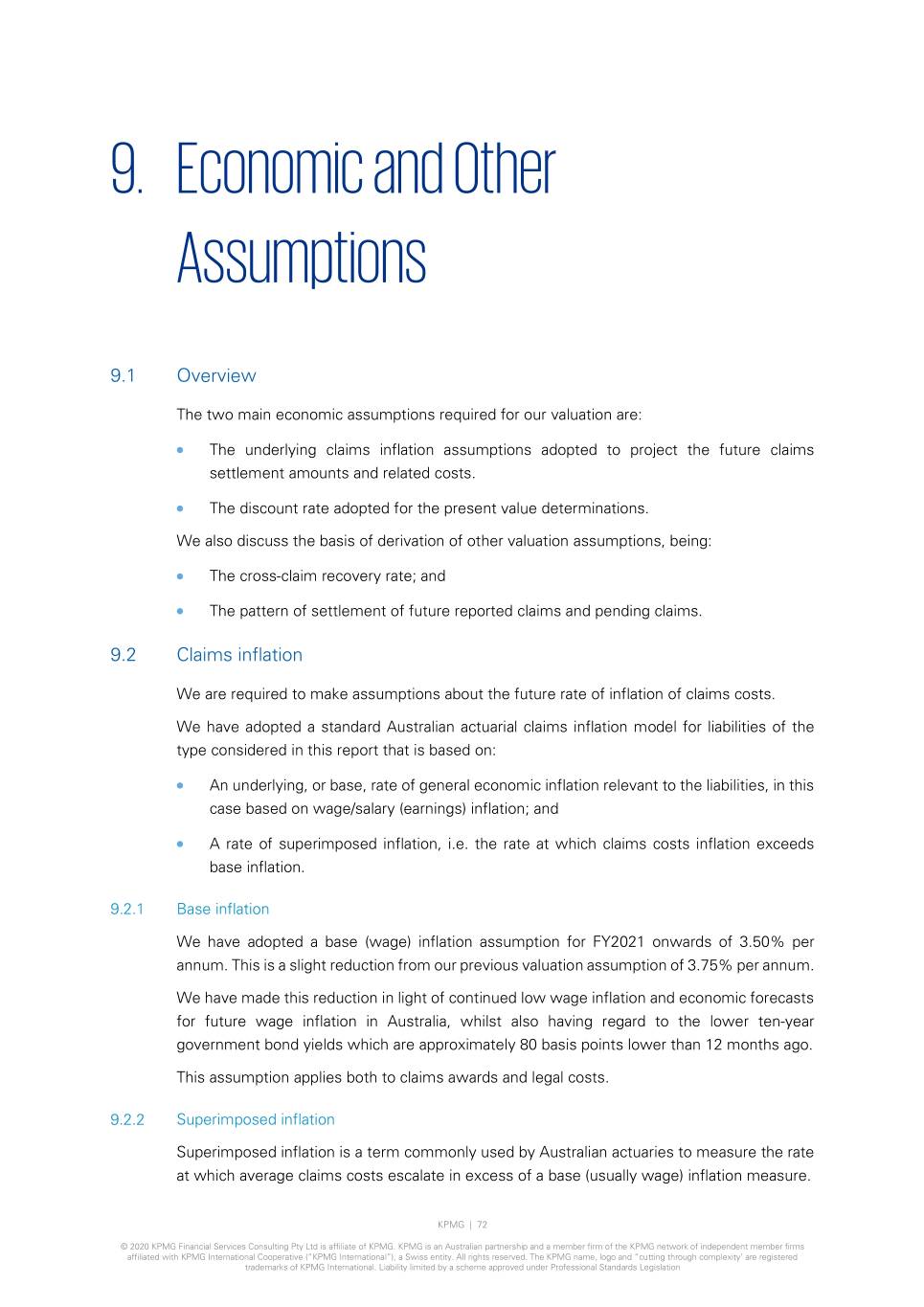
9. Economic and Other Assumptions 9.1 Overview The two main economic assumptions required for our valuation are: • The underlying claims inflation assumptions adopted to project the future claims settlement amounts and related costs. • The discount rate adopted for the present value determinations. We also discuss the basis of derivation of other valuation assumptions, being: • The cross-claim recovery rate; and • The pattern of settlement of future reported claims and pending claims. 9.2 Claims inflation We are required to make assumptions about the future rate of inflation of claims costs. We have adopted a standard Australian actuarial claims inflation model for liabilities of the type considered in this report that is based on: • An underlying, or base, rate of general economic inflation relevant to the liabilities, in this case based on wage/salary (earnings) inflation; and • A rate of superimposed inflation, i.e. the rate at which claims costs inflation exceeds base inflation. 9.2.1 Base inflation We have adopted a base (wage) inflation assumption for FY2021 onwards of 3.50% per annum. This is a slight reduction from our previous valuation assumption of 3.75% per annum. We have made this reduction in light of continued low wage inflation and economic forecasts for future wage inflation in Australia, whilst also having regard to the lower ten-year government bond yields which are approximately 80 basis points lower than 12 months ago. This assumption applies both to claims awards and legal costs. 9.2.2 Superimposed inflation Superimposed inflation is a term commonly used by Australian actuaries to measure the rate at which average claims costs escalate in excess of a base (usually wage) inflation measure. KPMG | 72 © 2020 KPMG Financial Services Consulting Pty Ltd is affiliate of KPMG. KPMG is an Australian partnership and a member firm of the KPMG network of independent member firms affiliated with KPMG International Cooperative (“KPMG International”), a Swiss entity. All rights reserved. The KPMG name, logo and “cutting through complexity’ are registered trademarks of KPMG International. Liability limited by a scheme approved under Professional Standards Legislation
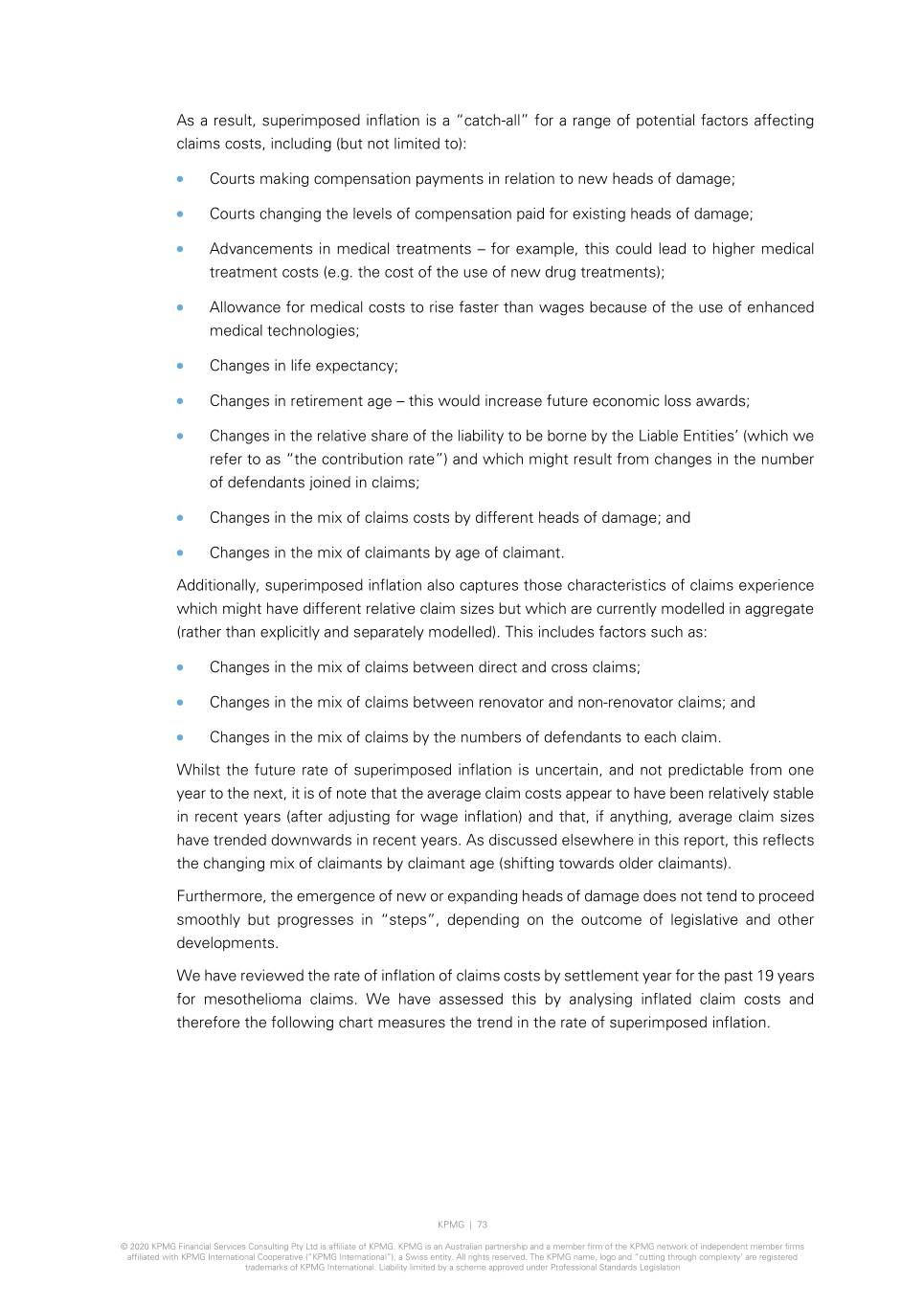
As a result, superimposed inflation is a “catch-all” for a range of potential factors affecting claims costs, including (but not limited to): • Courts making compensation payments in relation to new heads of damage; • Courts changing the levels of compensation paid for existing heads of damage; • Advancements in medical treatments – for example, this could lead to higher medical treatment costs (e.g. the cost of the use of new drug treatments); • Allowance for medical costs to rise faster than wages because of the use of enhanced medical technologies; • Changes in life expectancy; • Changes in retirement age – this would increase future economic loss awards; • Changes in the relative share of the liability to be borne by the Liable Entities’ (which we refer to as “the contribution rate”) and which might result from changes in the number of defendants joined in claims; • Changes in the mix of claims costs by different heads of damage; and • Changes in the mix of claimants by age of claimant. Additionally, superimposed inflation also captures those characteristics of claims experience which might have different relative claim sizes but which are currently modelled in aggregate (rather than explicitly and separately modelled). This includes factors such as: • Changes in the mix of claims between direct and cross claims; • Changes in the mix of claims between renovator and non-renovator claims; and • Changes in the mix of claims by the numbers of defendants to each claim. Whilst the future rate of superimposed inflation is uncertain, and not predictable from one year to the next, it is of note that the average claim costs appear to have been relatively stable in recent years (after adjusting for wage inflation) and that, if anything, average claim sizes have trended downwards in recent years. As discussed elsewhere in this report, this reflects the changing mix of claimants by claimant age (shifting towards older claimants). Furthermore, the emergence of new or expanding heads of damage does not tend to proceed smoothly but progresses in “steps”, depending on the outcome of legislative and other developments. We have reviewed the rate of inflation of claims costs by settlement year for the past 19 years for mesothelioma claims. We have assessed this by analysing inflated claim costs and therefore the following chart measures the trend in the rate of superimposed inflation. KPMG | 73 © 2020 KPMG Financial Services Consulting Pty Ltd is affiliate of KPMG. KPMG is an Australian partnership and a member firm of the KPMG network of independent member firms affiliated with KPMG International Cooperative (“KPMG International”), a Swiss entity. All rights reserved. The KPMG name, logo and “cutting through complexity’ are registered trademarks of KPMG International. Liability limited by a scheme approved under Professional Standards Legislation
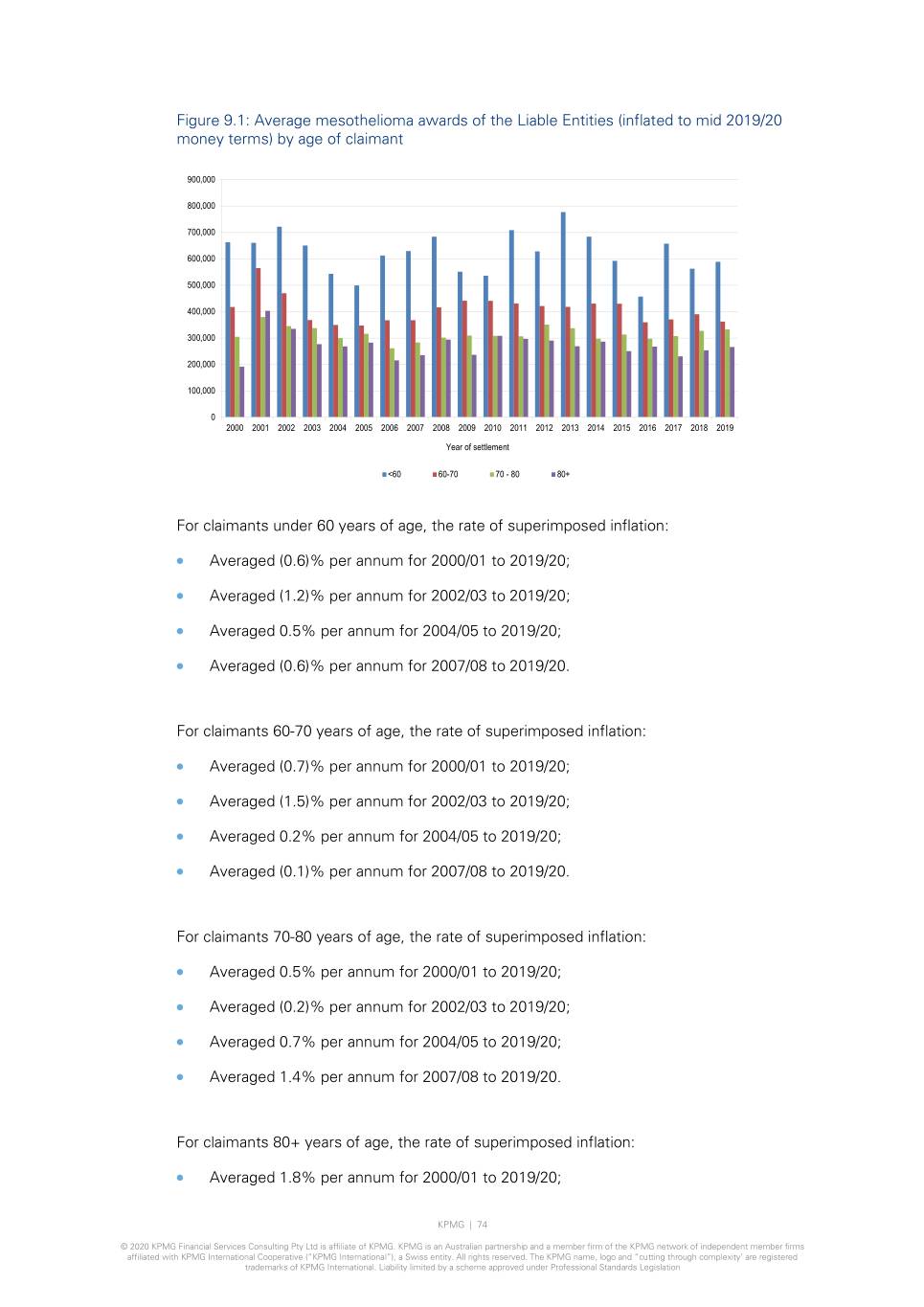
Figure 9.1: Average mesothelioma awards of the Liable Entities (inflated to mid 2019/20 money terms) by age of claimant 900,000 800,000 700,000 600,000 500,000 400,000 300,000 200,000 100,000 0 2000 2001 2002 2003 2004 2005 2006 2007 2008 2009 2010 2011 2012 2013 2014 2015 2016 2017 2018 2019 Year of settlement <60 60-70 70 - 80 80+ For claimants under 60 years of age, the rate of superimposed inflation: • Averaged (0.6)% per annum for 2000/01 to 2019/20; • Averaged (1.2)% per annum for 2002/03 to 2019/20; • Averaged 0.5% per annum for 2004/05 to 2019/20; • Averaged (0.6)% per annum for 2007/08 to 2019/20. For claimants 60-70 years of age, the rate of superimposed inflation: • Averaged (0.7)% per annum for 2000/01 to 2019/20; • Averaged (1.5)% per annum for 2002/03 to 2019/20; • Averaged 0.2% per annum for 2004/05 to 2019/20; • Averaged (0.1)% per annum for 2007/08 to 2019/20. For claimants 70-80 years of age, the rate of superimposed inflation: • Averaged 0.5% per annum for 2000/01 to 2019/20; • Averaged (0.2)% per annum for 2002/03 to 2019/20; • Averaged 0.7% per annum for 2004/05 to 2019/20; • Averaged 1.4% per annum for 2007/08 to 2019/20. For claimants 80+ years of age, the rate of superimposed inflation: • Averaged 1.8% per annum for 2000/01 to 2019/20; KPMG | 74 © 2020 KPMG Financial Services Consulting Pty Ltd is affiliate of KPMG. KPMG is an Australian partnership and a member firm of the KPMG network of independent member firms affiliated with KPMG International Cooperative (“KPMG International”), a Swiss entity. All rights reserved. The KPMG name, logo and “cutting through complexity’ are registered trademarks of KPMG International. Liability limited by a scheme approved under Professional Standards Legislation
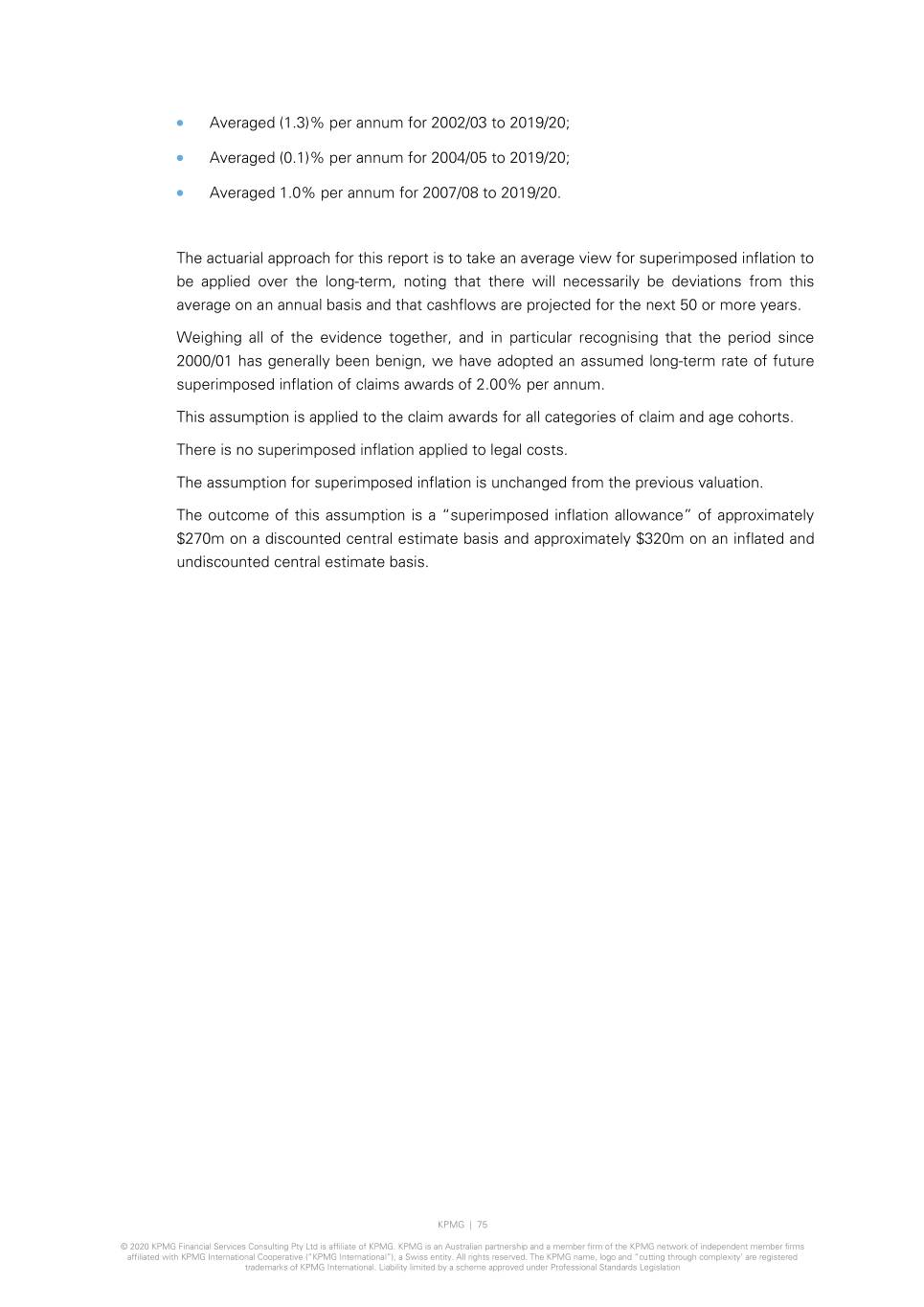
• Averaged (1.3)% per annum for 2002/03 to 2019/20; • Averaged (0.1)% per annum for 2004/05 to 2019/20; • Averaged 1.0% per annum for 2007/08 to 2019/20. The actuarial approach for this report is to take an average view for superimposed inflation to be applied over the long-term, noting that there will necessarily be deviations from this average on an annual basis and that cashflows are projected for the next 50 or more years. Weighing all of the evidence together, and in particular recognising that the period since 2000/01 has generally been benign, we have adopted an assumed long-term rate of future superimposed inflation of claims awards of 2.00% per annum. This assumption is applied to the claim awards for all categories of claim and age cohorts. There is no superimposed inflation applied to legal costs. The assumption for superimposed inflation is unchanged from the previous valuation. The outcome of this assumption is a “superimposed inflation allowance” of approximately $270m on a discounted central estimate basis and approximately $320m on an inflated and undiscounted central estimate basis. KPMG | 75 © 2020 KPMG Financial Services Consulting Pty Ltd is affiliate of KPMG. KPMG is an Australian partnership and a member firm of the KPMG network of independent member firms affiliated with KPMG International Cooperative (“KPMG International”), a Swiss entity. All rights reserved. The KPMG name, logo and “cutting through complexity’ are registered trademarks of KPMG International. Liability limited by a scheme approved under Professional Standards Legislation

9.3 Discount rates: Commonwealth bond zero coupon yields We have calculated the zero coupon yield curve at 31 March 2020 underlying the prices, coupons and durations of Commonwealth Government Bonds for the purpose of discounting the liabilities for this report. The use of such discount rates is consistent with standard Australian actuarial practice for such liabilities, is in accordance with the Institute of Actuaries of Australia’s Professional Standard PS302 and is also consistent with our understanding of the Australian accounting standards. The chart below shows the assumptions for the current valuation and the previous valuation. Figure 9.2: Zero coupon yield curve by duration 5.00% 4.50% 4.00% 3.50% 3.00% 2.50% 2.00% 1.50% 1.00% 0.50% 0.00% Yield curve at 31 March 2020 Yield curve at 31 March 2019 At this valuation, in light of the continued lower yields at long durations and particularly noting the approximate 40 basis point reduction in the year-16 yield between 31 March 2019 and 31 March 2020, we consider it appropriate to lower the long-term assumption from 4.50% per annum to 4.00% per annum. The reduction in the long-term discount rate has increased the Discounted Central Estimate by approximately $3m. This adjustment is relatively small because the vast majority of the future cashflows (more than 85%) are projected to be paid over the next 18 years. By contrast, the reduction in the discount rates for durations 1 to 16 years has increased the Discounted Central Estimate by approximately $140m. KPMG | 76 © 2020 KPMG Financial Services Consulting Pty Ltd is affiliate of KPMG. KPMG is an Australian partnership and a member firm of the KPMG network of independent member firms affiliated with KPMG International Cooperative (“KPMG International”), a Swiss entity. All rights reserved. The KPMG name, logo and “cutting through complexity’ are registered trademarks of KPMG International. Liability limited by a scheme approved under Professional Standards Legislation
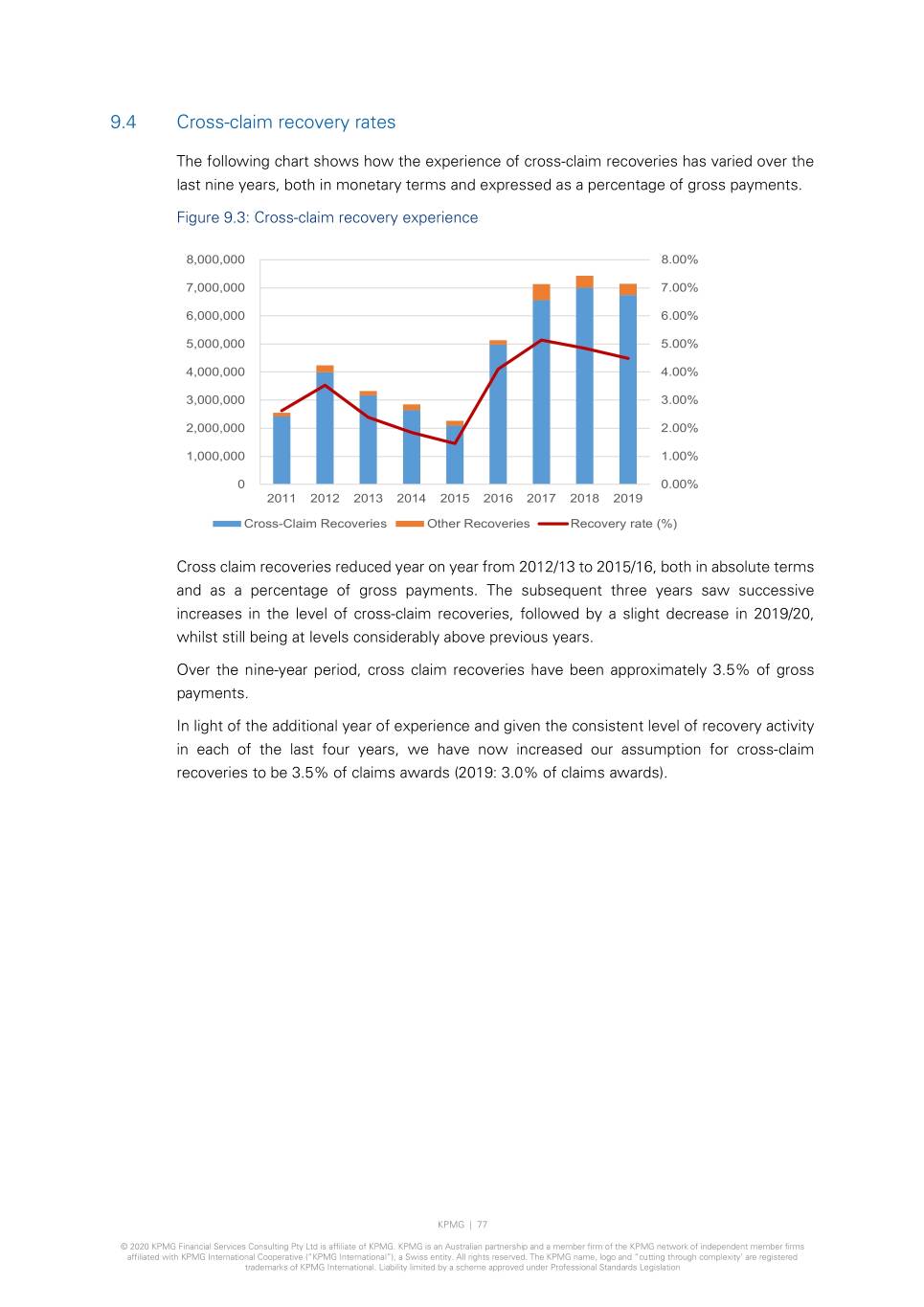
9.4 Cross-claim recovery rates The following chart shows how the experience of cross-claim recoveries has varied over the last nine years, both in monetary terms and expressed as a percentage of gross payments. Figure 9.3: Cross-claim recovery experience 8,000,000 8.00% 7,000,000 7.00% 6,000,000 6.00% 5,000,000 5.00% 4,000,000 4.00% 3,000,000 3.00% 2,000,000 2.00% 1,000,000 1.00% 0 0.00% 2011 2012 2013 2014 2015 2016 2017 2018 2019 Cross-Claim Recoveries Other Recoveries Recovery rate (%) Cross claim recoveries reduced year on year from 2012/13 to 2015/16, both in absolute terms and as a percentage of gross payments. The subsequent three years saw successive increases in the level of cross-claim recoveries, followed by a slight decrease in 2019/20, whilst still being at levels considerably above previous years. Over the nine-year period, cross claim recoveries have been approximately 3.5% of gross payments. In light of the additional year of experience and given the consistent level of recovery activity in each of the last four years, we have now increased our assumption for cross-claim recoveries to be 3.5% of claims awards (2019: 3.0% of claims awards). KPMG | 77 © 2020 KPMG Financial Services Consulting Pty Ltd is affiliate of KPMG. KPMG is an Australian partnership and a member firm of the KPMG network of independent member firms affiliated with KPMG International Cooperative (“KPMG International”), a Swiss entity. All rights reserved. The KPMG name, logo and “cutting through complexity’ are registered trademarks of KPMG International. Liability limited by a scheme approved under Professional Standards Legislation

9.5 Settlement Patterns Triangulation methods are used to derive the past pattern of settlement of claims and are used in forming a view on future settlement patterns. The following triangles provide an illustrative example of how we perform this: Figure 9.4: Settlement pattern derivation for mesothelioma claims: paid as % of ultimate cost Yr of Notification 0 1 2 3 4 5 6 7 8 9 10 11 12 2005 57.9% 92.3% 97.5% 97.5% 97.9% 99.4% 100.0% 100.0% 100.0% 100.0% 100.0% 100.0% 100.0% 2006 61.7% 93.7% 97.6% 100.0% 100.0% 100.0% 100.0% 100.0% 100.0% 100.0% 100.0% 100.0% 100.0% 2007 53.3% 97.1% 99.5% 99.8% 99.8% 100.0% 100.0% 100.0% 100.0% 100.0% 100.0% 100.0% 100.0% 2008 67.3% 96.5% 97.7% 99.3% 99.9% 100.0% 100.0% 100.0% 100.0% 100.0% 100.0% 100.0% 2009 57.7% 88.4% 92.7% 99.2% 99.4% 99.8% 100.0% 100.0% 100.0% 100.0% 100.0% 2010 71.7% 96.4% 99.7% 99.9% 100.0% 100.0% 100.0% 100.0% 100.0% 100.0% 2011 57.1% 96.9% 99.1% 99.7% 100.0% 100.0% 100.0% 100.0% 100.0% 2012 55.7% 97.7% 99.7% 100.0% 100.0% 100.0% 100.0% 100.0% 2013 65.3% 94.9% 99.6% 99.8% 100.0% 100.0% 100.0% 2014 65.8% 96.6% 98.6% 99.5% 100.0% 100.0% 2015 65.5% 96.3% 99.4% 99.8% 100.0% 2016 57.3% 98.2% 99.2% 99.9% 2017 55.4% 96.7% 98.4% 2018 55.4% 96.4% 2019 60.8% Figure 9.5: Settlement pattern derivation for non-mesothelioma claims: paid as % of ultimate cost Yr of Notification 0 1 2 3 4 5 6 7 8 9 10 11 12 2005 19.6% 81.3% 94.6% 98.1% 100.0% 100.0% 100.0% 100.0% 100.0% 100.0% 100.0% 100.0% 100.0% 2006 22.7% 72.0% 91.5% 94.7% 99.4% 100.0% 100.0% 100.0% 100.0% 100.0% 100.0% 100.0% 100.0% 2007 28.9% 83.1% 93.0% 99.6% 100.0% 100.0% 100.0% 100.0% 100.0% 100.0% 100.0% 100.0% 100.0% 2008 26.1% 84.5% 95.6% 97.3% 99.7% 100.0% 100.0% 100.0% 100.0% 100.0% 100.0% 100.0% 2009 40.4% 77.7% 94.1% 95.9% 96.1% 97.5% 100.0% 100.0% 100.0% 100.0% 100.0% 2010 26.1% 84.7% 95.7% 97.4% 100.0% 100.0% 100.0% 100.0% 100.0% 100.0% 2011 36.8% 90.1% 99.8% 100.0% 100.0% 100.0% 100.0% 100.0% 100.0% 2012 38.7% 89.1% 98.4% 99.9% 99.9% 100.0% 100.0% 100.0% 2013 28.4% 84.1% 95.7% 97.7% 98.9% 99.9% 99.9% 2014 32.7% 90.6% 97.2% 99.8% 100.0% 100.0% 2015 46.4% 88.9% 95.0% 98.5% 98.5% 2016 23.6% 77.4% 95.0% 97.7% 2017 36.5% 88.5% 93.5% 2018 20.5% 81.6% 2019 28.9% We have estimated the settlement pattern for future claim reporting as follows: Table 9.1: Settlement pattern of claims awards by delay from claim reporting Delay (years) Mesothelioma Non-Mesothelioma 0 60.0% 30.0% 1 36.0% 54.0% 2 2.5% 9.5% 3 1.0% 4.0% 4 0.5% 1.0% 5 0.0% 0.5% 6 0.0% 0.5% 7 0.0% 0.5% 8 0.0% 0.0% 9 0.0% 0.0% These assumed settlements patterns have been modified slightly since our previous valuation, resulting in an assumption of a slight speeding-up for mesothelioma claim and non- mesothelioma claim settlements. For mesothelioma, we have adopted one pattern because analysis of the average time to settlement for each of the four age groups was not materially different to the overall average time to settlement. KPMG | 78 © 2020 KPMG Financial Services Consulting Pty Ltd is affiliate of KPMG. KPMG is an Australian partnership and a member firm of the KPMG network of independent member firms affiliated with KPMG International Cooperative (“KPMG International”), a Swiss entity. All rights reserved. The KPMG name, logo and “cutting through complexity’ are registered trademarks of KPMG International. Liability limited by a scheme approved under Professional Standards Legislation

10. Valuation Results 10.1 Central estimate liability At 31 March 2020, our projected central estimate of the liabilities of the Liable Entities (the Discounted Central Estimate) to be met by the AICF Trust is $2,025.2m (2019: $1,868.4m). We have not allowed for the future Operating Expenses of the AICF Trust or the Liable Entities in the liability assessment. The following table shows a summary of our central estimate liability assessment and compares the current assessment with our previous valuation. Table 10.1: Comparison of central estimate of liabilities 31 March 2020 31 March 2019 $m $m Gross of Net of Net of insurance Insurance insurance insurance recoveries recoveries recoveries recoveries Total uninflated and 1,521.2 68.8 1,452.4 1,399.8 undiscounted cash-flows Inflation allowance 784.1 21.3 762.8 818.7 Total inflated and 2,305.3 90.1 2,215.2 2,218.5 undiscounted cash-flows Discounting allowance (196.4) (6.4) (190.0) (350.1) Net present value liabilities 2,108.9 83.7 2,025.2 1,868.4 KPMG | 79 © 2020 KPMG Financial Services Consulting Pty Ltd is affiliate of KPMG. KPMG is an Australian partnership and a member firm of the KPMG network of independent member firms affiliated with KPMG International Cooperative (“KPMG International”), a Swiss entity. All rights reserved. The KPMG name, logo and “cutting through complexity’ are registered trademarks of KPMG International. Liability limited by a scheme approved under Professional Standards Legislation
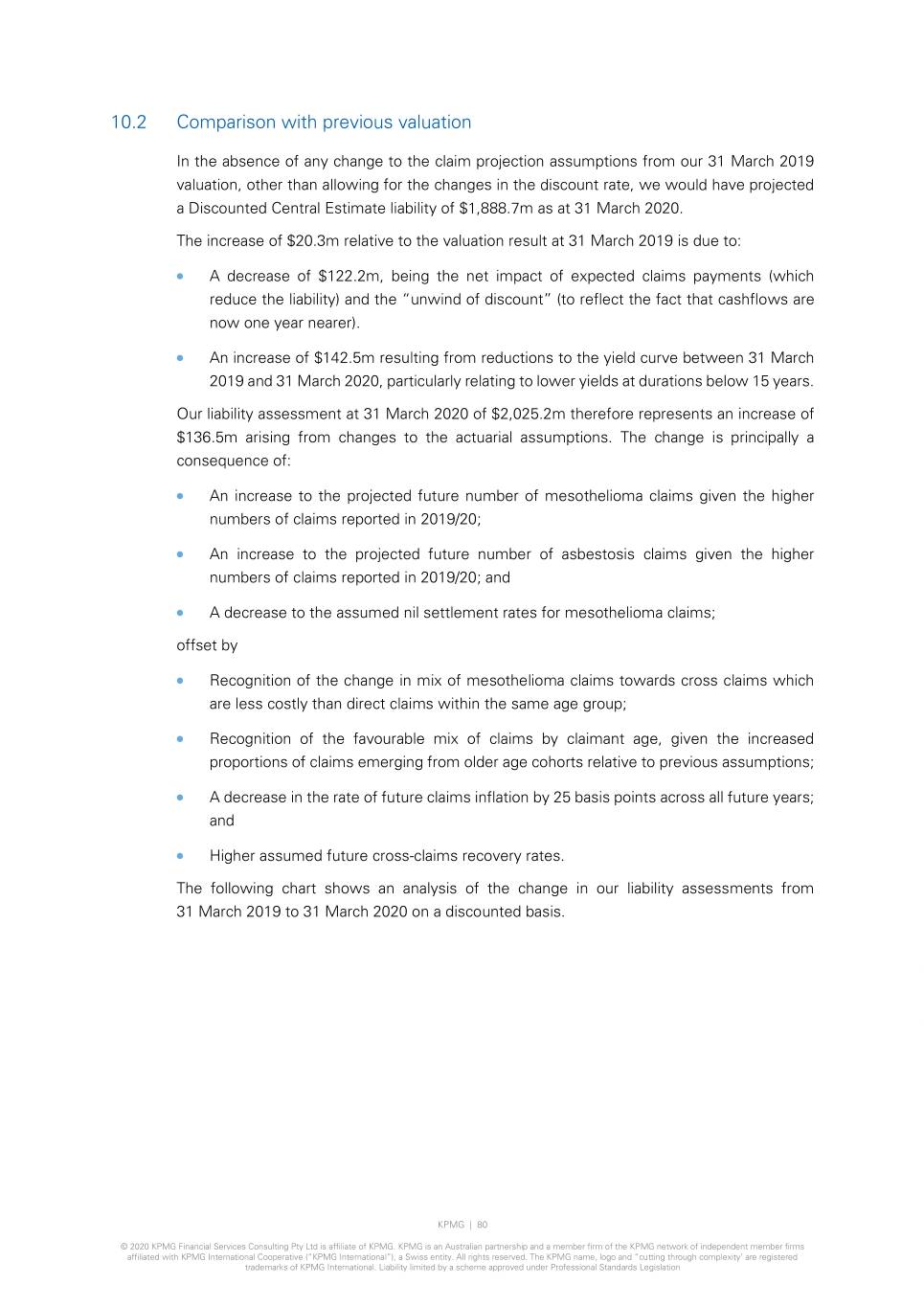
10.2 Comparison with previous valuation In the absence of any change to the claim projection assumptions from our 31 March 2019 valuation, other than allowing for the changes in the discount rate, we would have projected a Discounted Central Estimate liability of $1,888.7m as at 31 March 2020. The increase of $20.3m relative to the valuation result at 31 March 2019 is due to: • A decrease of $122.2m, being the net impact of expected claims payments (which reduce the liability) and the “unwind of discount” (to reflect the fact that cashflows are now one year nearer). • An increase of $142.5m resulting from reductions to the yield curve between 31 March 2019 and 31 March 2020, particularly relating to lower yields at durations below 15 years. Our liability assessment at 31 March 2020 of $2,025.2m therefore represents an increase of $136.5m arising from changes to the actuarial assumptions. The change is principally a consequence of: • An increase to the projected future number of mesothelioma claims given the higher numbers of claims reported in 2019/20; • An increase to the projected future number of asbestosis claims given the higher numbers of claims reported in 2019/20; and • A decrease to the assumed nil settlement rates for mesothelioma claims; offset by • Recognition of the change in mix of mesothelioma claims towards cross claims which are less costly than direct claims within the same age group; • Recognition of the favourable mix of claims by claimant age, given the increased proportions of claims emerging from older age cohorts relative to previous assumptions; • A decrease in the rate of future claims inflation by 25 basis points across all future years; and • Higher assumed future cross-claims recovery rates. The following chart shows an analysis of the change in our liability assessments from 31 March 2019 to 31 March 2020 on a discounted basis. KPMG | 80 © 2020 KPMG Financial Services Consulting Pty Ltd is affiliate of KPMG. KPMG is an Australian partnership and a member firm of the KPMG network of independent member firms affiliated with KPMG International Cooperative (“KPMG International”), a Swiss entity. All rights reserved. The KPMG name, logo and “cutting through complexity’ are registered trademarks of KPMG International. Liability limited by a scheme approved under Professional Standards Legislation
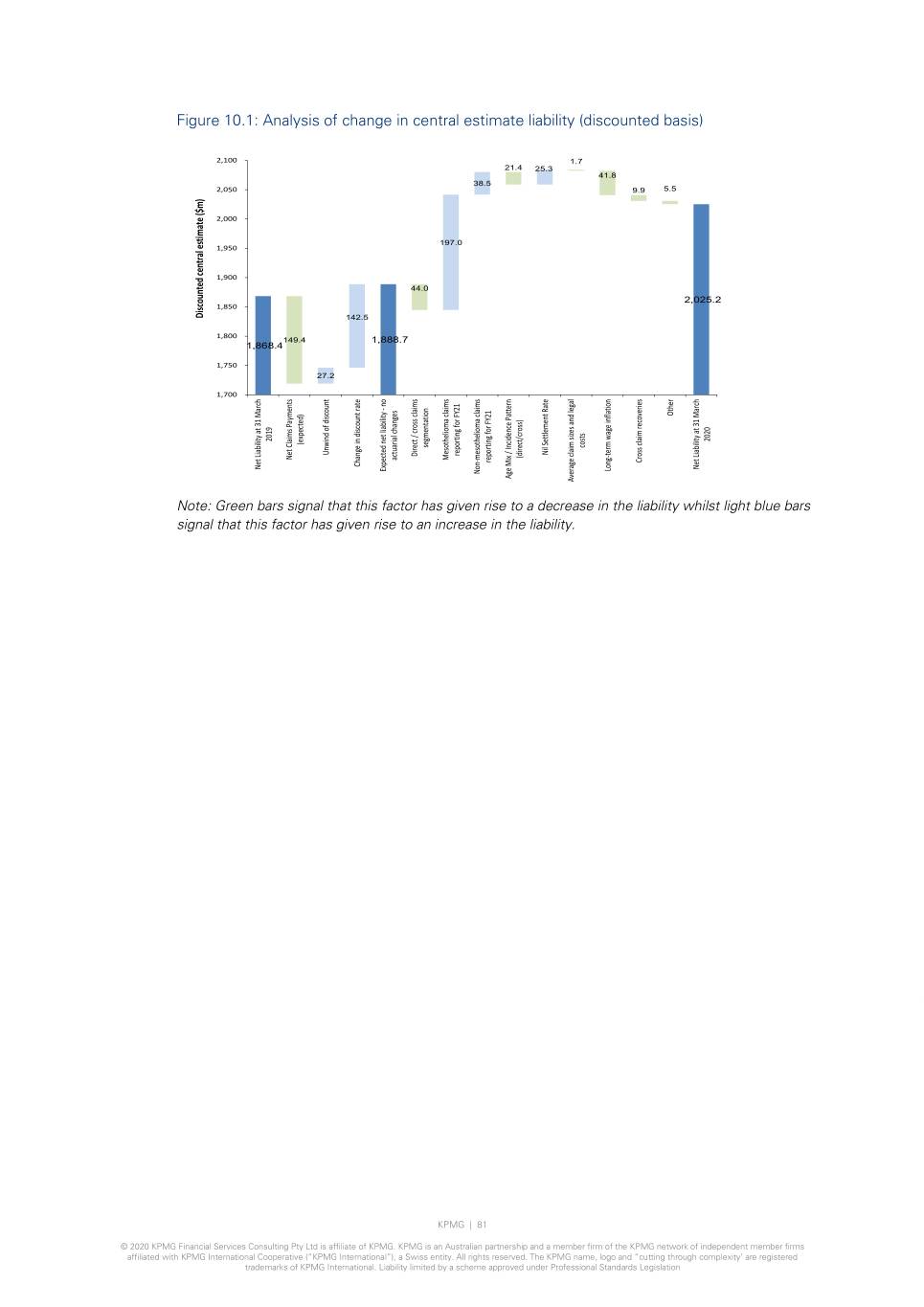
Figure 10.1: Analysis of change in central estimate liability (discounted basis) 2,100 1.7 21.4 25.3 41.8 38.5 2,050 9.9 5.5 2,000 197.0 1,950 1,900 44.0 2,025.2 1,850 Discounted centralestimate ($m) 142.5 1,800 149.4 1,888.7 1,868.4 1,750 27.2 1,700 Other 2020 2019 (expected) segmentation costs Nil Settlement Rate Unwind of discount reporting for FY21 Direct / cross claims (direct/cross) Net Claims Payments Claims Net Mesothelioma claims Mesothelioma actuarial changes actuarial reporting for FY21 Cross claim recoveries Change in discount rate Net Liability at 31 March Net Liability at 31 March Long-term wage inflation Expected net liability - no Non-mesothelioma claims Non-mesothelioma Age Mix / Incidence Pattern Average claim sizes and legal Note: Green bars signal that this factor has given rise to a decrease in the liability whilst light blue bars signal that this factor has given rise to an increase in the liability. KPMG | 81 © 2020 KPMG Financial Services Consulting Pty Ltd is affiliate of KPMG. KPMG is an Australian partnership and a member firm of the KPMG network of independent member firms affiliated with KPMG International Cooperative (“KPMG International”), a Swiss entity. All rights reserved. The KPMG name, logo and “cutting through complexity’ are registered trademarks of KPMG International. Liability limited by a scheme approved under Professional Standards Legislation
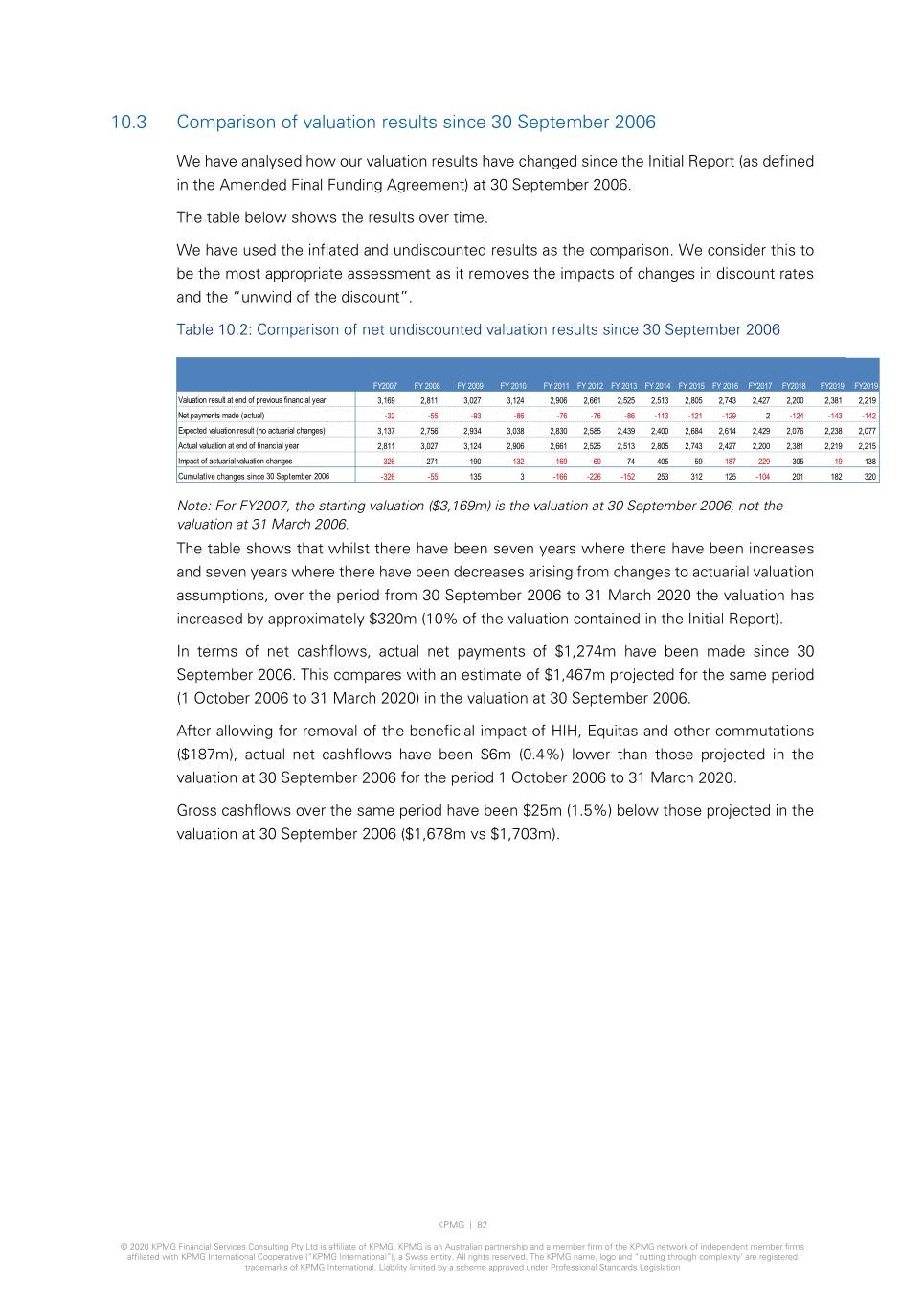
10.3 Comparison of valuation results since 30 September 2006 We have analysed how our valuation results have changed since the Initial Report (as defined in the Amended Final Funding Agreement) at 30 September 2006. The table below shows the results over time. We have used the inflated and undiscounted results as the comparison. We consider this to be the most appropriate assessment as it removes the impacts of changes in discount rates and the “unwind of the discount”. Table 10.2: Comparison of net undiscounted valuation results since 30 September 2006 FY2007 FY 2008 FY 2009 FY 2010 FY 2011 FY 2012 FY 2013 FY 2014 FY 2015 FY 2016 FY2017 FY2018 FY2019 FY2019 Valuation result at end of previous financial year 3,169 2,811 3,027 3,124 2,906 2,661 2,525 2,513 2,805 2,743 2,427 2,200 2,381 2,219 Net payments made (actual) -32 -55 -93 -86 -76 -76 -86 -113 -121 -129 2 -124 -143 -142 Expected valuation result (no actuarial changes) 3,137 2,756 2,934 3,038 2,830 2,585 2,439 2,400 2,684 2,614 2,429 2,076 2,238 2,077 Actual valuation at end of financial year 2,811 3,027 3,124 2,906 2,661 2,525 2,513 2,805 2,743 2,427 2,200 2,381 2,219 2,215 Impact of actuarial valuation changes -326 271 190 -132 -169 -60 74 405 59 -187 -229 305 -19 138 Cumulative changes since 30 September 2006 -326 -55 135 3 -166 -226 -152 253 312 125 -104 201 182 320 Note: For FY2007, the starting valuation ($3,169m) is the valuation at 30 September 2006, not the valuation at 31 March 2006. The table shows that whilst there have been seven years where there have been increases and seven years where there have been decreases arising from changes to actuarial valuation assumptions, over the period from 30 September 2006 to 31 March 2020 the valuation has increased by approximately $320m (10% of the valuation contained in the Initial Report). In terms of net cashflows, actual net payments of $1,274m have been made since 30 September 2006. This compares with an estimate of $1,467m projected for the same period (1 October 2006 to 31 March 2020) in the valuation at 30 September 2006. After allowing for removal of the beneficial impact of HIH, Equitas and other commutations ($187m), actual net cashflows have been $6m (0.4%) lower than those projected in the valuation at 30 September 2006 for the period 1 October 2006 to 31 March 2020. Gross cashflows over the same period have been $25m (1.5%) below those projected in the valuation at 30 September 2006 ($1,678m vs $1,703m). KPMG | 82 © 2020 KPMG Financial Services Consulting Pty Ltd is affiliate of KPMG. KPMG is an Australian partnership and a member firm of the KPMG network of independent member firms affiliated with KPMG International Cooperative (“KPMG International”), a Swiss entity. All rights reserved. The KPMG name, logo and “cutting through complexity’ are registered trademarks of KPMG International. Liability limited by a scheme approved under Professional Standards Legislation

10.4 Cashflow projections 10.4.1 Historical cashflow expenditure The following chart shows the historical expenditure by the Liable Entities relating to asbestos-related claim settlements since the formation of AICFL. Figure 10.2: Historical claim-related expenditure of the Liable Entities ($m) 180 160 160 154 155 154 Millions 139 140 143 142 140 129 125 121 120 124 120 112 112 104 100 98 100 93 87 85 80 74 74 74 60 55 40 20 -2 0 FY2008 FY2009 FY2010 FY2011 FY2012 FY2013 FY2014 FY2015 FY2016 FY2017 FY2018 FY2019 FY2020 -20 Gross Net Gross cashflow payments in the 12 months to 31 March 2020 were $160.2m. This was $1.2m (1%) higher than the gross cashflow projected for 2019/20 in our 31 March 2019 valuation ($159.0m). Net cashflow payments in the 12 months to 31 March 2020 were $142.4m. This was $7.1m (5%) lower than the net cashflow projected for 2019/20 in our 31 March 2019 valuation report ($149.5m). 10.4.2 Key changes in cashflow projections by period of cashflow The following table summarises how the projected cashflows compare between the current and previous valuation. Table 10.3: Comparison of projected cashflows by period Previous Current Valuation Valuation Cashflow Projections ($m) Valuation Valuation change change (%) FY2020 149 142 -7 -4.7% FY21 - FY25 751 811 60 8.0% FY26 - FY30 583 632 49 8.4% FY31 - FY40 581 613 31 5.4% FY41 - FY45 98 103 6 5.7% 1 April 2045 onwards 56 56 1 1.5% Total 2,219 2,358 139 6.3% FY2020 to FY2025 901 953 53 5.9% FY2026 onwards 1,318 1,404 86 6.5% Note: Figures may not add “on sight” due to rounding. KPMG | 83 © 2020 KPMG Financial Services Consulting Pty Ltd is affiliate of KPMG. KPMG is an Australian partnership and a member firm of the KPMG network of independent member firms affiliated with KPMG International Cooperative (“KPMG International”), a Swiss entity. All rights reserved. The KPMG name, logo and “cutting through complexity’ are registered trademarks of KPMG International. Liability limited by a scheme approved under Professional Standards Legislation
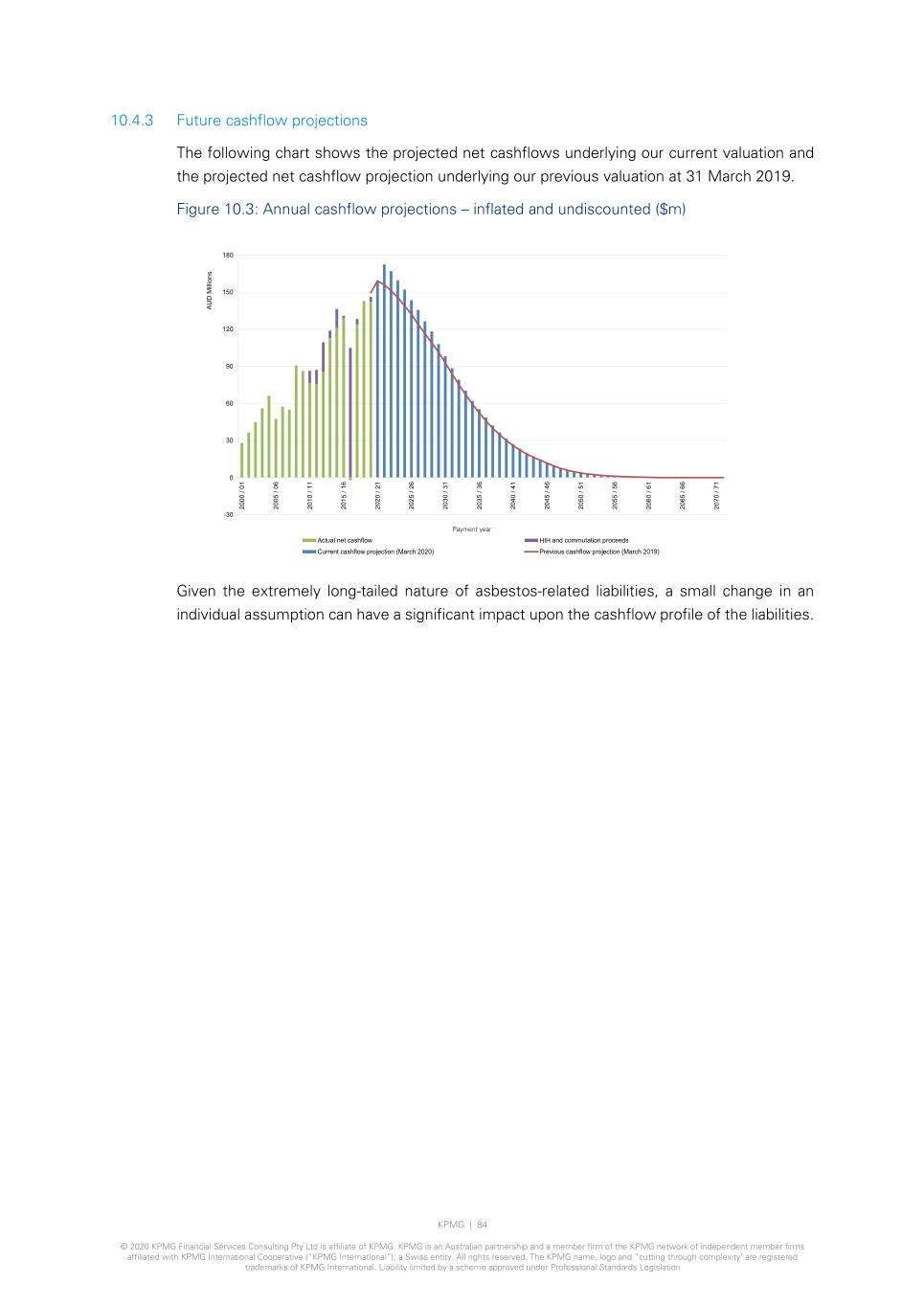
10.4.3 Future cashflow projections The following chart shows the projected net cashflows underlying our current valuation and the projected net cashflow projection underlying our previous valuation at 31 March 2019. Figure 10.3: Annual cashflow projections – inflated and undiscounted ($m) 180 150 AUD Millions AUD 120 90 60 30 0 2000 01 / 2000 06 / 2005 11 / 2010 16 / 2015 21 / 2020 26 / 2025 31 / 2030 36 / 2035 41 / 2040 46 / 2045 51 / 2050 56 / 2055 61 / 2060 66 / 2065 71 / 2070 -30 Payment year Actual net cashflow HIH and commutation proceeds Current cashflow projection (March 2020) Previous cashflow projection (March 2019) Given the extremely long-tailed nature of asbestos-related liabilities, a small change in an individual assumption can have a significant impact upon the cashflow profile of the liabilities. KPMG | 84 © 2020 KPMG Financial Services Consulting Pty Ltd is affiliate of KPMG. KPMG is an Australian partnership and a member firm of the KPMG network of independent member firms affiliated with KPMG International Cooperative (“KPMG International”), a Swiss entity. All rights reserved. The KPMG name, logo and “cutting through complexity’ are registered trademarks of KPMG International. Liability limited by a scheme approved under Professional Standards Legislation
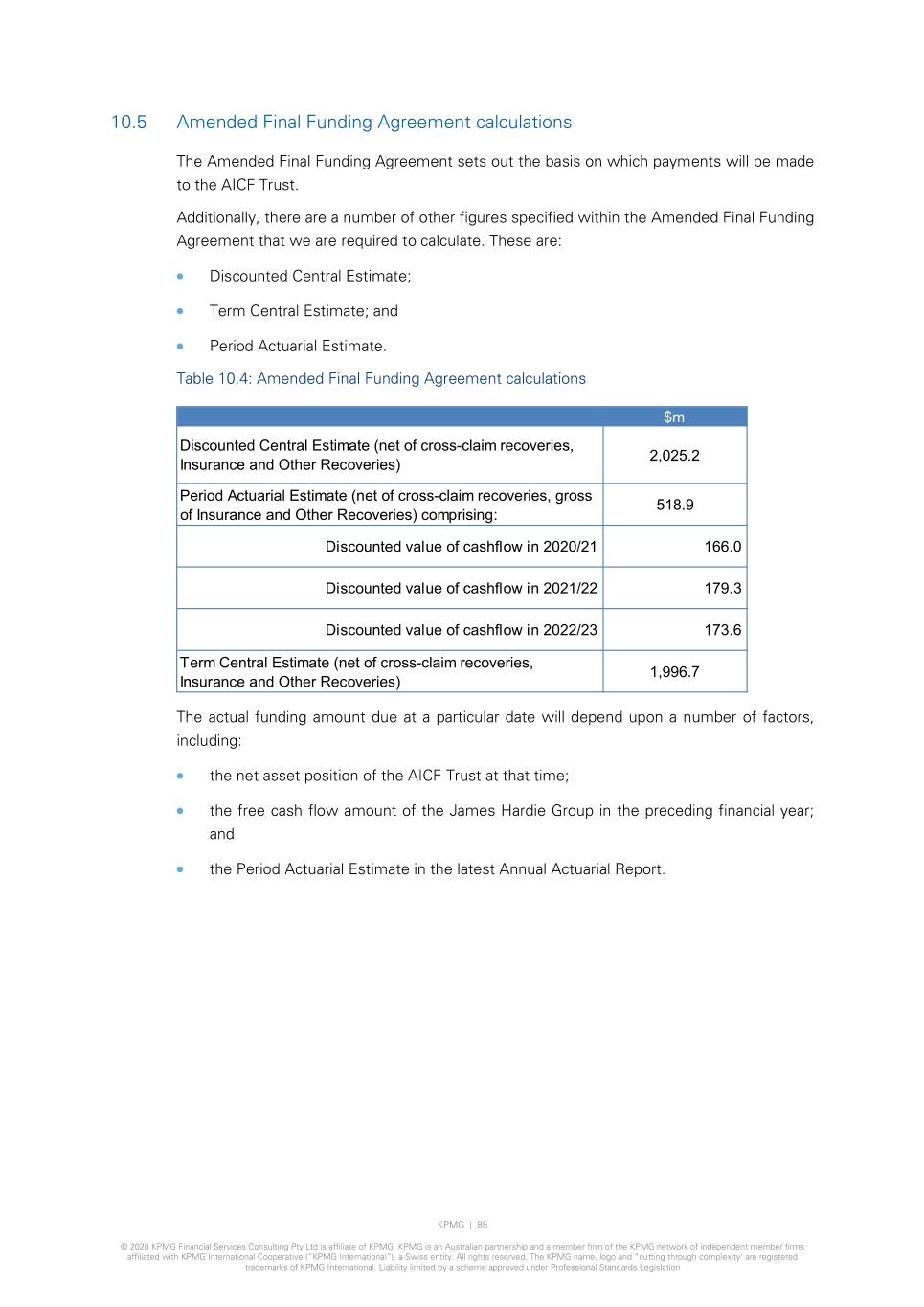
10.5 Amended Final Funding Agreement calculations The Amended Final Funding Agreement sets out the basis on which payments will be made to the AICF Trust. Additionally, there are a number of other figures specified within the Amended Final Funding Agreement that we are required to calculate. These are: • Discounted Central Estimate; • Term Central Estimate; and • Period Actuarial Estimate. Table 10.4: Amended Final Funding Agreement calculations $m Discounted Central Estimate (net of cross-claim recoveries, 2,025.2 Insurance and Other Recoveries) Period Actuarial Estimate (net of cross-claim recoveries, gross 518.9 of Insurance and Other Recoveries) comprising: Discounted value of cashflow in 2020/21 166.0 Discounted value of cashflow in 2021/22 179.3 Discounted value of cashflow in 2022/23 173.6 Term Central Estimate (net of cross-claim recoveries, 1,996.7 Insurance and Other Recoveries) The actual funding amount due at a particular date will depend upon a number of factors, including: • the net asset position of the AICF Trust at that time; • the free cash flow amount of the James Hardie Group in the preceding financial year; and • the Period Actuarial Estimate in the latest Annual Actuarial Report. KPMG | 85 © 2020 KPMG Financial Services Consulting Pty Ltd is affiliate of KPMG. KPMG is an Australian partnership and a member firm of the KPMG network of independent member firms affiliated with KPMG International Cooperative (“KPMG International”), a Swiss entity. All rights reserved. The KPMG name, logo and “cutting through complexity’ are registered trademarks of KPMG International. Liability limited by a scheme approved under Professional Standards Legislation
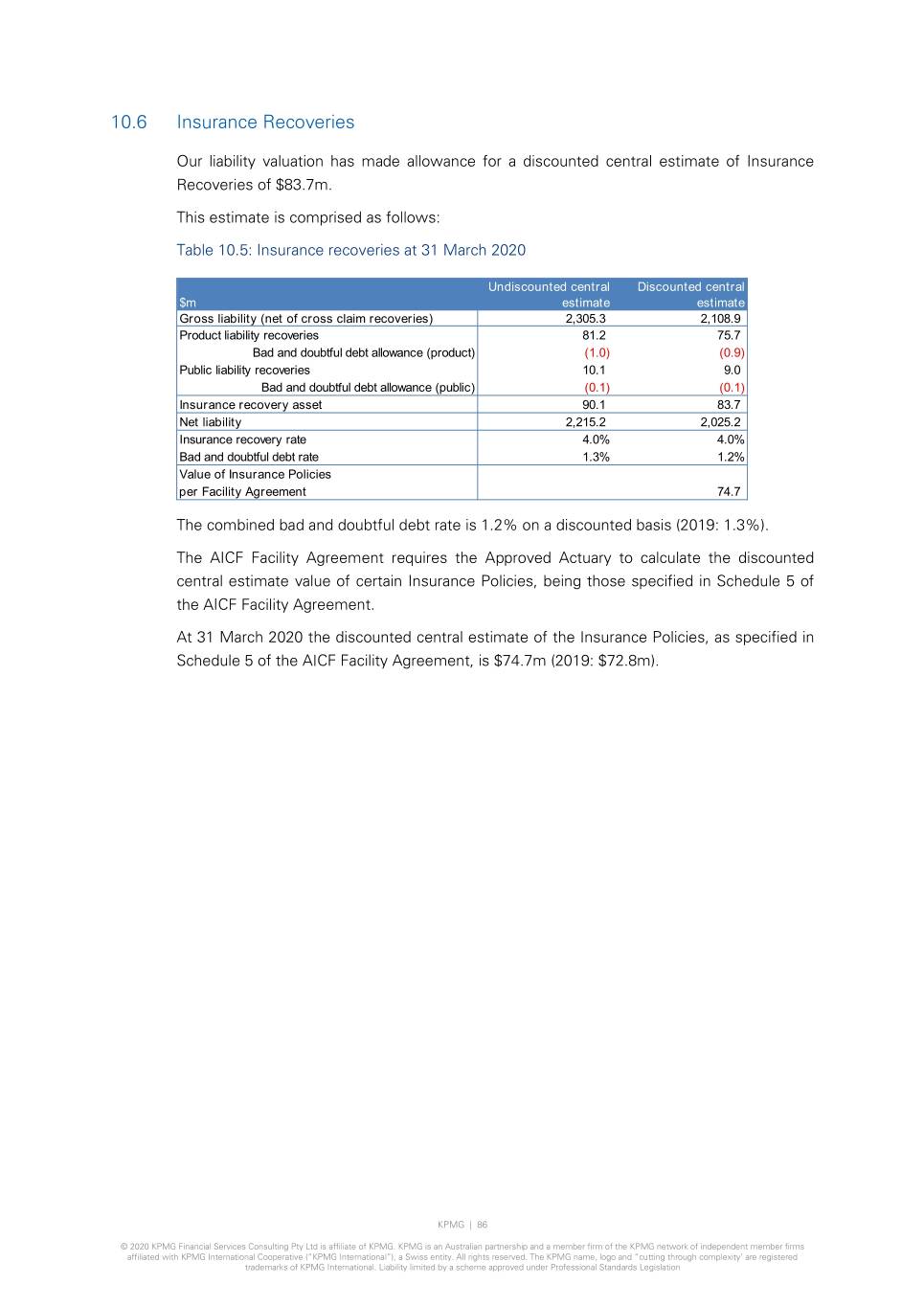
10.6 Insurance Recoveries Our liability valuation has made allowance for a discounted central estimate of Insurance Recoveries of $83.7m. This estimate is comprised as follows: Table 10.5: Insurance recoveries at 31 March 2020 Undiscounted central Discounted central $m estimate estimate Gross liability (net of cross claim recoveries) 2,305.3 2,108.9 Product liability recoveries 81.2 75.7 Bad and doubtful debt allowance (product) (1.0) (0.9) Public liability recoveries 10.1 9.0 Bad and doubtful debt allowance (public) (0.1) (0.1) Insurance recovery asset 90.1 83.7 Net liability 2,215.2 2,025.2 Insurance recovery rate 4.0% 4.0% Bad and doubtful debt rate 1.3% 1.2% Value of Insurance Policies per Facility Agreement 74.7 The combined bad and doubtful debt rate is 1.2% on a discounted basis (2019: 1.3%). The AICF Facility Agreement requires the Approved Actuary to calculate the discounted central estimate value of certain Insurance Policies, being those specified in Schedule 5 of the AICF Facility Agreement. At 31 March 2020 the discounted central estimate of the Insurance Policies, as specified in Schedule 5 of the AICF Facility Agreement, is $74.7m (2019: $72.8m). KPMG | 86 © 2020 KPMG Financial Services Consulting Pty Ltd is affiliate of KPMG. KPMG is an Australian partnership and a member firm of the KPMG network of independent member firms affiliated with KPMG International Cooperative (“KPMG International”), a Swiss entity. All rights reserved. The KPMG name, logo and “cutting through complexity’ are registered trademarks of KPMG International. Liability limited by a scheme approved under Professional Standards Legislation
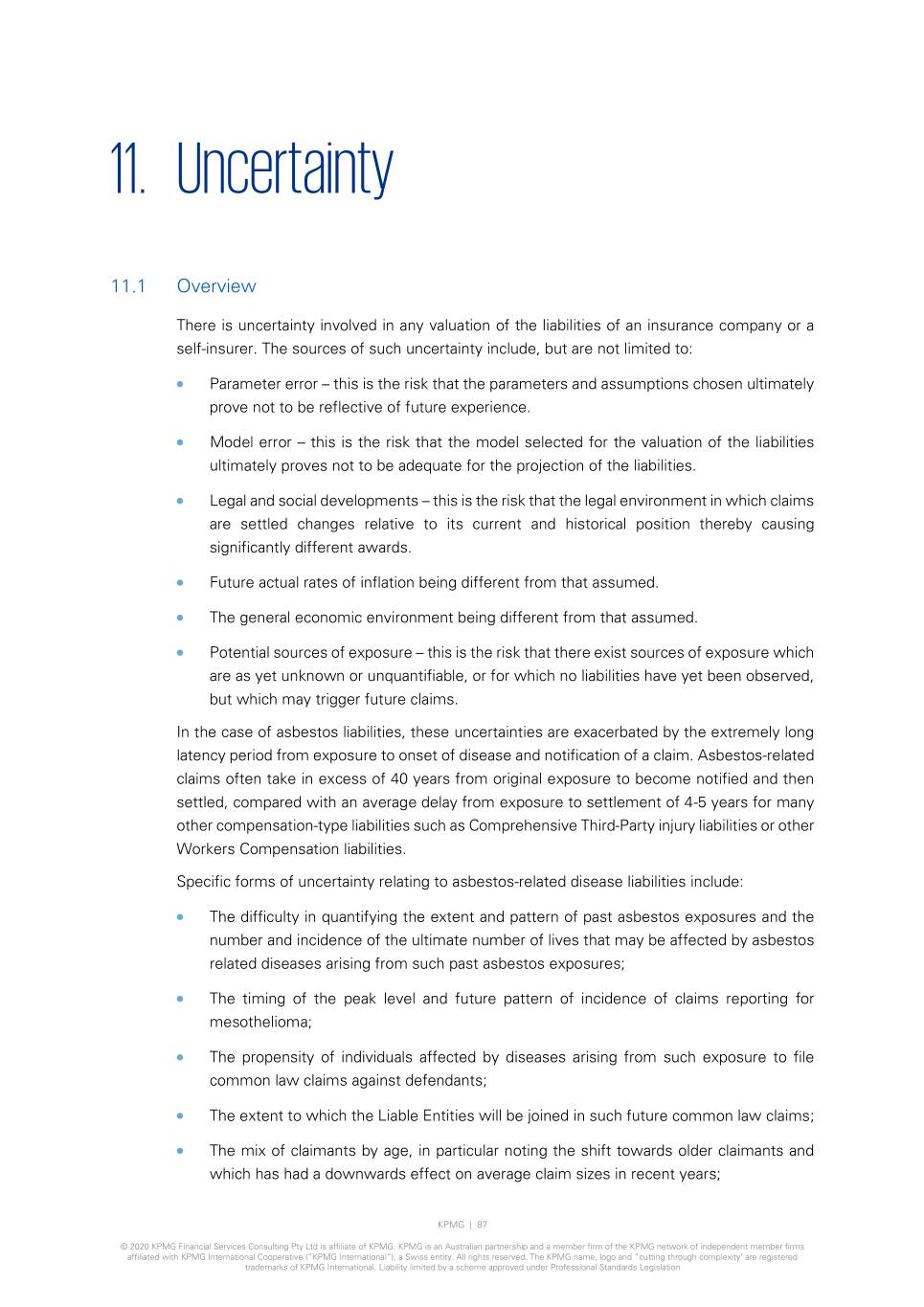
11. Uncertainty 11.1 Overview There is uncertainty involved in any valuation of the liabilities of an insurance company or a self-insurer. The sources of such uncertainty include, but are not limited to: • Parameter error – this is the risk that the parameters and assumptions chosen ultimately prove not to be reflective of future experience. • Model error – this is the risk that the model selected for the valuation of the liabilities ultimately proves not to be adequate for the projection of the liabilities. • Legal and social developments – this is the risk that the legal environment in which claims are settled changes relative to its current and historical position thereby causing significantly different awards. • Future actual rates of inflation being different from that assumed. • The general economic environment being different from that assumed. • Potential sources of exposure – this is the risk that there exist sources of exposure which are as yet unknown or unquantifiable, or for which no liabilities have yet been observed, but which may trigger future claims. In the case of asbestos liabilities, these uncertainties are exacerbated by the extremely long latency period from exposure to onset of disease and notification of a claim. Asbestos-related claims often take in excess of 40 years from original exposure to become notified and then settled, compared with an average delay from exposure to settlement of 4-5 years for many other compensation-type liabilities such as Comprehensive Third-Party injury liabilities or other Workers Compensation liabilities. Specific forms of uncertainty relating to asbestos-related disease liabilities include: • The difficulty in quantifying the extent and pattern of past asbestos exposures and the number and incidence of the ultimate number of lives that may be affected by asbestos related diseases arising from such past asbestos exposures; • The timing of the peak level and future pattern of incidence of claims reporting for mesothelioma; • The propensity of individuals affected by diseases arising from such exposure to file common law claims against defendants; • The extent to which the Liable Entities will be joined in such future common law claims; • The mix of claimants by age, in particular noting the shift towards older claimants and which has had a downwards effect on average claim sizes in recent years; KPMG | 87 © 2020 KPMG Financial Services Consulting Pty Ltd is affiliate of KPMG. KPMG is an Australian partnership and a member firm of the KPMG network of independent member firms affiliated with KPMG International Cooperative (“KPMG International”), a Swiss entity. All rights reserved. The KPMG name, logo and “cutting through complexity’ are registered trademarks of KPMG International. Liability limited by a scheme approved under Professional Standards Legislation
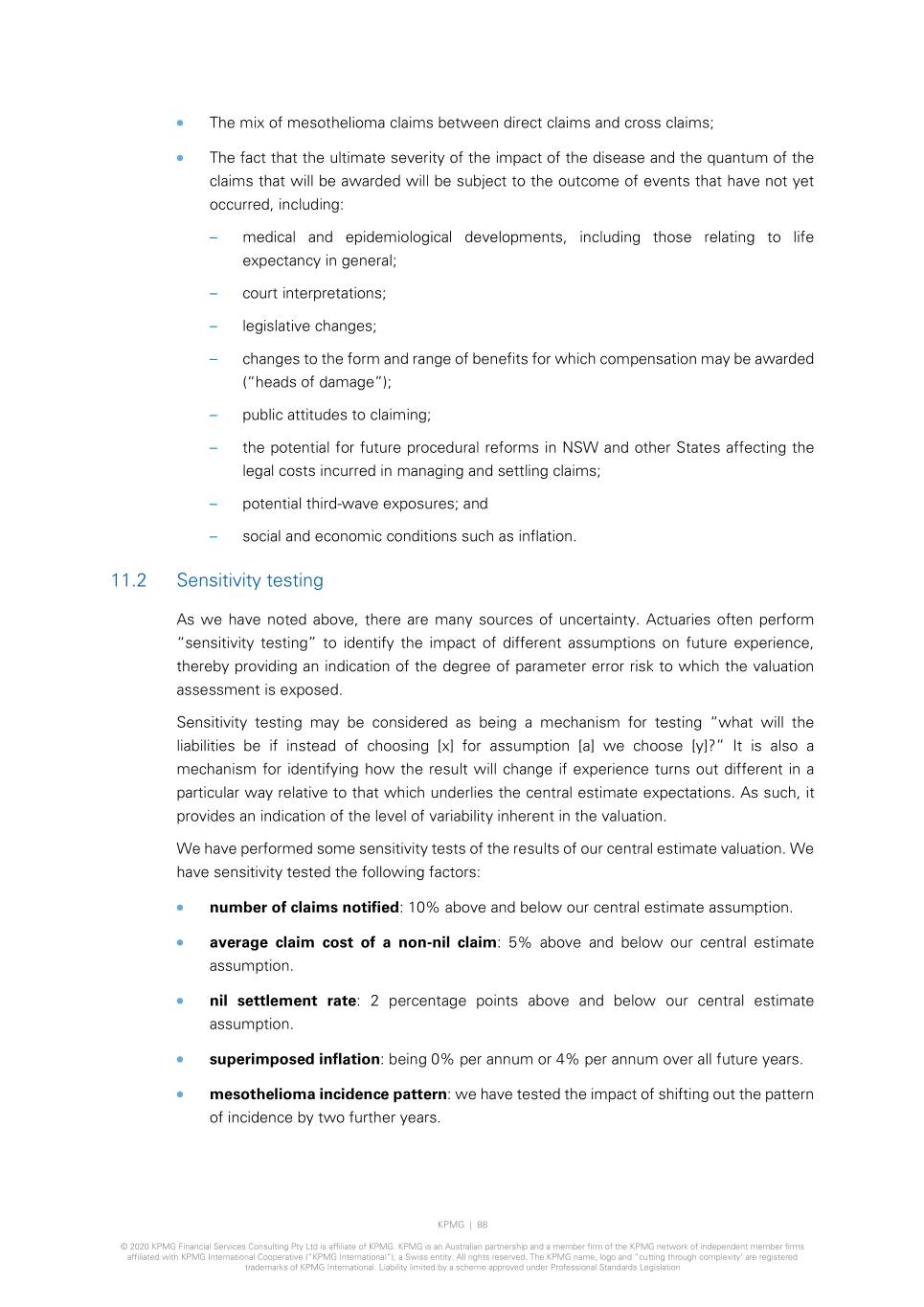
• The mix of mesothelioma claims between direct claims and cross claims; • The fact that the ultimate severity of the impact of the disease and the quantum of the claims that will be awarded will be subject to the outcome of events that have not yet occurred, including: – medical and epidemiological developments, including those relating to life expectancy in general; – court interpretations; – legislative changes; – changes to the form and range of benefits for which compensation may be awarded (“heads of damage”); – public attitudes to claiming; – the potential for future procedural reforms in NSW and other States affecting the legal costs incurred in managing and settling claims; – potential third-wave exposures; and – social and economic conditions such as inflation. 11.2 Sensitivity testing As we have noted above, there are many sources of uncertainty. Actuaries often perform “sensitivity testing” to identify the impact of different assumptions on future experience, thereby providing an indication of the degree of parameter error risk to which the valuation assessment is exposed. Sensitivity testing may be considered as being a mechanism for testing “what will the liabilities be if instead of choosing [x] for assumption [a] we choose [y]?” It is also a mechanism for identifying how the result will change if experience turns out different in a particular way relative to that which underlies the central estimate expectations. As such, it provides an indication of the level of variability inherent in the valuation. We have performed some sensitivity tests of the results of our central estimate valuation. We have sensitivity tested the following factors: • number of claims notified: 10% above and below our central estimate assumption. • average claim cost of a non-nil claim: 5% above and below our central estimate assumption. • nil settlement rate: 2 percentage points above and below our central estimate assumption. • superimposed inflation: being 0% per annum or 4% per annum over all future years. • mesothelioma incidence pattern: we have tested the impact of shifting out the pattern of incidence by two further years. KPMG | 88 © 2020 KPMG Financial Services Consulting Pty Ltd is affiliate of KPMG. KPMG is an Australian partnership and a member firm of the KPMG network of independent member firms affiliated with KPMG International Cooperative (“KPMG International”), a Swiss entity. All rights reserved. The KPMG name, logo and “cutting through complexity’ are registered trademarks of KPMG International. Liability limited by a scheme approved under Professional Standards Legislation
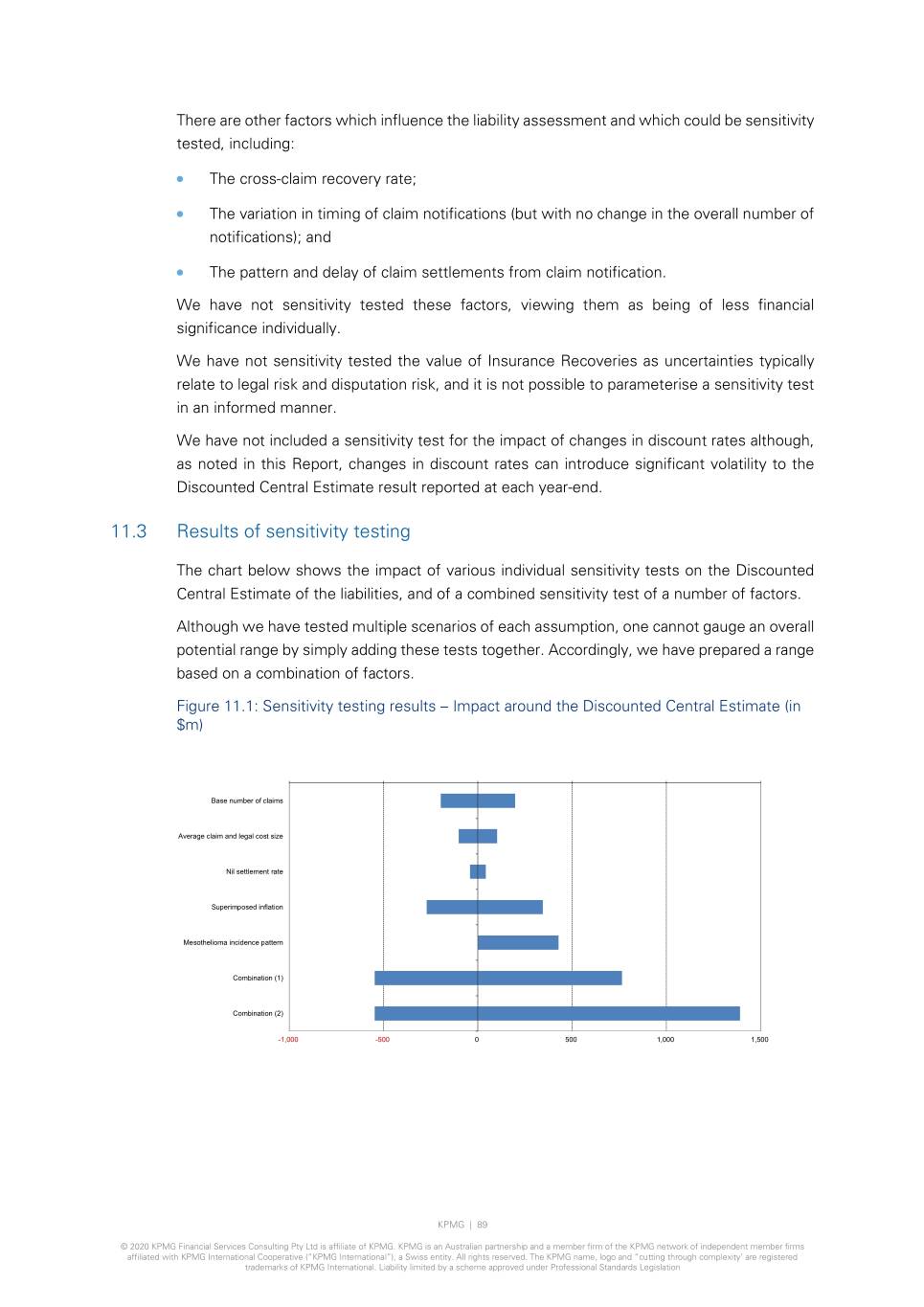
There are other factors which influence the liability assessment and which could be sensitivity tested, including: • The cross-claim recovery rate; • The variation in timing of claim notifications (but with no change in the overall number of notifications); and • The pattern and delay of claim settlements from claim notification. We have not sensitivity tested these factors, viewing them as being of less financial significance individually. We have not sensitivity tested the value of Insurance Recoveries as uncertainties typically relate to legal risk and disputation risk, and it is not possible to parameterise a sensitivity test in an informed manner. We have not included a sensitivity test for the impact of changes in discount rates although, as noted in this Report, changes in discount rates can introduce significant volatility to the Discounted Central Estimate result reported at each year-end. 11.3 Results of sensitivity testing The chart below shows the impact of various individual sensitivity tests on the Discounted Central Estimate of the liabilities, and of a combined sensitivity test of a number of factors. Although we have tested multiple scenarios of each assumption, one cannot gauge an overall potential range by simply adding these tests together. Accordingly, we have prepared a range based on a combination of factors. Figure 11.1: Sensitivity testing results – Impact around the Discounted Central Estimate (in $m) Base number of claims Average claim and legal cost size Nil settlement rate Superimposed inflation Mesothelioma incidence pattern Combination (1) Combination (2) -1,000 -500 0 500 1,000 1,500 KPMG | 89 © 2020 KPMG Financial Services Consulting Pty Ltd is affiliate of KPMG. KPMG is an Australian partnership and a member firm of the KPMG network of independent member firms affiliated with KPMG International Cooperative (“KPMG International”), a Swiss entity. All rights reserved. The KPMG name, logo and “cutting through complexity’ are registered trademarks of KPMG International. Liability limited by a scheme approved under Professional Standards Legislation

Figure 11.2: Sensitivity testing results – Impact around the undiscounted central estimate (in $m) Base number of claims Average claim and legal cost size Nil settlement rate Superimposed inflation Mesothelioma incidence pattern Combination (1) Combination (2) -1,000 -500 0 500 1,000 1,500 2,000 The single most sensitive assumption shown in the chart is the incidence pattern of mesothelioma claims reporting against the Liable Entities. Shifting the pattern of incidence by 2 years could add approximately $427m (21%) on a discounted basis to our valuation (as shown in Figure 11.1 by the scenario labelled “mesothelioma incidence pattern”). Table 11.1: Summary results of sensitivity analysis ($m) Undiscounted Discounted Central estimate 2,215.2 2,025.2 Low Scenario 1,593.6 1,478.2 High Scenario 3,861.7 3,414.9 Whilst the table above indicates a range around the discounted central estimate of liabilities of -$547m to +$1,390m, the actual cost of liabilities could fall outside that range depending on the actual experience. We further note that these sensitivity test ranges are not intended to correspond to a specified probability of sufficiency nor are they intended to indicate an upper bound or a lower bound of all possible outcomes. KPMG | 90 © 2020 KPMG Financial Services Consulting Pty Ltd is affiliate of KPMG. KPMG is an Australian partnership and a member firm of the KPMG network of independent member firms affiliated with KPMG International Cooperative (“KPMG International”), a Swiss entity. All rights reserved. The KPMG name, logo and “cutting through complexity’ are registered trademarks of KPMG International. Liability limited by a scheme approved under Professional Standards Legislation

A Projected inflated and undiscounted cashflows ($m) Workers Workers Compensation Wharf Legal Mesothelioma Asbestosis Lung Cancer ARPD & Other Legal and Compensation Legal and and Other Cross Claim Payment Year Claims Claims Claims Claims Other Costs Claims Other Costs Wharf Claims Costs Baryulgil Recoveries Gross Insurance Net 2020 / 2021 138.0 12.0 2.0 2.6 15.9 0.1 0.0 0.5 0.1 0.3 5.4 166.2 6.6 159.6 2021 / 2022 147.8 11.8 2.1 3.6 18.7 0.1 0.0 1.0 0.2 0.3 5.8 179.9 7.4 172.5 2022 / 2023 143.7 11.6 2.1 3.7 17.7 0.1 0.0 1.1 0.2 0.2 5.7 174.8 7.7 167.2 2023 / 2024 138.4 10.7 2.0 3.5 16.9 0.1 0.0 1.1 0.2 0.2 5.5 167.6 7.9 159.7 2024 / 2025 132.8 10.1 1.9 3.3 15.7 0.1 0.0 1.0 0.2 0.2 5.2 160.0 7.8 152.2 2025 / 2026 125.6 9.5 1.8 3.0 14.7 0.1 0.0 0.9 0.1 0.2 4.9 151.1 7.6 143.4 2026 / 2027 118.5 8.7 1.7 2.8 13.7 0.1 0.0 0.9 0.1 0.1 4.6 142.0 6.3 135.7 2027 / 2028 110.3 7.9 1.6 2.5 12.7 0.1 0.0 0.8 0.1 0.1 4.3 131.9 5.4 126.5 2028 / 2029 102.5 7.2 1.5 2.3 11.7 0.1 0.0 0.7 0.1 0.1 4.0 122.1 3.9 118.2 2029 / 2030 94.3 6.5 1.3 2.0 10.3 0.1 0.0 0.7 0.1 0.1 3.7 111.7 3.7 108.0 2030 / 2031 86.2 5.8 1.2 1.8 9.2 0.1 0.0 0.6 0.1 0.1 3.3 101.7 3.5 98.2 2031 / 2032 78.1 5.1 1.1 1.6 8.2 0.1 0.0 0.5 0.1 0.1 3.0 91.8 3.3 88.5 2032 / 2033 70.2 4.5 1.0 1.4 7.3 0.1 0.0 0.5 0.1 0.1 2.7 82.3 3.1 79.2 2033 / 2034 62.7 3.9 0.9 1.2 6.4 0.0 0.0 0.4 0.1 0.0 2.4 73.2 2.8 70.4 2034 / 2035 55.7 3.4 0.8 1.0 5.6 0.0 0.0 0.3 0.0 0.0 2.1 64.7 2.7 62.0 2035 / 2036 49.1 2.9 0.7 0.9 4.8 0.0 0.0 0.3 0.0 0.0 1.9 56.9 1.5 55.4 2036 / 2037 43.1 2.4 0.6 0.7 4.2 0.0 0.0 0.2 0.0 0.0 1.6 49.7 1.2 48.5 2037 / 2038 37.7 2.0 0.5 0.6 3.6 0.0 0.0 0.2 0.0 0.0 1.4 43.2 1.1 42.2 2038 / 2039 32.9 1.7 0.4 0.5 3.0 0.0 0.0 0.2 0.0 0.0 1.2 37.5 0.9 36.5 2039 / 2040 28.6 1.4 0.3 0.4 2.6 0.0 0.0 0.1 0.0 0.0 1.1 32.4 0.8 31.6 2040 / 2041 24.8 1.1 0.3 0.3 2.2 0.0 0.0 0.1 0.0 0.0 0.9 28.0 0.7 27.2 2041 / 2042 21.6 0.9 0.2 0.3 1.9 0.0 0.0 0.1 0.0 0.0 0.8 24.1 0.7 23.5 2042 / 2043 18.7 0.7 0.2 0.2 1.6 0.0 0.0 0.1 0.0 0.0 0.7 20.8 0.6 20.2 2043 / 2044 16.2 0.6 0.2 0.2 1.3 0.0 0.0 0.1 0.0 0.0 0.6 17.9 0.5 17.4 2044 / 2045 14.0 0.5 0.1 0.1 1.1 0.0 0.0 0.0 0.0 0.0 0.5 15.4 0.5 14.9 2045 / 2046 11.5 0.4 0.1 0.1 0.9 0.0 0.0 0.0 0.0 0.0 0.4 12.6 0.4 12.2 2046 / 2047 9.2 0.3 0.1 0.1 0.7 0.0 0.0 0.0 0.0 0.0 0.3 10.0 0.3 9.7 2047 / 2048 7.3 0.2 0.1 0.1 0.6 0.0 0.0 0.0 0.0 0.0 0.3 7.9 0.3 7.7 2048 / 2049 5.8 0.2 0.0 0.0 0.4 0.0 0.0 0.0 0.0 0.0 0.2 6.3 0.2 6.1 2049 / 2050 4.6 0.1 0.0 0.0 0.3 0.0 0.0 0.0 0.0 0.0 0.2 4.9 0.2 4.8 2050 / 2051 3.6 0.1 0.0 0.0 0.3 0.0 0.0 0.0 0.0 0.0 0.1 3.9 0.1 3.8 2051 / 2052 2.9 0.1 0.0 0.0 0.2 0.0 0.0 0.0 0.0 0.0 0.1 3.1 0.1 3.0 2052 / 2053 2.3 0.0 0.0 0.0 0.2 0.0 0.0 0.0 0.0 0.0 0.1 2.4 0.1 2.3 2053 / 2054 1.8 0.0 0.0 0.0 0.1 0.0 0.0 0.0 0.0 0.0 0.1 1.9 0.1 1.8 2054 / 2055 1.4 0.0 0.0 0.0 0.1 0.0 0.0 0.0 0.0 0.0 0.1 1.5 0.1 1.4 2055 / 2056 1.1 0.0 0.0 0.0 0.1 0.0 0.0 0.0 0.0 0.0 0.0 1.2 0.0 1.1 2056 / 2057 0.8 0.0 0.0 0.0 0.1 0.0 0.0 0.0 0.0 0.0 0.0 0.9 0.0 0.8 2057 / 2058 0.6 0.0 0.0 0.0 0.0 0.0 0.0 0.0 0.0 0.0 0.0 0.6 0.0 0.6 2058 / 2059 0.4 0.0 0.0 0.0 0.0 0.0 0.0 0.0 0.0 0.0 0.0 0.5 0.0 0.4 2059 / 2060 0.3 0.0 0.0 0.0 0.0 0.0 0.0 0.0 0.0 0.0 0.0 0.3 0.0 0.3 2060 / 2061 0.2 0.0 0.0 0.0 0.0 0.0 0.0 0.0 0.0 0.0 0.0 0.3 0.0 0.2 2061 / 2062 0.1 0.0 0.0 0.0 0.0 0.0 0.0 0.0 0.0 0.0 0.0 0.1 0.0 0.1 2062 / 2063 0.0 0.0 0.0 0.0 0.0 0.0 0.0 0.0 0.0 0.0 0.0 0.0 0.0 0.0 2063 / 2064 0.0 0.0 0.0 0.0 0.0 0.0 0.0 0.0 0.0 0.0 0.0 0.0 0.0 0.0 2064 / 2065 0.0 0.0 0.0 0.0 0.0 0.0 0.0 0.0 0.0 0.0 0.0 0.0 0.0 0.0 2065 / 2066 0.0 0.0 0.0 0.0 0.0 0.0 0.0 0.0 0.0 0.0 0.0 0.0 0.0 0.0 2066 / 2067 0.0 0.0 0.0 0.0 0.0 0.0 0.0 0.0 0.0 0.0 0.0 0.0 0.0 0.0 2067 / 2068 0.0 0.0 0.0 0.0 0.0 0.0 0.0 0.0 0.0 0.0 0.0 0.0 0.0 0.0 2068 / 2069 0.0 0.0 0.0 0.0 0.0 0.0 0.0 0.0 0.0 0.0 0.0 0.0 0.0 0.0 2069 / 2070 0.0 0.0 0.0 0.0 0.0 0.0 0.0 0.0 0.0 0.0 0.0 0.0 0.0 0.0 2070 / 2071 0.0 0.0 0.0 0.0 0.0 0.0 0.0 0.0 0.0 0.0 0.0 0.0 0.0 0.0 2071 / 2072 0.0 0.0 0.0 0.0 0.0 0.0 0.0 0.0 0.0 0.0 0.0 0.0 0.0 0.0 TOTAL 1,945.4 134.4 26.7 40.9 214.9 1.6 0.4 12.6 1.9 2.2 75.7 2,305.3 90.1 2,215.2 KPMG | 91 © 2020 KPMG Financial Services Consulting Pty Ltd is affiliate of KPMG. KPMG is an Australian partnership and a member firm of the KPMG network of independent member firms affiliated with KPMG International Cooperative (“KPMG International”), a Swiss entity. All rights reserved. The KPMG name, logo and “cutting through complexity’ are registered trademarks of KPMG International. Liability limited by a scheme approved under Professional Standards Legislation
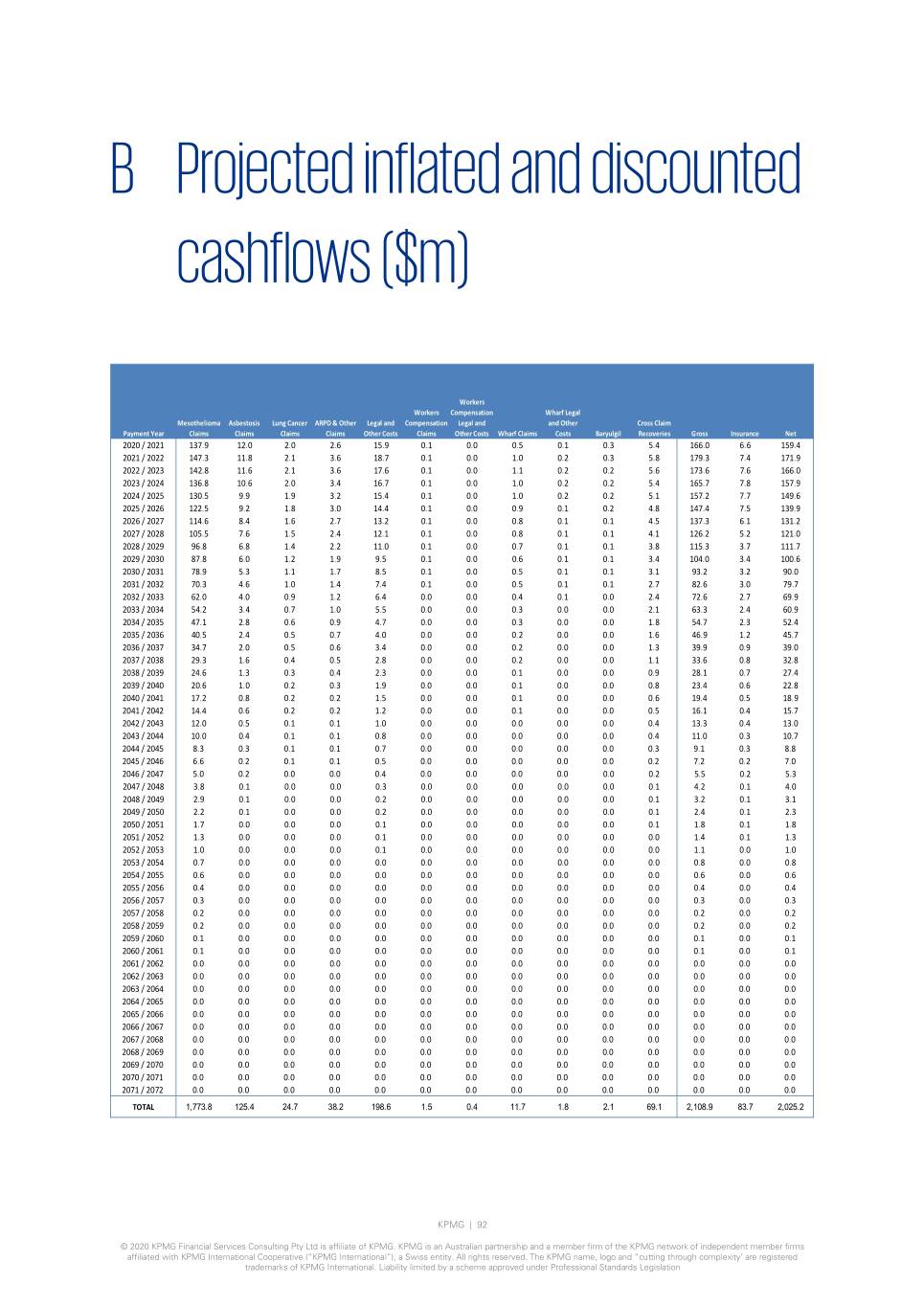
B Projected inflated and discounted cashflows ($m) Workers Workers Compensation Wharf Legal Mesothelioma Asbestosis Lung Cancer ARPD & Other Legal and Compensation Legal and and Other Cross Claim Payment Year Claims Claims Claims Claims Other Costs Claims Other Costs Wharf Claims Costs Baryulgil Recoveries Gross Insurance Net 2020 / 2021 137.9 12.0 2.0 2.6 15.9 0.1 0.0 0.5 0.1 0.3 5.4 166.0 6.6 159.4 2021 / 2022 147.3 11.8 2.1 3.6 18.7 0.1 0.0 1.0 0.2 0.3 5.8 179.3 7.4 171.9 2022 / 2023 142.8 11.6 2.1 3.6 17.6 0.1 0.0 1.1 0.2 0.2 5.6 173.6 7.6 166.0 2023 / 2024 136.8 10.6 2.0 3.4 16.7 0.1 0.0 1.0 0.2 0.2 5.4 165.7 7.8 157.9 2024 / 2025 130.5 9.9 1.9 3.2 15.4 0.1 0.0 1.0 0.2 0.2 5.1 157.2 7.7 149.6 2025 / 2026 122.5 9.2 1.8 3.0 14.4 0.1 0.0 0.9 0.1 0.2 4.8 147.4 7.5 139.9 2026 / 2027 114.6 8.4 1.6 2.7 13.2 0.1 0.0 0.8 0.1 0.1 4.5 137.3 6.1 131.2 2027 / 2028 105.5 7.6 1.5 2.4 12.1 0.1 0.0 0.8 0.1 0.1 4.1 126.2 5.2 121.0 2028 / 2029 96.8 6.8 1.4 2.2 11.0 0.1 0.0 0.7 0.1 0.1 3.8 115.3 3.7 111.7 2029 / 2030 87.8 6.0 1.2 1.9 9.5 0.1 0.0 0.6 0.1 0.1 3.4 104.0 3.4 100.6 2030 / 2031 78.9 5.3 1.1 1.7 8.5 0.1 0.0 0.5 0.1 0.1 3.1 93.2 3.2 90.0 2031 / 2032 70.3 4.6 1.0 1.4 7.4 0.1 0.0 0.5 0.1 0.1 2.7 82.6 3.0 79.7 2032 / 2033 62.0 4.0 0.9 1.2 6.4 0.0 0.0 0.4 0.1 0.0 2.4 72.6 2.7 69.9 2033 / 2034 54.2 3.4 0.7 1.0 5.5 0.0 0.0 0.3 0.0 0.0 2.1 63.3 2.4 60.9 2034 / 2035 47.1 2.8 0.6 0.9 4.7 0.0 0.0 0.3 0.0 0.0 1.8 54.7 2.3 52.4 2035 / 2036 40.5 2.4 0.5 0.7 4.0 0.0 0.0 0.2 0.0 0.0 1.6 46.9 1.2 45.7 2036 / 2037 34.7 2.0 0.5 0.6 3.4 0.0 0.0 0.2 0.0 0.0 1.3 39.9 0.9 39.0 2037 / 2038 29.3 1.6 0.4 0.5 2.8 0.0 0.0 0.2 0.0 0.0 1.1 33.6 0.8 32.8 2038 / 2039 24.6 1.3 0.3 0.4 2.3 0.0 0.0 0.1 0.0 0.0 0.9 28.1 0.7 27.4 2039 / 2040 20.6 1.0 0.2 0.3 1.9 0.0 0.0 0.1 0.0 0.0 0.8 23.4 0.6 22.8 2040 / 2041 17.2 0.8 0.2 0.2 1.5 0.0 0.0 0.1 0.0 0.0 0.6 19.4 0.5 18.9 2041 / 2042 14.4 0.6 0.2 0.2 1.2 0.0 0.0 0.1 0.0 0.0 0.5 16.1 0.4 15.7 2042 / 2043 12.0 0.5 0.1 0.1 1.0 0.0 0.0 0.0 0.0 0.0 0.4 13.3 0.4 13.0 2043 / 2044 10.0 0.4 0.1 0.1 0.8 0.0 0.0 0.0 0.0 0.0 0.4 11.0 0.3 10.7 2044 / 2045 8.3 0.3 0.1 0.1 0.7 0.0 0.0 0.0 0.0 0.0 0.3 9.1 0.3 8.8 2045 / 2046 6.6 0.2 0.1 0.1 0.5 0.0 0.0 0.0 0.0 0.0 0.2 7.2 0.2 7.0 2046 / 2047 5.0 0.2 0.0 0.0 0.4 0.0 0.0 0.0 0.0 0.0 0.2 5.5 0.2 5.3 2047 / 2048 3.8 0.1 0.0 0.0 0.3 0.0 0.0 0.0 0.0 0.0 0.1 4.2 0.1 4.0 2048 / 2049 2.9 0.1 0.0 0.0 0.2 0.0 0.0 0.0 0.0 0.0 0.1 3.2 0.1 3.1 2049 / 2050 2.2 0.1 0.0 0.0 0.2 0.0 0.0 0.0 0.0 0.0 0.1 2.4 0.1 2.3 2050 / 2051 1.7 0.0 0.0 0.0 0.1 0.0 0.0 0.0 0.0 0.0 0.1 1.8 0.1 1.8 2051 / 2052 1.3 0.0 0.0 0.0 0.1 0.0 0.0 0.0 0.0 0.0 0.0 1.4 0.1 1.3 2052 / 2053 1.0 0.0 0.0 0.0 0.1 0.0 0.0 0.0 0.0 0.0 0.0 1.1 0.0 1.0 2053 / 2054 0.7 0.0 0.0 0.0 0.0 0.0 0.0 0.0 0.0 0.0 0.0 0.8 0.0 0.8 2054 / 2055 0.6 0.0 0.0 0.0 0.0 0.0 0.0 0.0 0.0 0.0 0.0 0.6 0.0 0.6 2055 / 2056 0.4 0.0 0.0 0.0 0.0 0.0 0.0 0.0 0.0 0.0 0.0 0.4 0.0 0.4 2056 / 2057 0.3 0.0 0.0 0.0 0.0 0.0 0.0 0.0 0.0 0.0 0.0 0.3 0.0 0.3 2057 / 2058 0.2 0.0 0.0 0.0 0.0 0.0 0.0 0.0 0.0 0.0 0.0 0.2 0.0 0.2 2058 / 2059 0.2 0.0 0.0 0.0 0.0 0.0 0.0 0.0 0.0 0.0 0.0 0.2 0.0 0.2 2059 / 2060 0.1 0.0 0.0 0.0 0.0 0.0 0.0 0.0 0.0 0.0 0.0 0.1 0.0 0.1 2060 / 2061 0.1 0.0 0.0 0.0 0.0 0.0 0.0 0.0 0.0 0.0 0.0 0.1 0.0 0.1 2061 / 2062 0.0 0.0 0.0 0.0 0.0 0.0 0.0 0.0 0.0 0.0 0.0 0.0 0.0 0.0 2062 / 2063 0.0 0.0 0.0 0.0 0.0 0.0 0.0 0.0 0.0 0.0 0.0 0.0 0.0 0.0 2063 / 2064 0.0 0.0 0.0 0.0 0.0 0.0 0.0 0.0 0.0 0.0 0.0 0.0 0.0 0.0 2064 / 2065 0.0 0.0 0.0 0.0 0.0 0.0 0.0 0.0 0.0 0.0 0.0 0.0 0.0 0.0 2065 / 2066 0.0 0.0 0.0 0.0 0.0 0.0 0.0 0.0 0.0 0.0 0.0 0.0 0.0 0.0 2066 / 2067 0.0 0.0 0.0 0.0 0.0 0.0 0.0 0.0 0.0 0.0 0.0 0.0 0.0 0.0 2067 / 2068 0.0 0.0 0.0 0.0 0.0 0.0 0.0 0.0 0.0 0.0 0.0 0.0 0.0 0.0 2068 / 2069 0.0 0.0 0.0 0.0 0.0 0.0 0.0 0.0 0.0 0.0 0.0 0.0 0.0 0.0 2069 / 2070 0.0 0.0 0.0 0.0 0.0 0.0 0.0 0.0 0.0 0.0 0.0 0.0 0.0 0.0 2070 / 2071 0.0 0.0 0.0 0.0 0.0 0.0 0.0 0.0 0.0 0.0 0.0 0.0 0.0 0.0 2071 / 2072 0.0 0.0 0.0 0.0 0.0 0.0 0.0 0.0 0.0 0.0 0.0 0.0 0.0 0.0 TOTAL 1,773.8 125.4 24.7 38.2 198.6 1.5 0.4 11.7 1.8 2.1 69.1 2,108.9 83.7 2,025.2 KPMG | 92 © 2020 KPMG Financial Services Consulting Pty Ltd is affiliate of KPMG. KPMG is an Australian partnership and a member firm of the KPMG network of independent member firms affiliated with KPMG International Cooperative (“KPMG International”), a Swiss entity. All rights reserved. The KPMG name, logo and “cutting through complexity’ are registered trademarks of KPMG International. Liability limited by a scheme approved under Professional Standards Legislation
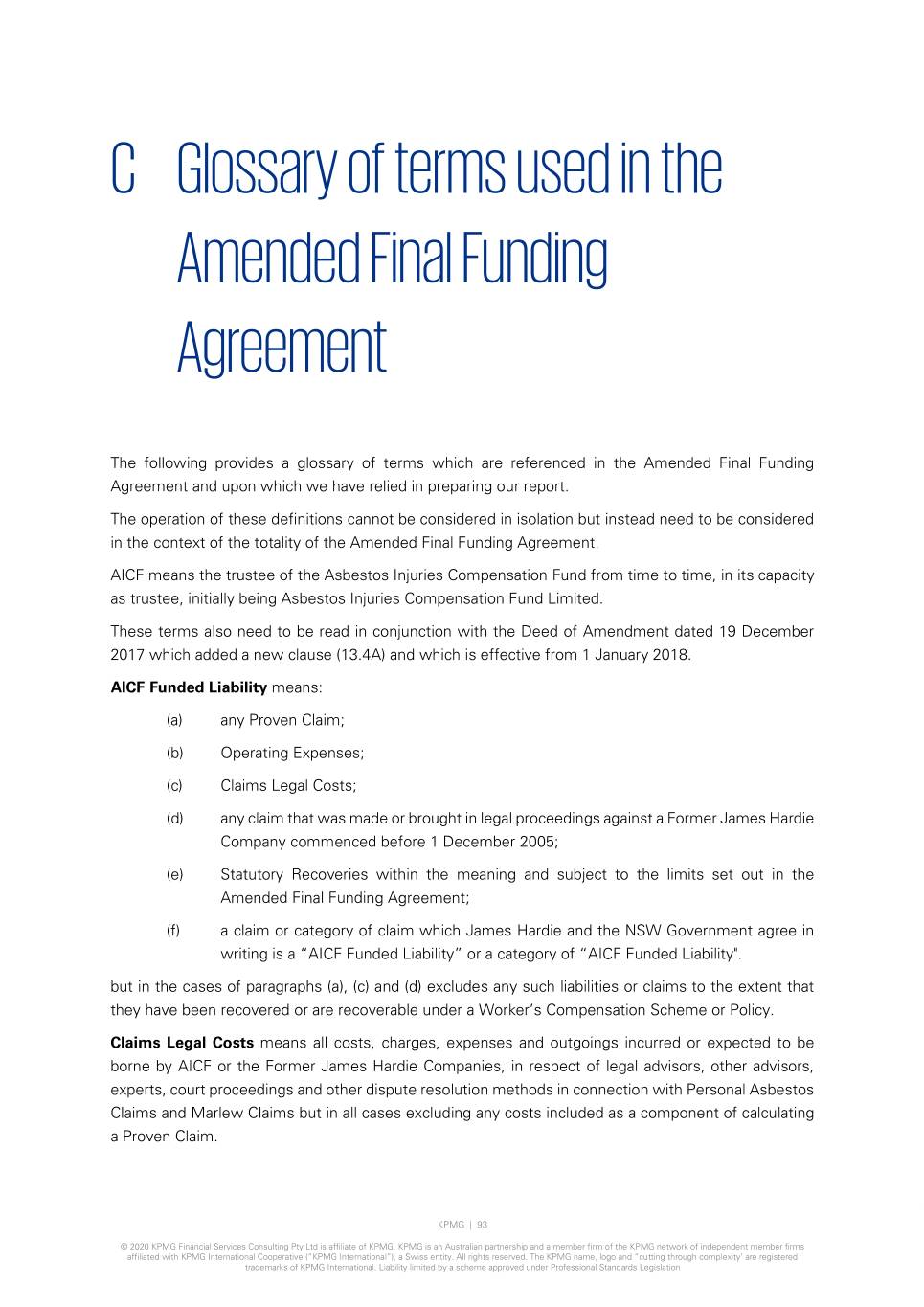
C Glossary of terms used in the Amended Final Funding Agreement The following provides a glossary of terms which are referenced in the Amended Final Funding Agreement and upon which we have relied in preparing our report. The operation of these definitions cannot be considered in isolation but instead need to be considered in the context of the totality of the Amended Final Funding Agreement. AICF means the trustee of the Asbestos Injuries Compensation Fund from time to time, in its capacity as trustee, initially being Asbestos Injuries Compensation Fund Limited. These terms also need to be read in conjunction with the Deed of Amendment dated 19 December 2017 which added a new clause (13.4A) and which is effective from 1 January 2018. AICF Funded Liability means: (a) any Proven Claim; (b) Operating Expenses; (c) Claims Legal Costs; (d) any claim that was made or brought in legal proceedings against a Former James Hardie Company commenced before 1 December 2005; (e) Statutory Recoveries within the meaning and subject to the limits set out in the Amended Final Funding Agreement; (f) a claim or category of claim which James Hardie and the NSW Government agree in writing is a “AICF Funded Liability” or a category of “AICF Funded Liability". but in the cases of paragraphs (a), (c) and (d) excludes any such liabilities or claims to the extent that they have been recovered or are recoverable under a Worker’s Compensation Scheme or Policy. Claims Legal Costs means all costs, charges, expenses and outgoings incurred or expected to be borne by AICF or the Former James Hardie Companies, in respect of legal advisors, other advisors, experts, court proceedings and other dispute resolution methods in connection with Personal Asbestos Claims and Marlew Claims but in all cases excluding any costs included as a component of calculating a Proven Claim. KPMG | 93 © 2020 KPMG Financial Services Consulting Pty Ltd is affiliate of KPMG. KPMG is an Australian partnership and a member firm of the KPMG network of independent member firms affiliated with KPMG International Cooperative (“KPMG International”), a Swiss entity. All rights reserved. The KPMG name, logo and “cutting through complexity’ are registered trademarks of KPMG International. Liability limited by a scheme approved under Professional Standards Legislation

Concurrent Wrongdoer in relation to a personal injury or death claim for damages under common law or other law (excluding any law introduced or imposed in breach of the restrictions on adverse regulatory or legislative action against the James Hardie Group under the Amended Final Funding Agreement, and which breach has been notified to the NSW Government in accordance with Amended Final Funding Agreement), means a person whose acts or omissions, together with the acts or omissions of one or more Former James Hardie Companies or Marlew or any member of the James Hardie Group (whether or not together with any other persons) caused, independently of each other or jointly, the damage or loss to another person that is the subject of that claim. Contribution Claim means a cross-claim or other claim under common law or other law (excluding any law introduced or imposed in breach of the restrictions on adverse regulatory or legislative action against the James Hardie Group under the Amended Final Funding Agreement, and which breach has been notified to the NSW Government in accordance with Amended Final Funding Agreement): (a) for contribution by a Concurrent Wrongdoer against a Former James Hardie Company or a member of the James Hardie Group in relation to facts or circumstances which give rise to a right of a person to make a Personal Asbestos Claim or a Marlew Claim; or (b) by another person who is entitled under common law (including by way of contract) to be subrogated to such a first mentioned cross-claim or other claim; Discounted Central Estimate means the central estimate of the present value (determined using the discount rate used within the relevant actuarial report) of the liabilities of the Former James Hardie Companies and Marlew in respect of expected Proven Claims and Claims Legal Costs, calculated in accordance with the Amended Final Funding Agreement. Excluded Claims are any of the following liabilities of the Former James Hardie Companies: (i) personal injury or death claims arising from exposure to Asbestos outside Australia; (ii) personal injury or death claims arising from exposure to Asbestos made outside Australia; (iii) claims for economic loss (other than any economic loss forming part of the calculation of an award of damages for personal injury or death) or loss of property, including those relating to land remediation and/or Asbestos or Asbestos products removal, arising out of or in connection with Asbestos or Asbestos products manufactured, sold, distributed or used by or on behalf of the Liable Entities; (iv) any Excluded Marlew Claim; (v) any liabilities of the Liable Entities other than AICF Funded Liabilities. Excluded Marlew Claim means a Marlew Claim: (a) covered by the indemnities granted by the Minister of Mineral Resources under the deed between the Minister, Fuller Earthmoving Pty Limited and James Hardie Industries Limited dated 11 March 1996; or (b) by a current or former employee of Marlew in relation to an exposure to Asbestos in the course of such employment to the extent: (i) the loss is recoverable under a Worker’s Compensation Scheme or Policy; or KPMG | 94 © 2020 KPMG Financial Services Consulting Pty Ltd is affiliate of KPMG. KPMG is an Australian partnership and a member firm of the KPMG network of independent member firms affiliated with KPMG International Cooperative (“KPMG International”), a Swiss entity. All rights reserved. The KPMG name, logo and “cutting through complexity’ are registered trademarks of KPMG International. Liability limited by a scheme approved under Professional Standards Legislation

(ii) the Claimant is not unable to recover damages from a Marlew Joint Tortfeasor in accordance with the Marlew Legislation; (c) by an individual who was or is an employee of a person other than Marlew arising from exposure to Asbestos in the course of such employment by that other person where such loss is recoverable from that person or under a Worker’s Compensation Scheme or Policy; or (d) in which another defendant (or its insurer) is a Marlew Joint Tortfeasor from whom the plaintiff is entitled to recover compensation in proceedings in the Dust Diseases Tribunal, and the Claimant is not unable to recover damages from that Marlew Joint Tortfeasor in accordance with the Marlew Legislation. Former James Hardie Companies means Amaca, Amaba and ABN 60. Insurance and Other Recoveries means any proceeds which may reasonably be expected to be recovered or recoverable for the account of a Former James Hardie Company or to result in the satisfaction (in whole or part) of a liability of a Former James Hardie Company (of any nature) to a third party, under any product liability insurance policy or public liability insurance policy or commutation of such policy or under any other contract, including any contract of indemnity, but excluding any such amount recovered or recoverable under a Worker’s Compensation Scheme or Policy. Liable Entities see Former James Hardie Companies. Marlew means Marlew Mining Pty Ltd (in liquidation), ACN 000 049 650, previously known as Asbestos Mines Pty Ltd. Marlew Claim means, subject to the limitation on Statutory Recoveries, a claim which satisfies one of the following paragraphs and which is not an Excluded Marlew Claim: (a) any present or future personal injury or death claim by an individual or the legal personal representative of an individual, for damages under common law or other law (excluding any law introduced or imposed in breach of the restrictions on adverse regulatory or legislative action against the James Hardie Group under the Amended Final Funding Agreement, and which breach has been notified to the NSW Government in accordance with the Amended Final Funding Agreement) which: (i) arose or arises from exposure to Asbestos in the Baryulgil region from Asbestos Mining Activities at Baryulgil conducted by Marlew, provided that: A. the individual’s exposure to Asbestos occurred wholly within Australia; or B. where the individual has been exposed to Asbestos both within and outside Australia, the amount of damages included in the Marlew Claim shall be limited to the amount attributable to the proportion of the exposure which caused or contributed to the loss or damage giving rise to the Marlew Claim which occurred in Australia; (ii) is commenced in New South Wales in the Dust Diseases Tribunal; and KPMG | 95 © 2020 KPMG Financial Services Consulting Pty Ltd is affiliate of KPMG. KPMG is an Australian partnership and a member firm of the KPMG network of independent member firms affiliated with KPMG International Cooperative (“KPMG International”), a Swiss entity. All rights reserved. The KPMG name, logo and “cutting through complexity’ are registered trademarks of KPMG International. Liability limited by a scheme approved under Professional Standards Legislation
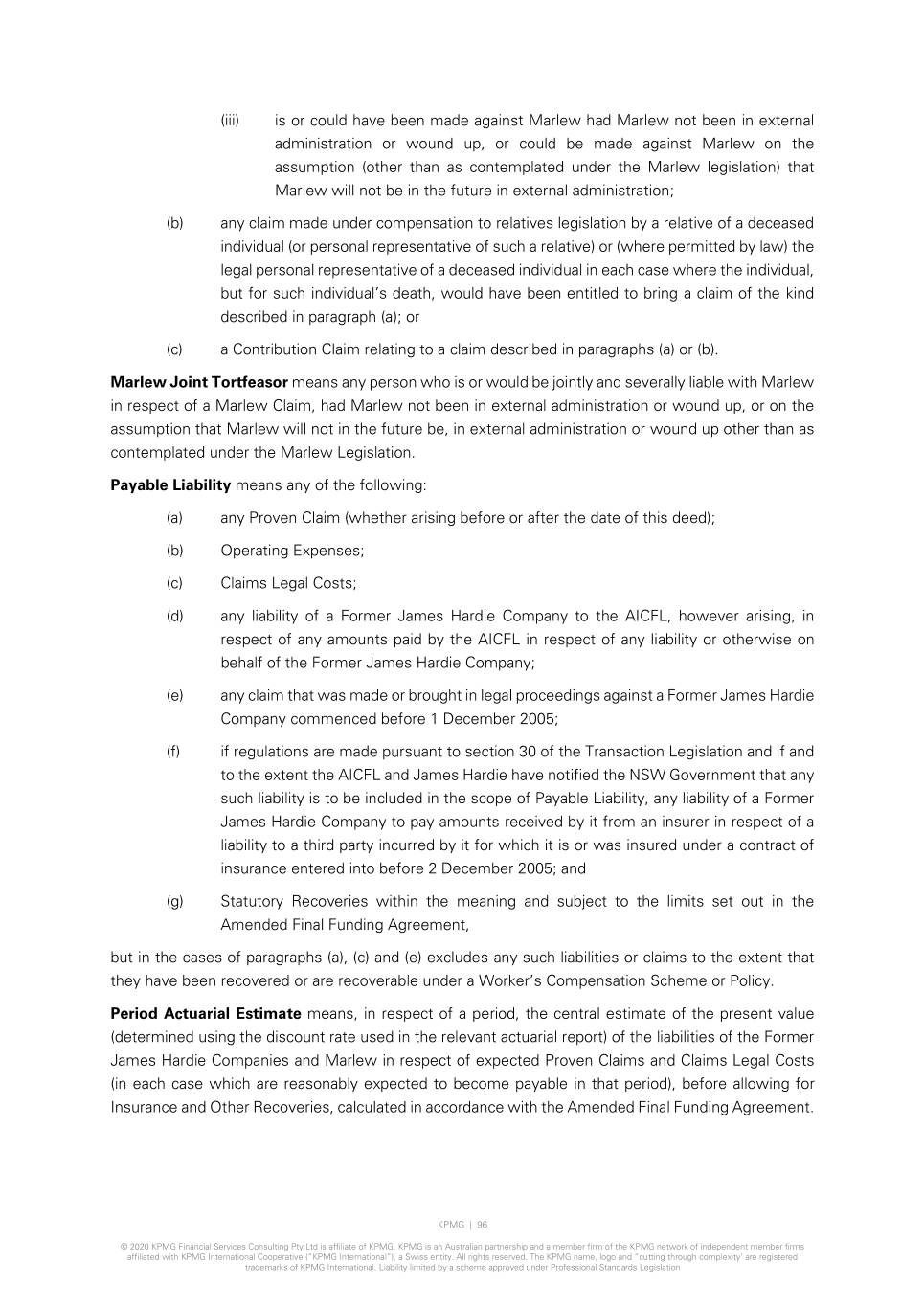
(iii) is or could have been made against Marlew had Marlew not been in external administration or wound up, or could be made against Marlew on the assumption (other than as contemplated under the Marlew legislation) that Marlew will not be in the future in external administration; (b) any claim made under compensation to relatives legislation by a relative of a deceased individual (or personal representative of such a relative) or (where permitted by law) the legal personal representative of a deceased individual in each case where the individual, but for such individual’s death, would have been entitled to bring a claim of the kind described in paragraph (a); or (c) a Contribution Claim relating to a claim described in paragraphs (a) or (b). Marlew Joint Tortfeasor means any person who is or would be jointly and severally liable with Marlew in respect of a Marlew Claim, had Marlew not been in external administration or wound up, or on the assumption that Marlew will not in the future be, in external administration or wound up other than as contemplated under the Marlew Legislation. Payable Liability means any of the following: (a) any Proven Claim (whether arising before or after the date of this deed); (b) Operating Expenses; (c) Claims Legal Costs; (d) any liability of a Former James Hardie Company to the AICFL, however arising, in respect of any amounts paid by the AICFL in respect of any liability or otherwise on behalf of the Former James Hardie Company; (e) any claim that was made or brought in legal proceedings against a Former James Hardie Company commenced before 1 December 2005; (f) if regulations are made pursuant to section 30 of the Transaction Legislation and if and to the extent the AICFL and James Hardie have notified the NSW Government that any such liability is to be included in the scope of Payable Liability, any liability of a Former James Hardie Company to pay amounts received by it from an insurer in respect of a liability to a third party incurred by it for which it is or was insured under a contract of insurance entered into before 2 December 2005; and (g) Statutory Recoveries within the meaning and subject to the limits set out in the Amended Final Funding Agreement, but in the cases of paragraphs (a), (c) and (e) excludes any such liabilities or claims to the extent that they have been recovered or are recoverable under a Worker’s Compensation Scheme or Policy. Period Actuarial Estimate means, in respect of a period, the central estimate of the present value (determined using the discount rate used in the relevant actuarial report) of the liabilities of the Former James Hardie Companies and Marlew in respect of expected Proven Claims and Claims Legal Costs (in each case which are reasonably expected to become payable in that period), before allowing for Insurance and Other Recoveries, calculated in accordance with the Amended Final Funding Agreement. KPMG | 96 © 2020 KPMG Financial Services Consulting Pty Ltd is affiliate of KPMG. KPMG is an Australian partnership and a member firm of the KPMG network of independent member firms affiliated with KPMG International Cooperative (“KPMG International”), a Swiss entity. All rights reserved. The KPMG name, logo and “cutting through complexity’ are registered trademarks of KPMG International. Liability limited by a scheme approved under Professional Standards Legislation
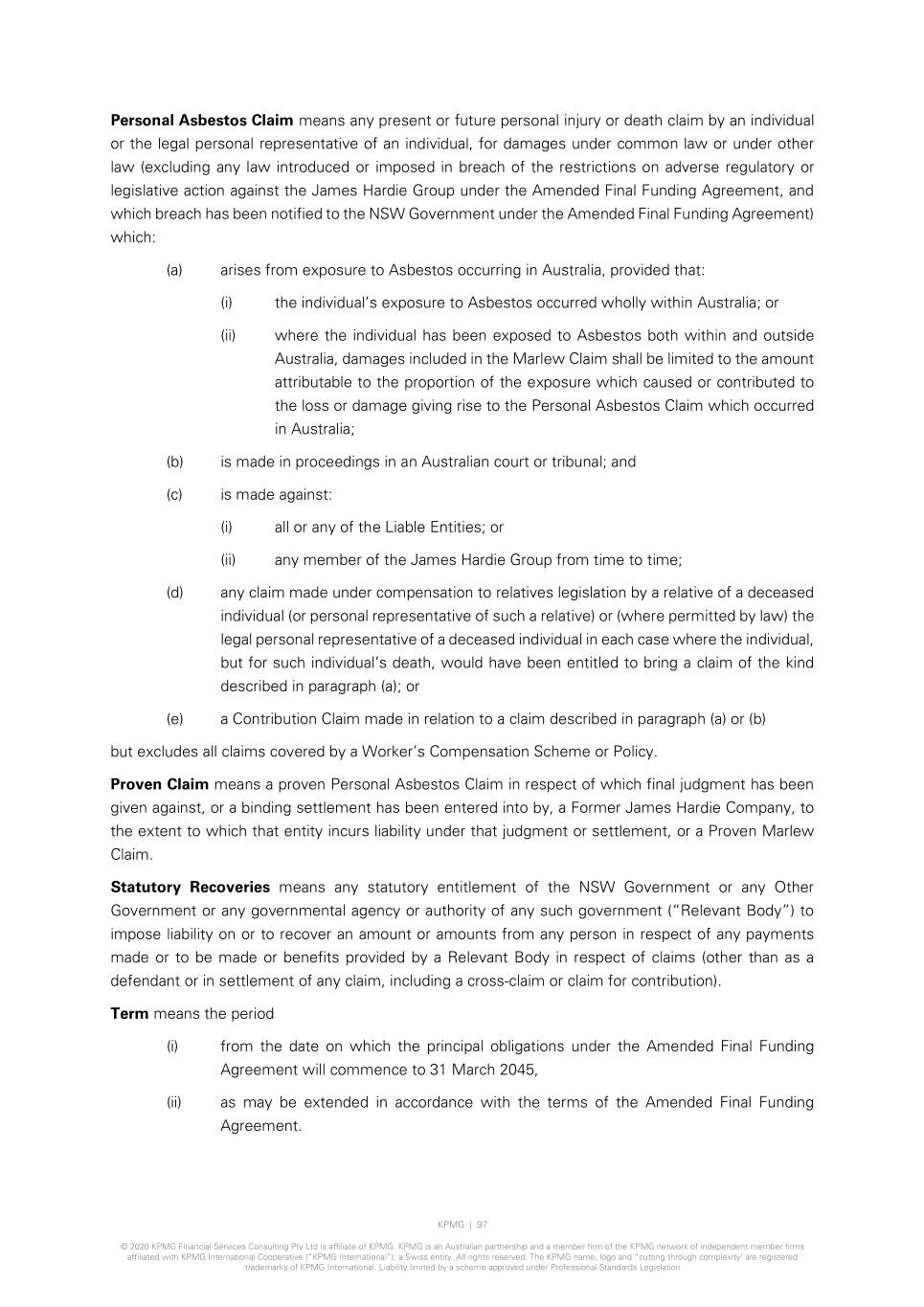
Personal Asbestos Claim means any present or future personal injury or death claim by an individual or the legal personal representative of an individual, for damages under common law or under other law (excluding any law introduced or imposed in breach of the restrictions on adverse regulatory or legislative action against the James Hardie Group under the Amended Final Funding Agreement, and which breach has been notified to the NSW Government under the Amended Final Funding Agreement) which: (a) arises from exposure to Asbestos occurring in Australia, provided that: (i) the individual’s exposure to Asbestos occurred wholly within Australia; or (ii) where the individual has been exposed to Asbestos both within and outside Australia, damages included in the Marlew Claim shall be limited to the amount attributable to the proportion of the exposure which caused or contributed to the loss or damage giving rise to the Personal Asbestos Claim which occurred in Australia; (b) is made in proceedings in an Australian court or tribunal; and (c) is made against: (i) all or any of the Liable Entities; or (ii) any member of the James Hardie Group from time to time; (d) any claim made under compensation to relatives legislation by a relative of a deceased individual (or personal representative of such a relative) or (where permitted by law) the legal personal representative of a deceased individual in each case where the individual, but for such individual’s death, would have been entitled to bring a claim of the kind described in paragraph (a); or (e) a Contribution Claim made in relation to a claim described in paragraph (a) or (b) but excludes all claims covered by a Worker’s Compensation Scheme or Policy. Proven Claim means a proven Personal Asbestos Claim in respect of which final judgment has been given against, or a binding settlement has been entered into by, a Former James Hardie Company, to the extent to which that entity incurs liability under that judgment or settlement, or a Proven Marlew Claim. Statutory Recoveries means any statutory entitlement of the NSW Government or any Other Government or any governmental agency or authority of any such government (“Relevant Body”) to impose liability on or to recover an amount or amounts from any person in respect of any payments made or to be made or benefits provided by a Relevant Body in respect of claims (other than as a defendant or in settlement of any claim, including a cross-claim or claim for contribution). Term means the period (i) from the date on which the principal obligations under the Amended Final Funding Agreement will commence to 31 March 2045, (ii) as may be extended in accordance with the terms of the Amended Final Funding Agreement. KPMG | 97 © 2020 KPMG Financial Services Consulting Pty Ltd is affiliate of KPMG. KPMG is an Australian partnership and a member firm of the KPMG network of independent member firms affiliated with KPMG International Cooperative (“KPMG International”), a Swiss entity. All rights reserved. The KPMG name, logo and “cutting through complexity’ are registered trademarks of KPMG International. Liability limited by a scheme approved under Professional Standards Legislation

Term Central Estimate means the central estimate of the present value (determined using the discount rate used in the relevant Annual Actuarial Report) of the liabilities of the Former James Hardie Companies and Marlew in respect of expected Proven Claims and Claims Legal Costs (in each case reasonably expected to become payable in the relevant period) after allowing for Insurance and Other Recoveries during that period, from and including the day following the end of the Financial Year preceding that Payment Date up to and including the last day of the Term (excluding any automatic or potential extension of the Term, unless or until the Term has been extended). Workers Compensation Scheme or Policy means any of the following: (a) any worker’s compensation scheme established by any law of the Commonwealth or of any State or Territory; (b) any fund established to cover liabilities under insurance policies upon the actual or prospective insolvency of the insurer (including without limitation the Insurer Guarantee Fund established under the Worker’s Compensation Act 1987 (NSW)); and (c) any policy of insurance issued under or pursuant to such a scheme. KPMG | 98 © 2020 KPMG Financial Services Consulting Pty Ltd is affiliate of KPMG. KPMG is an Australian partnership and a member firm of the KPMG network of independent member firms affiliated with KPMG International Cooperative (“KPMG International”), a Swiss entity. All rights reserved. The KPMG name, logo and “cutting through complexity’ are registered trademarks of KPMG International. Liability limited by a scheme approved under Professional Standards Legislation
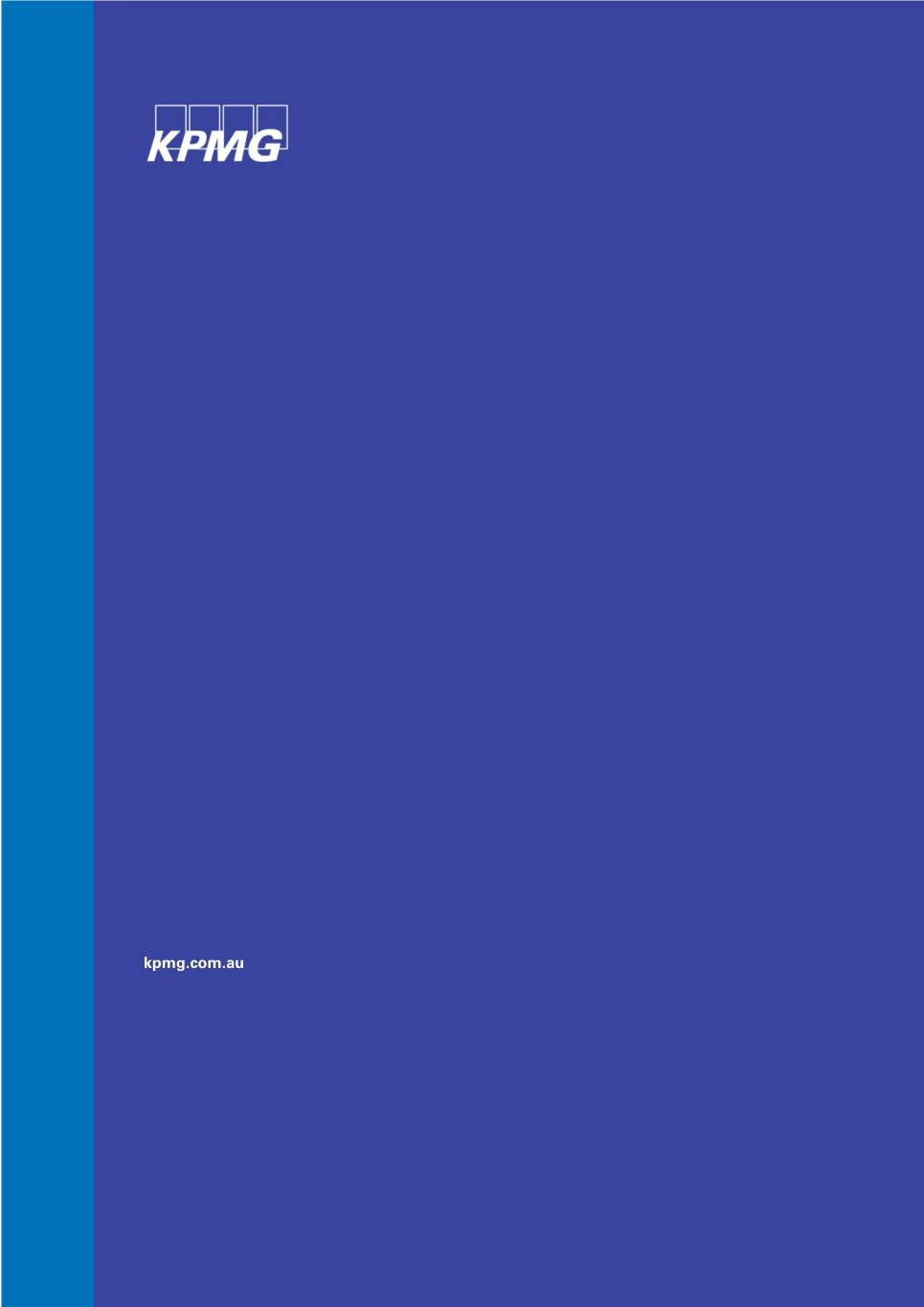
kpmg.com.au